52 Useful Tips for Travelling the Silk Road (Backpacker’s Guide)
January 19, 2020.
Thinking about travelling the Silk Road? You’re in for the adventure of a lifetime. This in-depth post will tell you everything you need to know to plan your trip.
From the windswept steppe of Kazakhstan to the mighty Pamir Mountains and to the oasis towns of Uzbekistan, the Silk Road has it all. For thousands of years, travellers and traders made the treacherous journey along the Silk Road, across vast deserts and over high mountain passes.
Nowadays, it’s rather easy to see the countries of the Silk Road for yourself. Visa issues have basically disappeared and there is now plenty of infrastructure to accommodate tourists.
I’ve spent over 6 months travelling around the Central Asian Silk Road countries, and have learned a ton about the region.
- 1 What is the Silk Road?
- 2.2 Kyrgyzstan
- 2.3 Kazakhstan
- 2.4 Uzbekistan
- 2.5 Tajikistan
- 2.6 Turkmenistan
- 2.7 Afghanistan (Wakhan Corridor)
- 3 Silk Road Travel Routes
- 4 Food along the Silk Road
- 5 People & Culture of the Silk Road
- 6 Visas for travelling the Silk Road
- 7 Safety along the Silk Road
- 8 Transportation while travelling the Silk Road
- 9 Accommodation while travelling the Silk Road
- 10 Silk Road Travel Costs
- 11 When to travel the Silk Road
- 12 Communication along the Silk Road
- 13 Internet & SIM Cards for the Silk Road
- 14 Travelling the Silk Road Wrap-up
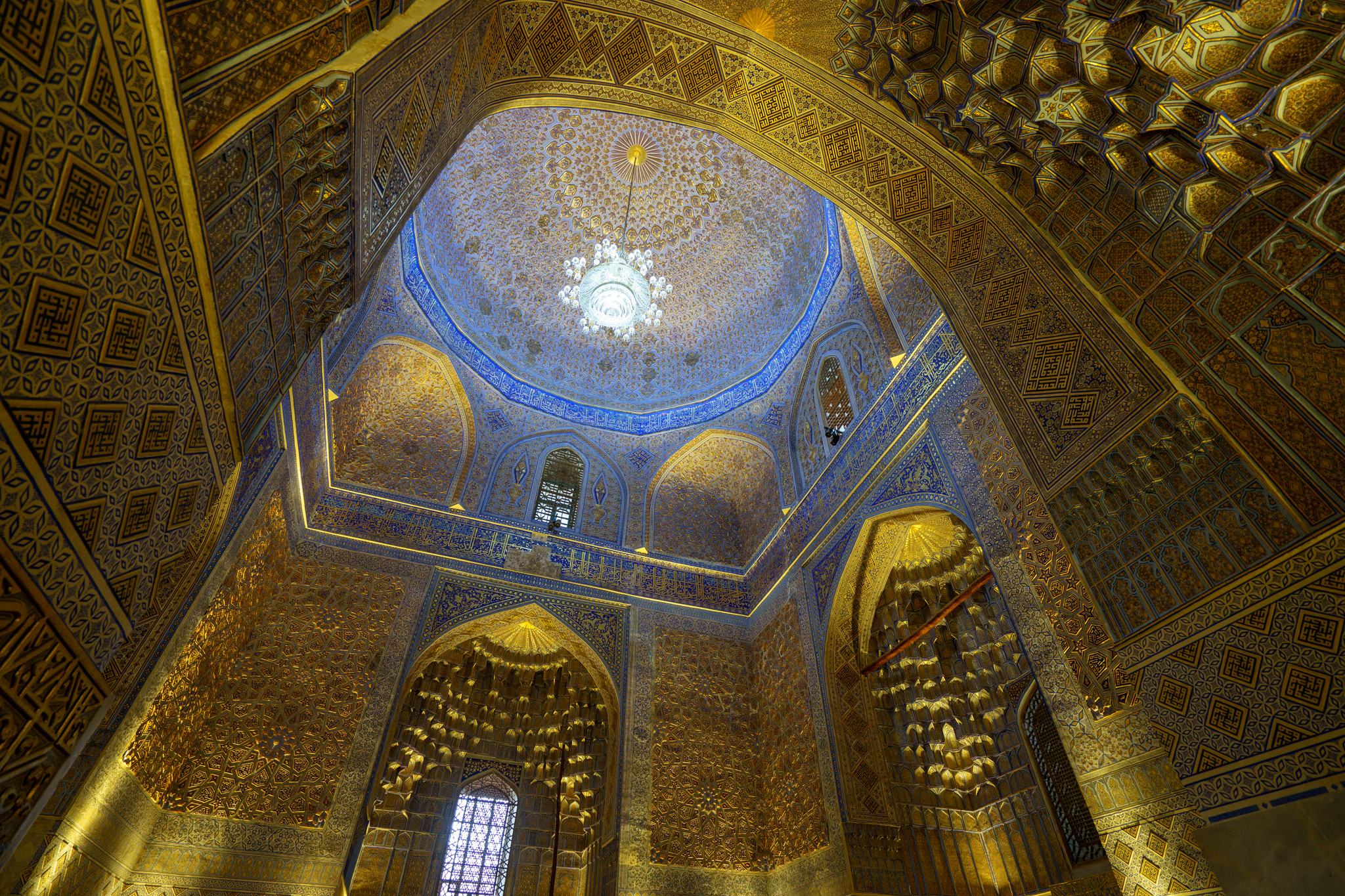

What is the Silk Road?
1 – The Silk Road wasn’t just one route: The Silk Road was a vast network of trade routes that connected Europe to Asia. The most well-known route is the one from China to Turkey, via Central Asia and Iran. Other routes travelled to Arabia, India, and Southeast Asia.
2 – This post will focus on the Central Asian Silk Road : Most travellers who plan a trip to the Silk Road visit the Central Asian ‘stans and China. While places such as Iran and Turkey are also technically on the Silk Road, that’s not usually the first thing that comes to mind when people visit them.
3 – Where does it start? Where does it end?: People typically consider Xi’an in China to be the starting point, and Istanbul in Turkey to be the endpoint of the Silk Road.
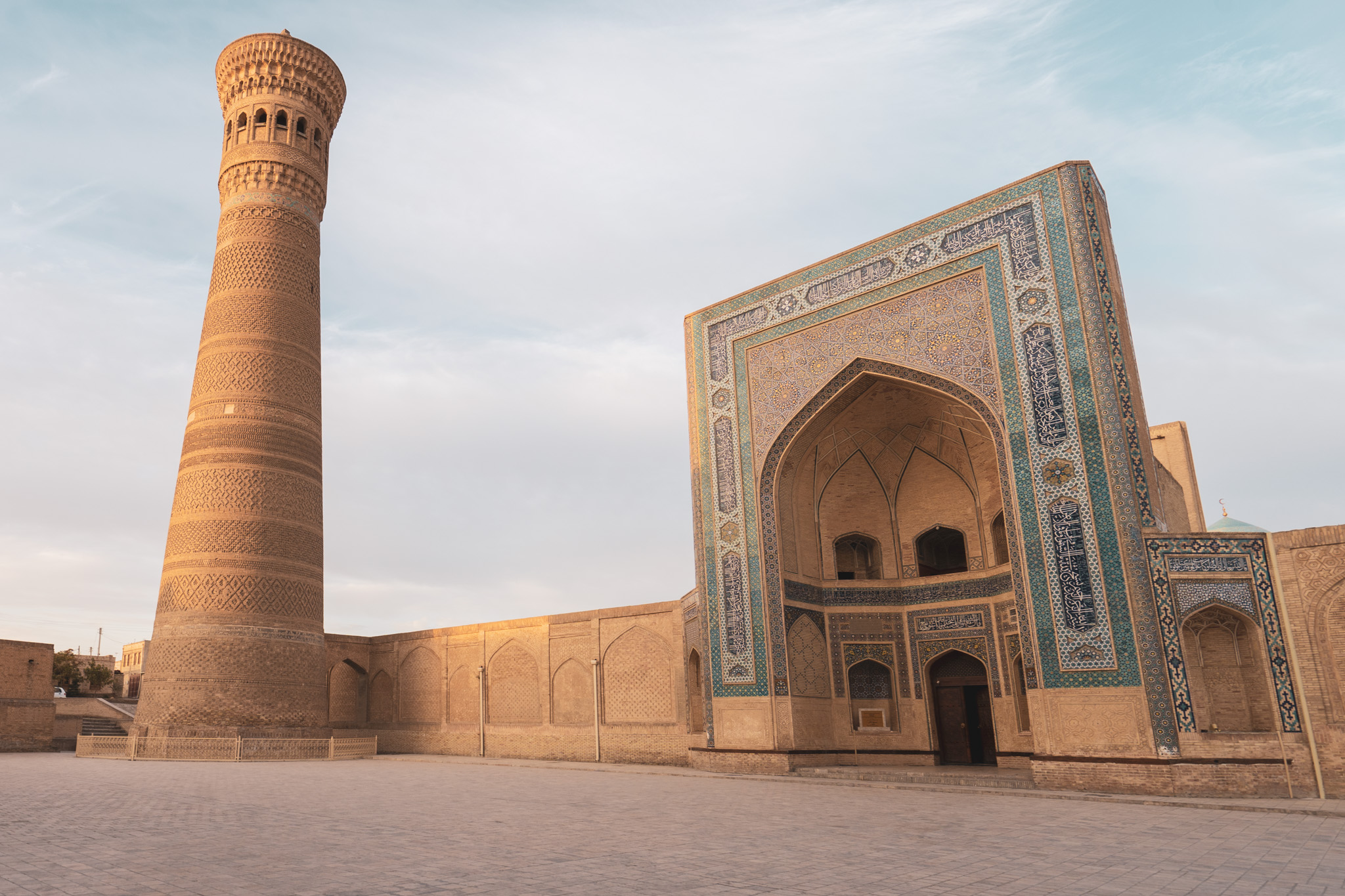
Where to visit along the Silk Road
4 – There are 7 different countries that make up the Central Asian Silk Road: China, Kyrgyzstan, Kazakhstan, Uzbekistan, Tajikistan, Turkmenistan, and northern Afghanistan are the countries that most consider being part of the Central Asian Silk Road.
Let’s go over the highlights of each of them below:
5 – History, nature, and delicious food: China has an incredibly long history, and it’s Silk Road corridor from Xi’an to Kashgar is no exception. Travelling along the Chinese Silk Road is an incredible experience. You’ll get to visit the Terracotta Warriors in Xi’an, taste some delicious noodles in Lanzhou, visit the famous Mogao Caves in Dunhuang, and check out the famous flaming cliffs of Turpan.
6 – Kashgar, China’s westernmost city: Closer to Baghdad than Beijing, Kashgar is an oasis city far from the rest of China. It’s inhabited by ethnic Uyghur people, and has always been an extremely important location on the Silk Road. When you visit Kashgar, you’ll be able to roam around its old city, visit animal markets, and take a road trip down the Karakorum Highway to the Pakistani border.
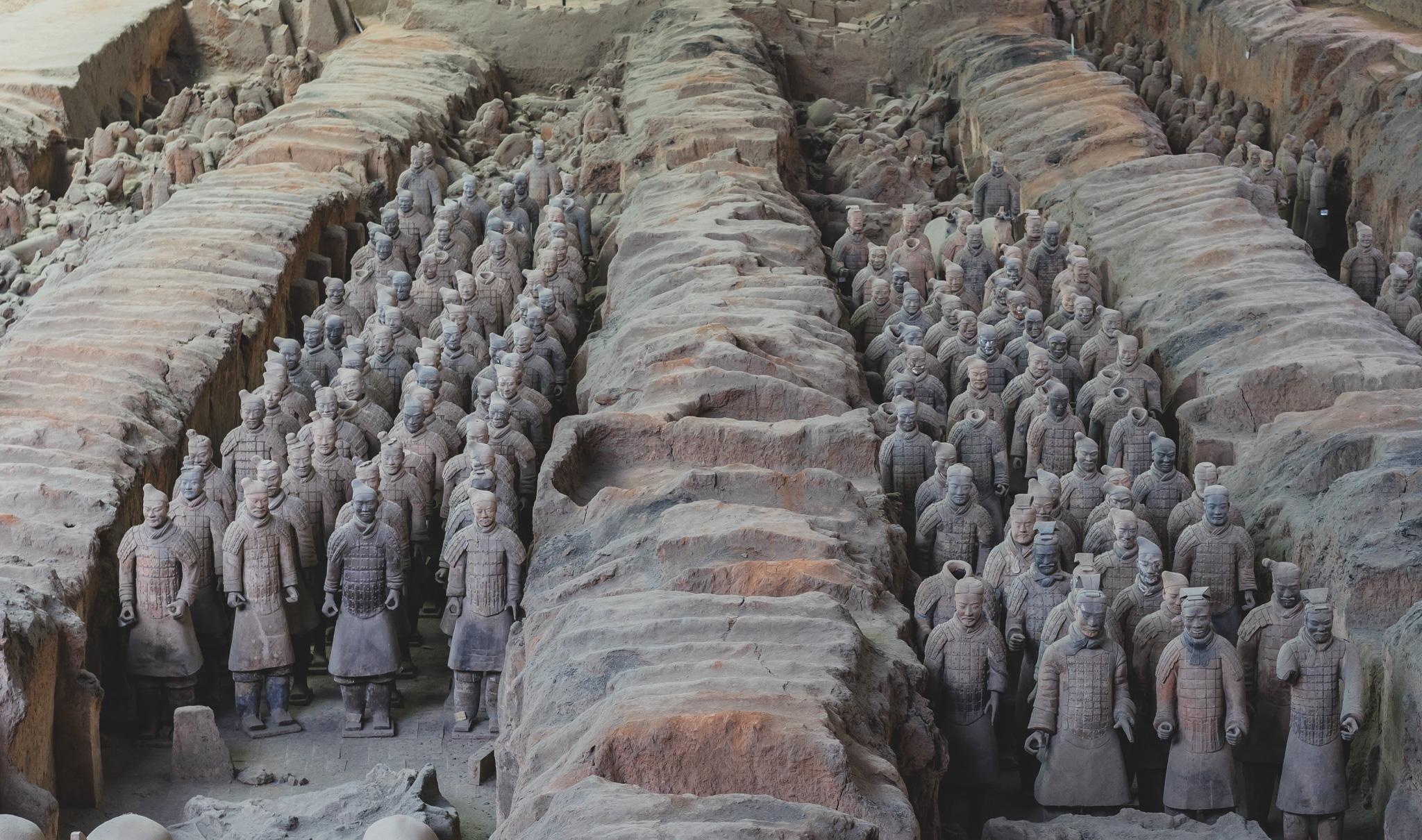
7 – Kyrgyzstan is a paradise for trekkers and nature lovers: Kyrgyzstan is without a doubt the most naturally beautiful Central Asian country. While small in area, it boasts a number of different landscapes. One of my personal favourites is the Alay Valley in the southern part of the country.
There are countless different treks that you can do while in Kyrgyzstan, and there is pretty good information floating around online about the best ones. The Ala-Kul trek is one of the most popular ones, although if you want to get really off the beaten path, treks such as the Heights of Alay will be right up your alley.
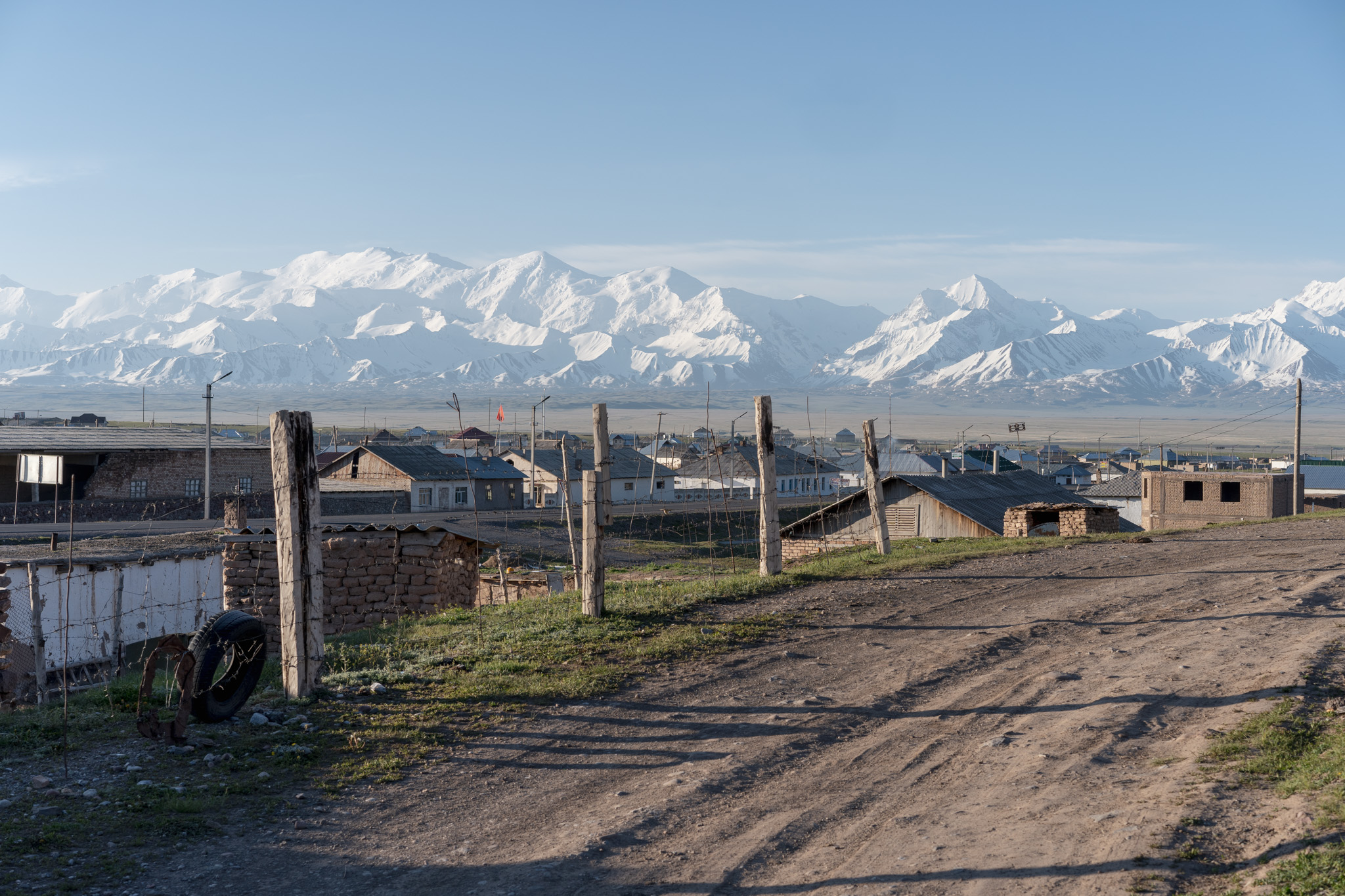
8 – Mountaineers will be right at home: Some of the most accessible 7,000-meter peaks in the world are located in Kyrgyzstan, and there are a number of agencies that assist experienced climbers in making attempts on these giant mountains.
I personally attempted to climb Lenin Peak when I was in Kyrgyzstan, it was one of the most challenging things I’ve ever done but was incredibly beautiful.
9 – There are nice beaches in Kyrgyzstan: You probably wouldn’t expect to have a nice beach day with a mountain backdrop while you’re in Central Asia, but the massive Issy-Kul in Kyrgystan gives you this opportunity! There are a bunch of towns along the shores of Issy-Kul with great little beach resorts.
This lake is actually a popular summer destination among tourists from Russia and other parts of Central Asia!
Check out my backpacker’s guide to Kyrgyzstan for more info on this amazing country!
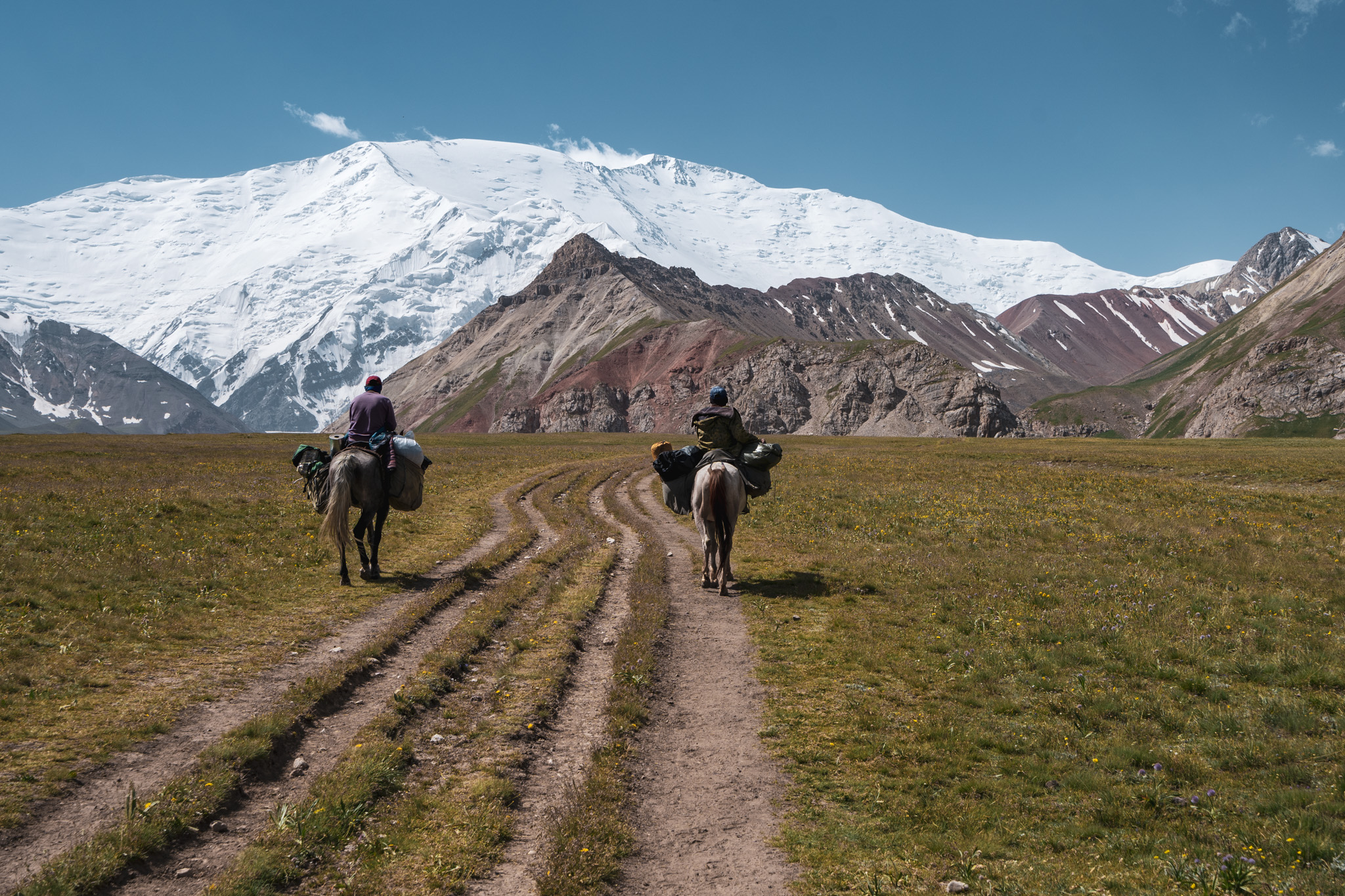
10 – Vast steppes and gorgeous mountains: While most of Kazakhstan is an empty steppe, there are some large mountains located in the Almaty and Altai regions of the country. The mountains in the Almaty region are super accessible (just a short bus ride from the city), and there are plenty of hiking and camping opportunities here.
11 – Almaty is the most European-like city in Central Asia: When you arrive in Almaty, you’ll notice immediately how European it feels. Everything from the architecture, cuisines, and way that people dress is quite a bit different than most of Central Asia. It’s a wonderful city to spend some relaxation time in after being in rural areas for a while. I ended up loving it so much I stayed in the city for almost two months!

12 – If you like history, Uzbekistan is for you: Out of all the Central Asian ‘stans, Uzbekistan has by far the best-preserved historical sights. The old cities of Bukhara and Khiva feel like living museums – you can wander around their endless alleys all day. Samarkand has the famous Registan and Gur-e-Amir (Mausoleum of Timur) which are two incredible sights that you can’t miss while travelling the Silk Road.
13 – The Aral Sea, one of man’s greatest mistakes: The Aral Sea was once a thriving sea in Uzbekistan, surrounded by fishing towns supporting tens of thousands of people. The Soviet Union decided to redirect the waters of the Aral Sea to use it as irrigation for cotton fields. Over time, this has lead to the Aral Sea almost completely drying up. Nowadays, one can visit the depressing former fishing town of Moynak to gain more insight into how the disaster affected people on the ground.
14 – Tashkent, the Soviet capital of Central Asia: Tashkent was the Soviet capital of Central Asia, and definitely still gives off those kinda vibes. The city is made up of giant 8-lane roads, large European looking buildings, and has plenty of monuments to look at if you’re bored.
For more info on travel in Uzbekistan, be sure to check out my detailed 2-week Uzbekistan itienerary !
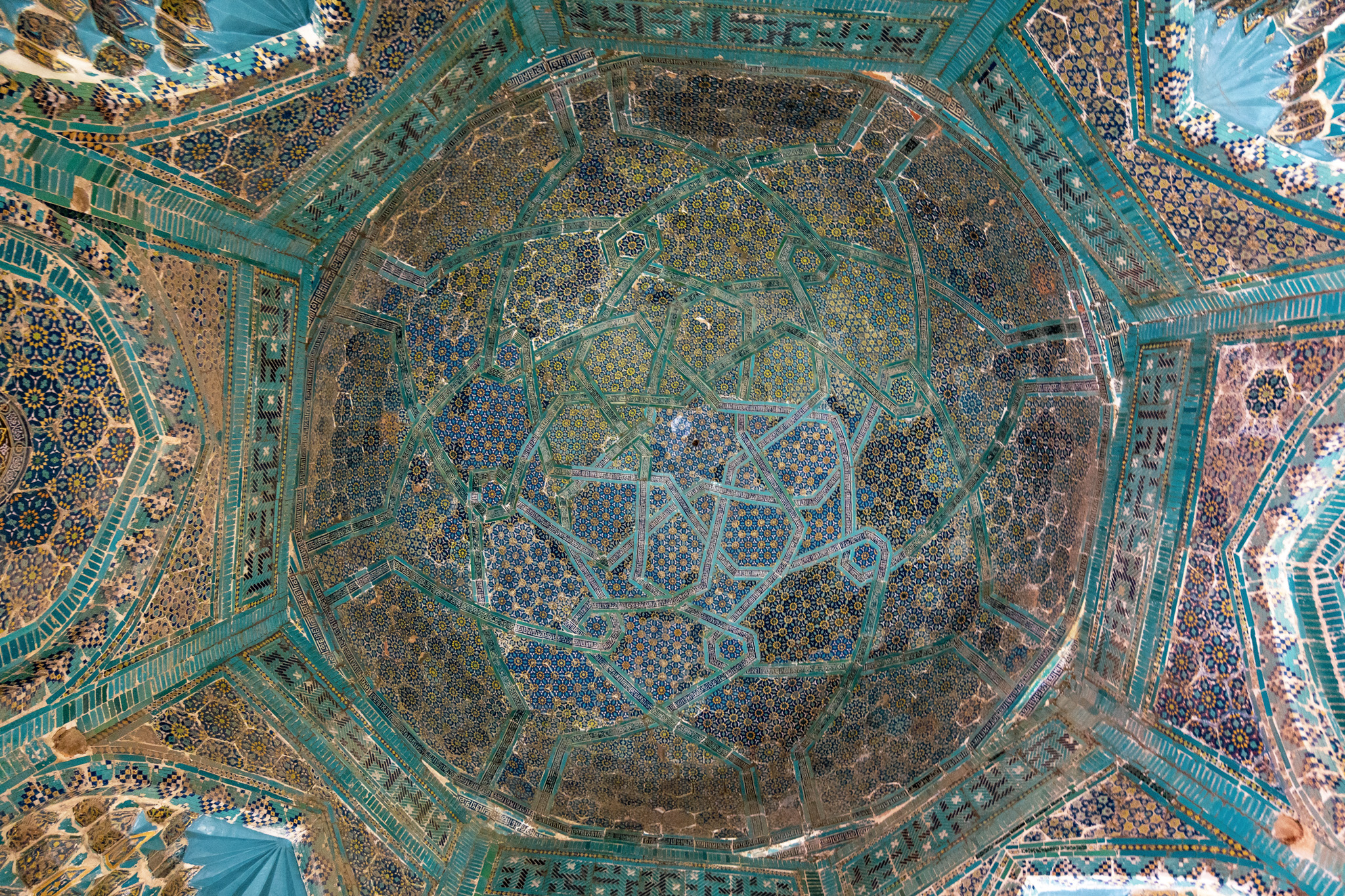
Ceilings in Samarkand, Uzbekistan
15 – World’s greatest road trip: Tajikistan is home to the Pamir Highway, arguably the world’s greatest road trip. The Pamir Highway travels through Tajikistan’s mountainous Pamir Region near the border with Afghanistan. When travelling on the highway, you’ll drive over epic 4,500 meter passes, descend into gorgeous valleys, and meet some of the most hospitable people on Earth.
16 – Undiscovered, yet ready to explore: Tajikistan often gets overshadowed by neighbouring Uzbekistan and Kyrgyzstan, but it’s so unique and beautiful it’d be a shame to miss it. There are plenty of regions of Tajikistan that see almost no tourists (the Bartang Valley, parts of the Fann Mountains, the Eastern Pamir). Tajiks are very friendly and the Persian influence on their culture is very unique from the rest of Central Asia.
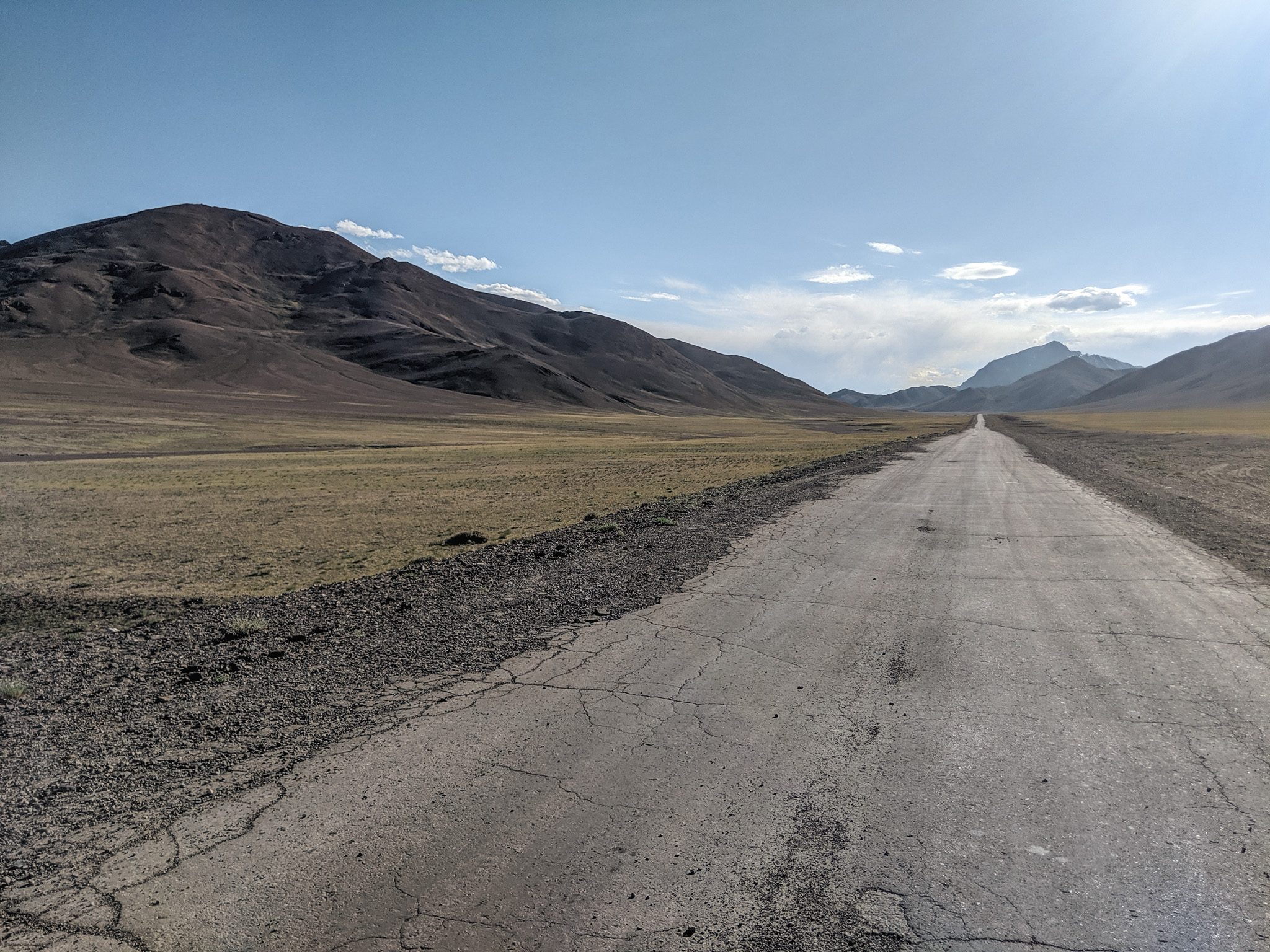
Turkmenistan
17 – The North Korea of the Silk Road: Turkmenistan is a very closed off country, and is often touted as the North Korea of Central Asia. Tourist visas are impossible to get without visiting on a guided tour, making the country pretty off-limits for most backpackers.
Afghanistan (Wakhan Corridor)
18 – Marco Polo’s route to China: During his travels along the Silk Road, Marco Polo passed through the Wakhan Corridor and Little Pamir to enter China via the Wakhjir Pass (4,923 m). This is one of the most remote and treacherous trade routes around, but locals have no choice but to use it.
19 – One of the most untouched places on the planet: Visiting Afghanistan’s Wakhan Corridor is like a trip back in time. Much of the region still doesn’t have any electricity and internet access is-non existent. This place isn’t for everyone, but experienced travellers will remember it for the rest of their lives.
For more info on visiting, check out my detailed guide to Afghanistan’s Wakhan Corridor .
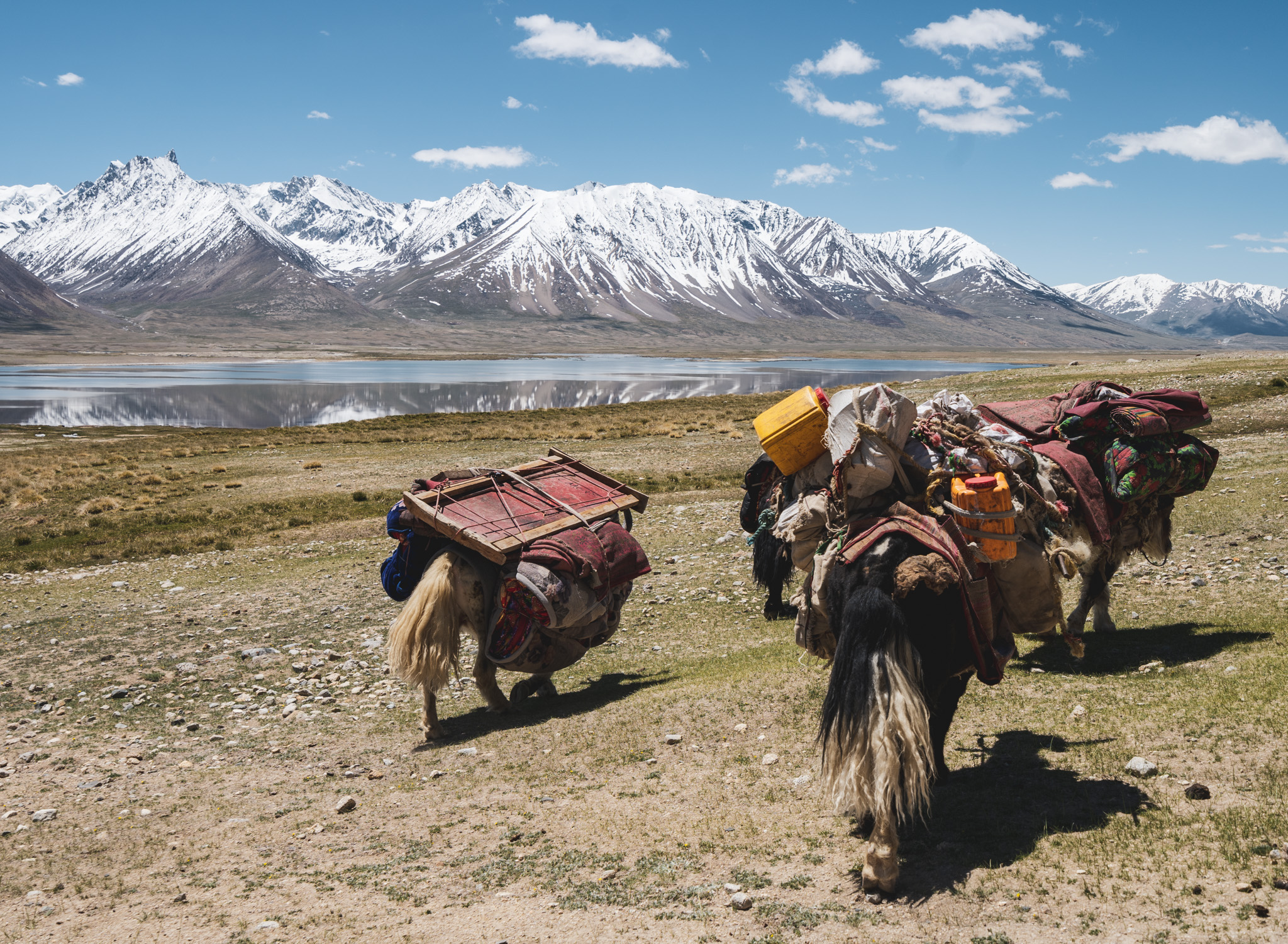
Silk Road Travel Routes
So now that you know a little bit about the countries that lie along the Silk Road, what is the best way to travel through them?
Let’s go over a few classic Silk Road travel itineraries.
20 – China to Central Asia – the classic Silk Road route: If you want to follow the classic route that traders would’ve taken towards Europe, begin your journey in Xi’an and start heading west. You should stop in Lanzhou, Dunhuang, Zhangye, Turpan, Urumqi, and Kashgar before crossing the Irkeshtam Pass into Kyrgyzstan.
When you’re in Kyrgyzstan, you’ve got a few options. You could head south to Tajikistan along the Pamir Highway, or go north to Bishkek (Kyrgyzstan’s Capital) before crossing to Almaty for a little taste of Europe in Central Asia. From either Tajikistan or Kazakhstan, cross the border into Uzbekistan and check out the famous oasis cities of Bukhara and Khiva.
You can end your trip after Uzbekistan, or consider applying for a Turkmenistan transit visa to continue onto Iran if you’ve got even more time.
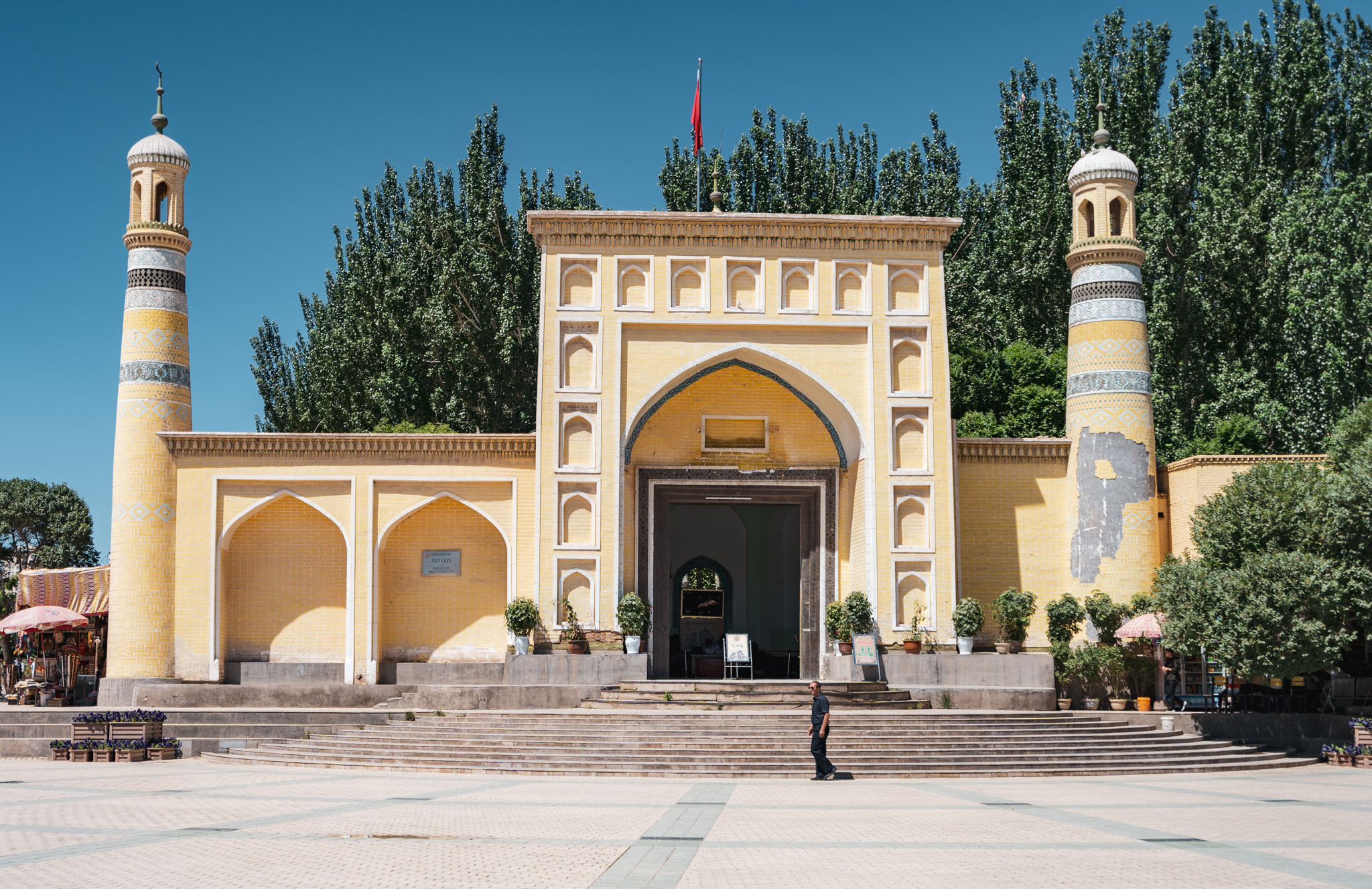
21 – The Central Asia Loop itinerary: If you want to focus on the heart of Central Asia, you need to visit Kazakhstan, Kyrgyzstan, Tajikistan, and Uzbekistan.
I’d recommend flying into Almaty, then heading down to Bishkek for some time exploring Kyrgyzstan (Karakol and Osh are must-sees). After that, head south to Dushanbe, Tajikistan via the Pamir Highway and Wakhan Valley (and hop into Afghanistan’s Wakhan Corridor if you’re up for it!).
After Dushanbe, visit Tajikistan’s Fann Mountains (if you’re not yet tired of mountains) before crossing the border into Uzbekistan. While in Uzbekistan, check out Khiva, Bukhara, Samarkand, and Tashkent before taking an overnight train back to Almaty.
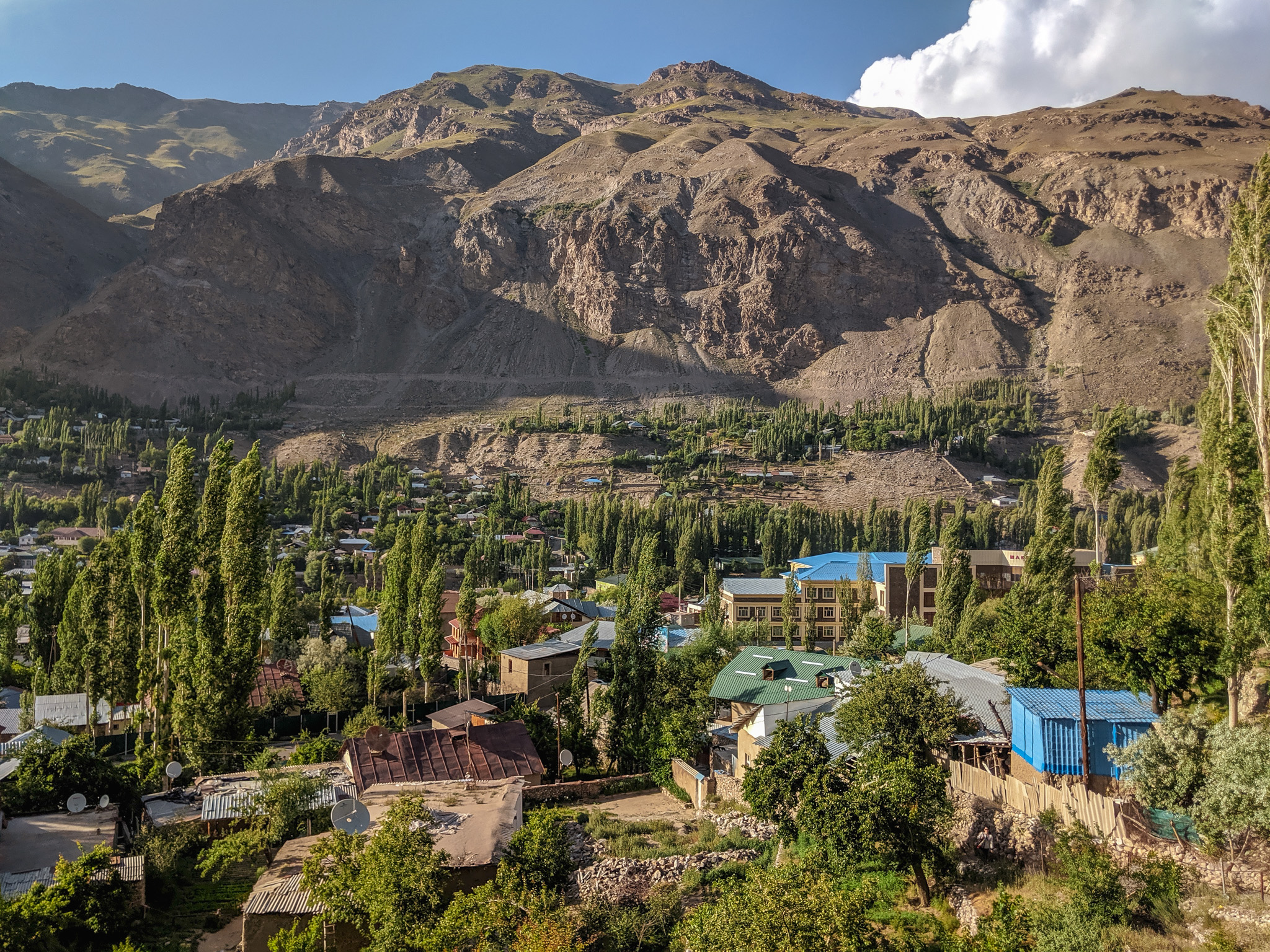
Food along the Silk Road
22 – Food along the Silk Road is very diverse: Plov, Lagman, Shashlik, Samsas and Beshbarmark are just some of the unique foods that you’ll encounter while travelling around this part of the world. Central Asian food tends to be meat and dairy heavy, whereas Chinese food focuses much more on spices to add flavour.
23 – Plov and Lagman are the most common dishes: In all of the Central Asian countries, you’ll be able to find plov and lagman. Plov is a rice dish with meat and veggies (usually beef and carrots). Lagman is a noodle dish that originates from Uyghur parts of Central Asia. It’s typically made with pulled noodles, meat and vegetables. Spice levels with lagman vary, I only ever found it spicy enough in Xinjiang (China).
24 – Kumis is an alcoholic dairy drink: Made from fermented horse milk, you’ll often find kumis in rural areas of Kazakhstan and Kyrgyzstan. It’s got a slight alcohol percentage and a sour taste that takes some getting used to!
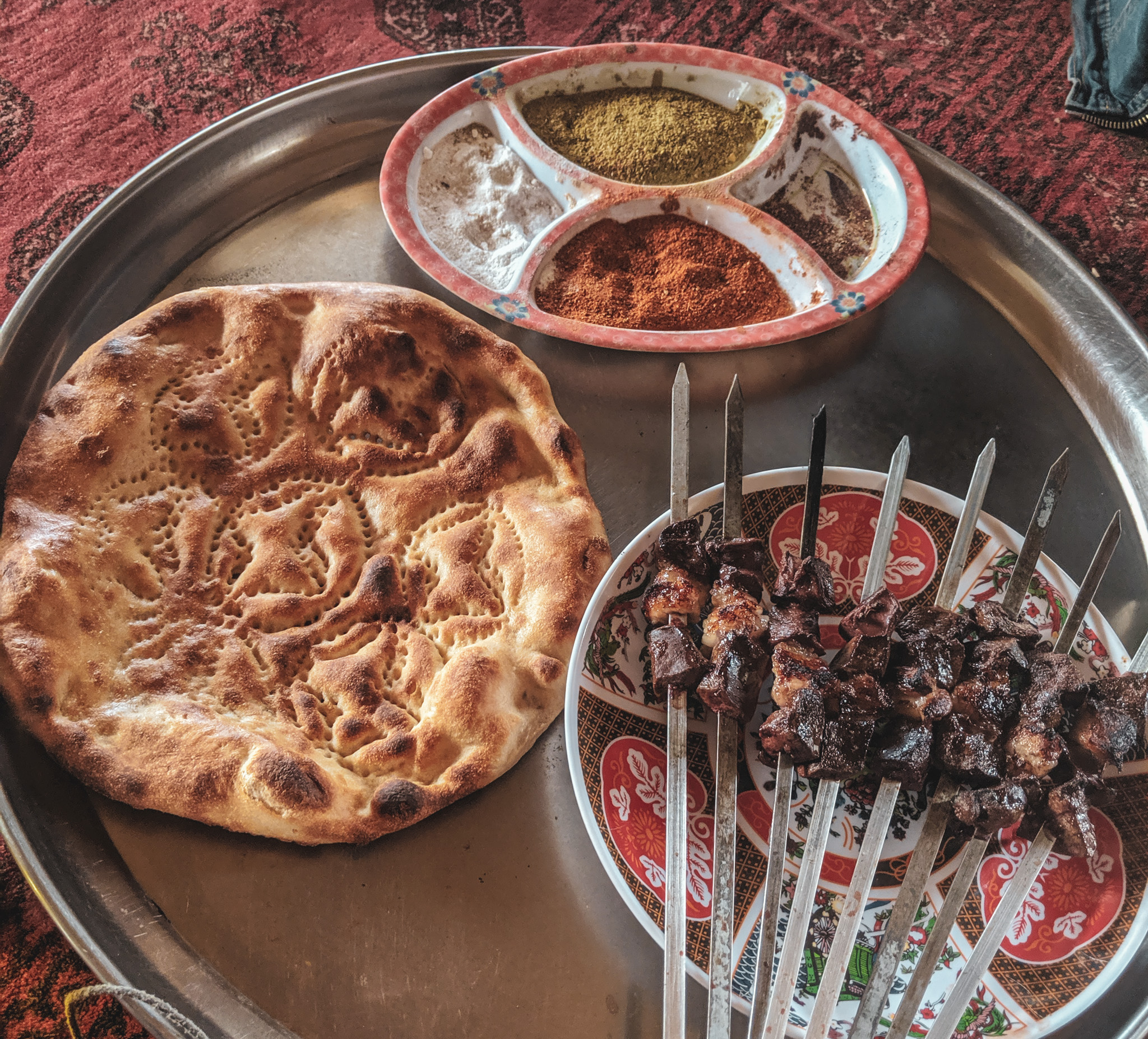
People & Culture of the Silk Road
25 – The Silk Road is incredibly diverse: There are so many different ethnic groups in Central Asia, it’d be impossible to list them all. The most common ones that you’ll encounter are Uyghurs, Kazakhs, Kyrgyz, Uzbeks, Tajiks, and Dungans. As a result of the Soviet Union and China, there are also plenty of Han Chinese, Russians, and Koreans scattered around Central Asia.
26 – Islam is the most common religion: All Central Asian ‘stans are Muslim, and much of the Xinjiang region of China is as well (at least.. for now). Kyrgyzstan and Kazakhstan are the most liberal areas, with plenty of people drinking alcohol and not fasting during Ramadan.
Uzbekistan and Tajikistan are more conservative, especially the southern regions of both countries. However, they are still much more liberal than places like Pakistan or Saudi Arabia .
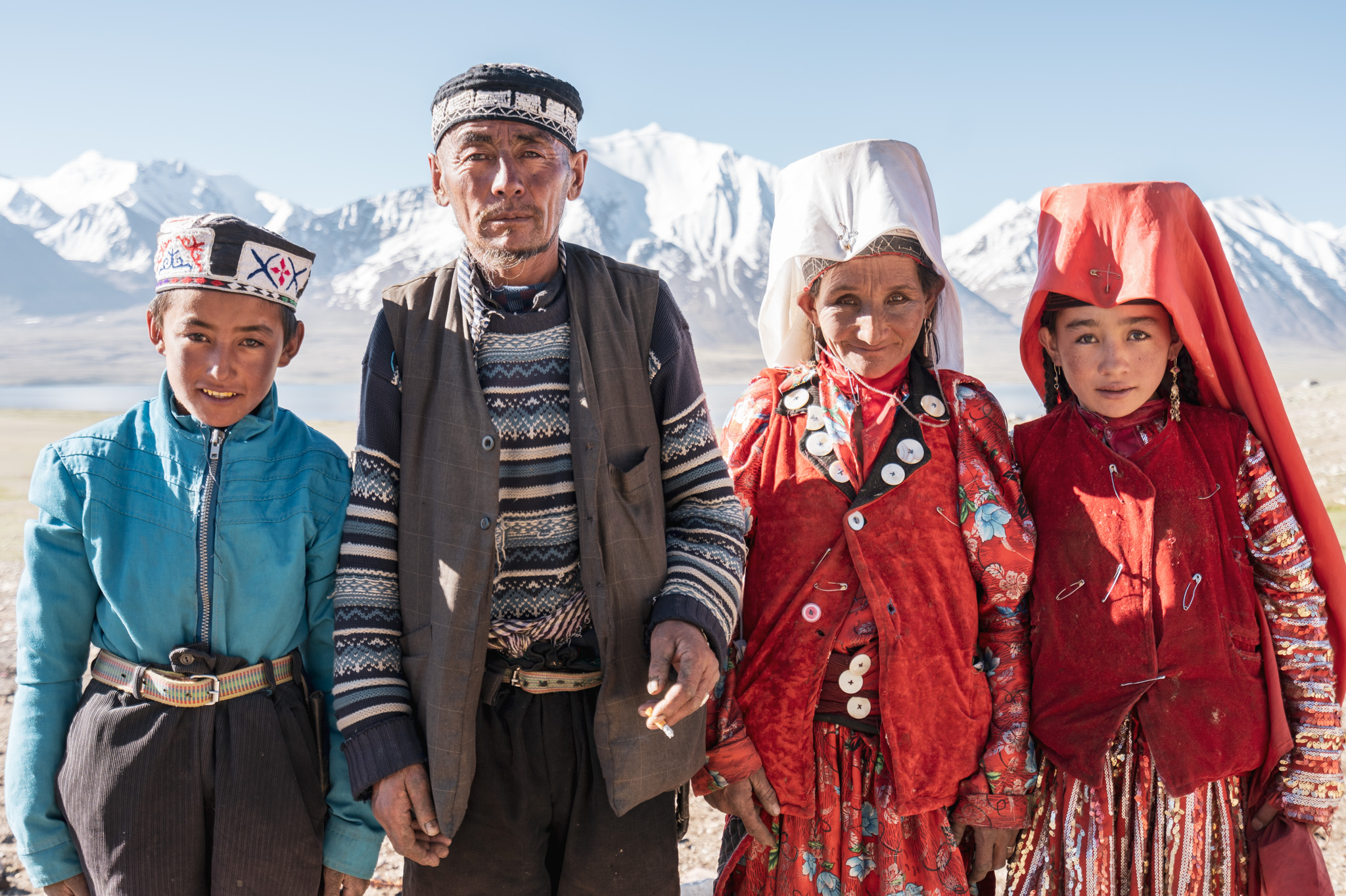
27 – People are extremely hospitable: One thing that all of the people living in Central Asia have in common is their hospitality. No matter where I went, I was always welcomed with open arms and a cup of chai. People don’t see very many tourists around here and want to treat their guests as well as they can. You don’t have to worry about people being unfriendly here – just keep a smile on your face and you’ll have a wonderful time.
28 – Dress code varies from country to country: In liberal Almaty, girls can wear whatever they want and nobody will bat an eye. Try to do that in southern Tajikistan and you’ll get a different reaction.
In more religious areas, you should dress modestly. For the dudes, pants and a t-shirt is fine everywhere in Central Asia. For females, nothing revealing and you’ll be ok.
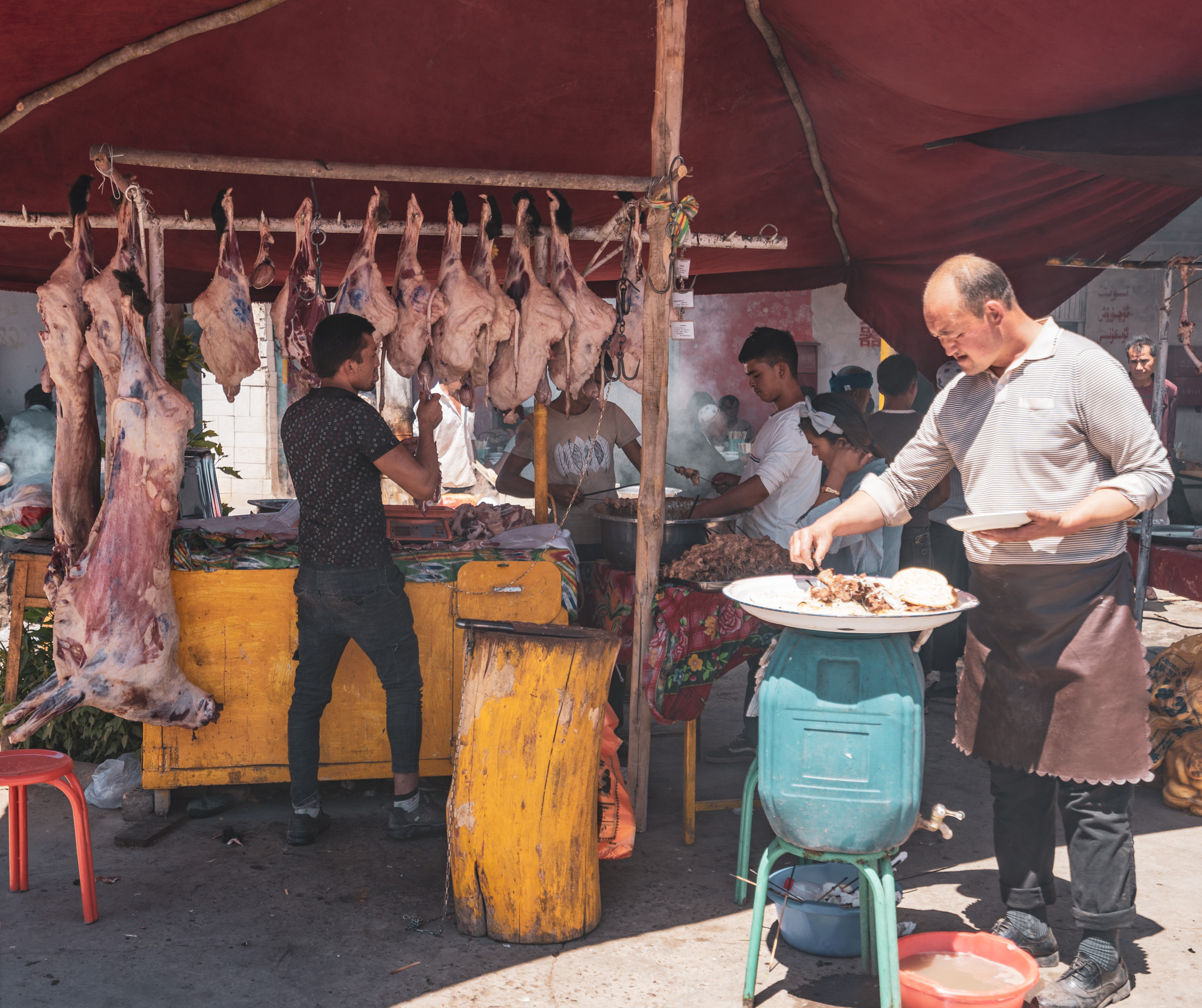
Visas for travelling the Silk Road
29 – Visas issues in Central Asia are disappearing: Central Asia used to be one of the most difficult regions to travel around. Travellers would need a visa for every country, and they wouldn’t be easy to get.
Nowadays, things are a lot easier. Uzbekistan and Kazakhstan offer 30-day visa-free access for a number of nationalities. Kyrgyzstan gives 60-days for most people. Tajikistan still requires an e-visa, but it is easy to apply for online and can be gotten within a week or so and is valid for 45-days.
China still requires a visa, but it should be fairly straightforward to apply for before you leave home.
Turkmenistan is still locked down. You can’t get a tourist visa without a guided tour, although travellers are sometimes able to visit independently on a short 5-day transit visa.
30 – Border crossings aren’t too bad: Unless you fly everywhere, you’ll end up having to cross some borders while travelling the Silk Road.
Most border crossings in Central Asia are fairly straightforward now, and you don’t need to worry about a strict bag inspection or anything.
Exceptions are borders into and out of China. Expect a full bag inspection, as well as a search of all the photos on your electronic devices.
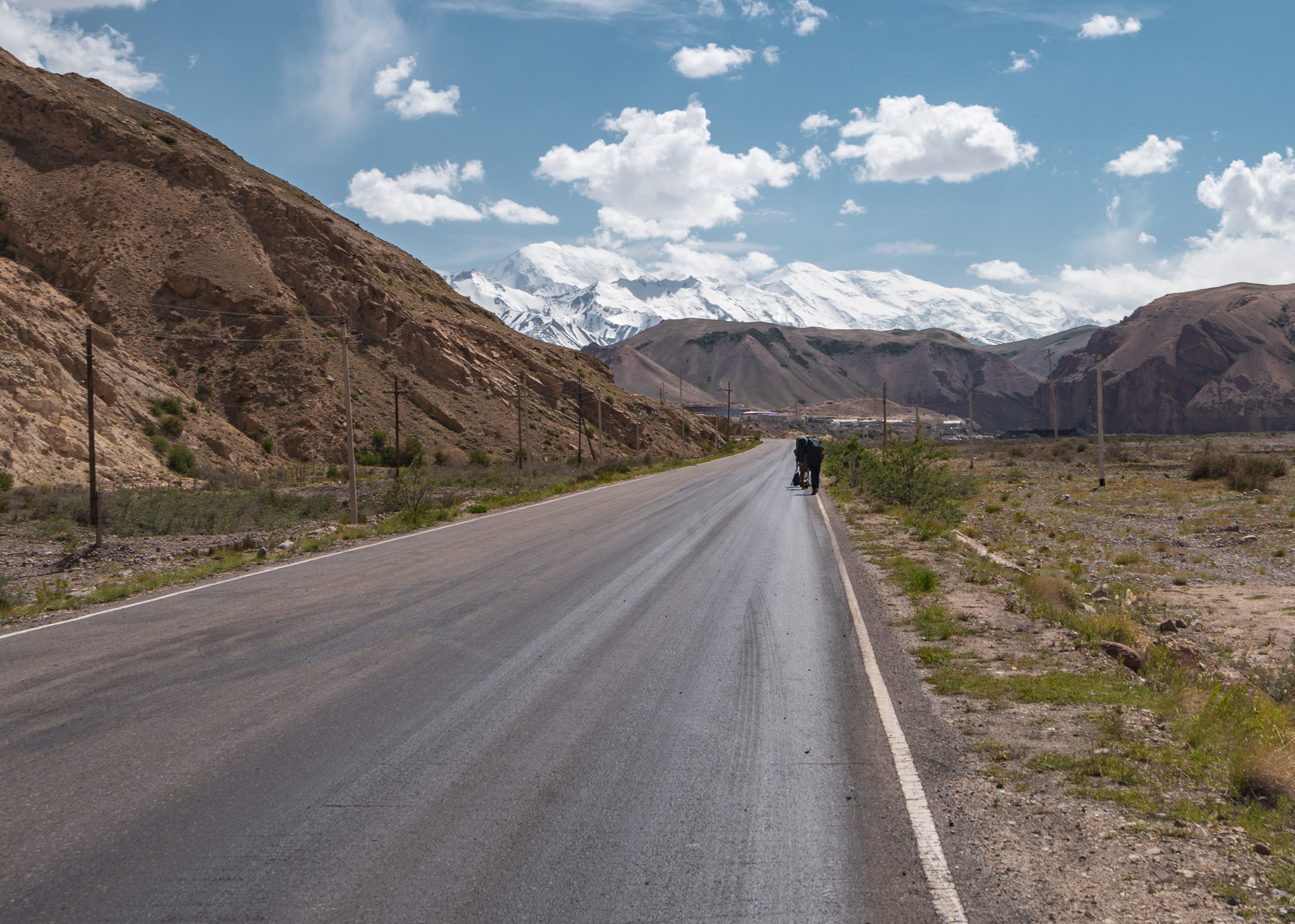
Safety along the Silk Road
31 – Central Asia is reasonably safe: I’ve spent a long time in Central Asia, and never once had any safety issues. While this is simply anecdotal, governments usually just advise travellers to proceed with caution while in Central Asia.
There are areas that are more dangerous than others. Parts of the Uzbek/Kyrgyz border infrequently have small violent clashes (you wouldn’t visit here anyway), and southern Tajikistan sometimes has issues.
The areas that tourists usually visit are very safe, in my opinion.
32 – Be careful with nature: I’d guess that most issues that arise when travelling in Central Asia are due to altitude sickness and twisted ankles. If you’re planning a trip along the Pamir Highway, you need to be sure to properly acclimatize or you could get altitude sickness. When hiking, always be careful and go with a guide if you’re unsure of your abilities.
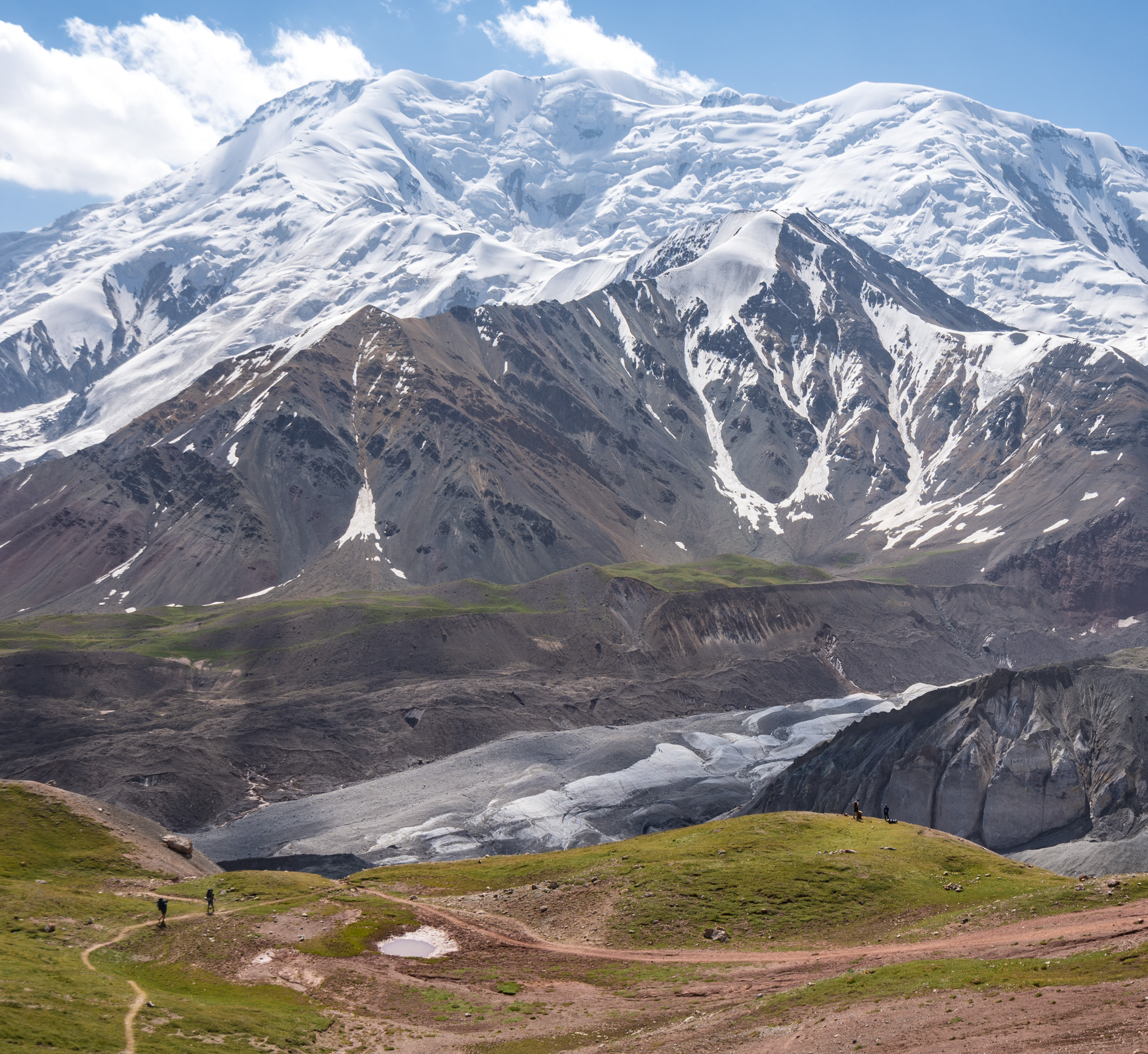
33 – Driving can be dangerous: Like everywhere in the world, Central Asia has some crazy drivers. Combine this with windy mountain roads, and you’re asking for disaster.
All you can do here is get out of a vehicle if you feel unsafe. If the driver smells like alcohol, that’s a bad sign.
In many places, you can take a train rather than drive, but driving is required to travel around Kyrgyzstan and Tajikistan.
34 – Don’t forget your travel insurance: No matter where you go, you should always have travel insurance – Central Asia is no exception. Even though Central Asia is safe, accidents can still happen.
I personally use and recommend World Nomads. It’s designed for adventurous travellers with cover for overseas medical, evacuation, baggage and a range of adventure sports and activities (important if you plan on doing any hiking or other outdoor activities while in Central Asia).
GET YOUR FREE QUOTE FROM WORLD NOMADS HERE
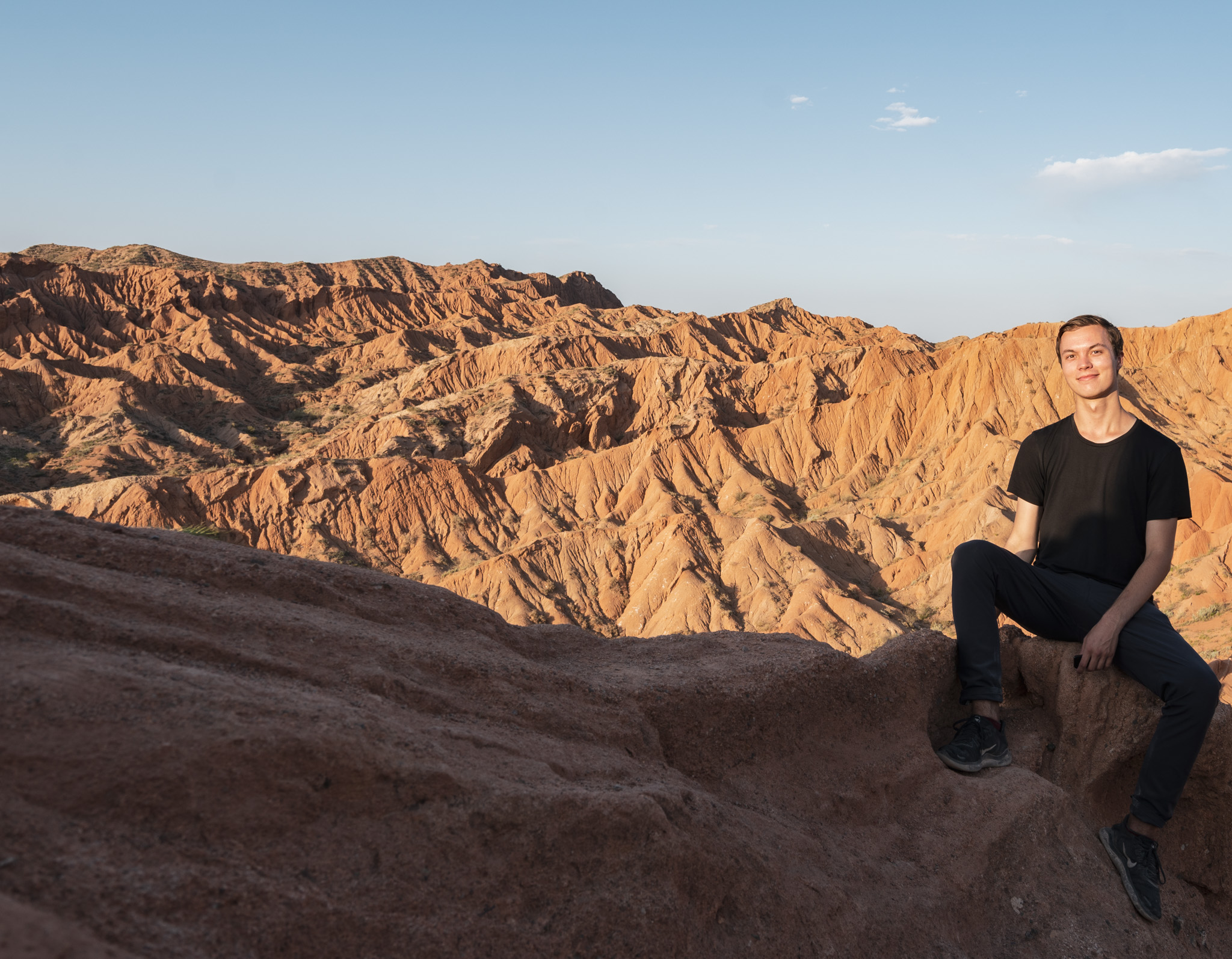
Transportation while travelling the Silk Road
35 – Travelling the Silk Road involves long journey times: Distances are massive along the Silk Road, and the roads and railways are usually not the most modern.
For example, a train from Xi’an to Kashgar takes a solid 40 hours, and a minivan from Bishkek to Osh takes about 14 hours.
Patience is key here, but at least you’ll be able to look out the window and enjoy views of the epic scenery of Central Asia.
36 – When you can, take the train: Trains aren’t always an option, but in China, Kazakhstan, and Uzbekistan they have pretty good networks. Trains are much more comfortable for long distances than buses, and they often run overnight so you can just sleep in a bed the entire journey.
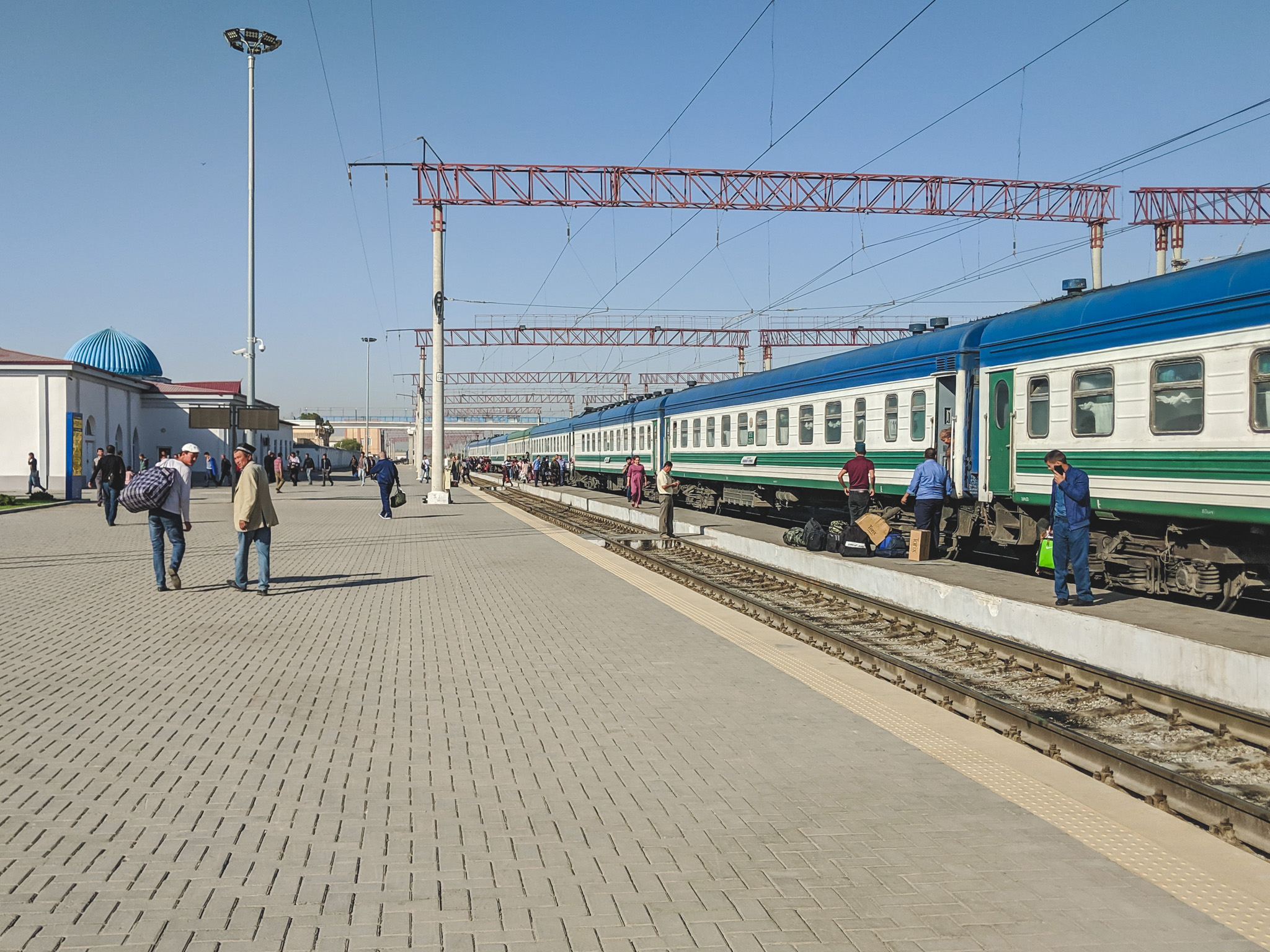
37 – Get ready for a lot of marshrutka rides: Marshrutkas (minivans) are the backbone of Central Asia. They run throughout all of the former Soviet Union countries and are pretty affordable.
Try to avoid sitting in the very back – it’s uncomfortable and you can’t see anything. Bring plenty of water, as these things don’t usually have air conditioning and the Central Asian summer gets bloody hot.
38 – Consider flying if you’re short on time: While I prefer overland travel, I understand that not everybody has 6 months to spend screwing around in Central Asia.
If you need to get from Osh to Bishkek (and you’ve already seen that epic drive at least once), then just take the $30 flight and skip the 14-hour long drive.
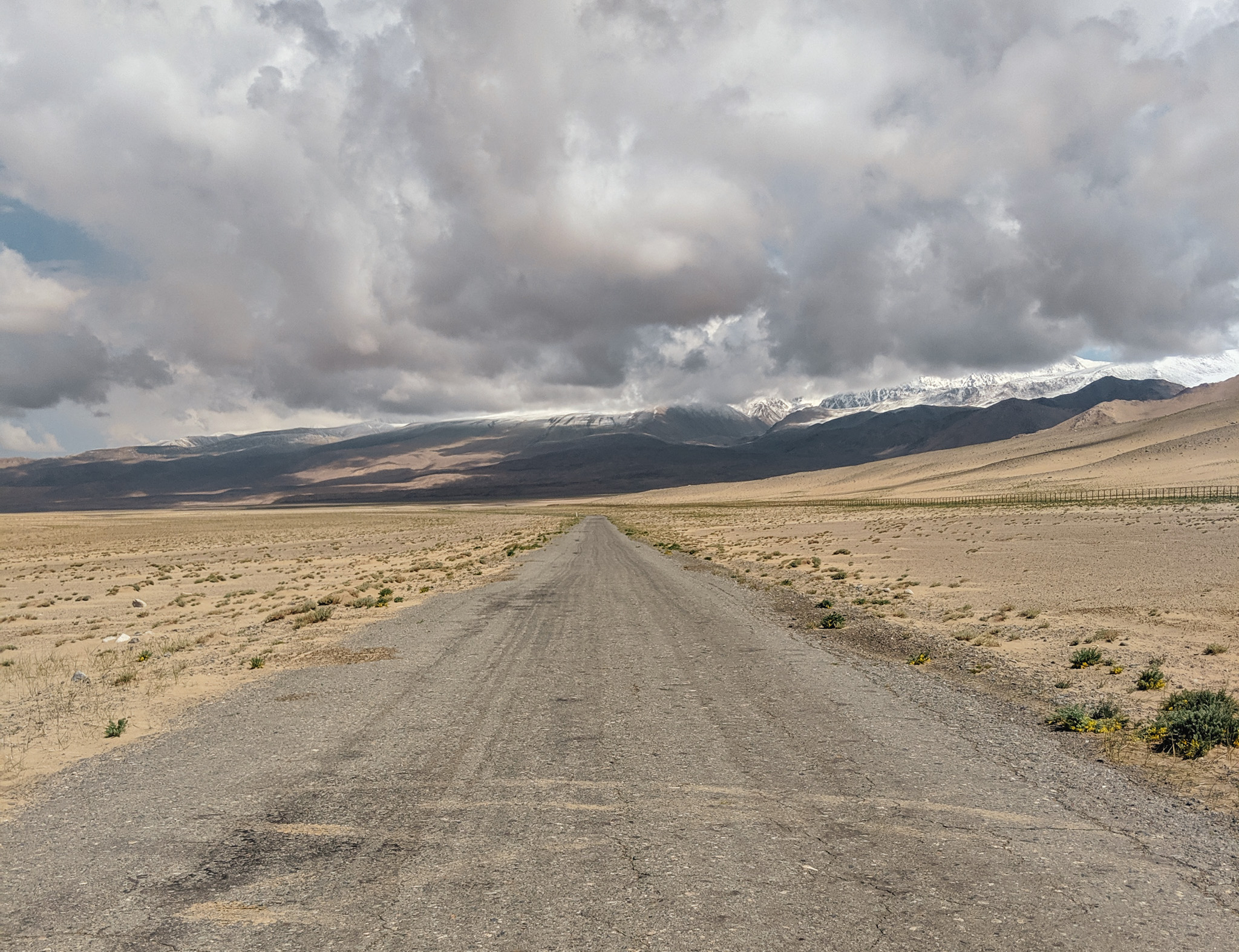
Accommodation while travelling the Silk Road
39 – Most forms of accommodation are available: In most places that you’ll visit while travelling the Silk Road, there are both budget and mid-range accommodation types available.
Hostels are common in Central Asia and are very affordable. Hotels are also found in all cities and large towns.
In rural areas, I recommend staying at a homestay to experience true Central Asian hospitality.
40 – When you’re in Kyrgyzstan, you need to sleep in a yurt : The yurt is the traditional home of nomadic Kyrgyz, Kazakh, and Mongolian people. A yurt is a round, single-room building that is usually white on the outside. They’re warm and comfortable even when high in the mountains.
Tourist yurts are common in Kyrgyzstan, and the perfect place to spent a night while trekking.
41 – Research your Xinjiang accommodation in advance: The far west Chinese province of Xinjiang has a lot of restrictions on which hotels foreigners are allowed to stay at. The list is always changing, so you need to do a bit of research to find where you’ll be allowed to stay during your trip.
If you’re travelling with a tour, this would be arranged for you.
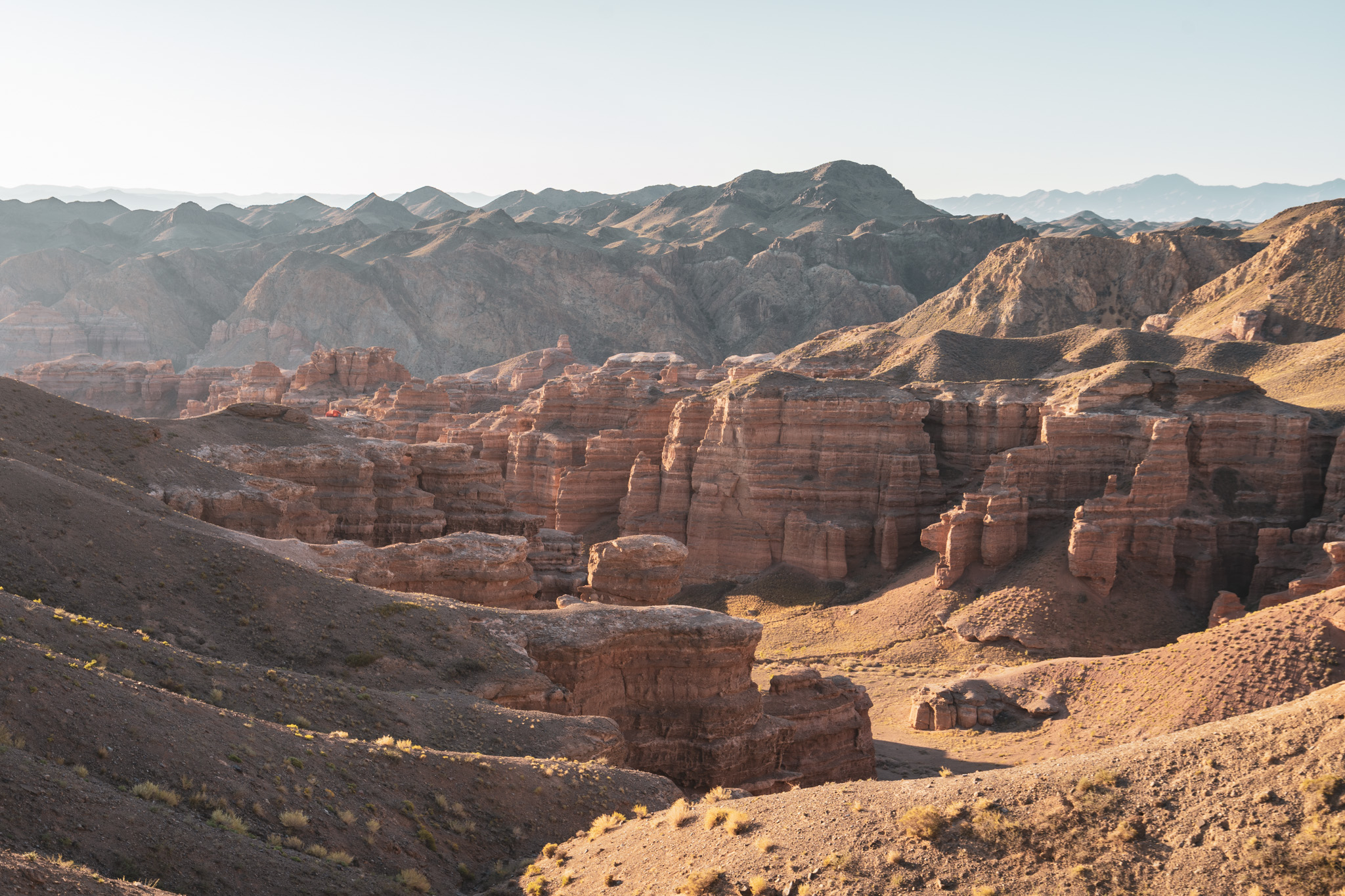
Silk Road Travel Costs
42 – Central Asia is a pretty cheap place: While not as cheap as India or Vietnam, travelling in Central Asia is still very affordable. If you stick to hostels, local food, and public transport, you can easily keep your budget around $35 per day.
If you want a bit more luxury, push that budget to $50 and you’ll be able to have amazing meals and stay in pretty nice places.
43 – China can be a bit more pricey: With China’s economic boom, prices have been increasing. While travelling in China is affordable for the most part, certain things like entrance fees and train tickets can add up over time.
44 – Money-saving tips: To save some money while travelling in Central Asia, I’d recommend using Couchsurfing and hitchhiking when possible.
Couchsurfing is a great way to meet locals, and you’ll save a bit of cash. Hitchhiking in Central Asia is fairly easy, although you sometimes have to pay a small amount (even locals do this).
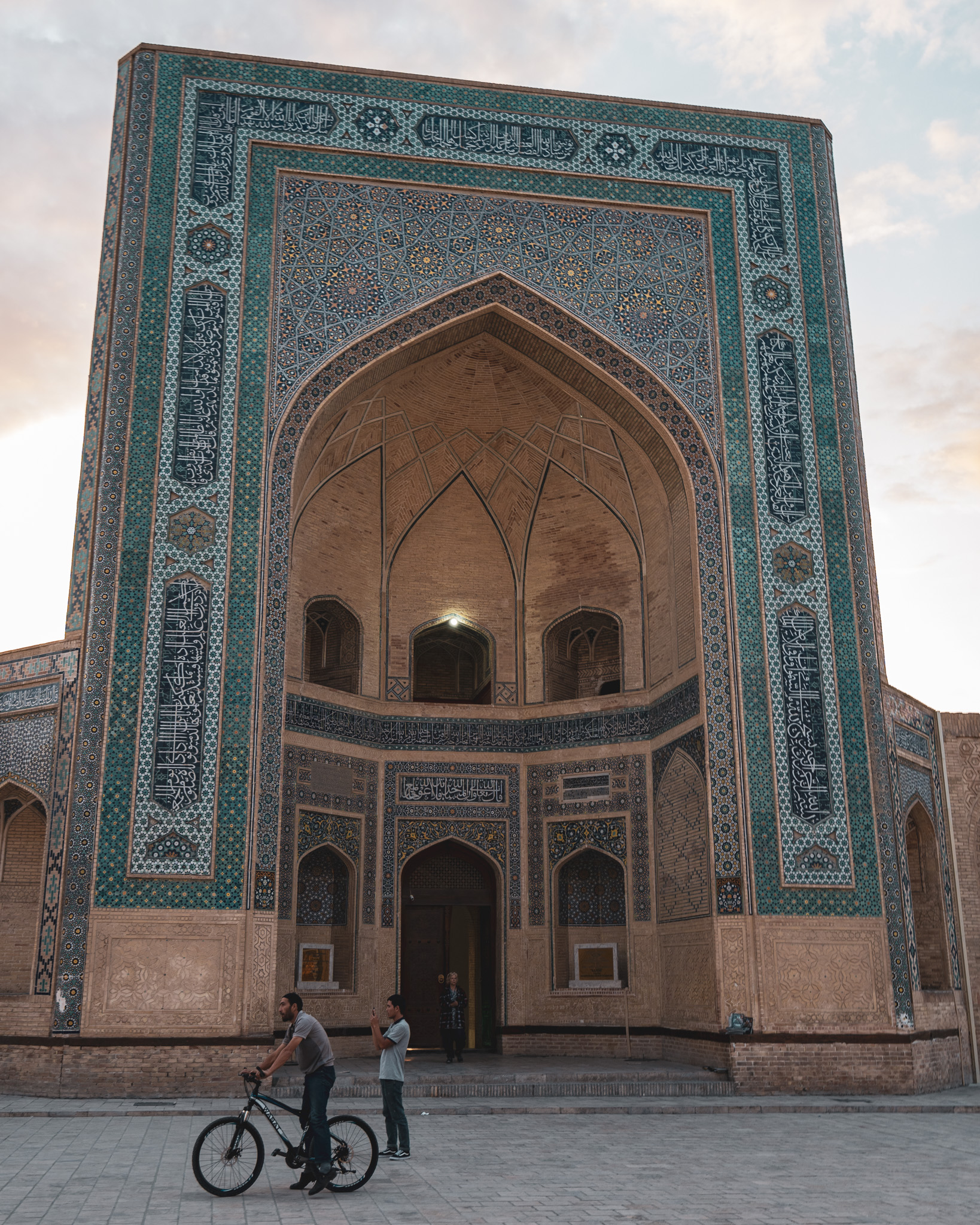
When to travel the Silk Road
45 – Summers are super hot: The Central Asian summer is extremely hot. Summer temperatures can reach 50°C in Uzbekistan and Turkmenistan, and cities like Tashkent and Dushanbe get pretty unbearable. Central Asia is quite dry, so you don’t need to worry about humidity, at least.
However, summer is the perfect time if you want to get into the mountains of Kyrgyzstan or Tajikistan. The trekking season is short here, usually running from June to mid-September. If you’re at all interested in outdoor adventures, summer is a great time. You’ll just need to bear the city heat while you pass through them.
46 – Spring and Autumn are perfect: For the most comfortable experience, travel the Silk Road during spring or autumn. These seasons bring comfortable temperatures, especially in places like Uzbekistan. In the mountains of Tajikistan and Kyrgyzstan, things will be a bit chilly but it’s still possible to do some short hikes.
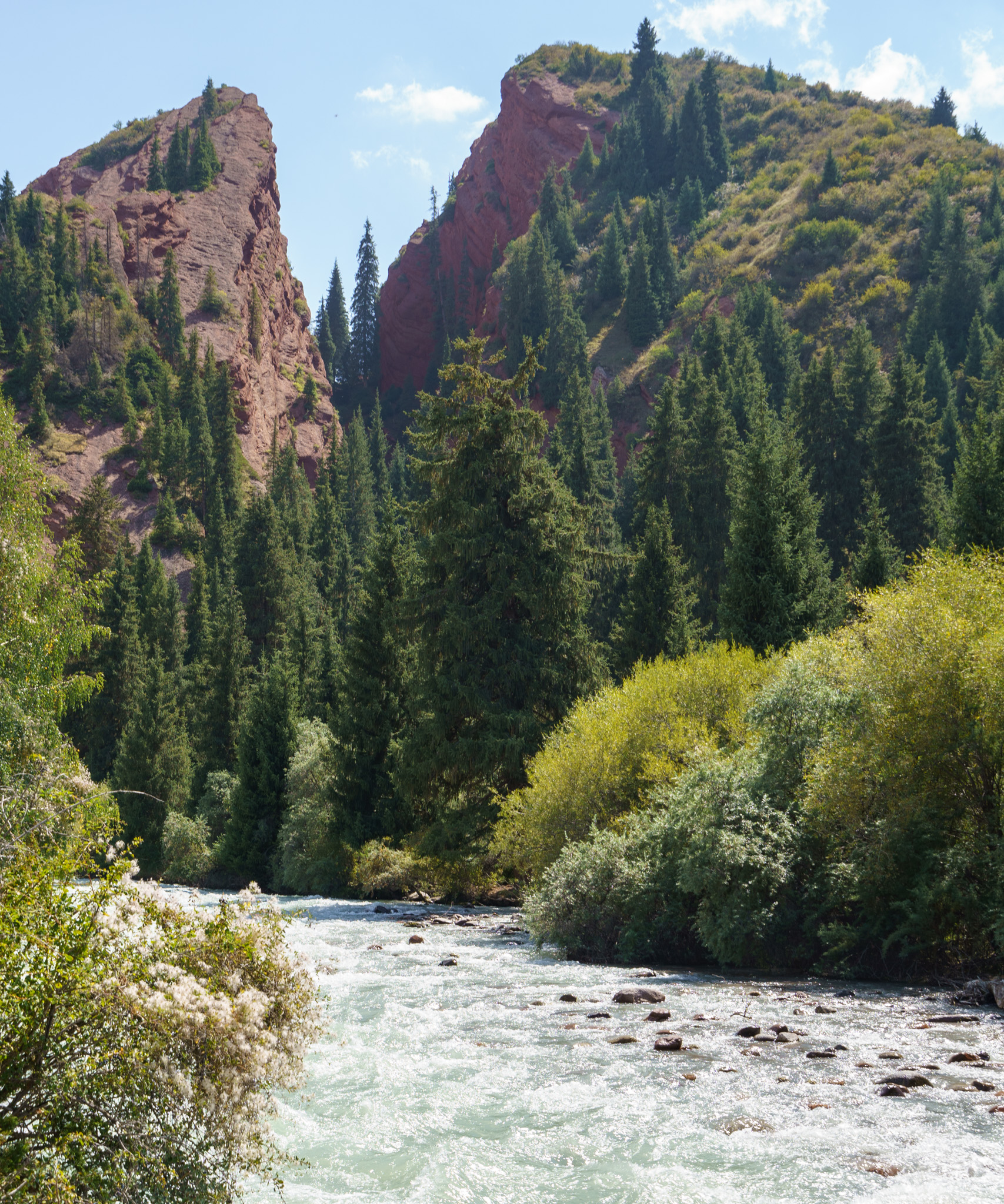
47 – Winters are harsh: Central Asia is a land of extremes. Winter brings freezing temperatures to much of the region. While travel is doable at this time of year, bring warm clothes and understand that certain summer activities just won’t be possible.
Snow-covered landscapes are beautiful, and the Silk Road landscapes look unique while covered in a blanket of fresh white snow.
If you’re a skier, you’ll be happy to know that Almaty, Bishkek, and Karakol have some great hills! Rental prices are pretty reasonable.
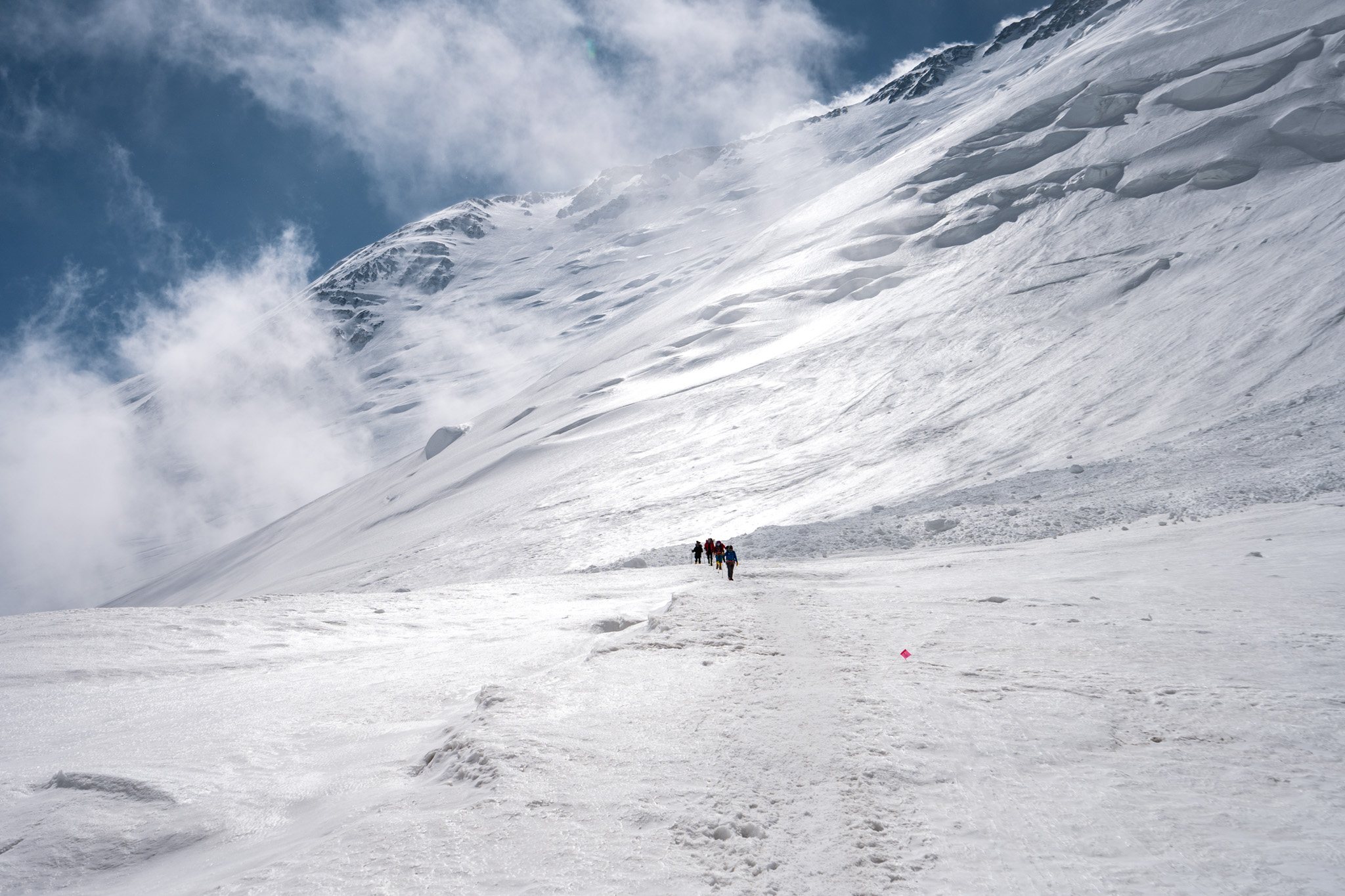
Communication along the Silk Road
48 – Russian is the most useful language: The five Central Asian ‘stans spent quite a while in the Soviet Union, and the Russian language spread throughout them during this time.
In Kyrgyzstan and Kazakhstan, almost everybody knows Russian, especially in the cities. It’s much more common to hear Russian being spoken in Bishkek than Kyrgyz.
Uzbekistan still has quite a lot of Russian speakers as well, especially in Tashkent. In Tajikistan and Turkmenistan, Russin is less common but it’s still possible to find some speakers of it.
While you obviously don’t need to learn Russian to travel in Central Asia, it sure does help to learn the Cyrillic alphabet and some basic phrases.
I recommend picking up a Russian phrasebook before leaving home.
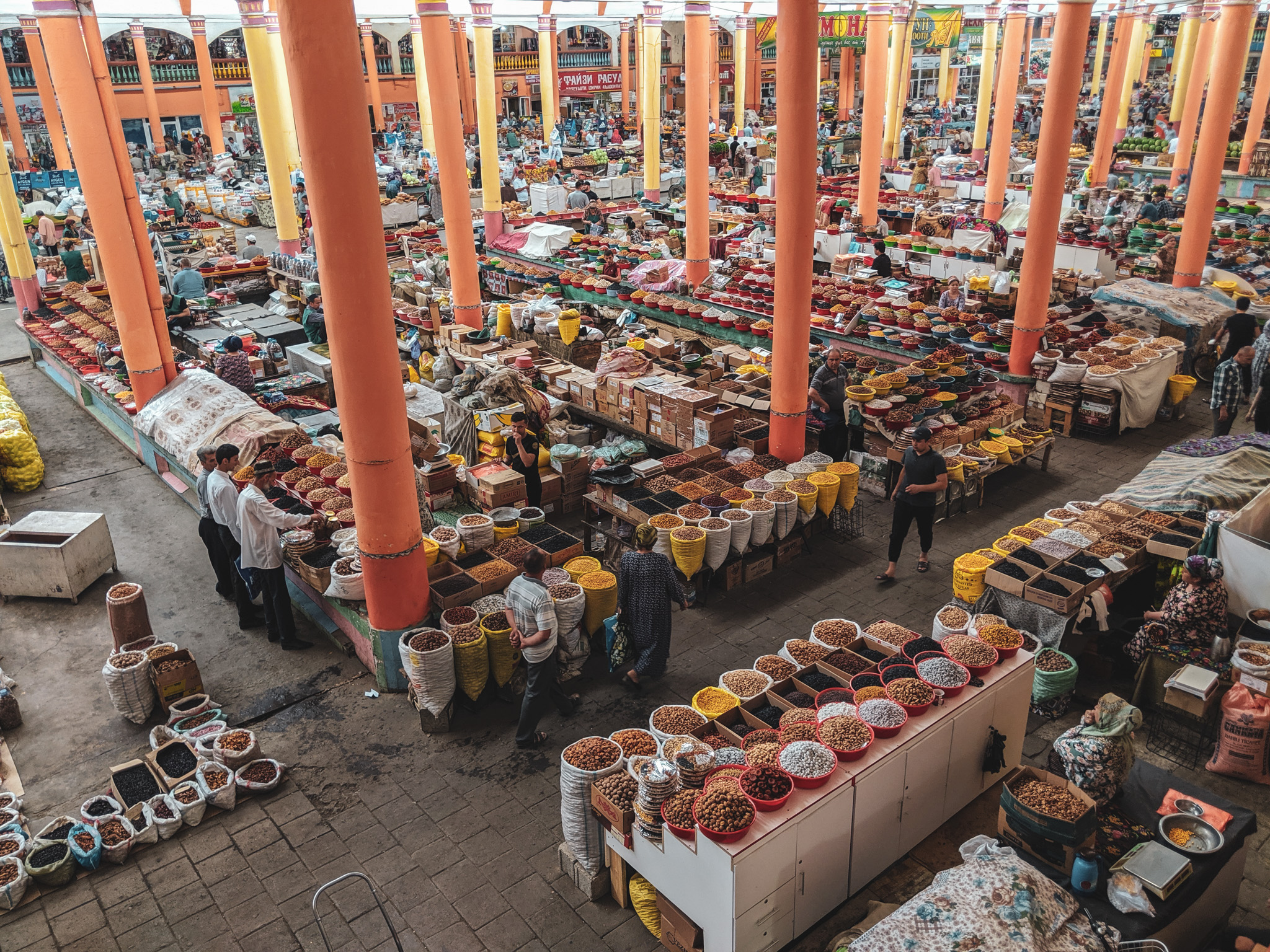
49 – People love if you learn a word or two in their local language: Just learning how to say “thank you” in Kyrgyz ( rahmat ) makes Kyrgyz people super happy. I always try to do this when travelling, and in Central Asia, it’s a really great thing to do.
50 – Plenty of people know English: With tourism increasing along the Silk Road, more and more people are learning some English to work in the tourism industry. At hotels and hostels, you’ll usually be able to find an employee who knows English.
In cities like Bishkek and Almaty, so many young people know English and are eager to practice with foreigners. I’ve had people start friendly conversations with me just because they heard me speaking English.
Don’t stress if you don’t know any Russian or local languages. I always manage to get by with English, Google Translate, and some patience.
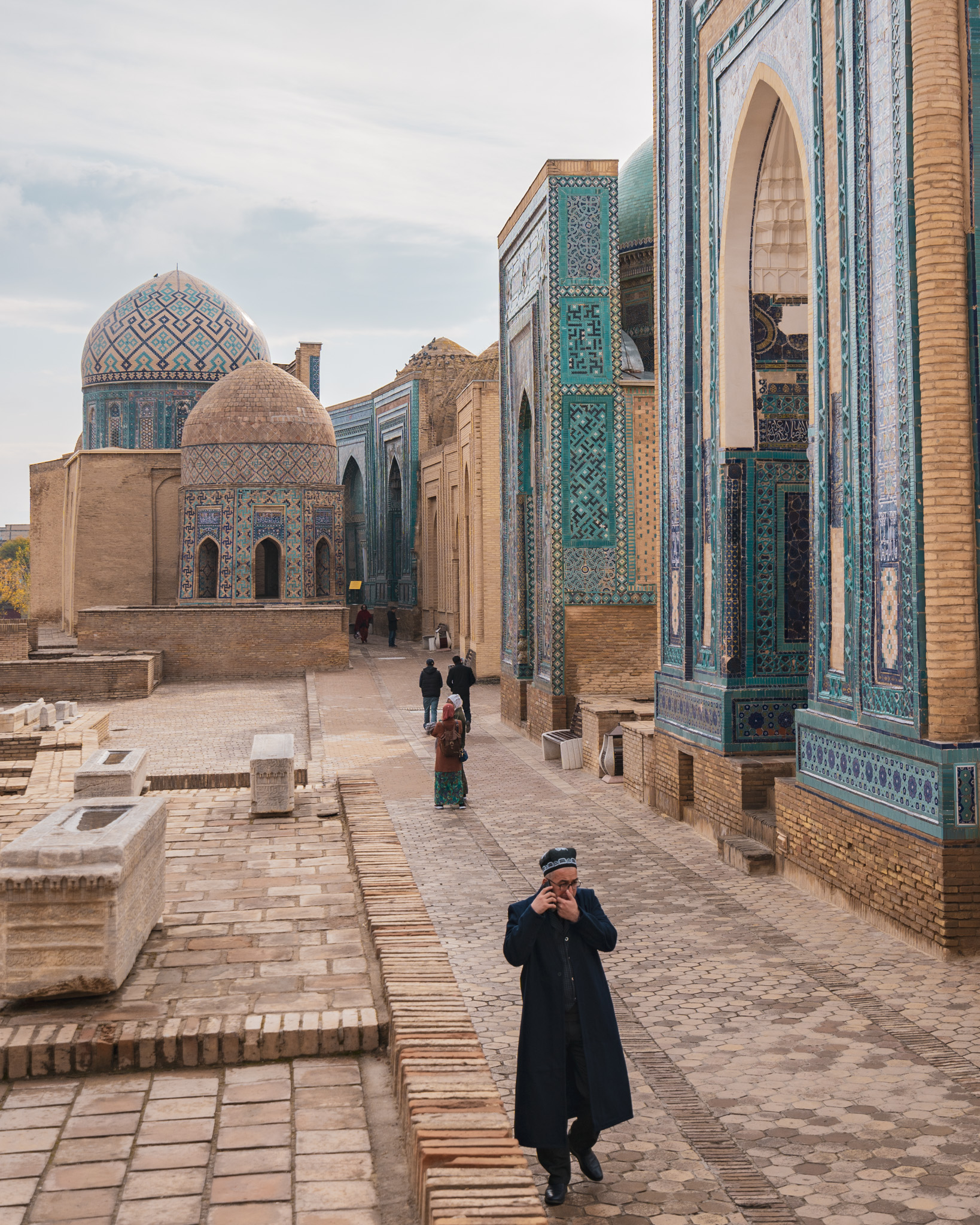
Internet & SIM Cards for the Silk Road
51 – Internet quality varies along the Silk Road: In Kyrgyzstan and Kazakhstan, there is cheap and fast internet almost everywhere. I was able to get 3G signal at Lenin Peak base camp at 3,600 meters in Kyrgyzstan. In Kazakhstan, I paid about $5 for 9GB of data with unlimited social media use (including YouTube and Instagram). In Kyrgyzstan, I paid $4 for 40GB of data.
On the other side of the spectrum are Uzbekistan and Tajikistan. The internet there is somewhat expensive, and coverage is pretty bad outside of the main cities. It’s still worth picking up a local SIM card, but you need to be a bit mindful of your data usage. WiFi is also less common here, although decent hostels will have it.
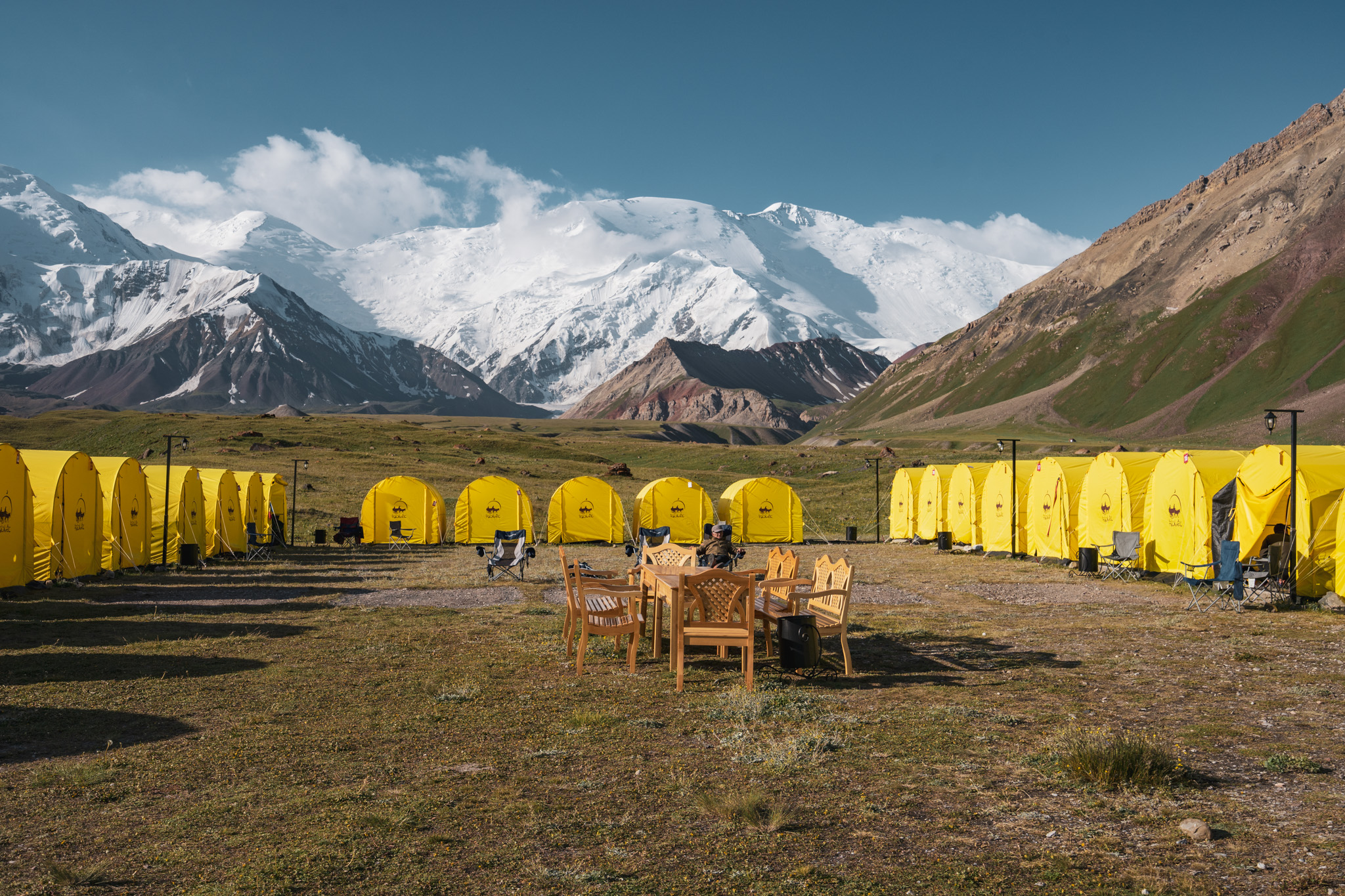
52 – You need to get around China’s Great Firewall: In China, the internet is restricted and most foreign websites are blocked. All Google and Facebook services are inaccessible, as well as sites such as Reddit and Wikipedia.
To access these sites, you need to use a VPN. The best VPN for travelling in China right now is NordVPN .
I’ve used a bunch of different VPNs while travelling and had by far the best experience with NordVPN . They offer a 30-day money-back guarantee, 24/7 customer support, and high-speed servers that are reliable and consistent.

Travelling the Silk Road Wrap-up
I hope this post has helped you learn a bit more about travelling the Silk Road! I love Central Asia so much, and I’m sure you’ll love it too. It’s such an undiscovered and beautiful place to travel around.
If you have any questions, ask in the comments below!
Otherwise, check out some of my other epic guides:
- Guide to travelling in Kyrgyzstan
- Guide to travelling in Mongolia
- Guide to travelling in China
- Guide to travelling in Pakistan
- Guide to travelling in Saudi Arabia
- Guide to Afghanistan’s Wakhan Corridor
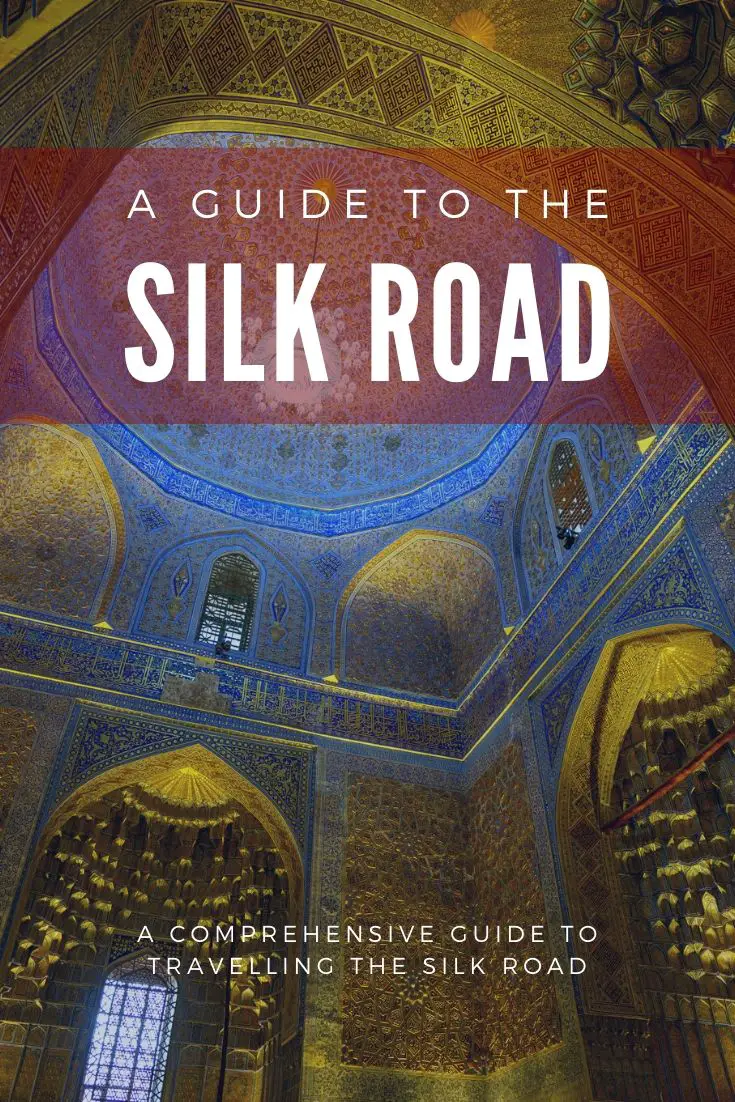
21-year old Canadian dude who loves to visit off-the-beaten-path places, climb tall mountains, and try delicious foods.
Read more about me
Want more like this?
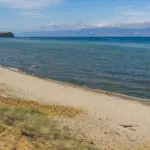
5 thoughts on “ 52 Useful Tips for Travelling the Silk Road (Backpacker’s Guide) ”
Wow looks so beautiful😍, I want to visit Silk road and Pamir Highway. How is temperature in Central Asia (May – Sept). Did you visit with a tour or autostop? I want take a tour because its more cheaper, we’re 4 people. I wanna book tour with Pegas Adventure. Anyone used this tour company?
You’ll love Central Asia 🙂
Temperatures depend on where you are in Central Asia – summertime peaks in July & August, so you should try to be in the mountains during those months where temperatures will be pretty comfortable. In the lowlands of Uzbekistan and Tajikistan, summer temperatures can soar to above 40 degrees.
I don’t know much about tour agencies in Central Asia – If you have four people you could even consider renting a car and driving it on a big loop. Public transport is also very easy to take, but with four people it might end up costing the same just to rent your own car. You can even take it between countries, as long as the rental company allows it.
Let me know if you have any other questions! Hope this helps 🙂
Do you think it would be ok for two women traveling alone, say a mother-duaghter duo?
I’d say so, although some previous travel experience in a less developed country would be good to have.
Locals might be a bit surprised, as this isn’t something they’d typically encounter, although there shouldn’t be any hostility about it.
People in Central Asia are generally friendly and welcoming to foreigners! Feel free to email me if you have more questions.
Thank you for this lovely guide. You’ve done the hard footwork and then share such useful information with us! I hope that you’ll get to travel all the places in the world you desire, and are always at the right place, at the right time. ☀️🌈🌳🌸🌟☃️
Leave a Reply Cancel reply
Your email address will not be published. Required fields are marked *
National Geographic content straight to your inbox—sign up for our popular newsletters here

The big trip: how to plan the ultimate Silk Road adventure through Central Asia
The old trade routes of the silk road give travellers endless options to explore central Asia, from lake-scattered mountain plateaus to ornate mausoleum complexes and lively cities packed with soviet architecture.
The name ‘Silk Road’ evokes images of Marco Polo and endless camel caravans stretching from Beijing to Baghdad and on to the Venetian Lagoon. But the fact is there was no single, definitive trail. Rather, the Silk Road was an umbrella term for a web of trade routes between China and Europe formed over a period of around 1,600 years, from the second century BC to 1450. While these routes wound as far south as India and Southeast Asia, most of their traffic moved overland through the heart of Central Asia, over snowy passes and through scorching deserts. Routes changed over time as new warlords demanded higher taxes from caravans wanting to travel through their territory. Other times, it was because of dangers caused by brutal brigands capturing riches such as silk, tea, ivory and precious metals, and enslaving travellers. Relics of the era can be found across the region today — particularly in the Central Asian segments of the Silk Road.
Few merchants and travellers made the full journey from Europe to China, as most goods and gold changed hands many times at various points along the Silk Road. Similarly, today, travellers tend to approach the region in bite-sized chunks — travelling the full length would take longer even than Marco Polo’s famous 24-year, 13th-century journey.
History buffs and architecture lovers often focus on Uzbekistan, where preserved mosques and madrasas hide behind fortress walls, and Soviet-era architectural oddities can be found. Trekkers and mountaineers turn towards Kyrgyzstan, a country of snowy peaks and a proud nomadic heritage. Kazakhstan blends the two, with a few attractive Silk Road ruins and impressive landscapes that make it an easy choice to add to any itinerary. The legendary, mountain-backed Pamir Highway — one of the world’s most epic road trips and the northern segment of the ancient Silk Road, described by Marco Polo in the 13th century — lies mostly within Tajikistan’s borders, but travellers intent on seeing it will have to contend with access restrictions and safety concerns.
Itinerary 1: S ilk Road Cities
Once major hubs for global trade and centres of cultural exchange, Kazakhstan and Uzbekistan’s cities are now welcoming oases for history lovers, complete with ornate Islamic architecture and crumbling ruins.

Arriving in Almaty, Kazakhstan’s largest city, board a train (13-17h) to Turkistan to explore the Mausoleum of Khoja Ahmed Yasawi. Dating to the late 14th century, it’s believed to be the earliest example of the Timurid architectural style — intricate tilework, multiple minarets and domes — that came to define the Silk Road. Set aside half a day to visit the partially excavated ruins of 10th-century desert fortress Sauran, 25 miles north west of Turkistan.
Cross the border to Uzbek capital Tashkent, a pleasant city of parks and fountains that, with nearly three million inhabitants, is the biggest in Central Asia. The 18th-century Kukeldash Madrasah, built as an Islamic school, is one of the largest in Central Asia. Inside the nearby 16th-century Hazrati Imam complex is the world’s oldest surviving Quran , brought to Taskkent by Turco-Mongol conqueror Timur.From Tashkent, travel to Urgench by plane, bus or train (3h/14h/15h) and continue by shared taxi to Khiva (30min), the best preserved fortress city along the Central Asian Silk Road. The 2,400-year-old Itchan Kala (old town) is packed with ancient architecture; it would be easy to spend two days here, wandering the winding streets and climbing lofty minarets for views of the city.
Days 8-12
Go by train to Bukhara (6h) for three nights, then onward by train to Samarkand (1.5h). Both cities are UNESCO listed; Samarkand is the more famous, but Bukhara is the more appealing as it blends ancient and modern so well. Sixteenth-century trading domes are still in use, standing beside all-but-abandoned synagogues, family homes and bakers’ kiosks. In Samarkand, don’t miss the Gur-e-Amir, a mausoleum complex that contains the tomb of tyrant Timur, whose empire stretched from Aleppo to Delhi, and the imposing Registan — a plaza at the heart of the city that contains three ornately mosaiced madrasas. On the edge of the historic centre, the Shah-i-Zinda mausoleum complex, with its colourful, tiled facades, is also worth a visit.
From Samarkand, add a trip to Shakhrisabz, Timur’s birthplace. Once envisioned as the capital of the Timurid Empire and eventual resting place of the conqueror, plans stalled when Timur unexpectedly died during a military campaign in 1405. Today, it’s a small, traditional town; just past a modern statue of Timur, the restored Chubin Madrasah has been converted into a museum dedicated to the tyrant and his empire.
Itinerary 2: Soviet Legacy
The Soviet Union ruled over much of Central Asia for more than half the 20th century, leaving an enduring physical and ideological legacy that can still be observed in the Silk Road nations of Kazakhstan, Kyrgyzstan and Uzbekistan.

Start in Almaty, exploring the history of Kazakhstan’s Soviet-era capital through the architecture and art of the era. A guided walk with the company Walking Almaty can be one of the best ways to uncover Modernist mosaics and Imperial-era buildings across the historic centre. In the mountains above the city is the modernist Medeu Highland Skating Rink, which opened in 1951. Soviet skaters broke more than 200 world records here before the USSR collapsed. It remains a popular venue, as well as an active competition venue.
Travel west by car to Bishkek, across the border in Kyrgyzstan, where Soviet architecture surrounds a Lenin statue in the city centre. Just over an hour east of the city lies Issyk-Ata Sanatoria — a throwback to the Soviet-era hospital-spa-summer-camps, where tourists can stay overnight in dilapidated, pastel-blue dormitories. Guests can hike up the valley to a small waterfall (a three-mile round trip), returning for a dip in the sanatoria’s hot springs. Before returning to Bishkek, detour to Ata Beyit Memorial Complex, an hour west of Issyk-Ata. A secret mass grave of Soviet Kyrgyzstan’s intelligentsia was revealed here by a deathbed confession from one of the guards on duty the night of the massacre.
It’s a nine-hour overland journey by bus or shared taxi via Kazakhstan — or a one-hour, 20-minute flight — from Bishkek to Tashkent in Uzbekistan. Rebuilt after a devastating 1966 earthquake, Tashkent today is still a showcase of Soviet modernism. Wander from the stone Monument to Courage Earthquake Memorial to the Islamic Modernist dome of Chorsu Bazaar and the brutalist facade of Hotel Uzbekistan. Then descend beneath the streets to ride the Soviet-era train carriages of the Tashkent Metro, where each of the 43 stations has its own distinct architectural style and artistic elements. Don’t miss a trip to see Physics of the Sun, a giant industrial solar furnace complex built by the Soviets in 1981 on a hilltop outside Parkent, 31 miles east of Tashkent. Brutalist in design and still operational today, it uses thousands of mirrored panels to channel heat from the sun.
Finish your trip in the far west of Uzbekistan, with a long journey from Tashkent to the town of Nukus on the former shores of the Aral Sea — around 15 hours by car. This remote location is home to the Nukus Museum of Art, which displays collector Igor Savitsky’s world-class Soviet avant-garde art haul. Poor water management by the Soviets turned the Aral Sea (once the world’s fourth-largest lake) into a dust bowl, which can now be toured in a 4WD vehicle to see the carcasses of marooned ships. The barren scrublands are a devastating ecological warning as well as starkly beautiful. Independent visitors can arrange a bed for the night at Mayak Yurt Camp, which can also provide a driver for an unforgettable trip into the desert on the edge of the town of Moynaq, near the former shore.
Itinerary 3: Mountains & outdoor adventure
Lace up your hiking boots and head into the Tien Shan. The ‘heavenly mountains’ — a range that defines the border between Kazakhstan and Kyrgyzstan — live up to their name, offering divine views of snow-capped peaks. There’s adventure here for every level of ability.

From mountain-flanked Almaty in Kazakhstan, it’s a three-hour drive to 93-mile-long Charyn Canyon for hikes among red-rock towers and through labyrinthine gorges. The alpine village of Sati makes an ideal base for visiting the Kolsai Lakes. From the nearest lake, it’s an easy five-mile hike to the next, then a challenging two-and-a-half miles to the final one. Two valleys east, you’ll find Lake Kaindy; created by an earthquake in 1911, it contains a partially submerged forest of spruce trees, whose exposed tips make for a surreal sight.
Cross the border into Kyrgyzstan and make for Karakol, founded in 1869 as a military outpost. Its wooden cottages are now interspersed with hostels catering to armies of hikers. The three-day trek to Ala-Kul lake is Kyrgyzstan’s most popular, climbing to an altitude of 3,900 metres for epic views over the lake from the Ala-Kul Pass. At the end of the trek, visitors can hire a Soviet-era military truck for a day trip to the Altyn-Arashan springs to sooth sore muscles.
Days 9-11
Hike around Issyk Kol lake, staying at lakeside yurt camps such as Feel Nomad or Bel-Tam . Support conservation initiatives on a guided hike of Baiboosun Nature Reserve or make the easy, one-mile hike to the Shatyly Panorama for views over Issyk Kol and the snowy Tien Shan peaks.
Continue to Song-Kol lake at a breathtaking 3,015 metres. Drive up in around four hours from Kochkor on Issyk Kol’s western side, or take one to two days hiking and horse-trekking there from Kyzart, 45 miles west of Kochkor. Spend a full day at the lake, horse-riding through the grasslands in solitude. Afterwards, drive to Bishkek for day hikes up the forested slopes of nearby Ala Archa National Park or to explore the Soviet architecture of the capital.
How to travel: a practical guide
What visas will I need for Central Asia?
Visa policies have loosened considerably over the last decade, with travellers on UK passports currently allowed visa-free entry to Kazakhstan (30-day stay), Uzbekistan (30 days) and Kyrgyzstan (60 days). Longer stays will still require a visa, which must be issued at an embassy or through each country’s e-visa platform . You still need a visa to enter Tajikistan, which can be applied for online before arrival (avoid the on-arrival service, which is a frustrating, time-consuming process).
Am I likely to need any travel permits?
Trips to some remote border regions of Kazakhstan, Kyrgyzstan and Tajikistan do require special permits. If your itinerary includes the Pamir Highway in Tajikistan, for example, you’ll need a permit from the Gorno-Badakhshan Autonomous Region, and it’s best to apply for it with your initial country visa application to save time. Applying for permits can involve Soviet-style bureaucracy; if travelling independently, it’s worth paying a local tour company to do it on your behalf. Fees are usually £25 to £40 per permit.
How should I manage money while travelling?
Credit cards are widely accepted in Central Asia’s cities but rarely outside of them, and even in cities you’ll still need cash for small purchases. ATMs are widespread in the big cities, but they can unexpectedly run out of cash — particularly on weekends — so it’s worth also carrying some foreign currency. British pounds and Euros can reliably be changed in cities, but in towns and rural areas US dollars are the easiest to exchange.
What languages are spoken across the Central Asian Silk Road?
Russia is the common language in this region. Tourism businesses in popular destinations will usually have English-speaking staff; it’s harder to find English speakers in rural areas.
How should I dress while travelling here?
Locals across the region typically dress more conservatively than in the West. While visitors aren’t usually expected to adhere to local norms, you may be the target of unwanted attention if you don’t cover your shoulders and knees, especially in rural areas; the capital cities across Central Asia tend to be more liberal.
Related Topics
- CITY GUIDES
- CULTURAL TOURISM
- RELIGIOUS TRAVEL
You May Also Like

10 whimsical ways to experience Scotland

Visiting North Carolina: Here’s what the locals love
Free bonus issue.

A guide to Jaipur's craft scene, from Rajasthani block printing to marble carving

How to plan a weekend in South Moravia, Czech wine country

The essential guide to visiting Alaska

The essential guide to visiting Scotland

6 experiences you shouldn't miss in Connemara
- Environment
- Perpetual Planet
- History & Culture
History & Culture
- History Magazine
- Mind, Body, Wonder
- Paid Content
- Terms of Use
- Privacy Policy
- Your US State Privacy Rights
- Children's Online Privacy Policy
- Interest-Based Ads
- About Nielsen Measurement
- Do Not Sell or Share My Personal Information
- Nat Geo Home
- Attend a Live Event
- Book a Trip
- Inspire Your Kids
- Shop Nat Geo
- Visit the D.C. Museum
- Learn About Our Impact
- Support Our Mission
- Advertise With Us
- Customer Service
- Renew Subscription
- Manage Your Subscription
- Work at Nat Geo
- Sign Up for Our Newsletters
- Contribute to Protect the Planet
Copyright © 1996-2015 National Geographic Society Copyright © 2015-2024 National Geographic Partners, LLC. All rights reserved
- Sightseeing
- China National Silk Museum
- China Silk Photos
Basic Facts
Other routes, scenery along the road, silk road adventure, you may like.
- Skip to primary navigation
- Skip to main content
- Skip to footer

Caravanistan
The Silk Road Travel Guide
Caravanistan helps you get the most out of your Silk Road trip
Both for independent travelers and guided trips
Hi there! We’re Caravanistan and we help you make the most of your Silk Road trip in 4 ways:

Leading travel guide for Central Asia

Silk Road Visa shop
Custom tours for unique adventures

Car and motorbike rental
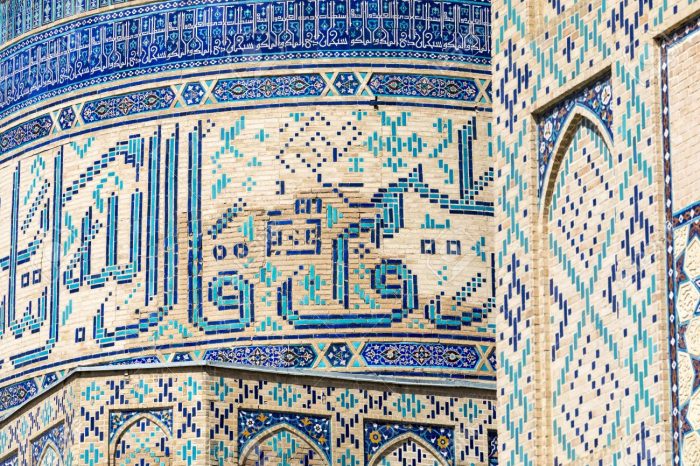
A hand-crafted travel guide for Central Asia and beyond
At Caravanistan, we spend our waking hours to guide everyone to a more meaningful travel experience on the Silk Road.
We believe in going slow. A change of pace is often more important than a change of place. See less, and experience more.
Go beyond the guidebooks and the must-sees. We aim to guide you there.
Tailormade trips, at group tour prices
Use our expertise to design your unique adventure, whether it’s a 5-star trip along Uzbekistan’s culture cities, or a demanding hike in the Tien Shan mountains.
We evaluate your request and match you with the tour operators that suit your travel ideas best.

Why choose Caravanistan ?

No booking fee
You deal directly with local tour operators. We don’t put anything on top.
Competing offers
Pick the one you like best.
Cherry-picked tour operators
We only work with a few tour operators that we know well, who understand how you like to travel.
We know Central Asia
Not only have we been everywhere, we also know how things work around here.
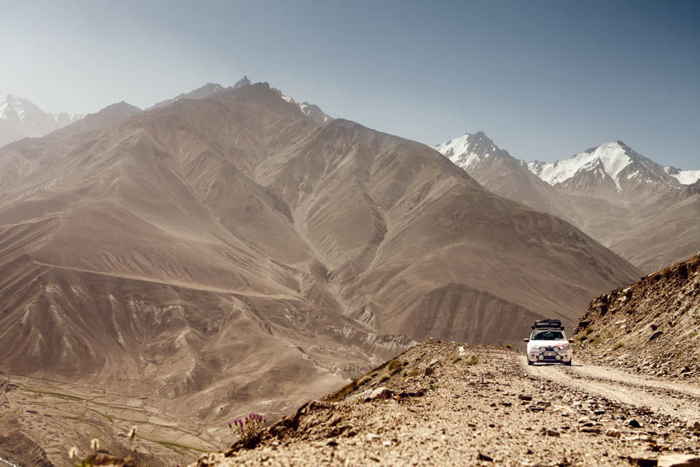
Need a ride ?
Reliable wheels for your self-driving adventure, for rent across Central Asia
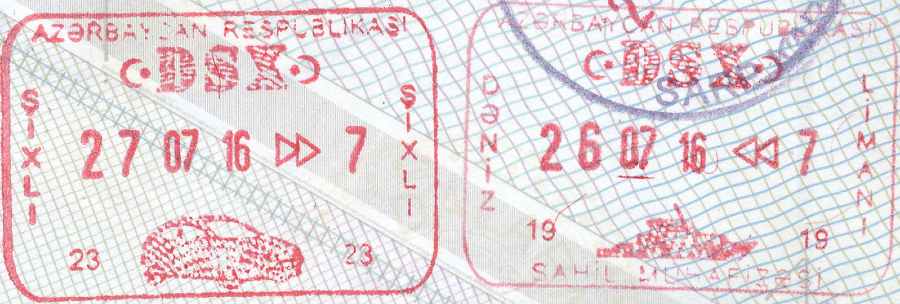
Invitation letters
We have got a decade of experience in getting visas for travelers of all passports.
Highly reliable, immensely helpful, and always inspiring. Kevin Kelly, founder Wired Magazine
Go further, go slower. Experience more.
Caravanistan is kept in the air since 2011 by Saule from Kazakhstan and Steven from Belgium. For travelers, by travelers.

Travel Guide
- Turkmenistan
Tours & Rental
- Custom tours
- Search all tours
- Pamir Highway tours
- Uzbekistan tours
- Kyrgyzstan tours
- Car & motorbike rental
Visa invitations
- Russia (tourist)
- Russia (business)
Get to know us
- What people say
- Letter from the Silk Road
- Terms & Conditions
- Follow us on Instagram
Do you have a request for this tour operator? Send a message
Not exactly what you were looking for? Check out our custom tour offer: competitive prices, tailored to your needs and wants. Customize your tour

Travelling Without a Passport

Travelling The Silk Road by Overland: Exploring a History the Length of the World
Exploring a history that spans the length of the world is no mean feat, our Silk Road travel guide will take you on a journey like no other!

The Silk Road is woven into the very fabric of our world. It needs no introduction, but then, it does, if only to let our imaginations run wild with the thought of travelling or driving the Silk Road. From its geographical configuration (at least 4,000 miles, in more than 40 countries) to its role in history, not many routes can claim the glory that belongs to the Silk Road. While its moniker came courtesy of Chinese silk, other goods such as spices and jade were also carried from east to west upon it.

The Silk Road has also had a social and cultural impact on the world. In its heyday, the route formed bonds and links between different ethnicities across its sprawling and complex network. In total there are more than twenty ethnic groups along the Silk Road; many with their own languages, customs, and traditions. Life around the Silk Road remains mostly unknown to us, but the legends, myths, and rituals warrant a closer look.
For explorers and travellers, this route is the embodiment of wanderlust; its very name suggests a voyage like no other, it is a trip through time. Buddhist art, Islamic architecture, lost dynasties, ruins, ancient cities, and dramatic scenery are only the beginning of what there is to discover. How do you explore something that spans most of the world? The answer: overlanding. When you overland, the purpose of your trip is not the destination but the journey, and there is no adventure more suited to this style of travel than that of the Silk Road.
See Also: The Fastest-Growing Destinations for 2019
Silk Road travel guide
The Silk Road is best described as a collection of intricate paths that form a network (so intricate that a travel guide is definitely required reading). Beginning in the former capital of China, Xī’ān, the route crosses mountain-tops and desert plains into Central Asia. The Silk Road played a considerable role in the development of China, Korea, Japan, India, Iran, Afghanistan, Europe, Africa, and Arabia.
The main artery of this track follows the Great Wall, over the Pamir Mountains into Afghanistan, and from there it leads to the Levant. Roads branched off this central route towards towns and cities, river ports, markets, and pilgrimage sites. Many cities located on the system flourished and became wealthy hubs during its trading days. As well as silk, other popular items traded along the route were salt, sugar, porcelain, and spices.

Along with metropolises rich in heritage and culture, the Silk Road is a haven for scenery, given that the route passes through so much wilderness and some of the highest places on earth. Visitors can discover cosmopolitan cities steeped in the past, semi-nomadic farming lifestyles, and explore hidden gems in a diversity of landscapes.
Best time to visit the Silk Road
March, April, and May are the perfect time to visit countries along the Silk Route. The weather will be around 15-20 degrees Celsius, and spring will be blooming. September and October are also another great time to visit; you can feast on juicy grapes and ripe dates. The winter is often too cold, and the summers are busy and hot.
Where to stay
The accommodation options along the Silk Road vary as much as the route itself. From luxurious hotels in urban habitats and guesthouses in towns, to local homestays in rural villages and cozy yurts under the stars, where you stay is really up to you. Not all the destinations will have as many options, particularly if you venture to remote locations that can be found on the route. Travellers who want to take away the hassle of figuring out where to stay should ideally pick a tour that will handle this element for them.
You will need visas for many countries along the Silk Road. This may seem a little daunting at first, but with a bit of research and the right planning, it can be a relatively easy process. Make sure you are up to date on any travel requirements for the countries you are visiting and apply for visas well in advance. Passport holders can also obtain a visa on arrival in certain countries, and tour companies often help with letters required to support your visa application.
What to pack
You can pack for the Silk Road as you would for most trips. A combination of shorts and t-shirts for the warm days, and extra layers for the cooler evenings. It may also make sense to pack a light waterproof jacket, and comfortable walking shoes are a must. It’s also helpful to carry a backpack with essential travel items like a hat, a pair of sunglasses, lip balm, sunblock, snacks, refillable water bottle, and camera.
Being respectful while travelling the Silk Road
When meeting locals along the Silk Road it’s important to be aware of their culture, customs, and traditions. Doing a little research where possible will go a long way, and following in your host or tour guide’s example is the best practice. Likewise, when visiting temples and religious sites, it’s important to remember that these are sacred spaces and places of worship for the locals. Be respectful of dress requirements and visiting restrictions.
Medicines on the Silk Road
Depending on where you go on the Silk Road, you may need certain medications, though it’s best to acquire this information from a doctor or travel clinic. It’s also well worth packing some treatments for colds, upset stomachs, nausea, and fever. It also doesn’t hurt to travel with some bug spray and antiseptic creams, or a mini first aid kit. Also, do not carry any medicine that contains tramadol, codeine, temazepam, morphine, or opiates, as they are illegal in most of Central Asia.
See Also: Are You a Respectful Traveller?
Driving the Silk Road
From the silk traders that led to the naming of the road to the legendary rulers who used it satisfy their own ambitions, the cities along this ancient route have drawn visitors from far and wide. While it’s possible to travel the Silk Road by train (the most popular form of transport), understandably many visitors want to experience it more viscerally on a road trip.
If driving the Silk Road appeals to you, keep in mind that even today, the journey will require a substantial amount of travel days and preparation for you to get the most of out your trip. If you want to discover the route by road, we recommend doing it via overland vehicle. This removes the limitations of public transport, without sacrificing the chance to explore the Silk Road along old tracks that were used by historical figures like Marco Polo and Genghis Khan.
The Silk Road crosses some of the most exciting terrains on the planet; it won’t come as a surprise that it is here that overlanding was born. These days, visitors rarely get the chance to travel the entire route, but Dragoman has plenty of itineraries ranging from nine to 127 days that will let you experience the region thoroughly and authentically.
Silk Road travel itinerary
To follow in the footsteps of the remarkable explorers and traders who crisscrossed the world on this epic route, you’ll need an overland tour that travels through cities and destinations where the legacy of the Silk Road lives on. From bargaining in the market lanes of Tabriz and meandering the backstreets of Bukhara, to falling asleep alongside shepherds in the Pamir Mountains and exploring ancient towns, travelling the Silk Road can bring many dreams to life.

Overlanding is a unique and unrestricted way to visit the Silk Route. Imagine getting off the tarmac and taking the road less travelled? Staying with local families or heading off to remote villages and enriching your life with unchartered experiences? Overlanding captures the true spirit of the Silk Road, allowing travellers to form meaningful connections with the places they visit. Dragoman has been operating overlanding tours since the 1980s, so take advantage of their in-depth knowledge by opting for a carefully curated Silk Road travel itinerary.
- Turkey, Iran and the Silk Route : From the whirling dervish to Persian culture, this route will take you to some of the most beautiful cities. Shiraz, Tehran, and Istanbul may be cosmopolitan, but they sired some of the world’s oldest poets and artists. This route is teeming with breathtaking architecture, sacred sites, desert plains, art, and literature.
- Kyrgyzstan and the Chinese Silk Route: Even today, for travellers, Kyrgyzstan’s pastures and mountaintops are a gateway to Central Asia. For merchants on the Silk Road, this country also played a pivotal role. This is probably why a number of Silk Road sites can be found in the region. This route will also take you to Xī’ān, the starting point of the Silk Road, and another gateway to Kashgar (the epicentre for regional trade in China) and beyond. In Xī’ān, you can take a guided tour of the world-famous Terracotta Warriors, and explore the Great Mosque and Shaanxi Museum.
- Central Silk Route: This route will take you through Khiva, Bukhara, and Samarkand, important trading posts on the Silk Road. Among the minarets, golden domes, and tiled mosaics of these cities, you’ll discover the history and culture left behind in Uzbekistan by traders and merchants that tread upon these roads all those centuries ago.
- Western Silk Route: Start in Istanbul, a city where the spirit of the Silk Road manifests as east and west come together, and end your trip in the opulent marble palaces of Ashgabat in Turkmenistan. You’ll have the opportunity to sail over the Caspian Sea, explore the Black Sea mountain monastery at Sumela, and walk through the ancient valley of Ihlara. The valley was a haven for Byzantine monks who chiselled churches into its cliffs.
- Silk Route and Mountains of Central Asia: On this route, you can follow the famous Pamir Highway over the Kyzyl Art Pass, the frontier between Tajikistan and Kyrgyzstan and one of the highest and most remote border crossings in the world. You’ll trek through the Fann Mountains, a stunning range of jagged peaks 30km east of Penjikent, camp beside Iskanderkul Lake, a glacial waterbody found in Tajikistan’s mountainous region and see the silk-weavers of Fergana Valley. Visitors will also see some cultural hubs that are filled with memories from the golden days of trade, including Samarkand in Uzbekistan, a city potently reminiscent of the Silk Road. The walled old town and grand architecture will quickly work its magic on you.
This story was created in partnership with: Dragoman

Based in Toronto, Sahar is a full-time content editor for Days to Come and part-time travel junkie.
Related Articles
- Food & Drink
Your Guide to Amsterdam’s Secret Bars and Speakeasies
One of the most popular cities in Europe, Amsterdam has no...
- North America
Your Guide to Easter Around the World
Easter is a time to celebrate new beginnings. The symbols and...
- Central America
The Best Spring Break Destinations
As long as academics have been a part of our lives,...

Walking South America: The Best Hiking Trails
Get unlimited access to the world's best travel stories. subscribe now., privacy overview.
The essential guide to backpacking China's Silk Road

Apr 18, 2017 • 6 min read
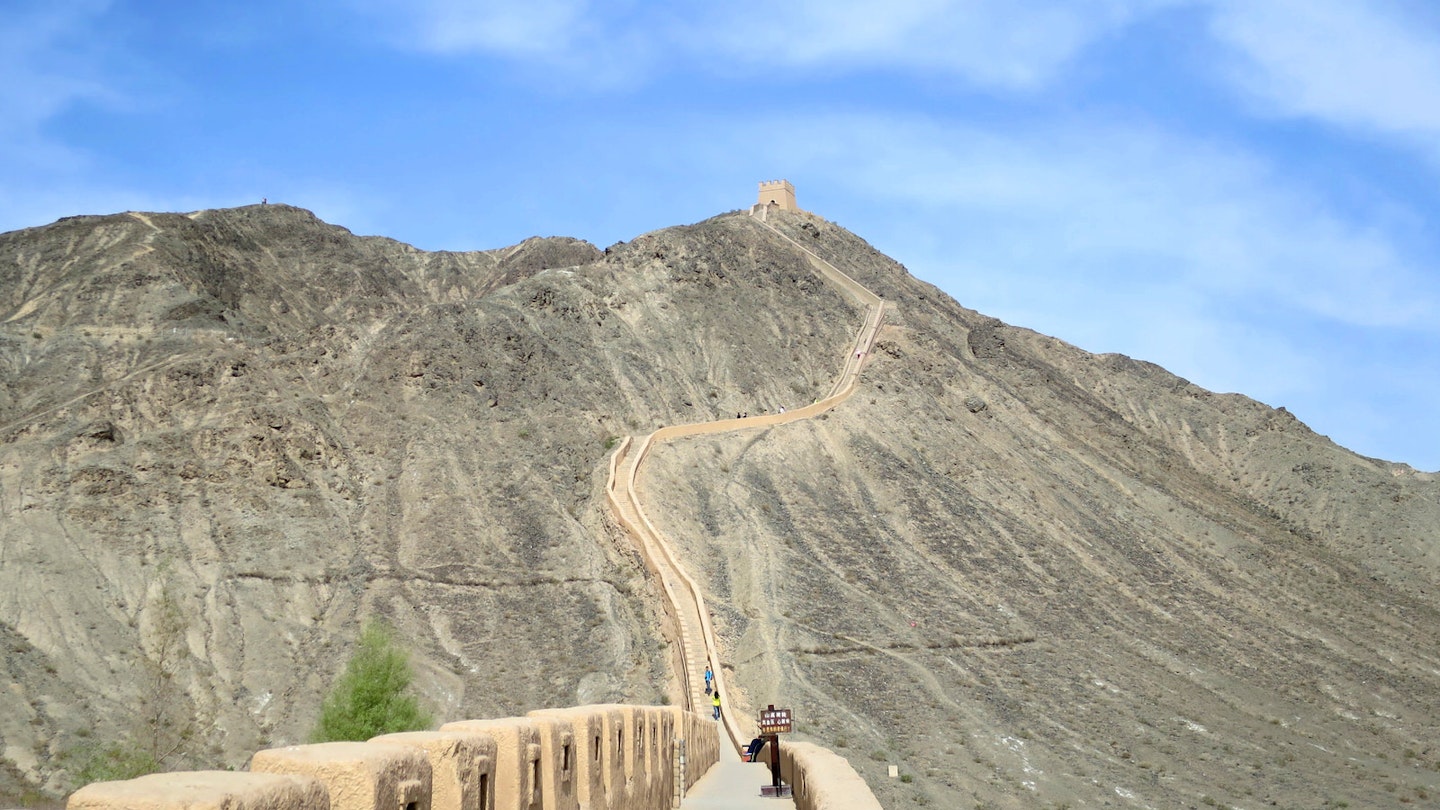
Climbing the Overhanging Great Wall at Jiayuguan © Megan Eaves / Lonely Planet
The section of the ancient Silk Road that runs through China is an epic journey through desert dunes to the end of the Great Wall, a length of pink mud that ends abruptly in the magnificent beige towers of the Jiayuguan Fort.
This is not a voyage that many travellers experience; it's often and understandably overlooked in favour of more accessible and famous destinations in China.

But for adventurous travellers looking for something truly different, backpacking the Chinese Silk Road reaps glorious rewards: sand-sledding down a magical unmoving sand dune, a camel ride around an oasis, a trek up the end of the Great Wall and sipping wine under grape trellises are just a few of the possibilities. So don a sand-proof rucksack and check out our guide to backpacking the Silk Road through China.
Historically, the Silk Road was not one but many routes that connected east and south Asia to Mediterranean Europe, so named because the largest commodity traded down the route was sought-after Chinese silk. The route traditionally started in Xi’an (then known as Chang’an), China and continued northwest through modern-day Gansu and Xinjiang provinces before reaching Central Asia.
Several historical splits in the road mean that you have options when deciding your route. By far, the most traversed portion of the route is from Xi’an to Lanzhou and Jiayuguan in Gansu. From here, you can choose to head northwest to Urumqi in Xinjiang, where fascinating Uigher culture, China’s wine country, and the soaring peaks of the Tian Shan mountains await. Alternately, the southern route heads through the fiery desert of Gansu, with its huge dunes and ancient Buddhist caves, ending in the distinctly Central Asian city of Kashgar , renowned for its bustling Sunday livestock market. Adventurous travellers and those with extra time could potentially explore both routes by heading southward from Jiayuguan to Dunhuang in Gansu, then upwards to Urumqi and finally south again to end in Kashgar.

Don’t-miss sights
Zhangye Danxia National Geopark . This incredible desert landscape is striking for its orange, red and yellow hues of layered clay and sandstone, forming bizarre rainbow mountains. While you're in Zhangye, also be sure to see the Giant Buddha Temple , which contains one of the largest wooden reclining Buddha statues in China.
Jiayuguan Fort . The ancient Great Wall ends in this towering mud fortress, which rises out of the desert like a mirage. Just a few kilometres northwest of Jiayuguan town, the fort boasts a few touristy activities like archery and camel rides, but the real reason to come is for the sweeping views from its ramparts.
Overhanging Great Wall . Named because it looks like a dragon hanging over a cliffside, this portion of the Great Wall is one of the most visually stunning: a mud maze that zigzags its way up a stark desert mountain. The wall is open for climbing and views from the top are incredible.
Singing Sands Dune . To call this a single dune would be an understatement. On the outskirts of Dunhuang , Singing Sands Dune is the first in a series of thousands of dunes that make up the Taklamakan Desert. This particular dune, though, is legendary for having never covered the oasis below, despite thousands of years of sand erosion. Adventurous types can climb the dune for great vistas of yet more dunes – and then sand-sled back to the bottom.
Mogao Grottoes . Just outside of Dunhuang, this series of caves contains an incredible wealth of Buddhist art and murals.
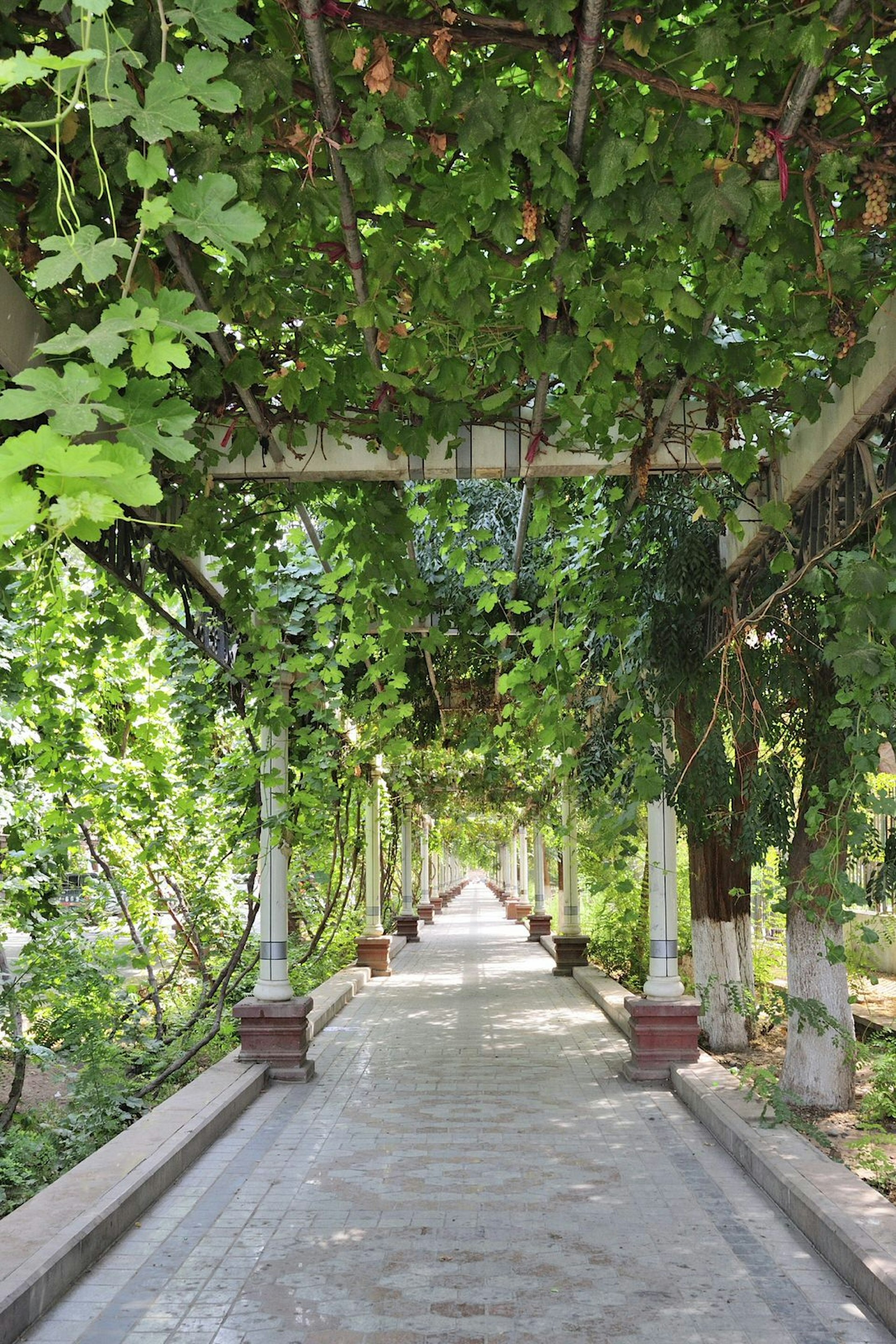
Turpan Grape Valley . China may not be known for its quality winemaking just yet, but Turpan – an oasis town – is home to one of the oldest and most prolific wine-making regions in the country. No matter the quality of the wine (some is actually quite quaffable), sipping a fresh glass of white under grape trellises as a brook babbles nearby is great way to beat the desert heat.
Jiaohe Ruins . This 2300-year-old archaeological site contains the ruins of an ancient capital that was destroyed by Mongol invaders around the 13th century. What remains today is an elaborate network of structures in various states of decay, connected by a maze of streets.
Tian Chi Lake . This mountain lake, whose name means ‘heavenly’, sits in the cradle of the Tian Shan mountains underneath the looming 5445m gaze of Bogda Peak. A popular destination with domestic tourists, the lake's serenity is sadly hampered by honking boat horns and tramping visitors, but if you can find a spot of solitude, the vistas are incredible. It’s also possible to camp or stay in a yurt with a local Kazakh family – highly recommended for delivering a slice of the water and surrounding forest to yourself.
Kashgar's Grand Sunday Bazaar . One of the largest and liveliest markets in all of Asia, Kashgar’s bazaar is open every day but is especially bustling on Sundays, when the livestock market adds cattle, horses, sheep and goats to the mix.
Getting around
China’s northwest is historically one of its least connected regions. The Jiayu pass, where the impressive Jiayuguan Fort was built in the 1370s, marks the end of the Great Wall and the border of the ancient Chinese empire.
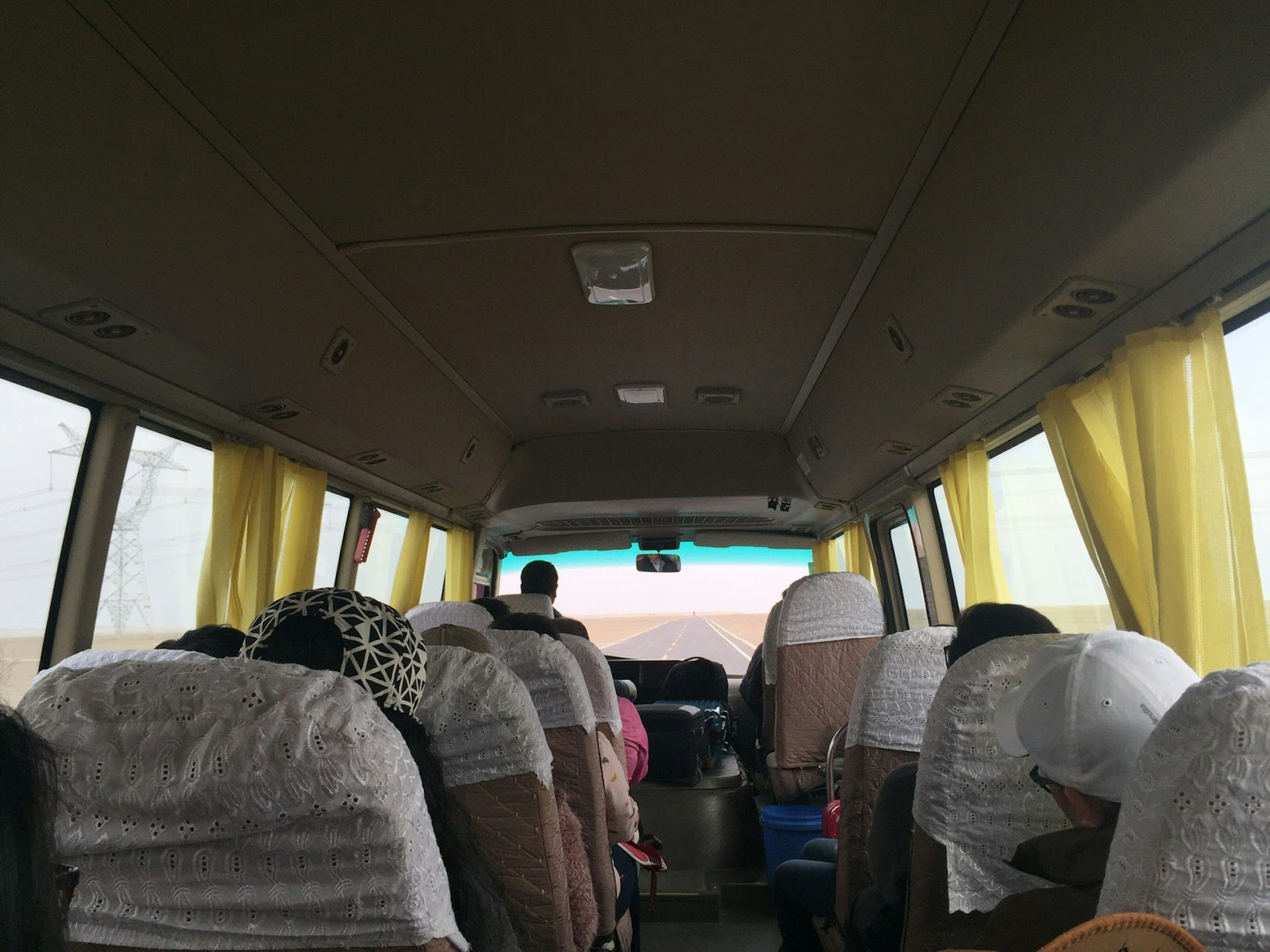
The region spreads over 2400km, most of which is separated by vast tracts of desert. Though you can still get on a long, bumpy bus ride if you want to, the region is now connected by high-speed rail, making getting around a breeze. Regular flights also connect most of the main airports in the region: Xi’an, Lanzhou, Jiayuguan, Urumqi and Kashgar all have commercial airports, and tickets are often discounted.
Part of the allure of this trip is the vast journey overland, which hearkens to a day when explorers, traders and Buddhists rode and walked for weeks across the harsh desert. Doing at least part of your journey by rail is a good way to experience these landscapes up close. The entire journey could be done in 10 days by rail if pressed, but two to three weeks allow for explorations further afield and several days in each stopover to see the sights properly. Flying from Xi’an to Lanzhou and beginning your rail journey there would shorten the journey for those in a hurry.
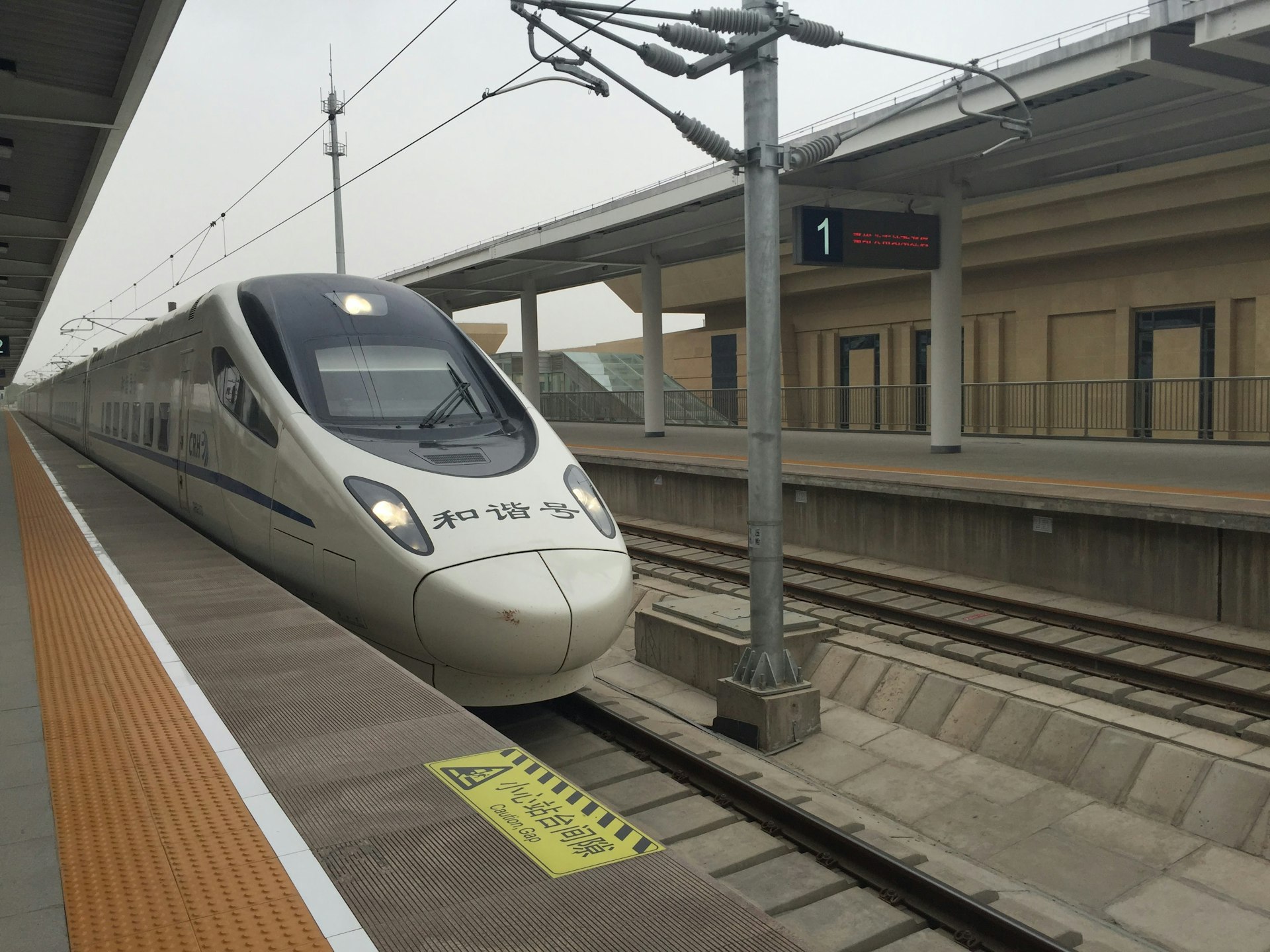
An ideal Silk Road trip would include overnight or several-day stops in Lanzhou, Zhangye, Jiayuguan, Dunhuang, Turpan, Urumqi (or Tian Chi Lake) and Kashgar.
Tips and recommendations
Most of this route follows extreme desert, so pack for dry heat. Carry plenty of sunscreen and breathable clothing that covers the skin. A bandana or lightweight scarf can be useful for shade and breathing in dusty conditions.
If taking an overnight train trip, equip yourself with food and plenty of sealed, bottled water before you embark. Hot meals are offered on trains, but tend to be very basic Chinese staples like rice, vegetables and stir-fried meats. Instant noodles, fruit, nuts and seeds are ubiquitous, easy to carry and keep well. Trains also usually sell beer and wine, but at high mark-up, so be sure to pack your own, as having a ganbei (bottoms up) is a great way to meet locals and make friends while travelling.
Officially, the entirety of China is in one time zone, China Standard Time, but the northwest, particularly Xinjiang province, often operates on its own locally created time zones. When purchasing train and bus tickets, double-check the departure time.
In general, Mandarin is spoken throughout the region, including by taxi drivers and hotel staff and at large stores and restaurants. However, in some more remote areas and at smaller cafes, you may find older people only speak local dialects of Chinese or Uigher.
This article was originally published in August 2013 and updated in April 2017.
Explore related stories
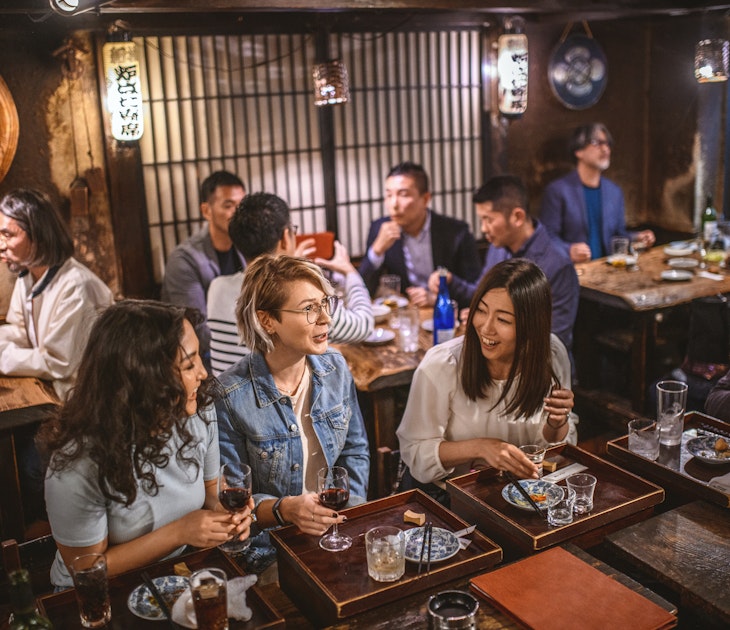
Apr 2, 2024 • 10 min read
Japan’s best cuisine and culinary experiences, from haute cuisine to street food plus sake and tea ceremonies.
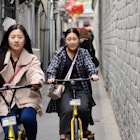
Feb 23, 2024 • 6 min read
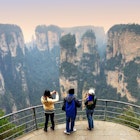
Feb 21, 2024 • 5 min read

Jan 2, 2024 • 11 min read

Dec 26, 2023 • 5 min read

Nov 7, 2023 • 5 min read
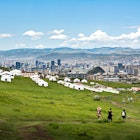
Aug 25, 2023 • 7 min read
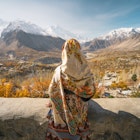
Aug 11, 2023 • 8 min read

Aug 8, 2023 • 10 min read

Jul 3, 2023 • 8 min read
- Destinations
Wild Junket

Silk Road Travel Guide
Last Updated on September 20, 2022
Here’s a comprehensive, detailed Silk Road Travel Guide I wrote, based on my overland journey through Central Asia.
The Silk Road is the greatest travel route of all time, spanning 8,000km across continents, weaving through deserts, mountains and grasslands and bringing traders from East to West and vice versa. The original overland odyssey has long lured travelers, from the likes of the world’s first professional traveler, Marco Polo, to modern-day Silk Road author, Colin Thubron. For centuries, caravans of over 1,000 camels trekked through Central Asia trading everything from gold to gunpowder.
But these days, traveling the Silk Road can seem daunting even for the most hardened traveler. It often involves crossing vast distances and challenging terrain like deserts, mountain passes and seas. As if the distance is not intimidating enough, almost all the countries in Central Asia require visas to enter, so crossing this many borders means you’ll be facing a mountain of red tape.
Planning is indeed key, especially so if you intend to travel for a few months across several borders. Based on what I learned on my Silk Road journey, I’ve compiled some tips and info below that will hopefully help you plan an amazing trip.

Table of Contents
Highlights of the Silk Road
How to go: independently or with a tour operator, is it safe to travel the silk road, visas: central asia’s red tape, when to travel the silk road, accommodation: camping, guest houses or hotels, cost of travel on the silk road, some extra tips:.
You’ll be surprised to know that the Silk Road isn’t even one distinct highway, but rather a network of tributaries. Granted, trails that weave through vast deserts are now replaced by tarred highways and paved roads, and caravans are substituted by massive cargo trucks.
The old world romance may be gone today, but in an era where untouched frontiers are rare, traveling the Silk Road still gives you the opportunity to take a peek into a relatively unknown region. It’s this history behind the Silk Road that makes overland travel in Central Asia a truly epic journey.
The route traditionally started in China’s Xi’an (then known as Chang’an) and continued northwest through the Xinjiang province, and eventually into Pakistan, Kyrgyzstan, Uzbekistan, Iran and Syria. Some tributaries extended as far as India and Rome. Other Silk Road stops – Iraq and Afghanistan – are sadly off-limits for now. There are numerous options to traverse the Silk Road that vary in length and stops. I chose to travel from Kyrgyzstan to Turkey , taking two months to explore six countries.

Using the word “epic” to describe this journey is clearly an understatement, as the Silk Road passes through so many magnificent sights across very distinctive cultures. It’s hard to pick the best, but here are some of my personal favorite parts of the journey:
- Celebrating Kyrgyzstan’s Independence Day in Bishkek with horse races and carnivals.
- Witnessing the impressive burning Darvaza gas craters in the middle of the Karakom Desert.
- Being overwhelmed by the complete bizarreness of the sterile and empty city, Ashgabat in Turkmenistan .
- Marveling at the turquoise tiled domes and ancient medressas (Islamic schools) of Bukhara, Samarkand and Khiva in Uzbekistan. The trio offered some of the most impressive architecture I’ve seen in my travels. The ones that stood out were Shah-i-Zinda avenue of mausoleum in Samarkand and Konya Ark in Khiva.
- Stumbling upon a Sunday animal market in Taraz, Kazakhstan, where hundreds of cattle and sheeps were on sale. What an experience!
- Meeting friendly locals everywhere in Iran and getting invited to our guide’s home for a lovely dinner with his family in Tehran.
- Ending my journey in Istanbul Turkey , one of the most fascinating cities in the world!

To traverse this challenging route, I chose to travel on an overland expedition with Oasis Overland , a UK tour operator specializing in overland travel. I opted to travel with an overland tour operator, because it was easier logistically in terms of border crossings and getting around each country.
As for options in Central Asia, there aren’t many companies that organize overland expeditions. Adventure tour operators that do this route include Oasis Overland , Dragoman and Odyssey Overland . I went with Oasis Overland because of recommendations from friends and also because it offered the longest trips at the most affordable prices. They seemed to be the most experienced in the overland travel business and the most reputed one as well.
Oasis Overland does several routes in Central Asia, ranging from the shortest – Ashgabat to Bishkek Silk Road Highlights trip (20 days) to the longest London to Beijing Trans-Asia route (17 weeks). I went on the Bishkek to Istanbul trip which took 78 days (although I joined part of the trip and it took 63 days).

Take note that some countries on the Silk Road only allow travelers on guided tours to enter. Turkmenistan is one example. We had a Turkmen guide join us on our overland trip during our time in the country. In Iran, only certain nationalities (namely British, American and Canadians) need to join guided tours. Don’t let this deter you from going though — if you dislike joining tour groups, opt for an individual tour and do your research to find the best guide in town. Turkmenistan and Iran were my favorite countries on this trip.
As for independent travelers, we met many people along the way who were either backpacking and staying in hostels. I was really surprised by the amount of people who had their own campervans and had driven from Germany, France and Switzerland. Getting a vehicle across borders can be a pricey and complicated process (except in Iran where it’s free!), but that doesn’t seem to deter them. I f you’d rather travel independently, it is difficult but definitely possible.

The Silk Road passes through a volatile part of the world. There are pockets of the region that may be unstable and unsafe to visit during certain times, so always keep an eye of the news and your country’s foreign advisory to keep abreast of the latest happenings. In general, I felt very safe throughout the trip especially so in Iran, considered to be unsafe by many. (Read more about how traveling in Iran is really like).
Before we started our journey, things seemed to be fine and peaceful in the region, but along the way, riots and protests broke out in the Kurdish region of Turkey and all of a sudden, we were in an unsafe region. Thankfully, Oasis Overland did some investigations, spoke to the Foreign Office and decided to change our route. The Silk Road offers a variety of routes, so you should always be able to steer yourself away from potential trouble.
No specific vaccinations are officially required for travel along the Silk Road but check with your doctor before traveling. Bring a proper first-aid kit with basic medication for headaches, diarrhea, stomach bug and infections. Always be prepared as you might always encounter problems finding a simple pharmacy on the way.

Ever since the Soviet days, Central Asia has been tucked behind the Iron Curtain, hidden amidst layers of bureaucracy and red tape. Almost every country in this region requires visas for entry (except Kyrgyzstan) and it can be a tedious and expensive process. The ever-changing rules for visa applications in Central Asian nations makes it worse and deters even the most seasoned traveler.
In general, it is recommended that you start applying for your visas at least two months before your trip (you can usually apply up to three months in advance), depending on the number of countries you intend to visit. Keep in mind that visa applications are a major cost for any traveler in Central Asia, so start saving! Also, if you end up not having enough time to apply for all your visas at home, don’t fret, you can still do that the road. In fact, it is easier and faster to apply for visas on the road . However, you’ll need to have a flexible travel schedule and plan enough time at each capital city to get your visas.
To save some time and pain, I used the services of The Visa Machine to help me do all the legwork. They charge an administration fee for each visa they help you to apply for, but considering all the time they saved me, it’s pretty worthwhile.

Most of the Silk Road passes through deserts and mountains, so expect extreme weather — scorching summers and deadly winters. Spring and autumn (May and September) are the best seasons to visit, as temperatures are milder and conditions not as harsh. Most tours do Silk Road trips only during this period, although some of them (such as Dragoman) have regular departures from March all the way to December.
From October to March, some of the mountain passes such as Torugart Pass may be closed. Ramadan is a religious holiday largely celebrated in Central Asia by way of fasting, so be aware of that when visiting.

In general, Central Asia is great for budget travelers as it’s cheap and there are lots of hostels and eateries to choose from. Budget hotels usually range from $20 to $40 per night for a double room, which luxury hotels can go for as high as $200 to $300 a night. Uzbekistan in particular has a more developed tourism infrastructure than the other countries in the region, and you can easily find good quality guesthouses as cheap as $15 a night with proper facilities and good location. Note that some hotels in Iran do not allow unmarried couples or couples of mixed nationalities to share a room.
Community-based tourism is rather popular and easily available in Kyrgyzstan . It’s great way to stay with locals, get to know their culture, and travel on the cheap. You can arrange homestays with families, bike tours with a local guide, horse treks with nomads or yurt experiences. A great resource is CBT Kyrgyzstan where you can contact the CBT office in each region directly.
Campsites are not common along the Silk Road; during our trip, we usually bush camped out in the fields, deserts and even vineyards. We only stayed at three campsites on our entire trip, and the only one worth recommending is Ruslan Camp in Kazakhstan’s Aksu Zhabagaly Nature Reserve. If you’re traveling independently, think twice before you bring a tent with you unless you’re planning to bush camp the entire way.

Money situation is not as easy as I’d expected. You can use your Visa card in most banks and ATMs, but few places in Central Asia accept Mastercard. The best country to get cash is Kyrgyzstan, where you can withdraw in both Kyrgyz soms and US dollars.
In Kazakhstan, Uzbekistan and Turkmenistan, there are black markets with competitive rates which make exchanging currencies more worthwhile than withdrawing cash. Take note that in Iran, foreign credit or debit cards are not accepted in the banks or ATMs . You will need to bring cash (in USD) with you to exchange when in the country. I have the habit of withdrawing money in the destination, but this time round I brought substantial USD to exchange there.
- Many countries on the Silk Road will only issue visas for entry on specific dates (eg Iran and Turkmenistan) so it is best to visit them earlier on in your itinerary or stick closely to your plan.
- Bishkek is a good place to fly into if you’re traveling from Europe; you can get flights on Pegasus Airline as cheap as €200 each way. Check for flights to Bishkek here.
- Many of the Silk Road countries are Muslim – both sexes should dress modestly ; Iran is especially strict. Women will need to wear a headscarf in public. Here are some Iran travel tips for solo female travelers .
- Read up on local etiquette . For instance, in many Silk Road countries you will be expected to remove your shoes before entering a house.
Disclaimer: Oasis Overland gave me a discount on this trip, but all opinions expressed above are my own.
Nellie Huang
Nellie Huang is the founder of WildJunket. Originally from Singapore, Nellie has traveled to over 150 countries across 7 continents. She is a book author and Lonely Planet guidebook writer. As an adventure travel blogger, she has a special interest in unusual destinations and deep experiences. Follow her travels on her Facebook and Instagram .
Leave a Comment Cancel Comment
Save my name, email, and website in this browser for the next time I comment.
This site uses Akismet to reduce spam. Learn how your comment data is processed .
The Comments
Your journeys are inspiring. My closest is the Trans-Mongolian Express I took from Beijing to Moscow in 2011. I look forward to overlanding Africa and Central Asia someday soon. Thank you for sharing your journeys.
One of the greatest route in the history. I think you had experience there thanks for sharing this with us.
shay maree Corbett
How long did this trip take you and how long would you recomend?
My trip was around two months. I started in Bishkek, Kyrgyzstan and ended in Cappadocia, Turkey. I definitely recommend taking at least two months if you want to see all the countries in Central Asia.
This trip looks so awesome. Right now I’m looking to see if I can negotiate extended leave from work next year to do something like this. Thanks for sharing.
You May Also Like
Climbing la soufriere volcano – st vincent and grenadines, life on the water: honduras’ cuero y salado wildlife refuge, best things to do in issyk kul, kyrgyzstan.
Best Times to Visit the Silk Road: A Month-by-Month Guide
The Silk Road in China stretches from Xi'an to the westernmost region of Xinjiang, delving deep into northwest China. This area is vast and encompasses deserts, grasslands, temples, and Buddhist grottoes.
The best times for travel vary due to the diversity of landscapes and the unique features of different cities.
Our article provides specific recommendations for the best times to visit based on your preferences and interests in exploring this region.
Content Preview
- Best Time for Good Weather
- Best Times for Families
- Best Times for Couples
- Guide by Month
The Best Times to Visit the Silk Road for Good Weather
The best times to visit the Silk Road for good weather generally fall in the spring and autumn months when the weather is more temperate and pleasant.
Below, we've provided a breakdown of the best times to visit different sections of the Silk Road for favorable weather conditions.
1. The Start of the Silk Road (Xi'an, Lanzhou…):
- Best times: spring (April to June) and autumn (September to November)
- Reason: These seasons offer mild temperatures with pleasant weather for outdoor activities and sightseeing. Spring brings blooming flowers while autumn features colorful foliage.
2. Central Section (Dunhuang, Zhangye…):
- Best times: spring (April to early June) and autumn (late September to October)
- Reason: These periods provide relief from the extreme summer heat and the bleak winters, making it more comfortable to explore the desert landscapes and historical sites.
3. The Western End (Xinjiang):
- Best times: late spring (May to early June) and early autumn (late August to October)
- Reason: These months offer a balance between the extreme cold of winter and the intense heat of summer in the western regions. The weather is generally milder, making it suitable for travel.
Find out more details about Xinjiang weather in May , and tips on where to go and what to wear.
The Best Time to Visit the Silk Road for Family Travel
For families with school-age children, the summer break is often the only significant free time to travel, but it aligns with China's hot and rainy season (from June to August). Despite the less-than-ideal weather conditions, with thoughtful planning and preparation, you could maximize your vacation experience and still create quality family time.
- Rainfall is not a big problem: The Silk Road is in a dry area. There is not much rain so the rain would not affect your Silk Road trip. Your family could have many outdoor experiences, such as sand skiing and camel riding.
- Don't be discouraged by the heat: Along the Silk Road, there are many cool, scenic, and less-visited destinations, such as plateau areas with Tibetan villages, lakes, grasslands, and glaciers. Choosing the right time of day to explore is also a great solution, such as visiting the desert just before sunset. This is when the desert is less crowded and relatively cool. Plus, you could witness a beautiful desert sunset.
- Explore indoor activities: The Silk Road also has no shortage of interesting indoor activities. You could consider visiting museums, making your own mini terracotta warrior, or choosing a grotto mural sample to create your own mud slab copy to take home.
No matter in what season you visit, we would carefully customize your itinerary to balance the interests of your family and create quality family time without any hassles.
The Best Times to Visit the Silk Road for Couples
Couples often have more flexible schedules, especially retired couples. So, couples can often choose an ideal travel time, allowing for both good weather and a relatively peaceful touring environment.
April to early Jun e (except for the first week of May) and September and October (except for the first week of October) are the best times for couples to explore the Silk Road.
These periods not only ensure a comfortable travel experience but also provide more opportunities for privacy and romantic moments at historical sites and in natural settings.
Our private tours offer couples customized options and more personal space with your own private guide. You would have a more in-depth and less-touristy experience as well as a worry-free tour. Just contact us and we'll create a hassle-free trip for you.
By-Month Silk Road Travel Guide
The silk road in january.
- Xi'an's average daily temperature range: -3–5°C (27–41°F)
- Dunhuang's average daily temperature range: -15–-1°C (5–30°F)
- Urumqi's average daily temperature range: -16–-8°C (3–18°F)
In January, the Silk Road's vast expanse experiences diverse weather conditions. In western regions, such as Xinjiang, you would encounter continuously well-below-freezing temperatures and occasional snowfall, while Xi'an has very cold weather hovering around freezing.
This bitter cold would allow you to explore ancient cities, markets, and historical sites with fewer crowds.
The Silk Road in February
- Xi'an's average daily temperature range: 0–9°C (32–48°F)
- Dunhuang's average daily temperature range: -10–5°C (14–41°F)
- Urumqi's average daily temperature range: -14–-6°C (7–21°F)
February continues to offer a variety of cold-to-frigid conditions along the Silk Road.
Visiting the ancient cities, markets, museums, and mosques, as well as enjoying other sightseeing activities are no problem.
In the afternoon, when the sun is bright, you could also try some outdoor activities, such as riding a bicycle on Xi'an City Wall.
For a unique experience, celebrate the Chinese New Year in cities like Xi'an. Witness vibrant parades, traditional performances, and the warmth of local hospitality.
The Silk Road in March
- Xi'an's average daily temperature range: 6–17°C (43–63°F)
- Dunhuang's average daily temperature range: 0–16°C (32–61°F)
- Urumqi's average daily temperature range: -2–7°C (28–45°F)
March welcomes spring along the eastern Silk Road, bringing milder temperatures and blossoming landscapes, while Xinjiang remains locked in winter. The pleasant weather and fewer tourists make for an enriching experience.
It's a quiet time to explore historical sites, such as visiting the Mogao Caves in Dunhuang or exploring the ancient city of Kashgar.
The Silk Road in April
- Xi'an's average daily temperature range: 11–24°C (52–75°F)
- Dunhuang's average daily temperature range: 6–23°C (43–73°F)
- Urumqi's average daily temperature range: 7–18°C (45–64°F)
April is a delightful time to explore the Silk Road's historical and natural wonders. Visit the Terracotta Army in Xi'an, where cherry blossoms bloom, or trek across the Heavenly Mountains in Xinjiang. The weather is pleasant and nature comes alive with color.
The Silk Road in May
- Xi'an's average daily temperature range: 17–28°C (63–82°F)
- Dunhuang's average daily temperature range: 11–28°C (52–82°F)
- Urumqi's average daily temperature range: 13–24°C (55–75°F)
May offers travelers a best time to enjoy the Silk Road's full diversity. You would be able to do all activities comfortably in May's weather.
Explore the stunning Flaming Mountains in Turpan. Experience nomadic life with a yurt stay and Kazakh culture near Sayram Lake. Visit old caves as well as ancient towns and ruins along the Silk Road.
Find out more details about Silk Road weather in May , and tips on where to go and what to wear in May.
The Silk Road in June
- Xi'an's average daily temperature range: 22–33°C (72–91°F)
- Dunhuang's average daily temperature range: 17–33°C (63–91°F)
- Urumqi's average daily temperature range: 19–29°C (66–84°F)
June marks the beginning of summer along the Silk Road. At the start of summer, with lot of sunshine and little rain, many activities are appropriate, though avoiding the mid-day sun is advisable in some places.
Explore the bustling markets of Kashgar in Xinjiang, where traders have convened for centuries.
Explore the Mogao Caves in Dunhuang. You could see elaborate murals and copy one yourself to take home as a souvenir.
Go to Zhangye Danxia National Geopark to see multicolored ridges of weathered strata stretch to the horizon.
The Silk Road in July
- Xi'an's average daily temperature range: 21–31°C (70–88°F)
- Dunhuang's average daily temperature range: 19–35°C (66–95°F)
- Urumqi's average daily temperature range: 25–35°C (77–95°F)
In July, the natural scenery along the Silk Road is at its best. Vibrant fields of golden-yellow rapeseed blossoms stretch out as far as the eye can see around Qinghai Lake. Heavenly Lake's crystal-clear waters take on a deep emerald hue and are surrounded by lush green forests.
To avoid the heat and summer crowds, Gannan is a good option for both adults and kids. Explore diverse highland natural sceneries, including mountains, valleys, gorges, wetlands, and meadows. Experience cultural immersion by visiting Tibetan villages and temples.
The Silk Road in August
- Xi'an's average daily temperature range: 23–33°C (73–91°F)
August is suitable for visiting highland lakes and gorges, such as Heavenly Lake. Xinjiang's Ili is also a good option for its cool weather and stunning scenery. Ili's valleys come alive with lush greenery. The fields and meadows are carpeted with a rich tapestry of wildflowers and grasses, making it a good place for outdoor activities, such as hiking.
Some indoor activities are also a good way to avoid the heat, such as visiting a cave workshop and trying to make a mini clay warrior when visiting Xi'an's famous Terracotta Army.
The Silk Road in September
- Xi'an's average daily temperature range: 18–27°C (64–81°F)
- Dunhuang's average daily temperature range: 10–28°C (50–82°F)
- Urumqi's average daily temperature range: 13–23°C (55–73°F)
September ushers in the autumn season along the Silk Road. It could be the best month for a balance of good weather and fewer crowds.
September offers nice weather and fewer tourists compared to summer vacations and the Golden Week holiday in the first week of October.
Everywhere is suitable to visit in such a nice month. The cooler weather makes outdoor exploration even more enjoyable, such as a trip to the desert or even camping out in the desert under the starry night sky.
The Silk Road in October
- Xi'an's average daily temperature range: 12–21°C (54–70°F)
- Dunhuang's average daily temperature range: 2–20°C (36–68°F)
- Urumqi's average daily temperature range: 5–14°C (41–57°F)
October offers pleasant temperatures and vibrant fall foliage along the Silk Road. If you don't like big crowds, avoid the first week of the month.
The golden Euphrates poplar forests in Inner Mongolia's Ejina Qi are at their best for viewing.
October is also a good time to capture spectacular views of the Zhangye Danxia Landform under the clear sky.
Visiting historic sites, old towns, deserts, and valleys is also ideal in October with its cool temperatures.
The Silk Road in November
- Xi'an's average daily temperature range: 4–13°C (39–55°F)
- Dunhuang's average daily temperature range: -6–9°C (21–48°F)
- Urumqi's average daily temperature range: -5–3°C (23–37°F)
The Silk Road is already getting a little chilly in November, especially in western areas (Xinjiang).
Only some outdoor activities are suitable. Some of the usually-crowded tourist spots become quiet.
Explore the stunning ancient Buddhist sculptures and murals in Dunhuang's Mogao Caves and copy a sample mural on a mud slab with your own hands.
Xinjiang shows its simplicity and uniqueness in the late autumn when there are fewer people. Visit ancient towns, lively bazaars, mosques, and museums.
The Silk Road in December
- Xi'an's average daily temperature range: -2–7°C (28–45°F)
- Dunhuang's average daily temperature range: -13–1°C (9–34°F)
- Urumqi's average daily temperature range: -13–-5°C (9–23°F)
December brings very cold weather and occasional snowfall in the Silk Road cities. Kanas in Xinjiang is a great place to enjoy snowy landscapes. Natural snowfall provides excellent conditions for Xinjiang's ski resorts.
Historical sites along the Silk Road in December present a quiet and solemn façade in winter. In the markets and on the streets, there are many more local residents than tourists.
Recommended Silk Road Tours
All of our tours can be adjusted or customized based on your requirements. Just contact us if you have a good idea of what you want to do. You could also start from one of our popular Silk Road itineraries:
- 10-Day Lanzhou–Xiahe–Zhangye–Dunhuang–Turpan–Urumqi Tour
- 21-Day Silk Road Tour from China to Central Asia
- 7-Day Xinjiang Highlights Tour
- 2-Week Private China Tour: Beijing–Xi'an–Lhasa-Shanghai
- 12-Day China Silk Road Tour from Xi'an to Kashgar
- 11-Day China Classic Tour
- 14-Day China Natural Wonders Discovery
- 15 Best Places to Visit in China (2024)
- Best (& Worst) Times to Visit China, Travel Tips (2024/2025)
- How to Plan a 10-Day Itinerary in China (Best 5 Options)
- 8 Days in China: Top 15 Tours and Itineraries (2024/2025)
- China Weather in January 2024: Enjoy Less-Crowded Traveling
- China Weather in February 2024: Places to Go, Costs, and Crowds
- China Weather in March 2024: Destinations, Crowds, and Costs
- China Weather in April 2024: Where to Go (Smart Pre-Season Pick)
- China Weather in May 2024: Where to Go, Crowds, and Costs
- China Weather in June 2024: How to Benefit from the Rainy Season
- China Weather in July 2024: How to Avoid Heat and Crowds
- China Weather in August 2024: Weather Tips & Where to Go
- China Weather in September 2024: Weather Tips & Where to Go
- China Weather in October 2024: Where to Go, Crowds, and Costs
- China Weather in November 2024: Places to Go & Crowds
- China Weather in December 2024: Places to Go and Crowds
Get Inspired with Some Popular Itineraries
More travel ideas and inspiration, sign up to our newsletter.
Be the first to receive exciting updates, exclusive promotions, and valuable travel tips from our team of experts.
Why China Highlights
Where can we take you today.
- Southeast Asia
- Japan, South Korea
- India, Nepal, Bhutan, and Sri lanka
- Central Asia
- Middle East
- African Safari
- Travel Agents
- Loyalty & Referral Program
- Privacy Policy
Address: Building 6, Chuangyi Business Park, 70 Qilidian Road, Guilin, Guangxi, 541004, China
- 86-19138970032 (GMT+8 18:00~09:00)

- Beijing Xian Tours
- Shanghai Beijing Tours
- Hong Kong Guilin Tours
- Hangzhou Suzhou Tours
- Kunming Lijiang Tours
- Shanghai Yangtze Cruise Tours
- Chengdu Tibet Tours
- More Short Stay Tours
- China Tours in January
- China Tours in February
- China Tours in March
- China Tours in April
- China Tours in May
- China Tours in June
- China Tours in July
- China Tours in August
- China Tours in September
- China Tours in October
- China Tours in November
- China Tours in December

- High Speed Trains
- China Yangtze Cruise Tour
- Photography
- Desert Adventure
- Ethnic Villages
- Biking Tours
- Kung Fu Tours
- Heritage Sites Exploration
- China Spring Tours
- China Summer Tours
- China Autumn Tours
- China Winter Tours
Notice! 2024 available cruise routes include 4~5 days Chongqing-Yichang(most classic) and 11~12 days Chongqing-Yichang-Shanghai(limited).

- Best-value Yangtze Cruises
- Top Family-friendly Cruise Ships
- Top 3 Luxury Yangtze River Cruises
- Yangtze River Highlights
- Yangtze River Cruise Routes
- Upstream or Downstream?
- Dining & Drinking
- Accommodations
- On-board Activities
- Yangtze Cruise Booking Steps

- Inner Mongolia

- Fanjingshan
- How to Plan Your First China Tour
- How to Plan Beijing Tour
- How to Plan Xian Tour
- How to Plan Shanghai Tour
- How to Plan Guilin Tour
- How to Plan Sichuan Tour
- How to Plan Family Tour
- 2024 China Travel Ideas
- Best Time to Visit China
- What to Pack for Your China Journey
- Updated China Travel News
- Ultimate Chinese Visa Guide
- Chinese Visa Types
- Chinese Visa Requirements
- Do I Need a Visa for China
- Chinese Visa Application
- Chinese Visa Exemptions
- 144-hour Visa Free
- Shenzhen Visa on Arrival
- Hainan 30-day Visa Free
- Embassies & Consulates
- Invitation Letter
- Useful Visa FAQs & Tips
- Entry Regulations
- Baggage Allowance
- Customs Declaration
- Exit Regulation
- How to Book Train Tickets
- How to Collect Train Tickets
- How to Cancel & Alter Train Tickets
- How to Read Train Tickets
- China High Speed Train Types
- Seats Class & How to Choose
- Friendly Facilities on the Train
- The Train Station Departure Process
- Available Food and Drinks on the Train
- Western Toilets on the Train
- Luggage Racks & Baggage Allowance
- Beijing Train Stations
- Shanghai Train Stations
- Guilin Train Stations
- Xian Train Stations
- Chengdu Train Stations
- Hong Kong West Kowloon Railway Station
- Beijing - Xian
- Beijing - Shanghai
- Guangzhou - Shanghai
- Shenzhen - Shanghai
- Chengdu - Xian
- Shanghai - Hangzhou
- Shanghai - Xian
- Chengdu - Chongqing
- Kunming - Lijiang
- Beijing Capital International
- Beijing Daxing International
- Shanghai Pudong International
- Shanghai Hongqiao International
- Guangzhou Baiyun International
- Hangzhou Xiaoshan International
- Chengdu Tianfu International
- Chengdu Shuangliu International
- Xian Xianyang International
- Shanghai - Beijing
- Hong Kong - Shanghai
- Guangzhou - Beijing
- Chengdu - Lhasa
- Shanghai - Guilin
- Shanghai - Sanya
- Travel in Spring Season
- Travel in Summer Season
- Travel in Autumn Season
- Travel in Winter Season
- Weather in January
- Weather in February
- Weather in March
- Weather in April
- Weather in May
- Weather in June
- Weather in July
- Weather in August
- Weather in September
- Weather in October
- Weather in November
- Weather in December
- Top 10 China Destinations
- Top 15 Things to Do
- China World Heritage Sites
- Top 10 Best Natural Beauties
- Top 10 Museums in China
- Top 10 Old Towns & Villages
- Five Great Mountains in China
- Top 10 Monasteries & Temples
- Top 10 Ski Resorts
- Top 10 Beautiful Lakes in China
- 7 Best Beaches in Sanya
- Top 6 Beautiful Waterfalls
- Panda Volunteering
- Having fun on Ice and Snow Festival
- About Us Who We Are Our Team Why Travel with Us Feedback & Reviews Travel Stories Travelers' Gallery Payment Guide Customer Support Contact Us
- Tour Experiences
Destinations
- Travel Guide

10 Days Classic Silk Road Tour
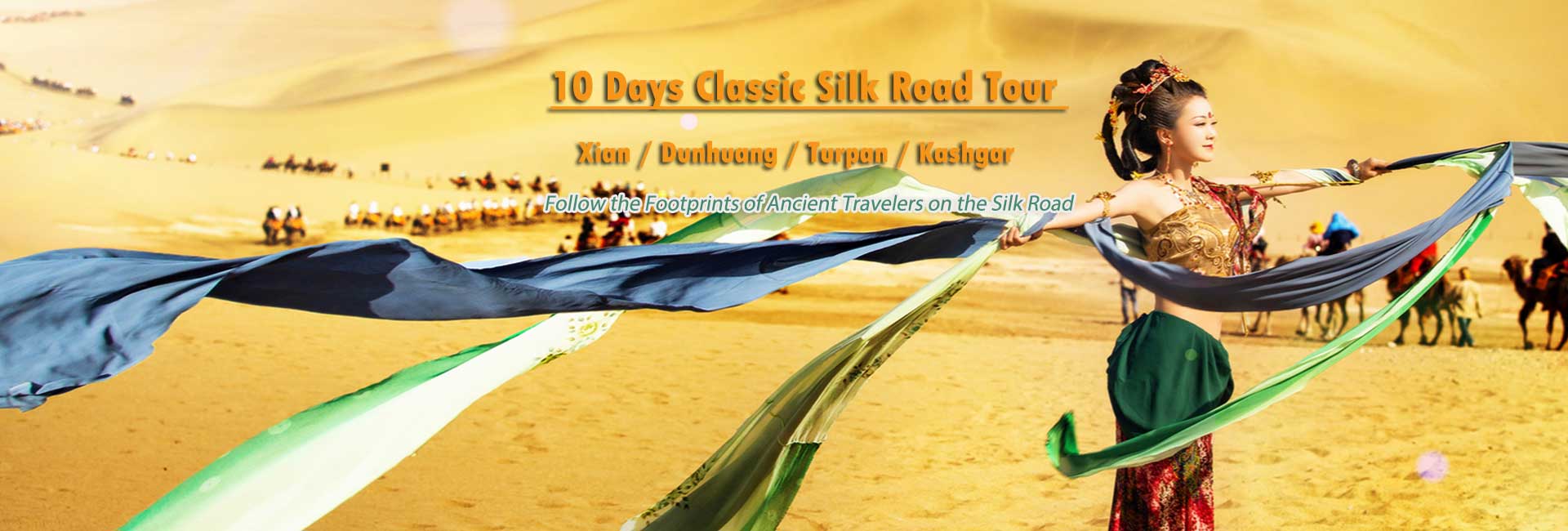
China Silk Road Tours - Ancient Silk Road Travel 2024/2025
Follow Marco Polo's footprints to enjoy a once-in-a-lifetime journey to the Ancient Silk Road!
The Silk Road connecting the East and the West was one of the most important arteries of trade and culture in world history. A dozen immense caravans traveled on this long route between ancient China and the Mediterranean for two millennia. Today, the Silk Road is rather a historic travel route on which you can experience interesting history, enjoy exotic culture and savor wild nature. The best highlights are a series of historical towns and ruins spreading on from Xian, through Ningxia, Gansu, Qinghai and Xinjiang, and eventually to Central Asia. Besides, the Silk Road is also a scenic route with breathtaking natural landscapes, including snow-capped peaks, wild deserts, magic Danxia landforms, emerald lakes, etc.
In order to help you better explore the cultural and natural splendor of the Silk Road, China Discovery here has selected the best-selling tour packages covering the most preferred attractions and activities. You could also browse the short trips filtering by the most popular destinations on the Silk Road, or customize a Silk Road tour according to your own interest, travel length or budget. Besides, we offer the most-updated travel information and travel guide about Silk Road which assist you with a full preparation for your coming Silk Road holiday in advance.
China Discovery is a leading China tour agency offering quality all-inclusive tour packages, including one-to-one itinerary-organizing, hotels and tickets booking, local knowledgeable tour guide, comfortable private transfer, etc. We have got 3,670+ commendatory feedback from our customers and 1,860+ good reviews on TripAdvisor. You can completely trust us! Remember to enjoy the real travel stories shared by our past customers and get inspiration for your Silk Road holiday.
Why you can trust our Silk Road tour? Check what our customers are reviewing about us!
Top 8 Silk Road Tour Packages
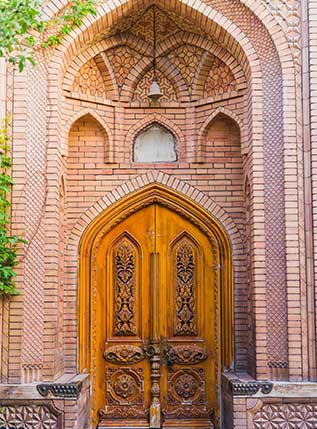
Classic Silk Road Tour
Trip at a Glance: Xian (3N), Dunhuang (1N), Turpan (1N), Urumqi (2N), Kashgar (2N)
Sites: Terracotta Warriros, Mogao Grottoes, Heavenly Lake, Kashgar Old City
Transfer: Private Car & Bullet Train
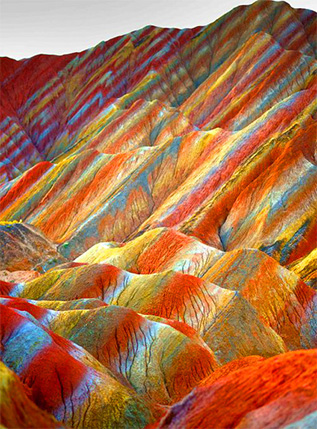
Silk Road Glory
Trip at a Glance: Zhangye (1N), Zhangye (1N), Jiayuguan (1N), Dunhuang (2N)
Sites: Zhangye Danxia, Jiayuguan Fort, Mogao Grottoes, Mingshan Mountains, Yulin Caves
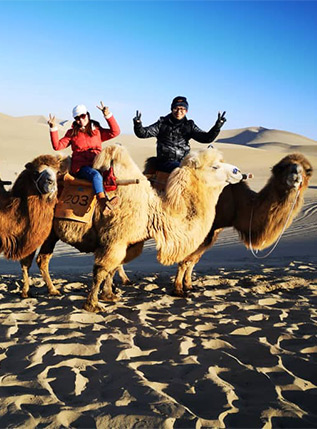
Essences of Silk Road History and Culture
Best silk road culture.
Trip at a Glance: Xian (2N), Dunhuang (2N)
Sites: Terracotta Warriors, Mogao Grottoes, Mingshashan Desert, Crescent Lake
Transfer: Private Car & Flight
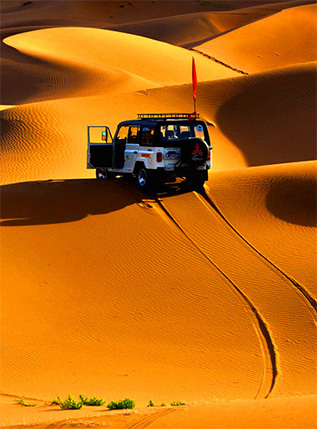
Photography of Colorful China
Photography of wild china.
Trip at a Glance: Xining (2N), Chaka (1N), Zhangye (2N), Badain Jaran Desert (1N)
Sites: Qinghai Lake, Zhangye Danxia Geopark, Binggou Danxia Geopark, Badain Jaran Desert
Transfer: Private Car
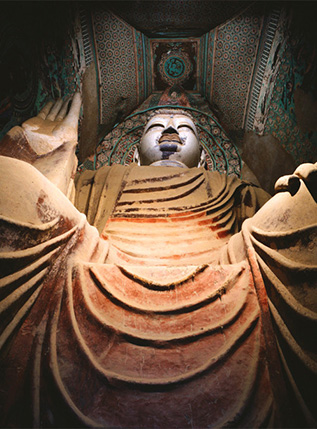
Legendary Journey to The West
Trip at a Glance: Beijing (3N), Xian (3N), Dunhuang (1N), Turpan (1N), Urumqi (2N), Kashgar (1N)
Sites: Mutianyu Great Wall, Terracotta Warriors, Mogao Grottoes, Kashgar Old City
Transfer: Private Car & Bullet Train & Flight
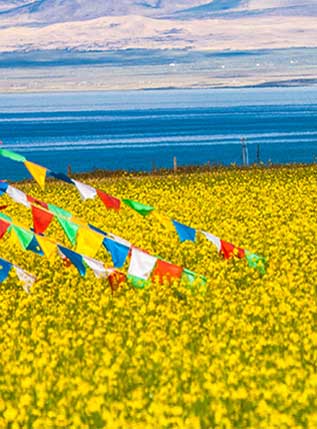
Epic Silk Road Scenery
Epic silk road tour.
Trip at a Glance: Xining (2N), Zhangye (1N), Jiayuguan (1N), Dunhuang (2N), Turpan (1N), Urumqi (2N), Kashgar (2N)
Sites: Qinghai Lake, Mingsha Mountains, Mogao Grottoes, Kashgar Old City
Transfer: Private Car & Train & Flight
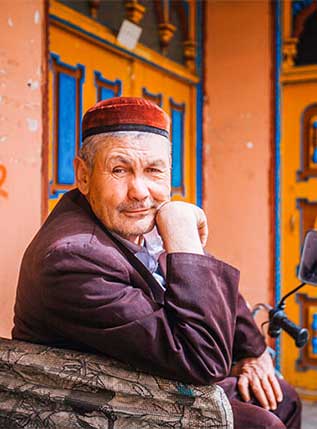
Explore Silk Road in Xinjiang
Trip at a Glance: Urumqi (2D), Turpan (1D), Korla (1D), Kuqa (2D), Minfeng (1D), Hotan (1D), Kashgar (3D), Tashkurgan (1D)
Sites: Takilamakan Desert, Karakul Lake, Id Kah Mosque, Kashgar Old Town, Tianshan Mysterious Canyon...
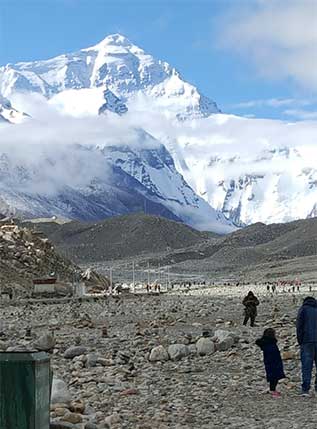
Mysterious Wild China
Mysterious wild china exploration.
Trip at a Glance: Kashgar (2N), Urumqi (1N), Turpan (1N), Dunghuang (2N), Jiayuguan (1N), Zhangye (1N), Xining (2N), Xining-Lhasa Train (1N), Tibet(7N)
Sites: Kashgar Old City, Mogao Grottoes, Qinghai Tibet Railway, Mount Everest
Transfer: Private Car & Train
Find Your Favorite China Silk Road Adventure by Destinations
Do you have any ideas where to go to explore China Silk Road better? In fact, the Silk Road passes through six provinces in China, including Henan, Shaanxi, Ningxia, Qinghai, and the essence of the Silk Road - Gansu and Xinjiang . In these provinces, there are many cities and towns cherished with numerous brilliant historic & cultural treasures. Here we list the top 10 destinations (including Xian, Luoyang, Dunhuang, Kashgar…) with priceless relics and breathtaking landscape to experience. Just click your favorite destination to find the general travel information and the most recommended tours. If you are looking any other places for a more in-depth experience (such as Kuche, Korla, Baoji, Zhongwei, Guyuan…), feel free to contact us for more detailed information.
Xian - the Origin of the Silk Road
Explore China’s past glory in the World Historic and Cultural City recognized by UNESCO!
The Silk Road was originally opened in 139 BC during the Western Han Dynasty, when Emperor Wu ordered Zhang Qian to visit western regions from the capital - Xian (called Chang’an in the old times). As the origin of the Silk Road and an old capital of 13 Dynasties, Xian offers many wonderful historic sites and cultural experiences.
- Location: Shanxi Province in Central China
- Best Places to Go: Great Wall, Forbidden City, Temple of Heaven, Summer Palace
- Recommended Activities: Biking, Food Class, Tang Dynasty Show, Minatare Terracotta Warrior Making…
- Recommended Trip Length: 2 ~ 4 days
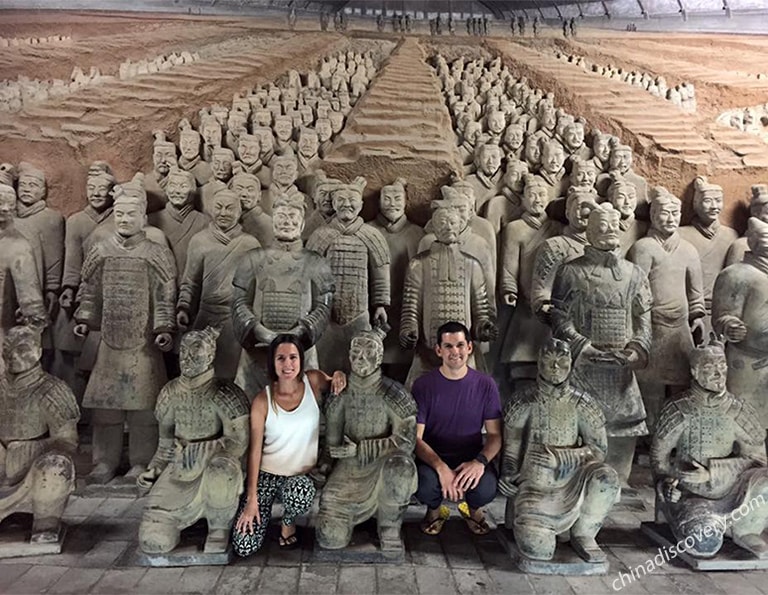
3 Days Classic Xian Tour
Travel the best highlights and the unique historic relics of the ancient capital Xian at an enjoyable pace in 3 days. This is the most classic Xian itinerary, with visits to all the bests of this ancient capital!
Price from $298
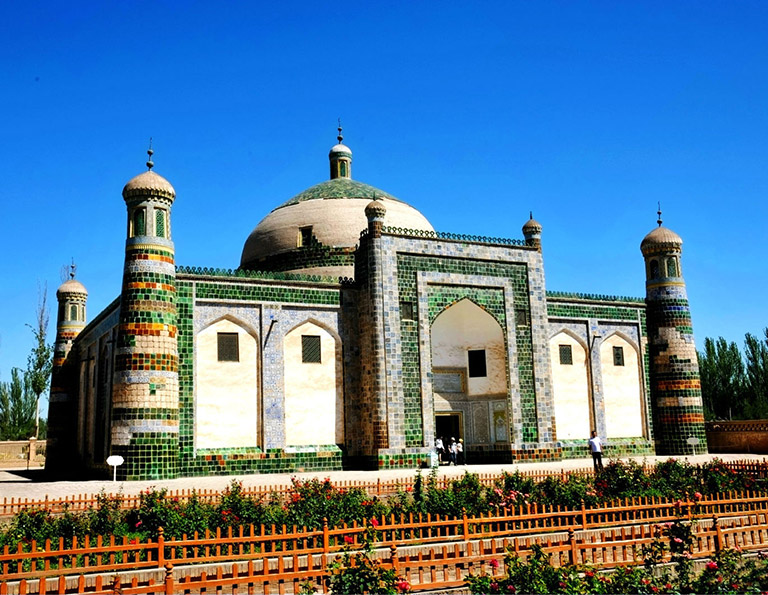
Most classic trip to follow the footprints of the ancient Silk Road. You will visit Xian, Urumqi, Kashgar, Turpan and Dunhuang. Private tour package, competitive price.
Price from $2,566
Dunhuang - the Most Important Post along the Silk Road
Appreciate the finest Buddhist art in the Oriental Louvre and the magic desert view with a never-dry lake!
As the westernmost city in the Hexi Corridor, Dunhuang held a strategic post along the Silk Road. With many goods, handicrafts, religions and cultures from central China and other regions in central Asia or Europe mixed here, it became a flouring trade and cultural center. Lots of historic relics are preserved in Dunhuang, including world-famous Mogao Grottoes.
- Location: Gansu Province in northwestern China
- Best Places to Go: Mogao Grottoes, Mingsha Mountain & Crescent Lake, Yardang National Geopark, Yumen Pass, Yangguan Pass..
- Recommended Activities: Camel-riding, Desert Camping, Silk Road Shows…
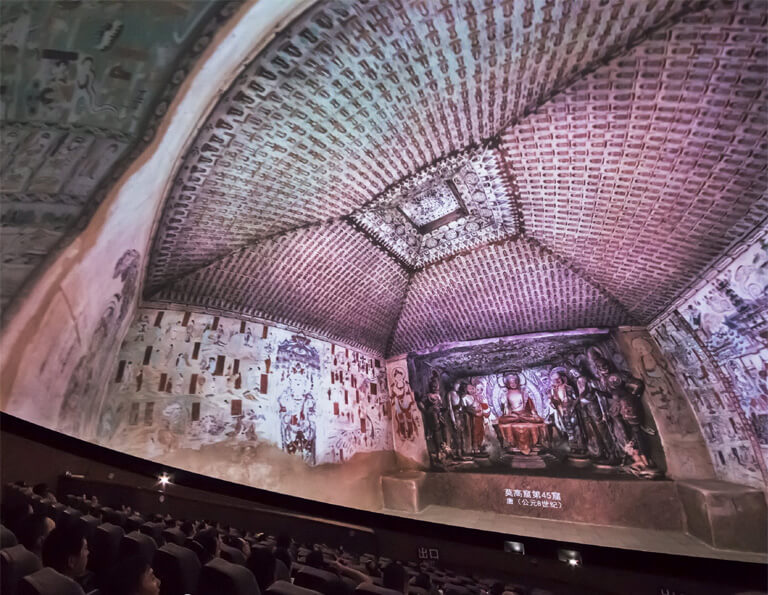
3 Days Dunhuang Culture & Scenery
Trace the Silk Road in Dunhuang, also enjoy marvelous Gobi Desert landscape, incredible Yardang landforms, Crescent Lake, etc. with your private guide and driver.
Price from $352
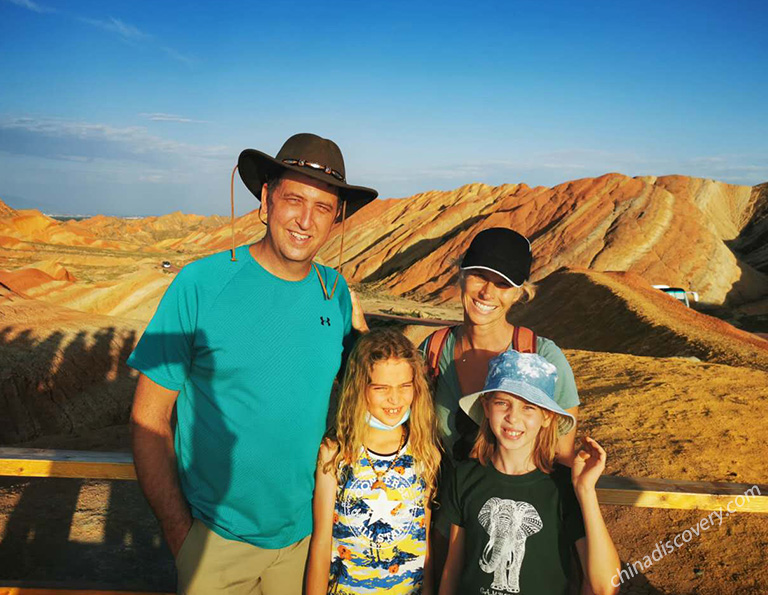
8 Days In-depth Gansu Highlights Tour
A thorough tour to discover the Gansu highlights from Lanzhou, via Xiahe, Zhangye Danxia Landform, Jiayuguan, to Dunhuang.
Price from $1,361
Kashgar - the Convergence of North and South Route of the Silk Road
Get a memorable cultural and spiritual exploration in the essential part of Xinjiang!
Kashgar in Xinjiang is a must-be-visited site if you are seeking for the authentic Xinjiang atmosphere and the essence of the Silk Road culture. It is honored as the fusion of the Eastern and Western cultures, and various ethnic groups and different spiritual believes coexist here till now. In addition to cultural significance, an amazing plateau landscape can be viewed as well.
- Location: Xinjiang Province in northwestern China
- Best Places to Go: Kashgar Old City, Id Kah Mosque, Abakha Hoja Tombe, Karakul Lake, Tashkurgan Stone City…
- Recommended Activities: Handicrafts Making, Local Tea Tasting…
- Recommended Trip Length: 3 ~ 4 days
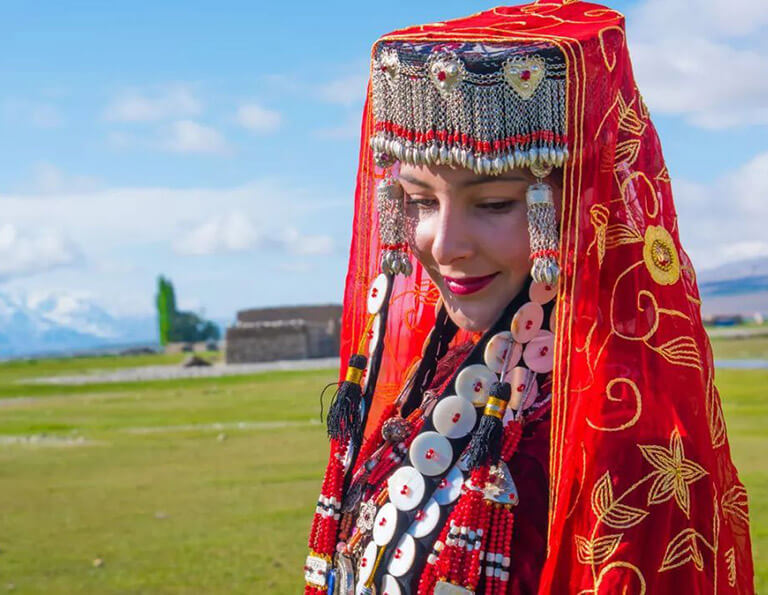
5 Days Legendary Pamirs Tour from Kashgar to Tashkurgan
This legendary Pamirs Tour combines the Silk Road culture with Pamirs adventure perfectly. It is all-inclusive private tour package that is strongly recommended for those who are seeking for authentic culture and wild landscape.
Price from Request
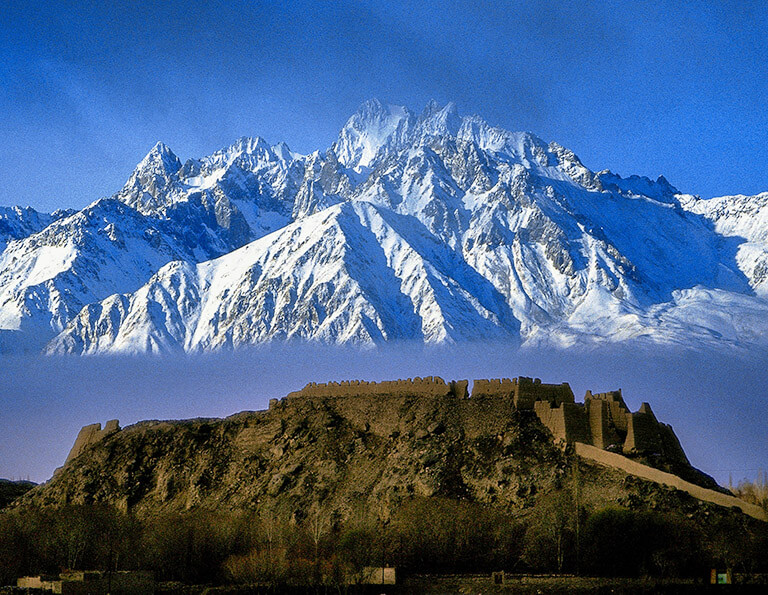
8 Days Urumqi Turpan Kashgar Xinjiang Tour - Classic Xinjiang Discovery
This is the most classic and enjoyable Xinjiang tour on which you will visit the Golden Triangle - Urumqi, Kashgar and Turpan to get the best Silk Road exploration and Xinjiang's best culture and nature.
Luoyang - the Capital of the Most Glorious Dynasties
Go back to the earliest days of China’s antiquity, and enjoy the enlightenment of Chinese Buddhism and Chinese Kungfu!
Just like Xian, Luoyang is also an ancient capital of 13 dynasties, including China’s most prosperous Sui and Tang Dynasty (581~907). As a great cradle of Chinese civilization, Luoyang provides travelers with many cultural surprises, such as the masterpiece of stone Buddha carving arts, China’s first Buddhist temple, the ruins of the capital of China’s first dynasty, etc. It is also known as the city of peony and you can enjoy a variety of peony flowers from April to early May. Besides, many travelers take a sidetrip to Shaolin Temple - the Birthplace of Chinese Kung Fu.
- Location: Henan Province in central China
- Best Places to Go: Longmen Grottoes, White Horse Temple, Luoyang Museum…
- Recommended Trip Length: 2 ~ 3 days
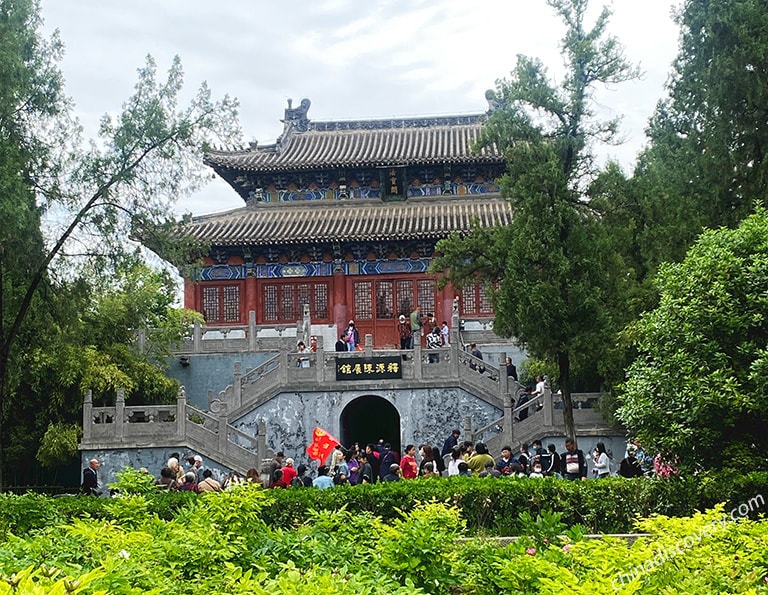
3 Days Luoyang Essence Tour
Apart from the surviving Longmen Grottoes, you will also explore more of Luoyang by visiting its local museums and experience the authentic Shaolin Kung Fu in nearby Dengfeng Shaolin Temple.
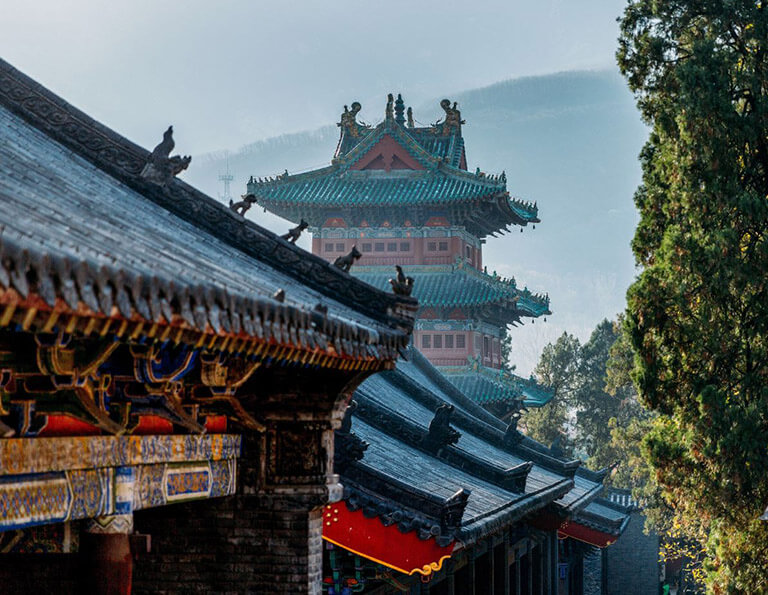
6 Days Henan Highlights Tour
Explore the essential highlights of Henan in a brief but enjoyable way, including the ancient Yinxu Site in Anyang, famous Shaolin Temple and magnificent Longmen Grottoes in Luoyang, etc.
Turpan - A Veritable Oasis in the Desert
Discover the ancient city ruins, mysterious villages and sweet grapes in China’s most burning city!
Turpan is the hottest city in China, and its highest temperature can reach over 40 °C. However, it can easily enjoy coolness in the mud buildings or green vineyards because of the irrigating project of Karez System. There are also many historic sites in Turpan, from which travelers can take an insight into the brilliant culture of the Silk Road as well.
- Best Places to Go: Jiaohe Ancient City, Karez System, Turpan Museum, Bezeklik Thousand Buddhas Cave, Tuyuk Valley, Gaochang Ancient City, Kumtag Desert…
- Recommended Activities: Desert activities like desert safari, sand surfing, desert spa…

3 Days Turpan Highlights Tour
This 3-day tour takes you to visit the Buddhist relics, city ruins, great engineering project as well as the magnificent Kumtag Desert.
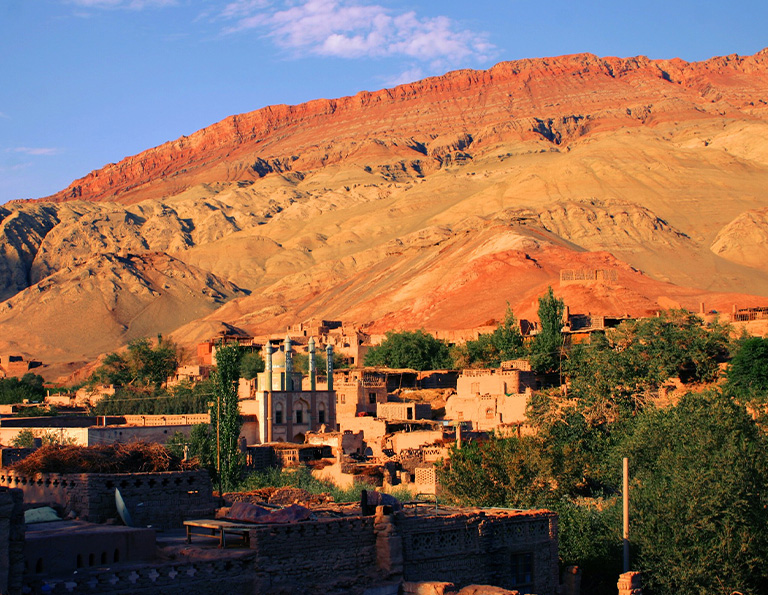
6 Days Urumqi Turpan Kashgar Efficient Tour - Brief Xinjiang Impression
This is a time-and-money efficient tour on which you will start your tour from Urumqi and end in Kashgar with a well-arranged itinerary. You will have all the classic experiences in your pocket, and at the same time enjoy vacation-standard tour services. It is available all year around.
Xining (Qinghai) - Gateway to China’s Amazing Plateau Landscape
Immerse in the beauty of the colorful salt lakes and Buddhist atmosphere!
Xining is the capital and the tourist distribution center of Qinghai Province, and also an important stop along the ancient Silk Road during the Wei-Jin Dynasties and the late Tang Dynasties. Many travelers start a memorable Qinghai trip from Xining to nearby amazing lakes, geo-parks, holy mountains as well as Amdo Tibet Regions and Tibet.
- Location: Qinghai Province in northwestern China
- Best Places to Go: Qinghai Lake, Chaka Salt Lake, Kumbum Monastery, Dongguan Mosque, Tibetan Medcine & Tibet Culture Museum…
- Recommended Activities: Biking, Hiking, Cruising, Photography, Bird-watching…
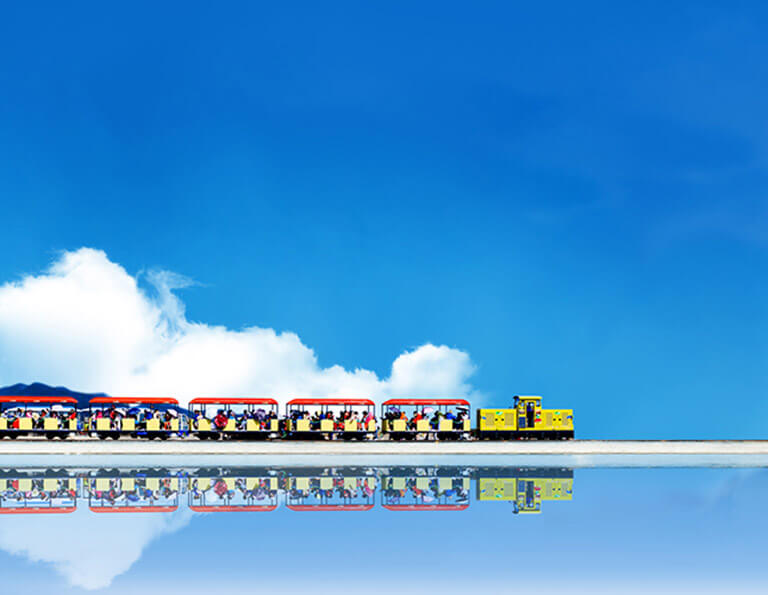
4 Days Enchanting Qinghai Lake Chaka Salt Lake Tour
Bring you to see high-plateau Qinghai Lake and mirror-like Chaka Lake as you have never seen before. It’s the perfect escape from our city life to enjoy with family and friends. You will be taken to the most classic and highlighting sights to take photos on our well-paced tour.
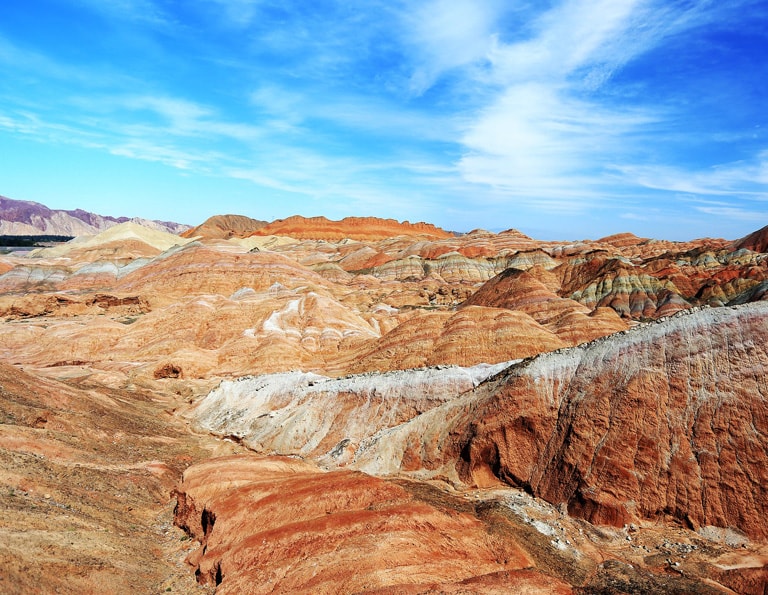
6 Days Qinghai Lake Zhangye Danxia Rainbow Mountains Dramatic Tour
Ease into the simple joys of natural travel that you can only find in northwestern China – vast plateau lake, mirror-like salt lake, rainbow mountains, hanging temples stretching out from caves… this is what our 6 days dramatic tour will bring to you.
Urumqi - Window of Xinjiang’s Culture & History
Get the first impression of Xinjiang!
As Xinjiang’s capital receiving convenient flights from many other cities of China, Urumqi always serves as the starting point of a Silk Road Tour. It is worth strolling among the exhibitions displayed in Xinjiang Regional Museum, experiencing local life in the busy bazaars, tasting featured local food, and most importantly enjoying the scenic beauty of the Heavenly Lake.
- Best Places to Go: Heavenly Lake of Tianshan Mountains, Xinjiang Regional Museum, Xinjiang International Grand Mountains, Nanshan Pasture…
- Recommended Activities: Biking, Hiking, Cruising, Photography…
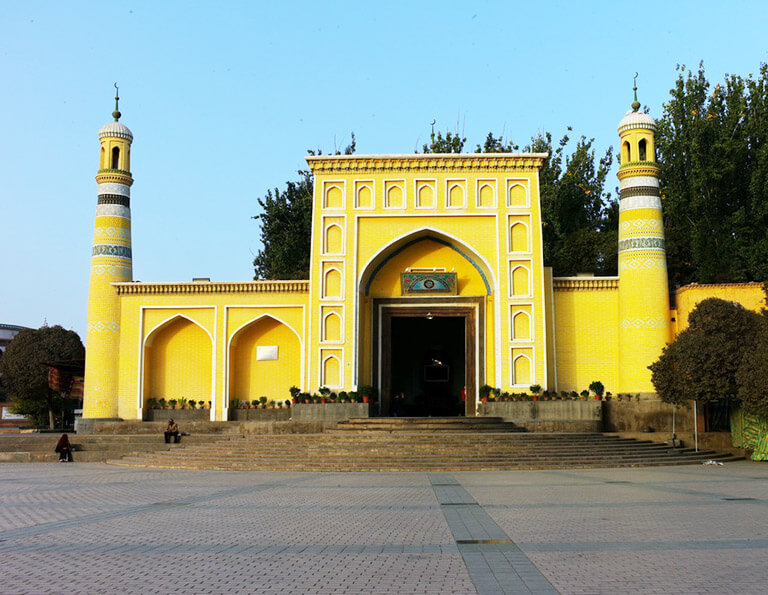
6 Days Urumqi to Kashgar Dream Tour - Best Xinjiang Tour for the First-timers
Urumqi and Kashgar are the two Must-go destinations for all the first-timers. They are the very essence of Xinjiang, no matter you are seeking for Silk Road history, authentic local culture, or marvelous scenery.
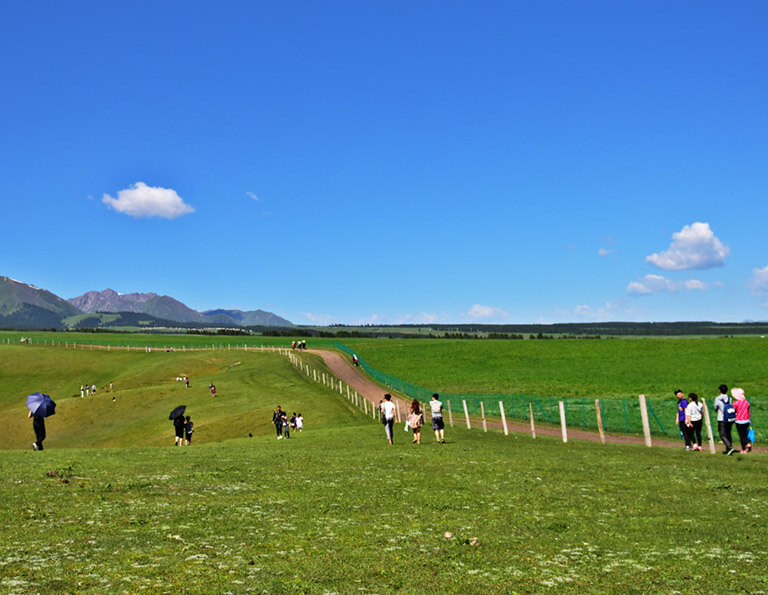
4 Days Urumqi Holiday Tour with Southern Pasture Landscape and Kazak Culture Experience
This is a leisure holiday in Urumqi as well as a unique Urumqi trip. It is strongly recommended for families with kids, photographer and natural lovers.
Jiayuguan - Crucial Transportation Hub on the Silk Road
See the westernmost fortress of the Great Wall of the Ming Dynasty!
Jiayuguan is most famous for its fortress situated at the end of the portion of the Great Wall of the Ming Dynasty. Unlike other sections built with stones or bricks, Jiayuguan Great Wall was built with rammed earth. The yellow hue of the pass blends harmoniously with the surrounding desert. Till now, it is still a great stop between Zhangye and Dunhuang for travelers.
- Best Places to Go: Jiayuguan Pass, Great Wall Museum, Overhanging Great Wall
- Recommended Trip Length: 1 ~ 2 days
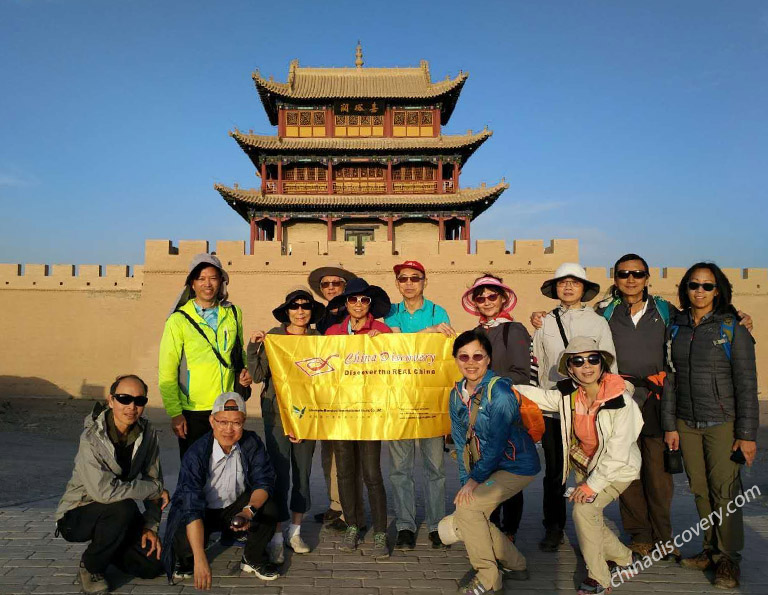
6 Days Zhangye Jiayuguan Dunhuang Tour
Memorable trip to discover three most glorious destinations in Zhangye, Jiayuguan and Dunhuang - diverse experience, enjoyable pace, budget price!
Price from $946
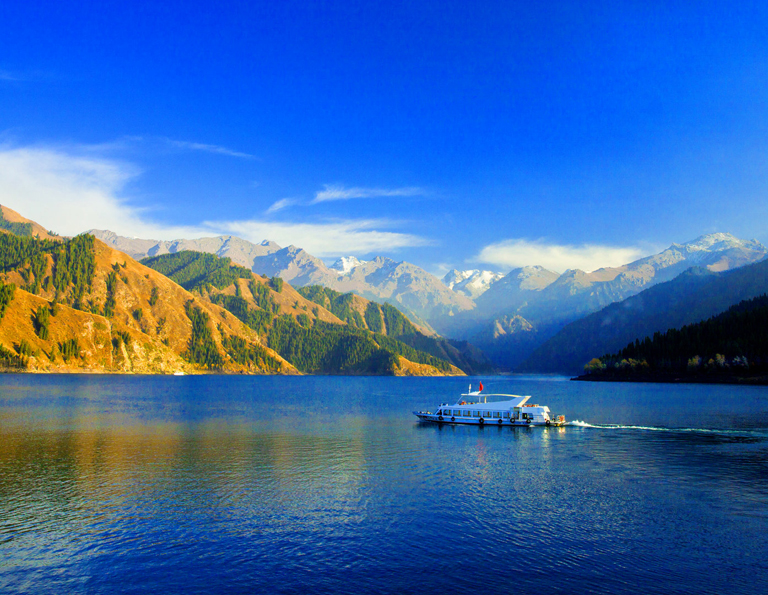
11 Days In-depth Wild Silk Road Adventure Tour
An in-depth Silk Road adventure takes you to explore the most outstanding destinations in northwest China’s Gansu and Xinjiang and encounter both historic heritages and amazing natural landscapes.
Zhangye - Magical Rainbow Mountains
Be awed at the most spectacular Danxia Landform and Grottoes Temple Hanging on the Cliff!
Zhangye, literally translated as extending arm, excerpted from a phrase “to extend the arm of the country through to the Western Realm”. It is an important trade center holding a strategic position in the Hexi Corridor. Many historic sites can be found in Zhangye. Now, it is also attractive with its beautiful Rainbow Mountains in Danxia Geopark - colorful Zhangye Danxia.
- Best Places to Go: Zhangye Danxia, Matisi Temple, Dafo Temple
- Recommended Activities: Photography, Hiking
- Recommended Trip Length: 2 ~ 2 days
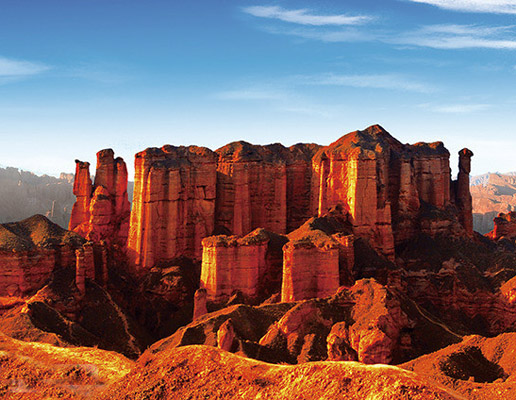
3 Days Zhangye Danxia Classic Private Tour
Explore Zhangye with the classic itinerary, covering Zhangye Danxia Geo Park, Binggou Danxia, Giant Buddha Temple, Matisi Grottoes.
Price from $342
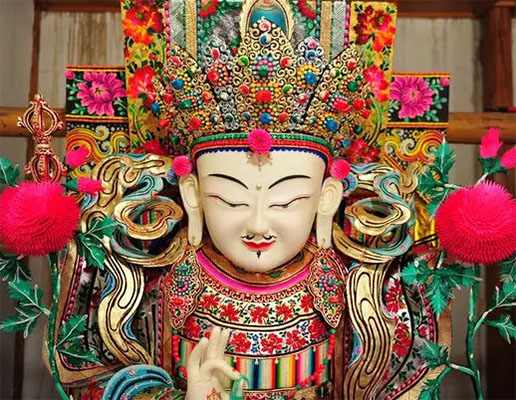
10 Days Qinghai Gansu Highlights Tour
Start from the stunning Qinghai Lake to the famous Buddhist monastery - Labrang, then travel northward to explore Zhangye Danxia, Jiayuguan Fort and Mogao Grottoes.
Price from $1647
Lanzhou - Transfer Center in Northwestern China
Enjoy an easy transfer to Lanzhou and start to discover the essence of the Silk Road!
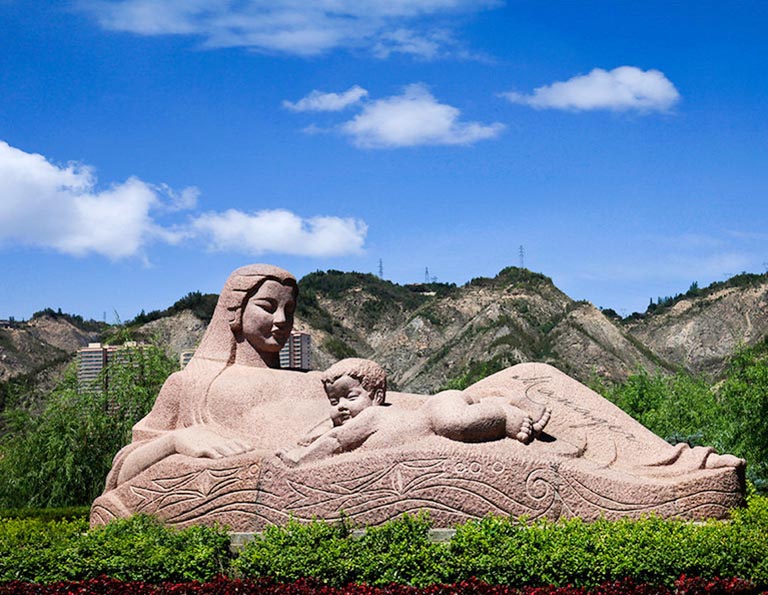
3 Days Lanzhou Short Break
Visit the best city highlights to meet Yellow River culture of Lanzhou and explore hidden Buddhist cave art existed over 1,600 years.
Price from $489
China Silk Road Travel Guide Useful Articles
Silk Road is really a precious cultural treasure for human beings and a wonderful travel route for explorers. Do you want to know more about it? Such as how the Silk Road got its name, where the Silk Road started and ended, how long it took to cross the Silk Road in ancient times, who traveled on the Silk Road… Or do you want to have more travel information about it? Such as how to plan a Silk Road tour, what the top destinations on the Silk Road are, how the accommodation condition is, some important travel tips, etc. Just browse the following Silk Road articles for a better understanding of the Silk Road, as well as a more efficient Silk Road exploration.

Silk Road Facts
There are many fun facts about the Silk Road that travelers might be interested in. Here, we have 12 most commonly asked questions about the silk road, and these interesting facts will broaden your horizon to learn beyond just routes and ancient relics, and help you have more vivid background knowledge before your Silk Road adventure.
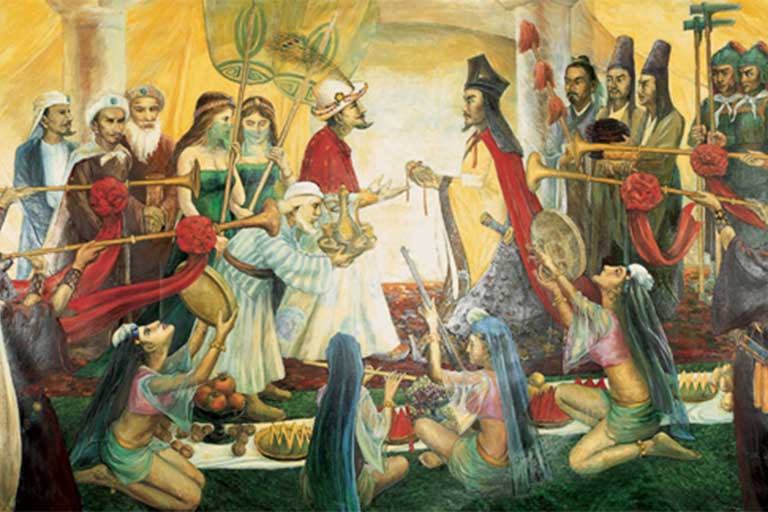
Silk Road History
The ancient Silk Road has experienced several important stages since it was originally started in the Western Han Dynasty (202 BC ~ 8 AD) and ended in the Qing Dynasty (1936 ~ 1912). Want to find out how it started, evolved and declined? Check its history to learn the complete history of the Silk Road, including its beginning, flourishing and fading.
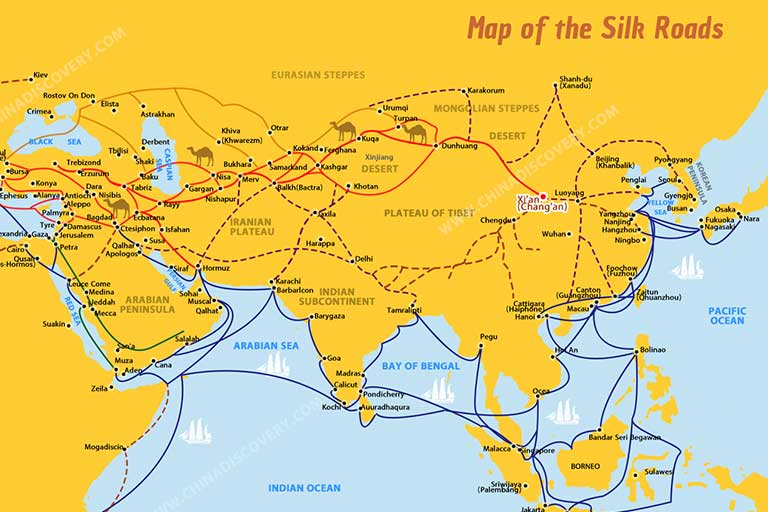
Silk Road Routes
The Silk Road is a network which can be generally divided into the Land Silk Road and the Maritime Silk Road. However, the Land Silk Road in China contains the Northern Route and the Southern Route, and the Northern Route split again in Kashgar.
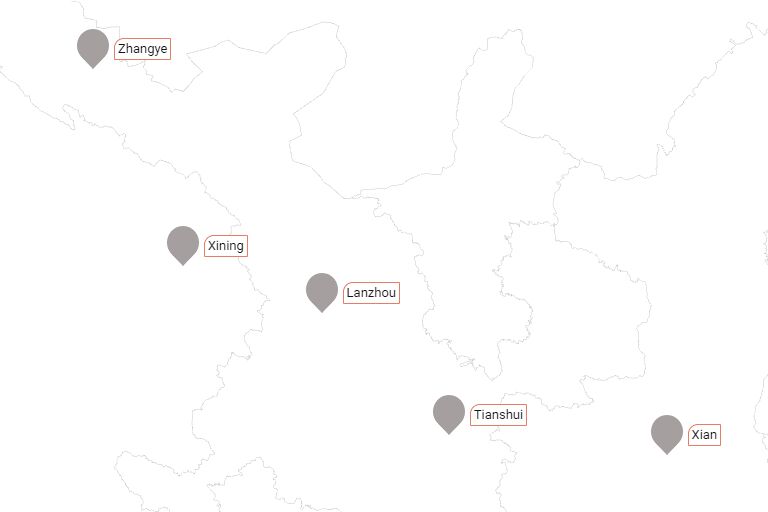

Silk Road Maps
It is not easy to "follow" the Silk Road on the map, because there are several main routes that also have many branches. Don't worry, we will make your study easier. Check our Silk Road map to trace back to the glorious ancient times.
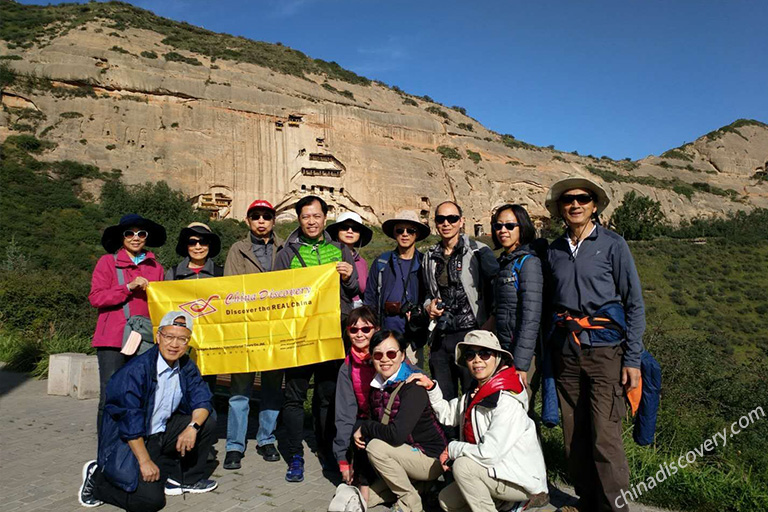
How to Plan A Silk Road Trip
The beauty of the Silk Road needs immediate action and a well-organized tour will help you enjoy a much more efficient tour. Silk Road trip planner here helps you figure out the best attractions, activities, best time, great accommodations, suggested itinerary, etc.
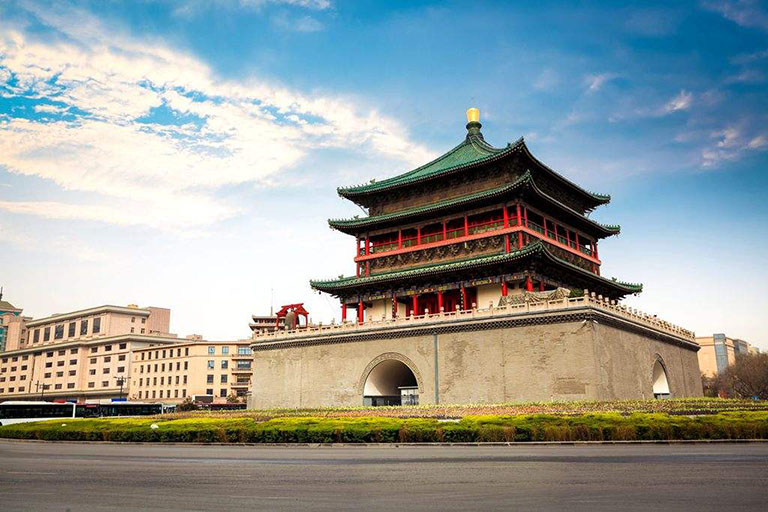
Tourist Cities along the Silk Road
To help you find Silk Road travel inspirations, we select the most popular and recommended China's tourist destinations along the Silk Road based on the original ancient Silk Route from central China to north western China, including Luoyang, Xian, Ningxia, Tianshui, Lanzhou, etc.
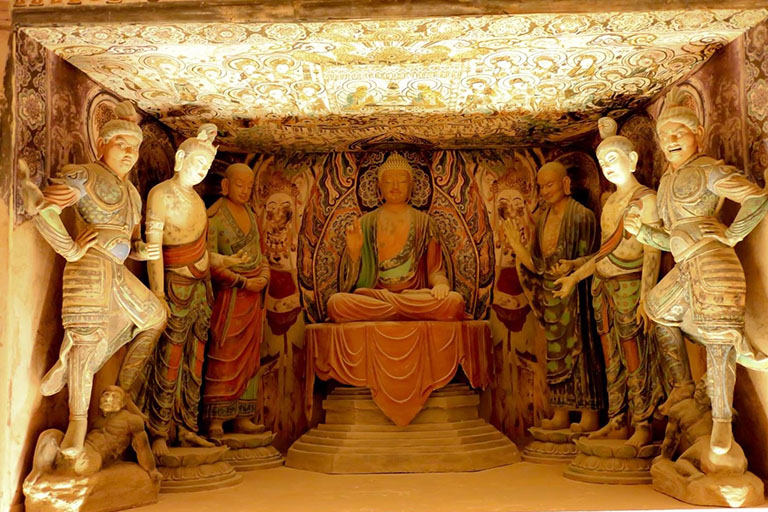
Tourist Attractions along the Silk Road
Many historical sites along the Silk Road, like ruins of ancient cities, Buddhist grottoes, temples, tombs, palaces, thus have been preserved in the original state. Besides, natural beauty can be savored as well while traveling along the Silk Road. Check the top tourist attractions to enjoy a wonderful Silk Road adventure.

Silk Road Accommodations
There are always comfortable hotels to stay in major cities along the silk routes such as Luoyang, Xi'an, Lanzhou, Xining, Urumqi, where there are hotels from economy class to luxury class. However, if you explore the Silk Road in depth, you need to go to some remote towns where the accommodation conditions are generally very basic.
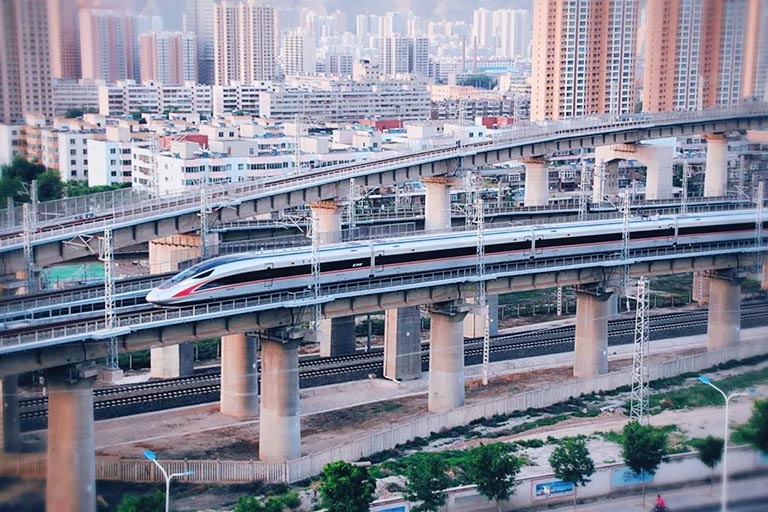
Silk Road Travel Tips
Here we collect frequently asked questions and practical travel tips to make sure you enjoy an easy and safe Silk Road travel, such as best gateway cities, convenient transfer ways, packing ideas, payment, shopping, taboos, time difference, etc.
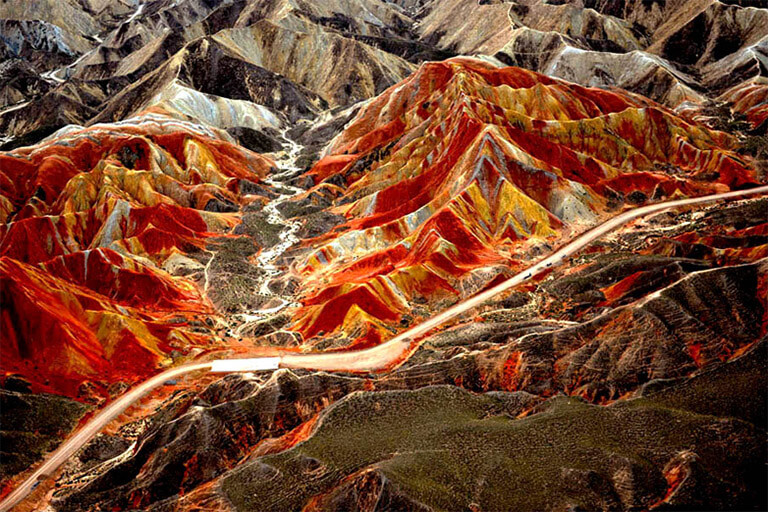
Silk Road Photo Gallery
The spectacular geographic environment along the Silk Road is diverse. You can see many ancient historical relics as well as various stunning landscape of mountains, prairie, desert and lakes. Get a visual feast first now.
Get Inspired by Our Customers’ Amazing Silk Road Travel Stories
We have helped numerous customers complete their Silk Road holiday in China. Are you curious about what they saw, did and felt about their tours.. Here we select some of the top inspiring travel stories to let you know not only the wonderful highlights they had enjoyed but also the forever unique memorable moments! Now, it’s your turn and your time to unveil your own story! >> Read All Our Customers Travel Stories during 2011-2024

2024-2025 China Silk Road Tours with More Fun
Want to enjoy a longer Silk Road holiday in China and visit more valuable destinations for more fun? China Discovery offers you more choices. You can visit the most classic destinations together with Silk Road destinations in one go! If you are a first timer to China, we suggest you get a first touch of China by visiting Beijing, Xian, Shanghai and Guilin - where China’s history, culture, nature and city view can be exhibited perfectly. Yangtze River Cruise is also a great option added into your itinerary for a leisurely experience. Besides, many travelers prefer an adventure to Zhangjiajie for an jaw-dropping view of the Avatar World. Moreover, you can step into Yunnan (Kunming, Dali, Lijiang, Shangri-La) and Anhui(Huangshan, Jiuhuashan) to have minority fun, Shanxi (Datong, Pingyao, Wutaishan…) and Henan (Luoyang, Zhengzhou…) to discover the civilization of ancient China. There are lots of wonders in China awaiting your exploration. Just select your favorite or customize your own tour according to your own interest and preference as well.
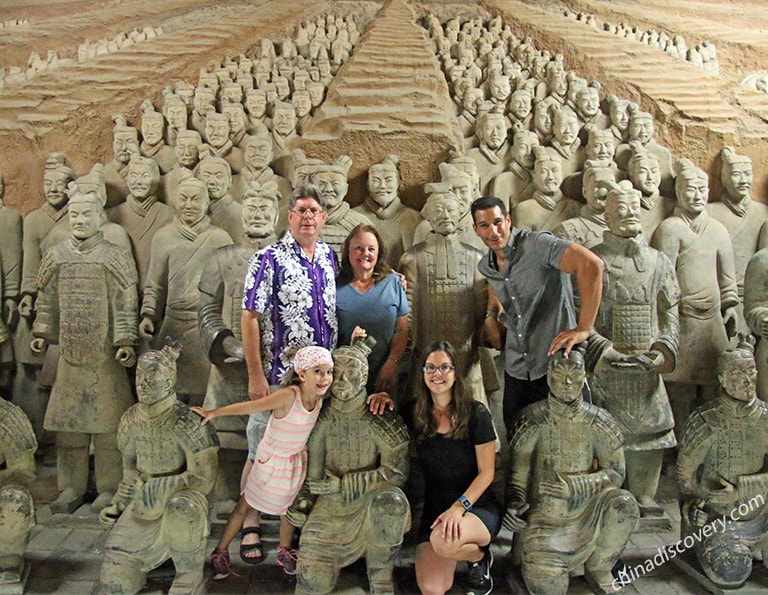
Beijing / Xian / Shanghai
from $1,432
Lanzhou / Zhangye / Jiayuguan / Dunhuang / Turpan / Urumqi / Kashgar
from Request
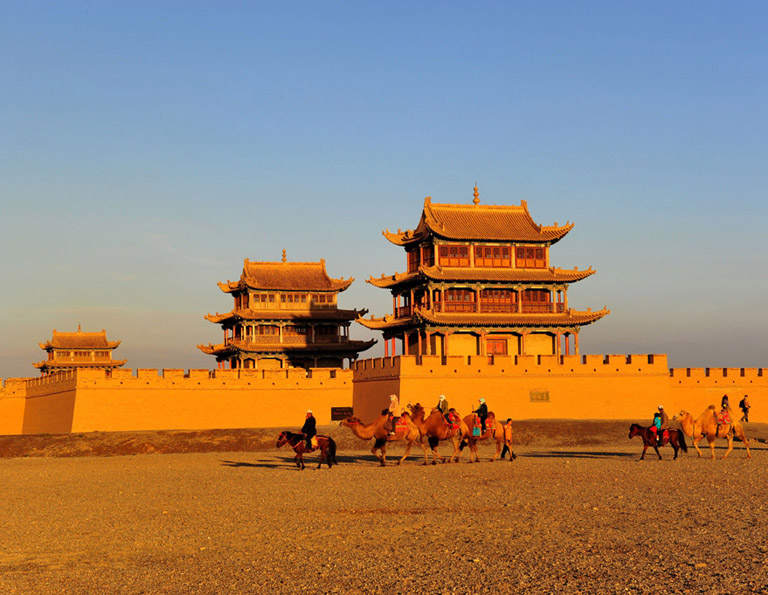
Xining / Zhangye / Jiayuguan / Dunhuang / Turpan / Urumqi / Kashgar
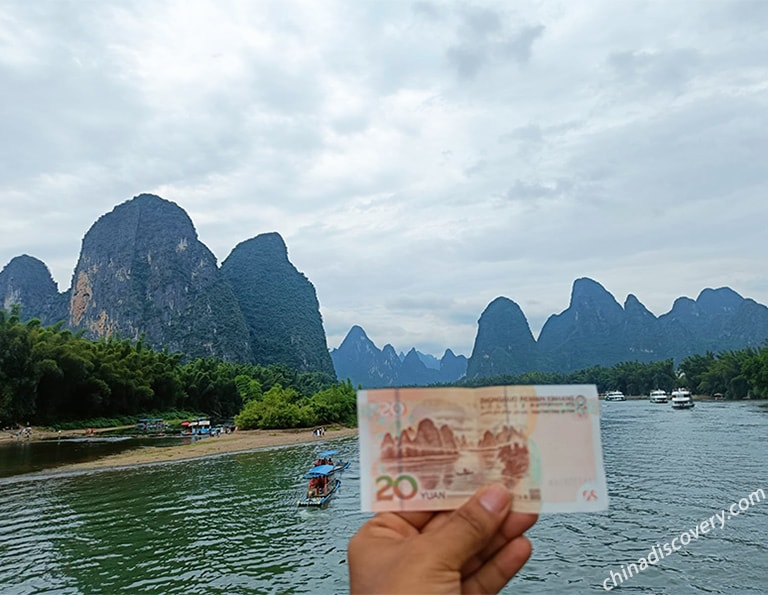
Beijing / Xian / Guilin / Yangshuo / Shanghai
from $1,999
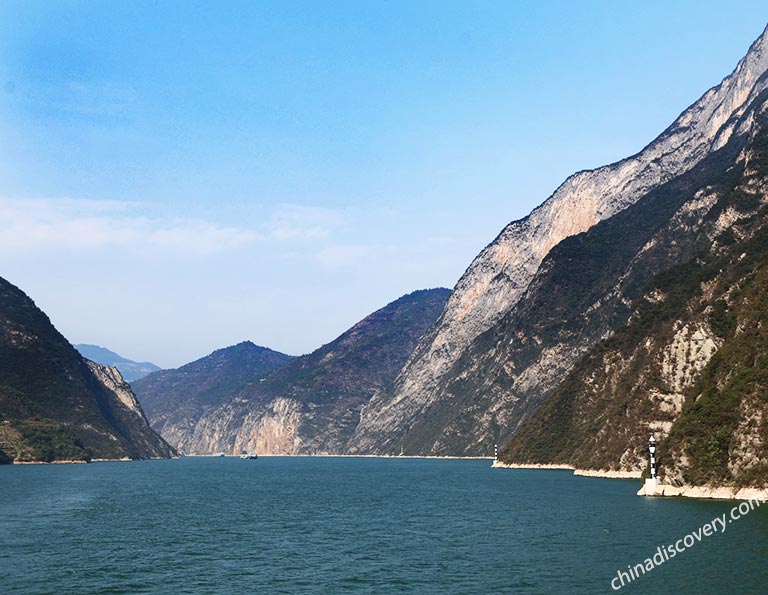
Beijing / Xian / Guilin / Yangshuo / Yangtze Cruise / Shanghai
from $2,478
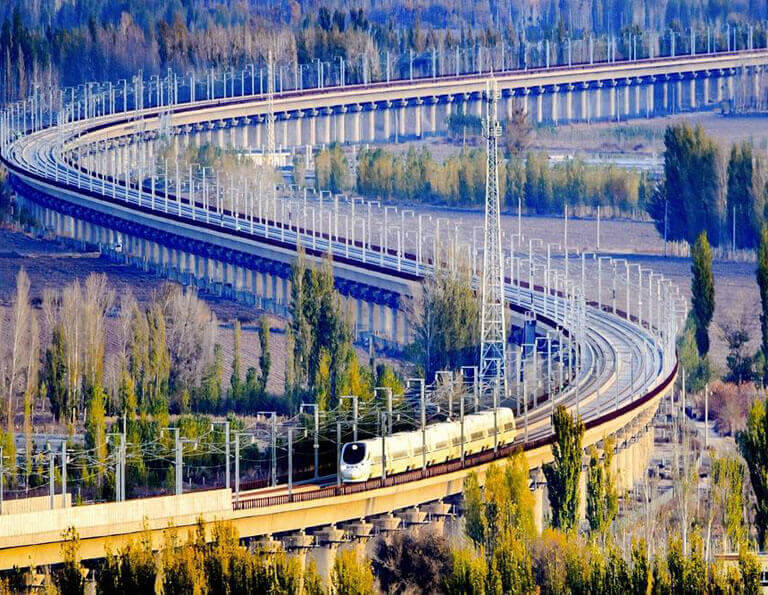
Kashgar / Tupran / Dunhuang / Jiayuguan / Zhangye / Xian / Beijing
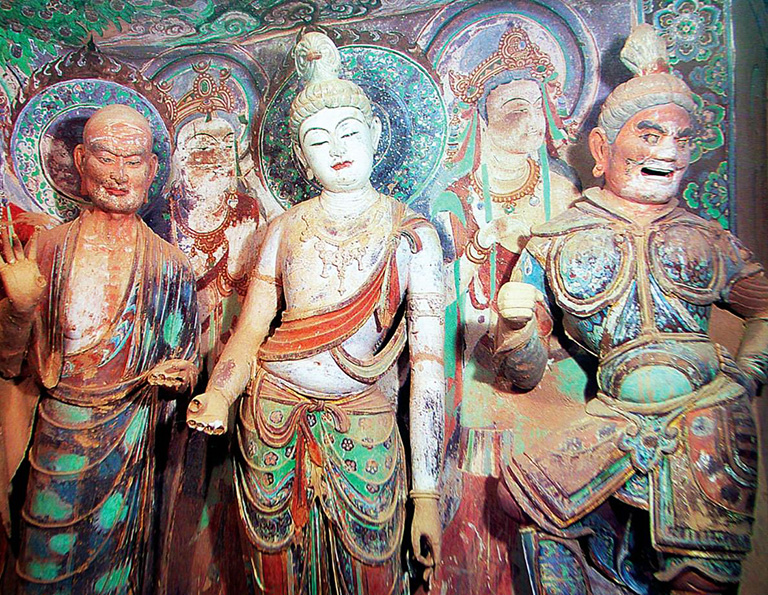
Beijing / Xian / Dunhuang / Turpan / Urumqi
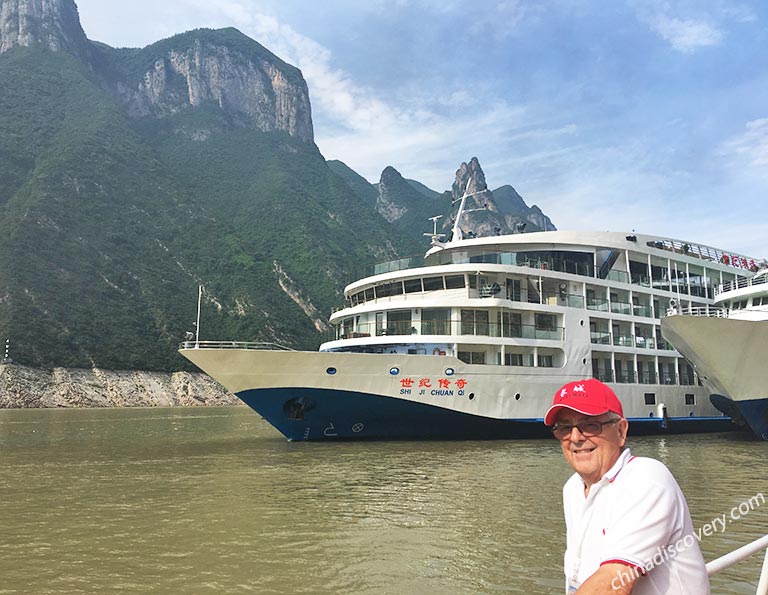
Beijing / Xian / Lhasa / Chengdu / Chongqing / Yangtze Cruise / Shanghai
from $3,499
Start planning your tailor-made holiday to China by contacting one of our specialists. Once inquired, you’ll get a response within 0.5~23.5 hours.

- Affordable and valuable price
- 100% tailor-made packages
- Highly rated customers reviews
- Efficient customer support
China Tours
- Top 10 China Tours
- Classic China Tours
- China Tours from Beijing
- China Tours from Shanghai
- China Tours from Hong Kong
- China Tours from Chengdu
- Short China Trips
- Customize China Tour
- China Panda Tours
- Family Tour with Kids
- High-Speed Train Tour
- Silk Road Travel
- Yangtze River Cruise
- Hiking & Trekking Tours
- Photography Tours
- China Minority Travel
- Beijing Shanghai Tours
- Shanghai Yangtze Tours
- Chengdu Jiuzhaigou Tours
- Chengdu Lhasa Tours
- Suzhou Hangzhou Tours
- Guilin & Yangshuo
- Zhangjiajie
“Very good experience”
“WONDERFUL 25 DAYS IN CHINA - PRIVATE TOUR”
“Awesome China tour from northeast to southwest”
Any questions, please email us at: [email protected] or call us at: 86-19138970032 (Monday-Friday 9 a.m. to 6 p.m. GMT+8)
- Terms & Condition
- Privacy Policy
- Customer Support
Copyright © 2011-2024. All rights reserved.
Cookie policy
We use cookies to give you the best experience on our website. Continue using our website means you agree with our cookie policy. For more info, please read here .
Join-in Group Silk Road China Tours
- Xian Attractions
- Lanzhou Attractions
- Jiayuguan Attractions
- Dunhuang Attractions
- Urumqi Attractions
- Turpan Attractions
- Kashgar Attractions
Silk Road China Travel Guide
Silk road transportation.
The Silk Road travel guide to modes & methods of transportation by railway, air, road, trucking, camels, trekking and more trade history facts about that how the goods to follow marco polo trails to be tranported.
Silk Road Climate
Much of the silk road is extremely hot during the summer, and extremely cold during the winter. Even during May and October, topography and climate along the Silk Road vary greatly. Some stretches of the road are high and cold, others low and dry.
Silk Road Food
Food taste on the Silk Road adventure: let's travel the ancient trade route to understand how genes shape people's love for foods. Follow those Chinese dumplings to taste Marco Polo food flavors and ideas in Xian, Lanzhou, Dunhuang, Urumqi, Turpan, Kashgar and Central Asia countries.
Silk Road Shopping
The Silk Road is international commercial trade route to exchange goods such us clay & metal ethnic handicrafts, dry fruits, jade, Chinese art works in Shaanxi, Gansu, Xinjiang Kyrgyzstan, Tajikistan, Uzbekistan, Kazakhstan, Turkmenistan and more Asia and Europe countries where shopping visitors should be done for shopping choices.
Things to Do on Silk Road
A list of top fun Things tells what to do on the Silk Road adventure: trekking, camping, camel Riding, Sunday Market shopping, ethnic dances and more traditional festivals & celebrations, tourist events & activities, entertainment & nightlife for travel choice.
Silk Road Travel Tips
The Silk Road travel tips with tour suggestions about history, ehtnice groups, language, accommodation, food and drink, transportation, books recommended to read more facts. Caravans have been traveling the Silk Road for over 2000 years; Chinese silk was reaching Rome before the time of Christ.
Top Silk Road Tours
Top silk road attractions.
- Silk Road Tours From China
- Silk Road Tours from Beijing
- Silk Road Tours from Shanghai
- Silk Road Tours from Hong Kong
- Silk Road Tours from Suzhou
- Silk Road Tours from Hangzhou
- Silk Road Tours from Xiamen
- Silk Road Tours from Fuzhou & Quanzhou
- Silk Road Tours from Guangzhou
- Silk Road Tours from Kunming
- Silk Road Tours from Chengdu
- Silk Road Tours From World
- China Silk Road Tours from USA
- China Silk Road Tours from Canada
- China Silk Road Tours from Mexico
- China Silk Road Tours from Brazil
- China Silk Road Tours from Arginteana
- China Silk Road Tours from Australia
- China Silk Road Tours from New Zeeland
- China Silk Road Tours from Turkey
- China Silk Road Tours from Greece
- China Silk Road Tours from UK
- China Silk Road Tours from France
- China Silk Road Tours from Germany
- China Silk Road Tours from Italy
- China Silk Road Tours from Singapore
- China Silk Road Tours from India
- Quick Links
- Why Trust Us
- How to Book a Tour
- Terms & Conditions
- Payment Guide
We are member of:
We accept payments:.
About Us | Terms of Use | Privacy Policy | Why Trust Us | How to Book | Payment Guide | Links | Contact Us
Copyright © 2011-2020 Access China Travel Professional China Tour Operator & Travel Service. All rights reserved.
Since 2003, over 15000+ Customers Explored Silk Road with us
- [email protected]
- +86 135 6583 4056
Top Silk Road Destinations

- China Silk Road Tours
Silk Road Xinjiang Tours
Silk Road Photography Tours
Silk Road Winter Tours
Luxury Silk Road Tours
- Great Silk Road Tours
15 Days Great Silk Road from Kashgar to Tashkent
20 Days Silk Road to Uzbekistan Kyrgyzstan & China
23 Days Uzbekistan to Pakistan via Karakoram Highway
10 Days Silk Road Xinjiang and Bishkek Kyrgyzstan
16 Days Silk Road Travel to Uzbekistan and China
- Silk Road Group Tours
7 Days Classic Xinjiang Tour to Kashgar, Turpan and Urumqi
7 Days Silk Road Group Tour to Gansu & Qinghai
18 Days Travel Silk Road in China with Escorted Guide
19 Days Xinjiang China and Uzbekistan Tour
- Oriental Express
- Expat & Group Tour
- China Group Tours
- North Xinjiang Tours
- South Xinjiang Tours
- Xinjiang Border Transfer
- Xinjiang Trekking Route
- Top China Tours
- Gansu Tours
- Qinghai Tours
- Yunnan Tours
- Sichuan Tours
- Fujian Tours
- Ningxia Tours
- West China Tours
- Hainan Tours
- Inner Mongolia Tours
- Northwest China Tours
- Tibet Tours
- Jiangxi Tours
- Chongqing Tours
- Guizhou Tours
- Beijing Tours
- Xi'an Tours
- Shanghai Tours
- Chengdu Tours
- Zhangjiajie Tours
- Kashgar Tours
- Zhangye Tours
- Dunhuang Tours
- Lanzhou Tours
- Pingyao Tours
- Urumqi Tours
- Turpan Tours
- Guangzhou Tour
Cities of Silk Road

Silk Road Destination
Turkmenistan
Top Destinations

- The Best Silk Road Tour Operator
- Words from Our CEO
- Travel agency cooperation
- How to book Your Silk Road Tour
- Silk Road Review
- Cancellation Policy
- Tailor Made
- Silk Road Guide
- Customize your trip
Email: [email protected] Tel: +86 135 6583 4056
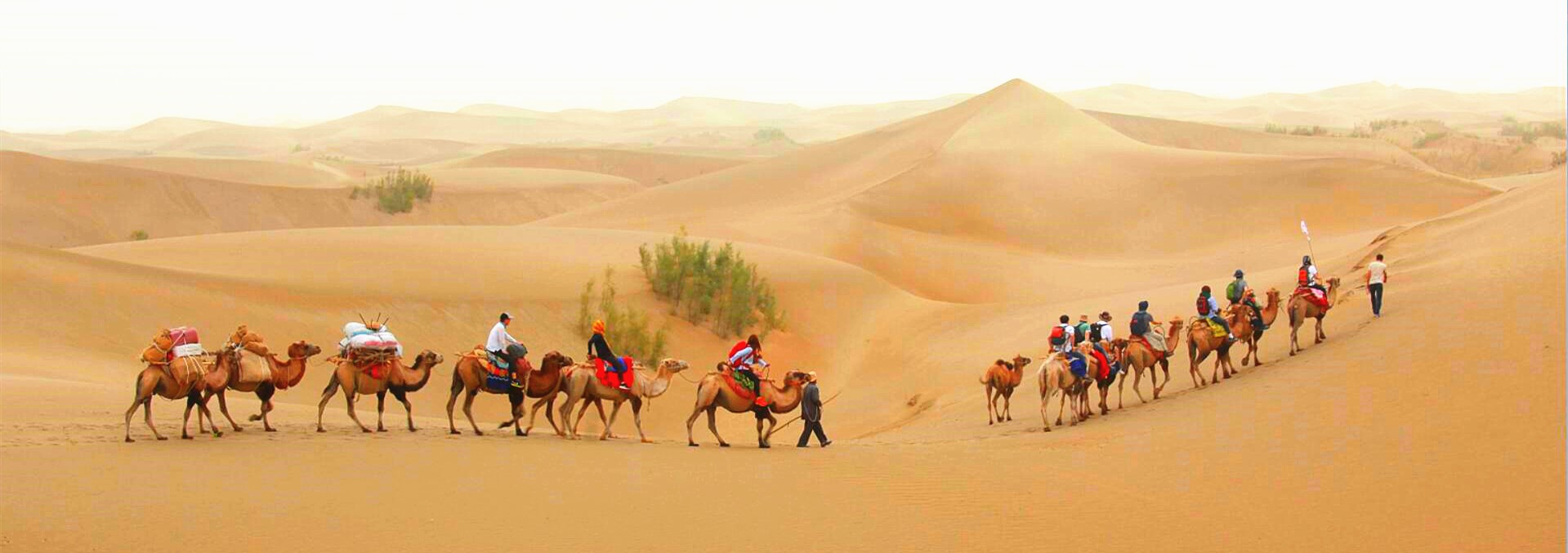
Silk Road Travel Guide
Silk Road , known as the "Friendship Canal", based upon the silk trade between the West and the East, is still prosperous now, ever extended for thousands of miles and passed 2000-odd years.
In September 2013, Chinese President Xi Jinping proposed the strategic concept to promote building the 21st Century Maritime Silk Road and advance opening up and development under the Belt and Road Initiative . On March 28, 2015, the national development and Reform Commission, the Ministry of foreign affairs, and the Ministry of Commerce jointly issued the vision and action to promote the joint construction of the Silk Road Economic Belt and the 21st century Maritime Silk Road.
This ancient trade route traversed more than 20 cities from central and western China, and it has many natural landscapes and historical sites. It's time to pick some destinations and start our journey!
Trading goods on the Silk Road
Before the Ming Dynasty, most of the crops introduced from China originated in Western Asia and the Mediterranean coast, Africa, or India. Most of them were introduced through the "Silk Road" on land. Other luxuries were transported to the west across the Silk Road, including porcelain , fine jewelry , tea , gold , exquisitely carved jade , spices , coral , and ivory . Trade was not just one-way traffic – in the opposite direction, bronze weapons, furs, ceramics, and cinnamon bark were sent China's way from the west.
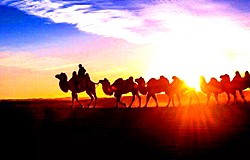
Fun Facts About the Silk Road:
Ancient China built the Great Wall partly to protect trade along the Silk Road from being attacked by nomadic groups. By the year 1453, when the Turkish Ottoman Empire occupied Constantinople, the Silk Road was blocked to prohibit foreign trade. But this urged the exploration of new routes to the orient that bypassed Constantinople, which later led to significant discoveries by famous navigators including Vasco De Gama and Pedro Cabral.
Romans were not direct trading partners with ancient Chinese merchants. In the middle of these two great empires were Persian merchants and other central Asians who played an essential role in bringing the two ancient powers together.
A Life - Time Adventure with Silk Road Travel
Be a traveler or history and culture enthusiast, Silk Road is one of the longest and interesting parts of world history. The trade route joined the world, governments, and people. Learn more with your Silk Road experience. On it, there are many valueble destinations in Northwestern China, which marks the significant influence of ancient times.
It is also a rich cultural journey into the heart of China, and we can provide what you need for a comfortable, enjoyable, and worry-free experience designed to suit you. Our tried and tested itineraries are modifiable. Tell us your interests and requirements, and we will tailor-made your Silk Road Tour
Silk Road Things to do
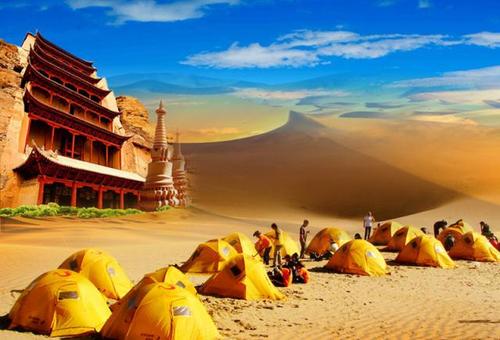
Silk Road Tour Packages and Offers
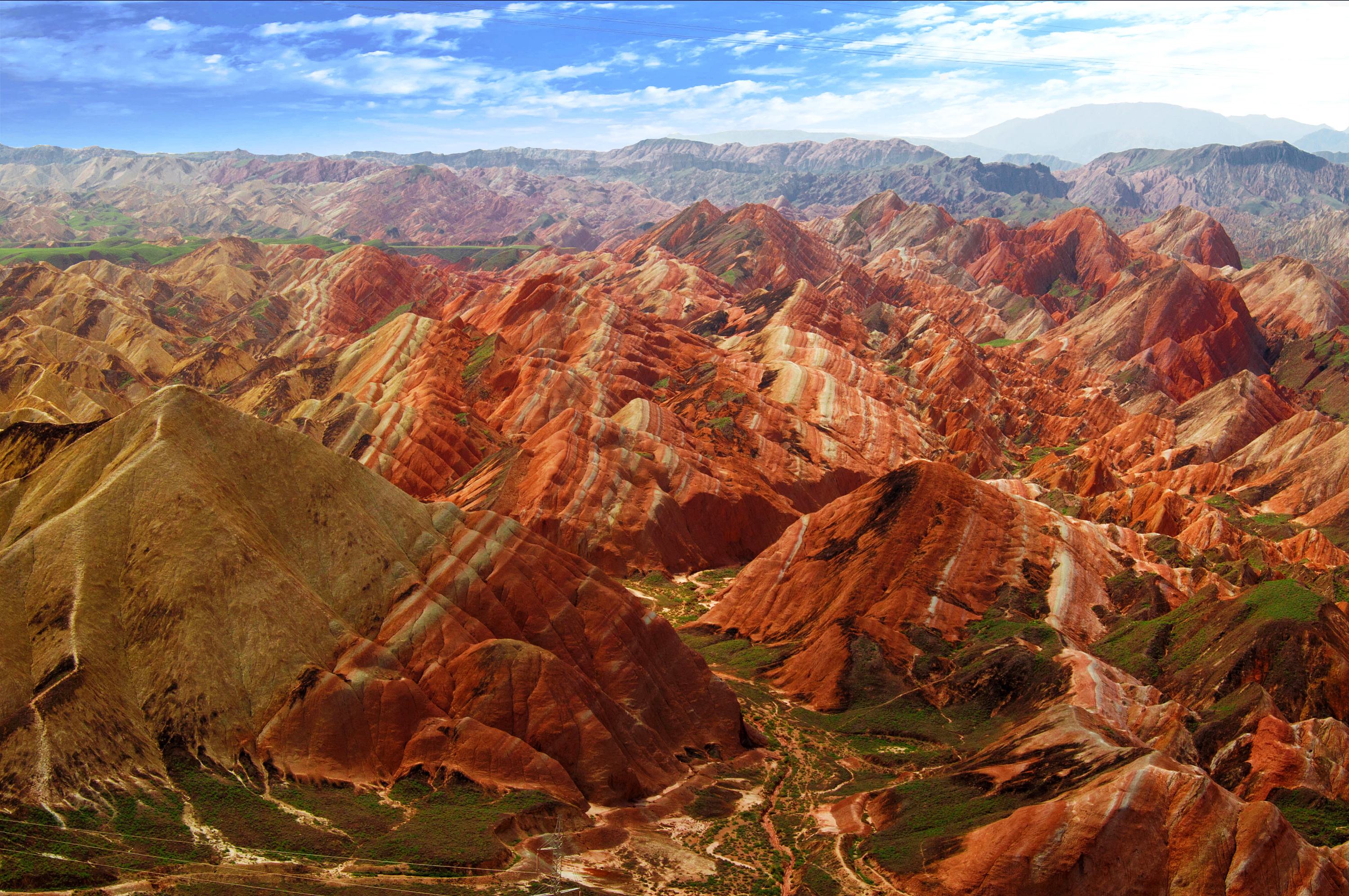
10 Days Silk Road Group Travel to Xinjiang, Gansu & Qinghai
Urumqi - Turpan - Dunhuang - Jiayuguan - Zhangye - Xining - Chaka
$1450 View Details
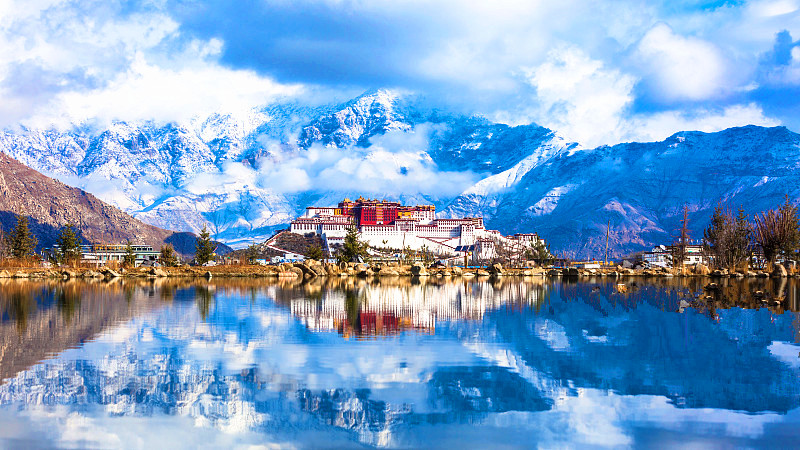
23 Days China Tour to Xinjiang, Silk Road and Tibet
Kashgar - Urumqi - Turpan - Dunhuang - Jiayuguan - Zhangye - Xining - Lhasa - Shigatse
$3650 View Details
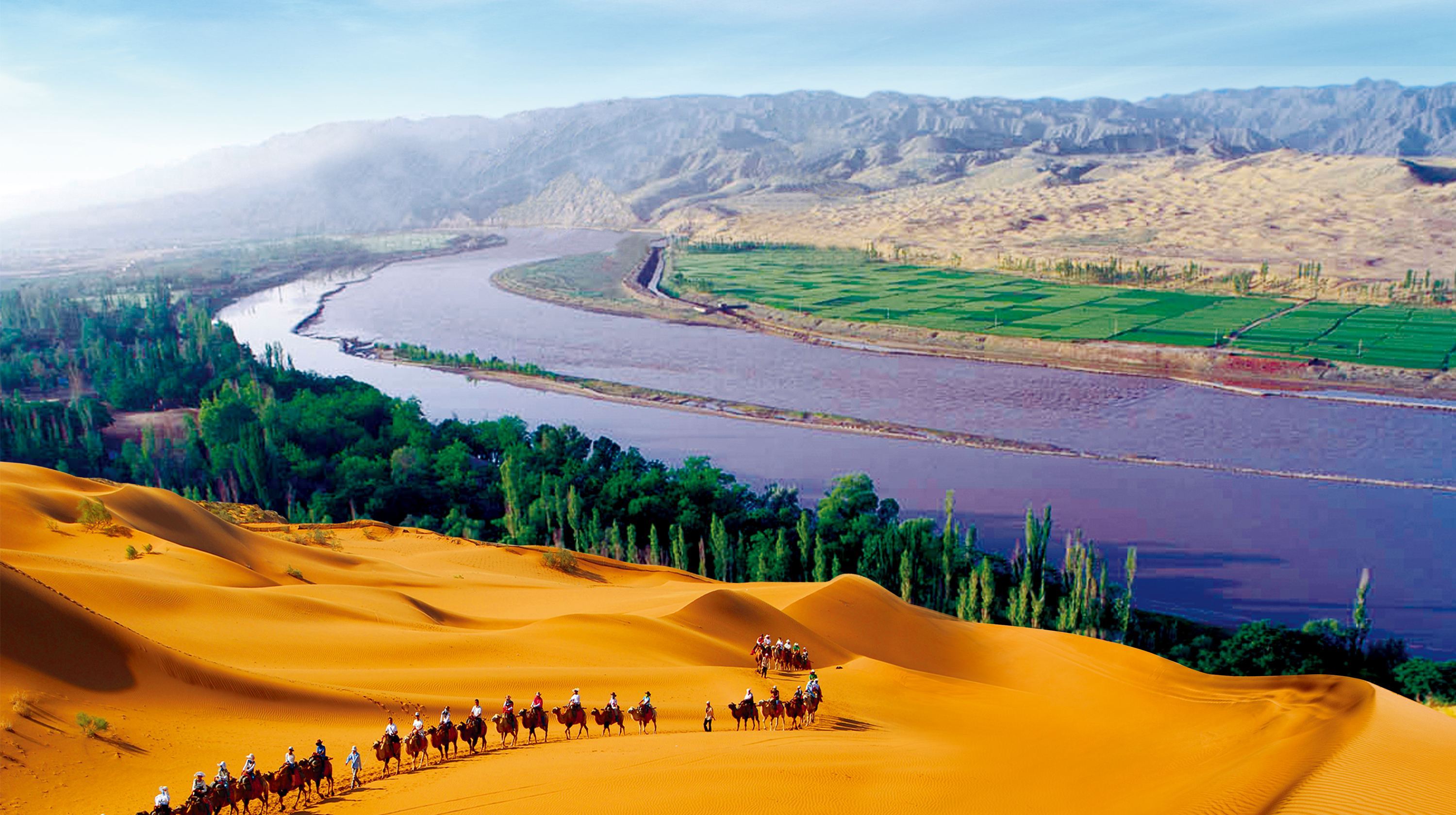
4 Days Ningxia Exploration to Sand Lake, Western Xia Mausoleum and Yellow River Grand Canyon
Yinchuan-Qingtongxia-Zhongwei
$ View Details
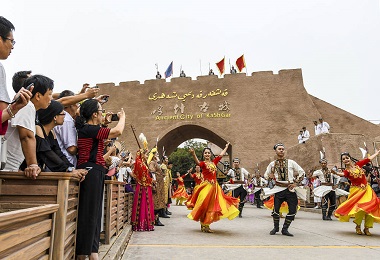
13 Days Silk Road Group Tour: Xinjiang, Gansu, Qinghai
Kashgar - Urumqi - Turpan - Dunhuang - Jiayuguan - Zhangye - Xining - Chaka
$2070 View Details
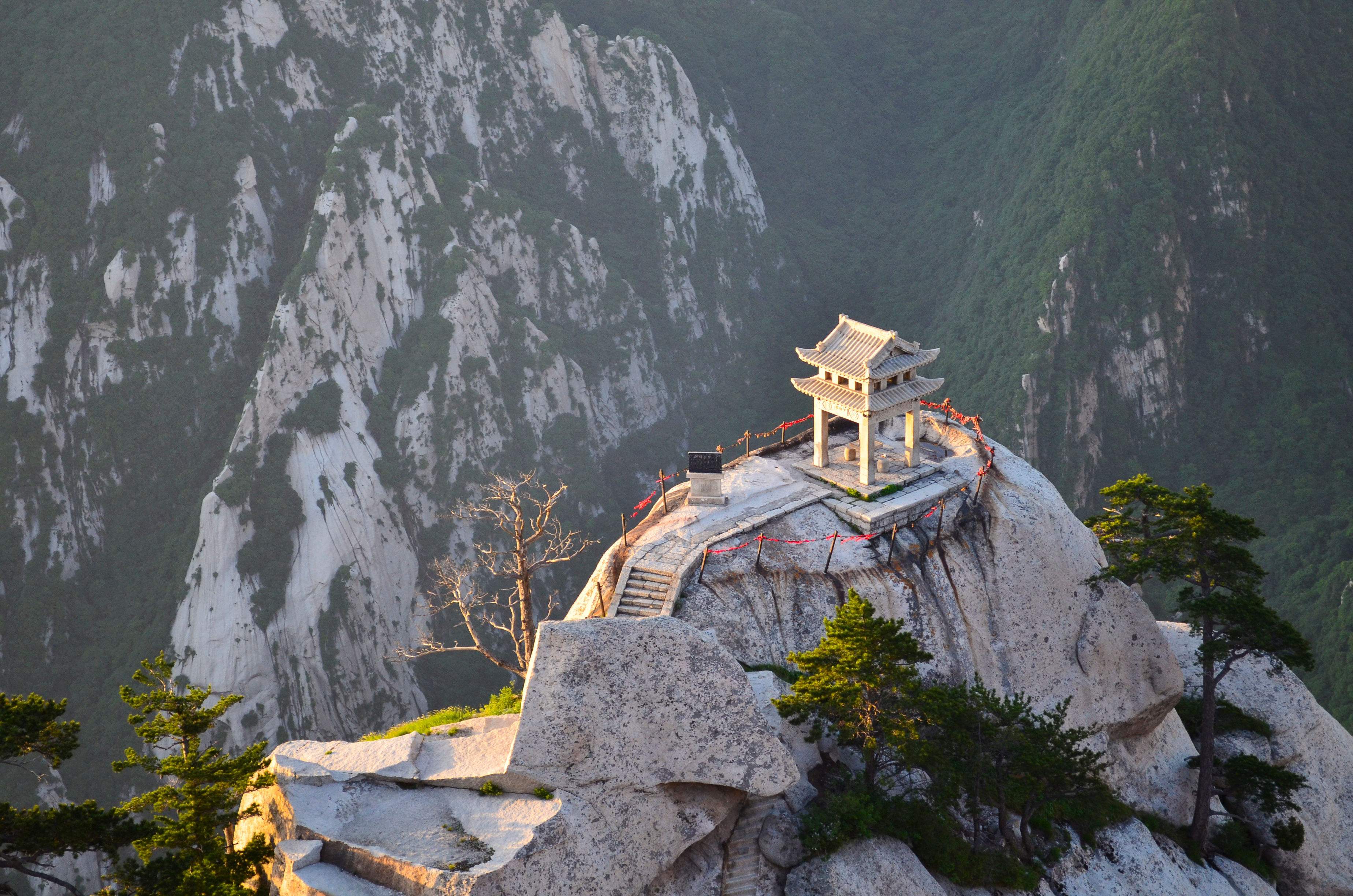
10 Days Silk Road Tour from Kashgar to Xi'an
Xi'an-Kashgar-Urumqi-Turpan-Dunhuang
$2400 View Details
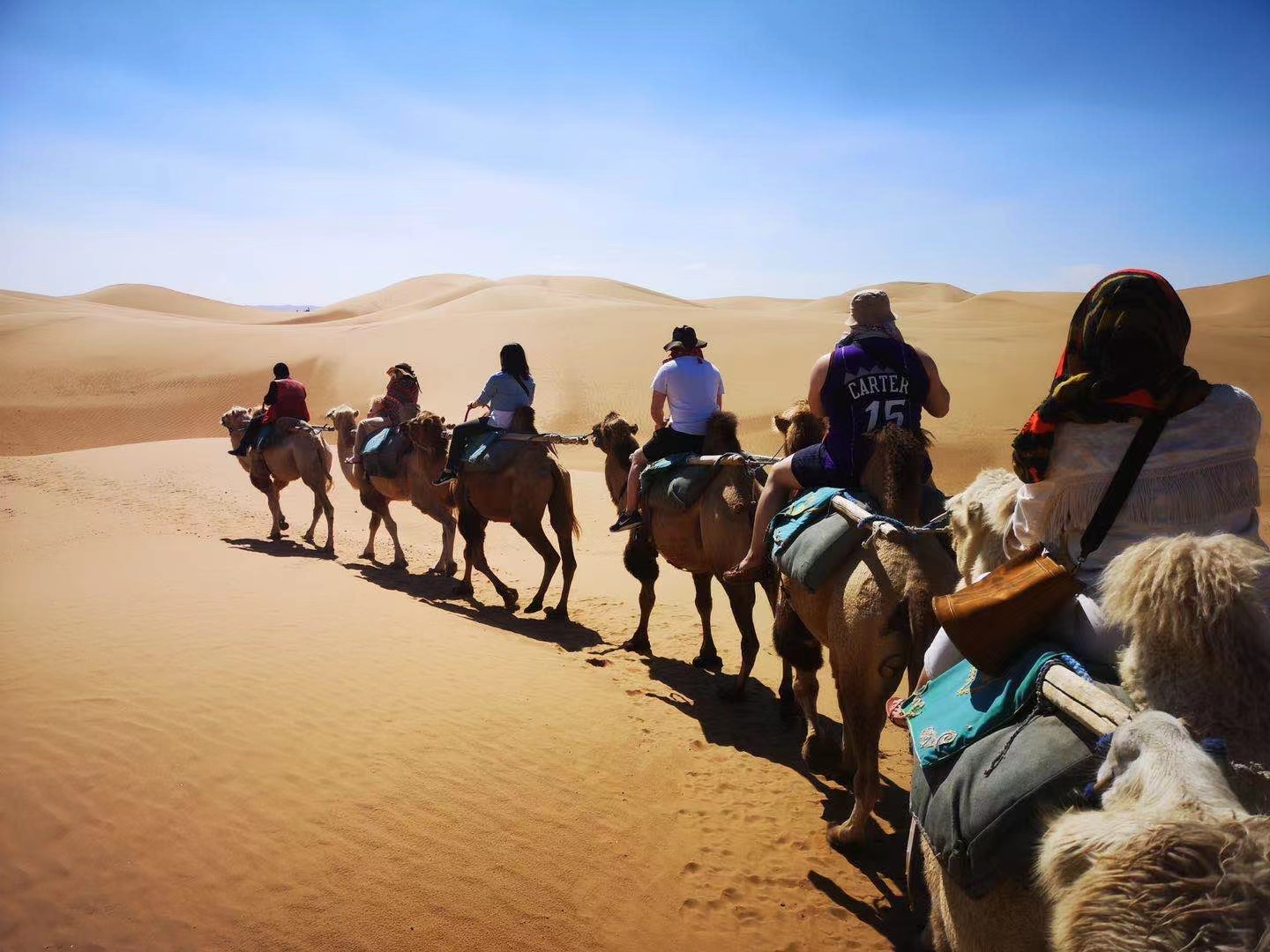
26 Days Silk Road Tour to Xi'an, Gansu and Xinjiang by Luxurious Coach
Xi'an-Tianshui-Wuwei-Zhangye-Jiayuguan-Dunhuang-Hami-Turpan-Kuqa-Alaer-Hotan-Kashgar-Taxkorgan
$6590 View Details
Silk Road Travel Tips
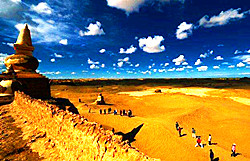
- Silk Road Attraction
- Silk Road Hotel
- How Did the Silk Road Get Its Name?
- Silk Road History
- Silk Road Maps
- Silk Road Tour from Singapore
- Silk Road Cuisine
- Best Time to Visit Silk Road China
- Silk Road Camping
- Silk Road Travel with Kids
Tailor Your Own Silk Road Tour within 24hrs
- 24/7 Customer Service
- No Shopping
- No Hidden Charges
- 99% Excellent Services
Quick Inquiry
Info enteriies.

Our Clients Travel Stories
- Stuart’s Travel blog
- Malaysian Group North Silk Road Story
- Liz’s Great Silk Road Blog
- Elsa’s Xinjiang Silk Road Blog
- Singapore Group South Silk Road Story

- Email: [email protected]
- TEL: +86 135 6583 4056

7 Amazing Stops To Experience Along The Silk Road
T he Silk Road is a legendary but very real 4,000-mile-plus-long trade route that connected Europe with China in a quest to not only buy silk but also shift plenty of other merchandise, such as spices and natural resources, along the way. Made up of many separate roads, including water routes across the Mediterranean from Venice or the Frankincense route from Oman, it used to take months and years to travel along the route. As a result, many cities and centers of learning sprang up along the way to help further the exchange, not only of goods but also knowledge.
I have been fascinated with the Silk Road ever since I read William Dalrymple’s In Xanadu: A Quest decades ago. But to travel along the many routes is not only extremely time-consuming but also a logistical nightmare due to conflicts, borders, difficulties obtaining visas, and a lack of connecting flights. So, instead, I bought a huge map and started to take shorter travels to some of the cities along the way, connecting the dots as I go.
I still have many places to see, some already booked, such as Samarkand, Bukhara, and Khiva in Uzbekistan later this year. Others are still in the planning stages, such as Bishkek in Kyrgyzstan, Xi’an in China, and the constant dream about visiting Iran one day. So, watch out for part II of this story.
In the meantime, here are some fabulous cities I have discovered so far — all offering a Silk Road connection and many legendary sights to see.
1. Istanbul, Turkiye
Istanbul , or Constantinople as it was then, was the official endpoint of the Silk Road, but I started my quest from Europe, so to me, Istanbul is the gateway to Asia and the Silk Road. Old Constantinople was not only the connection to the Mediterranean and Black Sea but it was a rich center of learning and a bustling trade hub. To get a feeling for what it must have been like in the Silk Road days, head straight to the Grand Bazaar and the Spice Bazaar, which opened in the mid-1400s. This was admittedly toward the end of the heyday of the ancient Silk Road, but it still would have welcomed traders from far away.
Pro Tip: The Silk Road then moved inland through the modern-day capital of Ankara toward the Caspian Sea, with many exciting stops along the way. To really get a feeling for the importance of the Silk Road in Turkiye, book a 10-day tour to find out more and stop in caravanserais along the way. ( Caravanserais were roadside inns along the Silk Road for passing traders and travelers.)
2. Yerevan, Armenia
The capital of Armenia, Yerevan is not only one of the oldest inhabited cities on Earth but also a city that offers both ancient history and modern art, culture, and tradition as well as a palatable joie de vivre with cafés and terraces on every street. The best place to start your visit is at the Cascade Complex, a set of stairs leading from the sculpture park below, up 572 steps to a view across the city. With the mountains of Great Ararat and Little Ararat on the horizon, the Ararat Valley is also a major route through the region. Note that within the Cafesjian Arts Centre on the left of the steps is a series of escalators that save your legs on the way up. (I just wish I had found them before I climbed to the top!) The city itself is great to relax in, walk and explore, but it is also a perfect base for day trips to the many monasteries and Silk Road caravanserais located within the countryside. Armenia is a relatively small country, very mountainous, with lakes and valleys, and so much history, all quite easily visited during organized and guided tours .
Pro Tip: You can get a driver to take you from Yerevan all the way to Tbilisi, the next stop below, taking in some sights along the way. It is around a 5-hour drive from capital to capital but very scenic.
3. Tbilisi, Georgia
Tbilisi may not be one of the better-known stops along the main route, but it was an often-used detour to rest weary travel bones in the city’s famous hot springs. The ancient baths along the springs have not changed at all since the Silk Road days. And to get a feeling for where travel-worn merchants would have stayed, head straight to the Tbilisi History Museum . It’s set in an old caravanserai where there were rooms for travelers, spaces and food for camels, and a market spot to trade at while you’re there. Today, the open space not only holds the history and a museum but also, down in the basement, a wine museum complete with a wine bar. And that might well have been another reason to stop off in Tbilisi; the Georgian wine is rather good.
Pro Tip: To keep in with the theme, don’t miss the State Silk Museum to learn more about the material that bore the trade route.
4. Baku, Azerbaijan
On the coast of the Caspian Sea, Azerbaijan’s capital city of Baku offers a superbly preserved look at Silk Road sights as they were when traders stopped to trade spices and cashmere on the way from India. The first stop should be the walled city of Icherisheher, with the Maiden Tower, its mosque, bazaar, and the wonderful Palace of the Shirvanshahs. There are also still many caravanserais dotted throughout the modern city, such as the lovely space around the Zoroastrian Fire Temple .
Pro Tip: To see more of the Land of Fire, where you find burning hills, petroglyphs, and mud volcanoes (all of which must have fascinated the Silk Road travelers even in the old days), book a private tour to Sheki .
5. Almaty, Kazakhstan
The first thing that struck me when arriving in Almaty was the snow-capped mountains that loomed on the horizon. They must have offered a mighty challenge to ancient merchants. Traveling through these mountain ranges hundreds, if not thousands, of years ago on camel or horseback must have been daunting. But they came and stayed a while in the green valleys around Almaty, probably gorging themselves on the plentiful apples that originate here. Here, there were craftsmen who mended armor and riding gear, and apparently, the jewelry trade was very popular. Something nice to bring back home after years on the road, I guess.
Pro Tip: Kazakhstan is a vast country and Almaty only offers a tiny glimpse. So, why not search out more Silk Road sights on a 4-day tour ?
6. Fatehpur Sikri, India
Fatehpur Sikri — the City of Victory in the State of Uttar Pradesh’s Agra District in northern India — is often simply visited because it is close (ish) to the Taj Mahal . When I first visited this abandoned city years ago, I had no idea that it had a Silk Road connection. So, when I was putting pins into my Silk Road map, I was utterly delighted that I had stopped there.
Built in 1571 as the capital of the Mughal Empire, Fatehpur Sikri soon became a trading post for passing Silk Road routes because of the Mughal emperor’s patronage of the arts, crafts, and the court’s love of luxury goods, including silk. Abandoned by its emperor Akbar in 1585, Fatehpur remained a trading hub and center of craftsmanship. It still had one of India’s largest mosques and was a center of learning and religion. The city remained an important stop along the northern routes, so much so that in 1803, the trading giant East India Company settled there until 1850.
Pro Tip: When you find yourself in northern India, you will undoubtedly visit the Taj Mahal. Combine your trip with a visit to Fatehpur Sikri to marvel at this great abandoned city.
7. Beijing, China
While in ancient times, Xi’an was the last — or first — stop along the Silk Road, when the failing trade along the routes was restarted under Mongol rule in the 14th and 15th centuries, the route was expanded through China to eventually have Beijing as its starting point, or terminus. But even before then, intrepid merchant Marco Polo visited Beijing, or as it was then called, Dadu, the Great Capital, in the late 1200s. Giving you an idea of quite how long the Silk Road has been in operation, Marco Polo would have been in Beijing more than 100 years before the Forbidden City was even designed. But what he would have seen is the Pagoda of the Tianning Temple , the Great Wall of China, and, of course, the Marco Polo Bridge, which dates to 1189.
Pro Tip: Read The Travels of Marco Polo , but do it with a huge pinch of salt, as he is known to have made things up as he went. He was also not necessarily a good writer, but just the thought that he wrote those diary entries around the turn of the 13th century, and many of the sights he describes are still there, is quite mind-blowing.
This article originally appeared on TravelAwaits
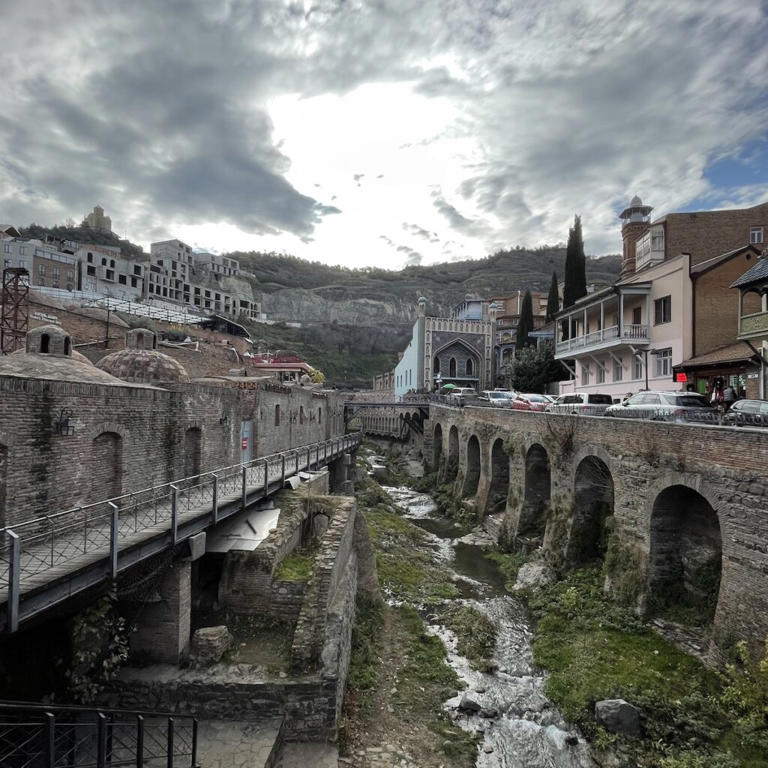
Orange Wayfarer
Culturally Immersive & Responsible Travel
Ultimate Guide to Plan a Trip to Old Silk Route, Zuluk: The Best Kept Secret of Sikkim
About this blog : Old Silk Road Tour in Sikkim is a prized road trip experience. Traversing the high passes of Sikkim Himalayas that touch the sky at 14,000 feet high, the Old Silk Road Tour takes you to Zuluk, and further if weather permits. In this blog post, we would sketch the entire road trip plan, with a tentative cost of traveling to Zuluk, places to stop for the night on the old silk road map, and practical travel tips. For viewing pleasure, you can watch my YouTube series on Sikkim travel as well!
Pin this post for later use!
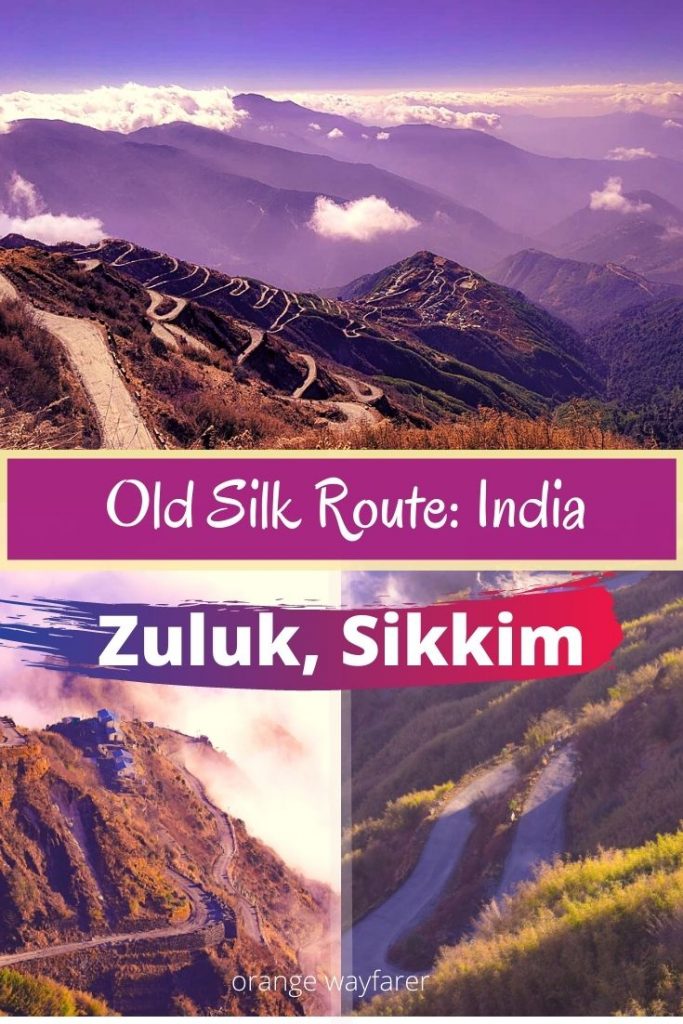
Falling in Love with old Silk Route, Sikkim: Why visit Zuluk?
Simply answering this question, we chose to visit old Silk Route of Zuluk for stunning landscape of Himalayas and intense cultural ties with Central Asia with this part of the world that began with the Han Chinese! The hair-pin bends of Zuluk look looked ethereal with a sprinkling of snow during winter months.
The Old Silk Route Tour invokes memories of days bygone, when caravan tracts reigned the high passes and arid desert lands connecting the Mediterranean to the orient shrouded in the mist of glitters and opulence. We are talking about days from the second century BC.

Gone are the days of ancient history when the arduous road brought in fortune for traders in this part of the world. Old Silk Route in Sikkim lies dangerously close to the Indo-Sino international border which may turn into unspeakable mayhem at the turn of the day! A mellow memory of Tibet covers the land with a mist. Ancient history confronts modern politics eye to eye as incredible abundance of nature prepares the battle field!
If you have been in awe of the mighty Sleeping Buddha even once, the Old Silk Route would take your breath away! The mountain stands in close guard at the bend of every road! It is quite an adventure to cross each of the multiple hairpin bends on the old Silk Route. But once you do, you will be rewarded with an elusive view of the Sleeping Buddha. there, just there.. a little further up the road and you can touch her magnificence!
The Old Silk Route is an obscure remote land where not many tourist crowd has reached till date. To a large extend, you can find yourself alone, amidst some of the tallest ranges of the mountains of the world! If you desire to steal a few quiet moments like this from the world, Old Silk Route is where your home is!
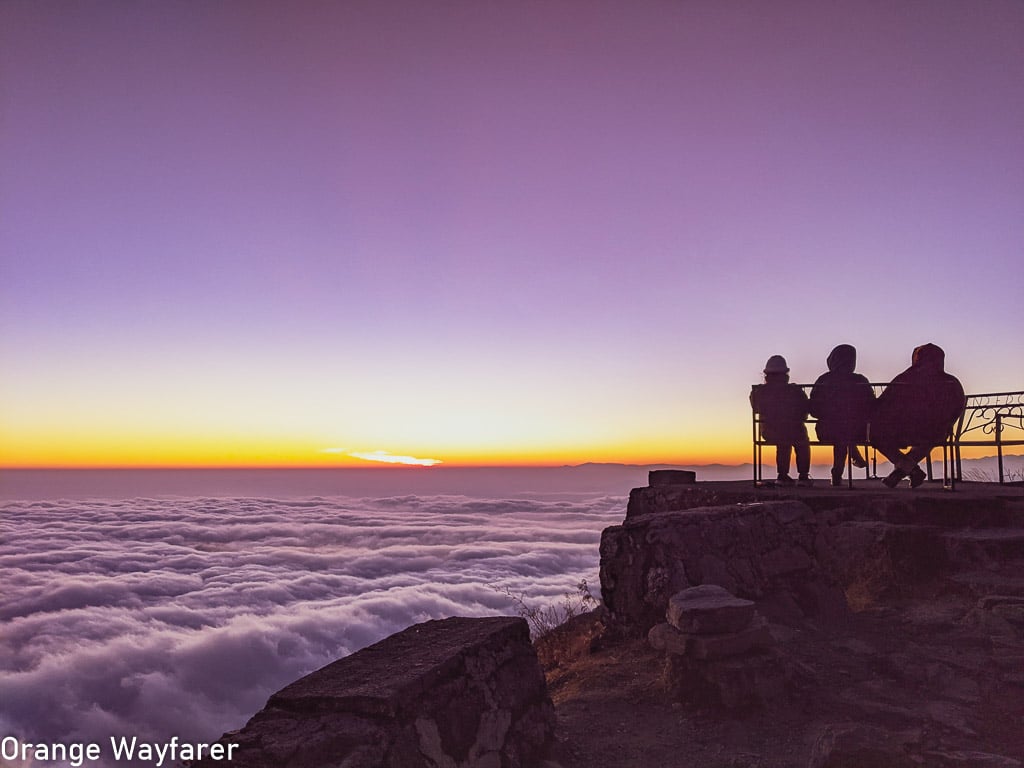
Also read: 20 Stunning pictures from Sikkim travels from December
Suggested 6 days 7 nights Old Silk Route Tour Itinerary
If You plan to return through Gangtok , you can plan a week exploring the Old Silk Route in the following order. This Old Silk Route Itinerary entails the best of the both world, jungles of Terai, verdant valleys and craggy high passes of High Himalayas!
- Day 1: Reach NJP- Proceed to Reshikhola
- Day 2: Reshikhola- Pedong
- Day 3: Start for Aritar
- Day 4: Ascend to Zuluk with permit from Rongli. Sunset at Thambi View Point
- Day 5: Visit Nathang and head back to Thambi view point for another sunset. Stay at Lungthung if you are comfortable with the cold and limited amenities. You may choose to stay at Nathang valley as well. If you can brave the cold, omit Reshikhola from the plan and start from Aritar with an extra day allocated at Nathang Valley.
- Day 6: Return to Gangtok with a stop at Tsomgo Lake (Changu lake). You may also start early and visit Nathula Pass
- Day 7: Gangtok to NJP/ Bagdogra depending on further travel plan
This is the complete loop of old Silk Route. Nathula is now open for tourists where you may see the clear border between India and China as recognized by the world!
If you do not plan to visit Gangtok to complete the Old Silk Route loop but want to visit till Nathang (this ideally happens if you are visiting during peak winter when the entire stretch of Nathang valley is off limit to tourist) this itinerary can come handy.
- Day 4: Ascend to Zuluk. Sunset at Thambi View Point
- Day 5: Visit Thambi View Point. Stay at Lungthung or Zuluk
- Day 6: Descend to Sillery gaon. Visit Ramitey for a beautiful view of Mt Kanchenjunga!
- Day 7: Gangtok to NJP/ Bagdogra
Please note, this trip can be made reverse way as well, like starting from Gangtok. Do this if you are visiting North Sikkim first. However, weather has to be clear to be able to “do it all!” It makes sense to ascend to Zuluk from Bagdogra or NJP first as you would be making shorter trip to Aritar compared to Gangtok.
If time is not an issue, this is how the route actually looks like: NJP/ Bagdogra –> Icchey Gaon –> Sillery Gaon (trek to Ramitey) –> Kaagey –> Pedong –> Reshi Khola –> Mankhim (Aritar) –> Rangli check point –> Lingtum check point –> Padamchen (8000 ft) –> Zuluk (9000 ft) –> Thambi View Point (11200 ft)–> Lungthung View Point–> Nathang valley (13,700 ft & many things to do here)–> Old Baba Mandir –> New Baba Mandir –> Nathula Pass –> Tsomgo Lake (12700 ft) –> Gangtok
As of now Sikkim does not have any railway but works are in progress to establish a railway route for faster movement of troops and then locals and then the tourists!
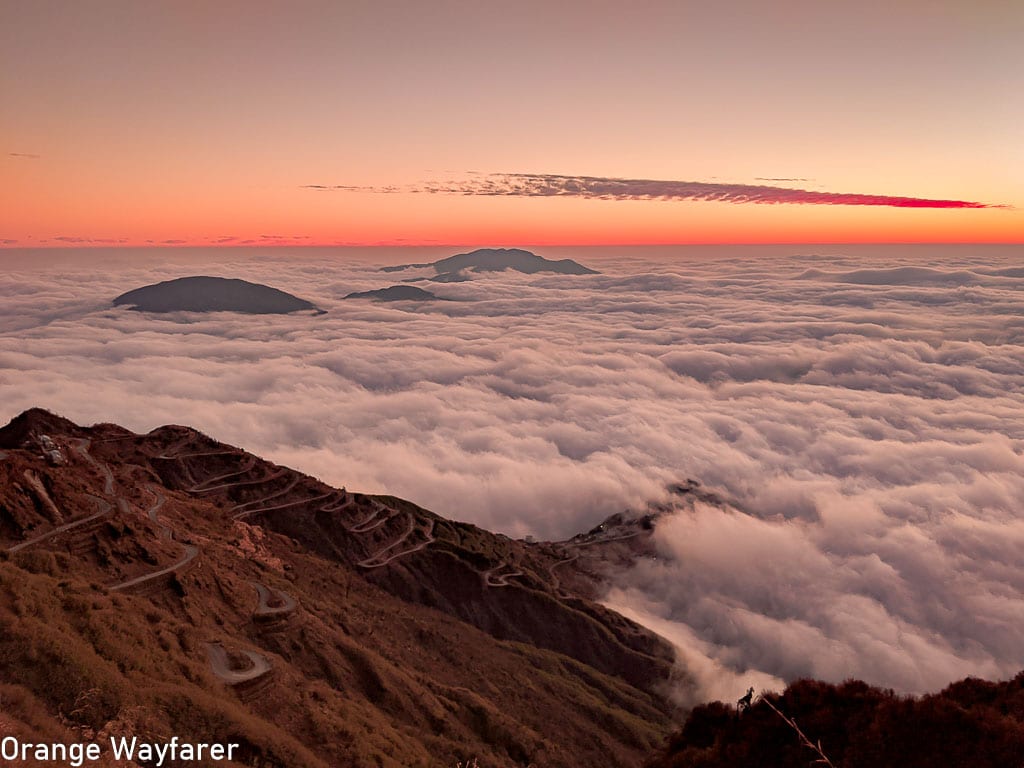
Also read : Offbeat day trips from Leh, a complete itinerary for 5 days!
Things to know before planning a trip to the Old Silk Route, Sikkim
Being one of the remote and obscure places tucked away in the Himalayas, you need to keep in mind few practical travel tips to visit the old Silk Route. This ranges from permits to safety tips to planning an effective itinerary etc.
Permit for Old Silk Route
You need to rent a local car to drive through the entire stretch of Old Silk Route. It is possible to take your own car but that entails a prolonged paperwork and a slurry of permits sanctioned by government officials.
Instead, we chose to go with a local car rental company. It was a decent experience with a mindful driver who also doubled as a kind photographer at times!
The travel agency would ideally help you get the permit done at Rangli. You also need to pass a check point as you cross the West Bengal and Sikkim border (if you are flying to Bagdogra). For permits, you need to provide a few hundred bucks, two passport sized photographs, your entire route map and recognized ID proof (passport, DL, Aadhar etc) for Indian nationals. Rangli is a nice little town with beautiful forest trails and lovely little doggos!
The permit to Old Silk route comes handy to control the tourist rush to the remote land where infrastructure is limited. Permit is also granted based on weather conditions. If a snow storm is predicted, you may not be allowed to visit Nathang valley or further.
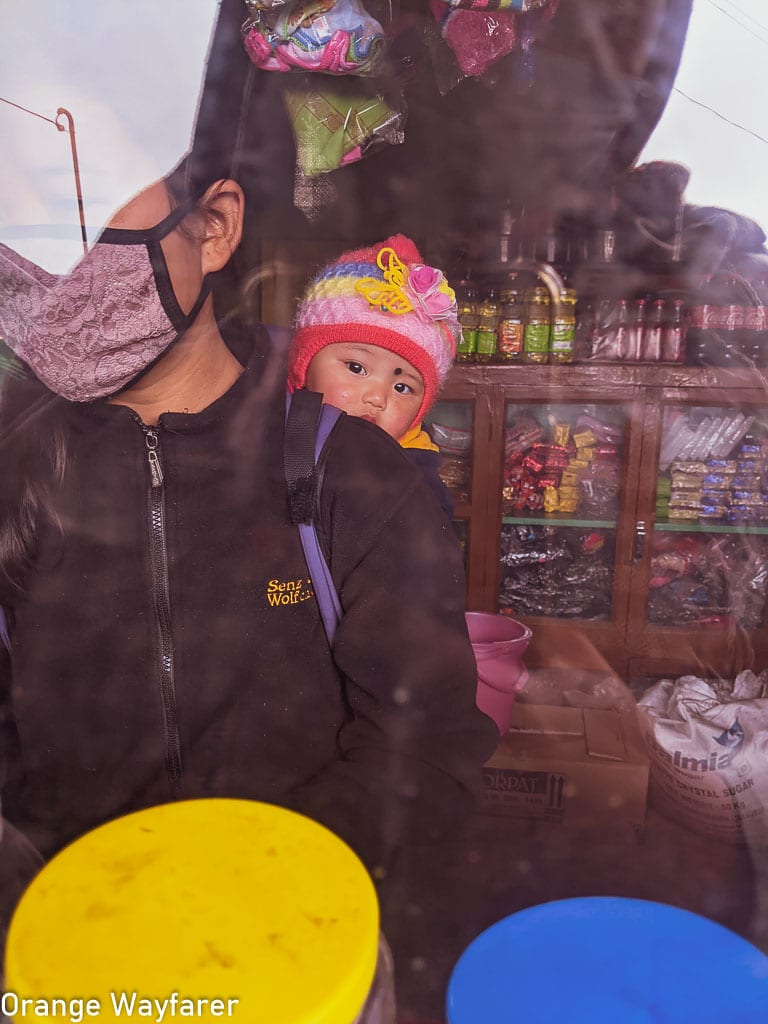
Much like Tawang, traveling to Zuluk requires foreigners to follow a few specific rules.
- One must not be traveling solo. People must travel in a group.
- To apply for PAP (protected area permit), please apply with the tour operators who are registered with the Sikkim Tourism Department.
- Required: passport, Valid Visa, Passport size photographs, application fees.
- Foreigners’ Registration Office (FRO) is located at Tadong which is 5 kms from MG Marg, Gangtok.
- After India opens up for foreigners, there is a fair chance these rules would be different, especially for traveling to places as remote as Zuluk and old silk route!
Also read : Complete guide to explore Tawang, Arunachal Pradesh
Best time to visit the Old Silk Route
We visited old Silk route from 19 to 25th December and we loved that time. Sun shine washed the valley clean. there were instances of infrequent snow falls. It was extremely cold. but the weather was clear and we had extremely beautiful sunny sky that let us view Kanchenjunga and the entire sleeping Buddha range in prime glory!
Choose a time to visit Silk Route which is dry. The summer months of mid April to Mid June is a good time to visit the old Silk Route with roads blushing in red hue with blooming Rhododendron. Autumn in the mountain starts from late October to early November. Of course it changes with the course of monsoon. Wait till the monsoon has completely faded and then venture into the deep of the mountain. Ideally, till mid-January, you can safely plan a visit to Old Silk route and make it till Nathang valley. With increased snow fall, this route eventually closes down for tourists from February.
Check out: Sikkim Travel packages

Cost of a 6 days 5 night trip to Old Silk Route
Prices start from 30 thousand for an Innova for a 5 days trip to the mountains. With oscillating fuel price, vehicle prices change too. You need at least 4 nights to see the Old silk route properly. The more the merrier!
Prices for homestays starts from 2000 rs per night. Of course it varies with demand and supply model. Overall, for a 5 days trip to the Old silk route with a private vehicle, you should have an estimated cost of INR 40,000 which includes a vehicle with a driver, homestays with food and permits. If the vehicle is shared, prices drop down drastically. Shared vehicles are available from Gangtok for Old Silk Route.
Places not to miss on the Old Silk Route
Please do not miss Thambi View Point, especially a sunset from this place. You must pay a visit to Nathang valley and see the milk white ranges of Sleeping Buddha rising atop the arid valley. I absolutely loved the silence when we were flying on a cable car on top of the Tsomgo Lake. A night stay at Lungthung is a prized experience at the Old Silk Route where the first rays of the sun easily penetrates the glass panes of the windows! Do take a stop at the Elephant lake, among many other glacial lakes on your way back from Zuluk to Gangtok! Words fail to gather praise for such stunning natural wonders!
All the places on the way to Zuluk offer different charms. The greens of Reshikhola (a Terai area) paves way for slightly elevated Aritar where clouds often come down to play with the peaks. The golden brown bush starts welcoming you as you approach Zuluk, all the way to Nathang valley, which is also known as the Ladakh of Sikkim. The dry winters paint these places at high altitude with arid hues while the monsoon yields in beautiful blooms. Talking about spring, the mountains of Sikkim bloom in bright beautiful rhododendrons, which is a site hardly one should miss!
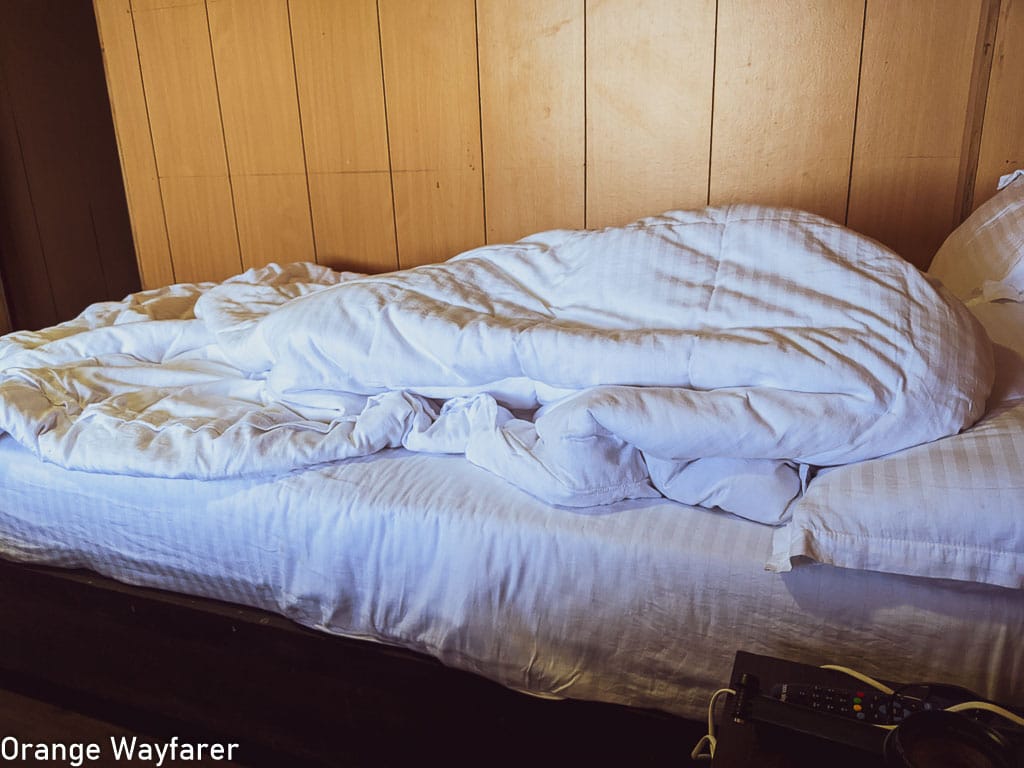
Pro tip for Zuluk trip: If the cold becomes unbearable, ask the locals for a share of their moonshine. It is made of locally produced cherries and works better than brandy! They laughed and declared their children grow up drinking this! I do not doubt. I heard in Siberia they train their children to sleep on the ice!
Also read : Offbeat things to do in Goa, a complete guide!
Packing tips for Old Silk Route
Pack woolens. Enough woolens that you can withstand a night outside at sub zero temperature, braving gutsy winds!
There, I have said it. I have spent long, ice cold nights in Kargil, Ladakh . However, the hotel had basic amenities like a room heater, a centralized one and running water.
No matter which time of the year you plan your trip to the old Silk route, please be advised it is going to be lethally cold!
Especially the cold winds and the long lightless nights are going to be trying unless you are prepared to battle the cold. No matter what the weather prediction is, always carry enough woollens to fight bitter cold. Please carry the following in your luggage while packing for Old Silk Route:
- Comforters for legs
- Enough layers, with jackets and sweaters)
- Thermals (this is going to save your life)
- A woolen cap that covers your ears
- Sunglass (sun reflects harshly on the ice banks)
- Socks with extra pairs in case one gets wet in the snow
- Gloves (with backup pair)
- Shoe that can withstand melting snow and with great grip to help you with small hikes
- A thermal flask to carry lukewarm water to keep you hydrated
- Portable Oxygen Cylinder (in case of breathing trouble this will be of immense help)
Carry cash with you since there is no AT along the way to Old Silk Route!
There is an absolute shortage of cash procurement, not just on the way to Zuluk through Old Silk Route but from Siliguri itself, especially during peak travel seasons, say Durga Puja and likes. Please withdraw enough cash in time to complete the trip.
I wore a saree and a shawl on top and walked under beautiful sunshine. It all went fine until winds started to blow and sent chills to my bones. Always layer up. I can not put enough emphasize on this. Do not forget to drink water as well.
The owner of my homestay offered me melted yak butter that keeps the locals warm during winter. Apparently, yak butter helps in gouts too.
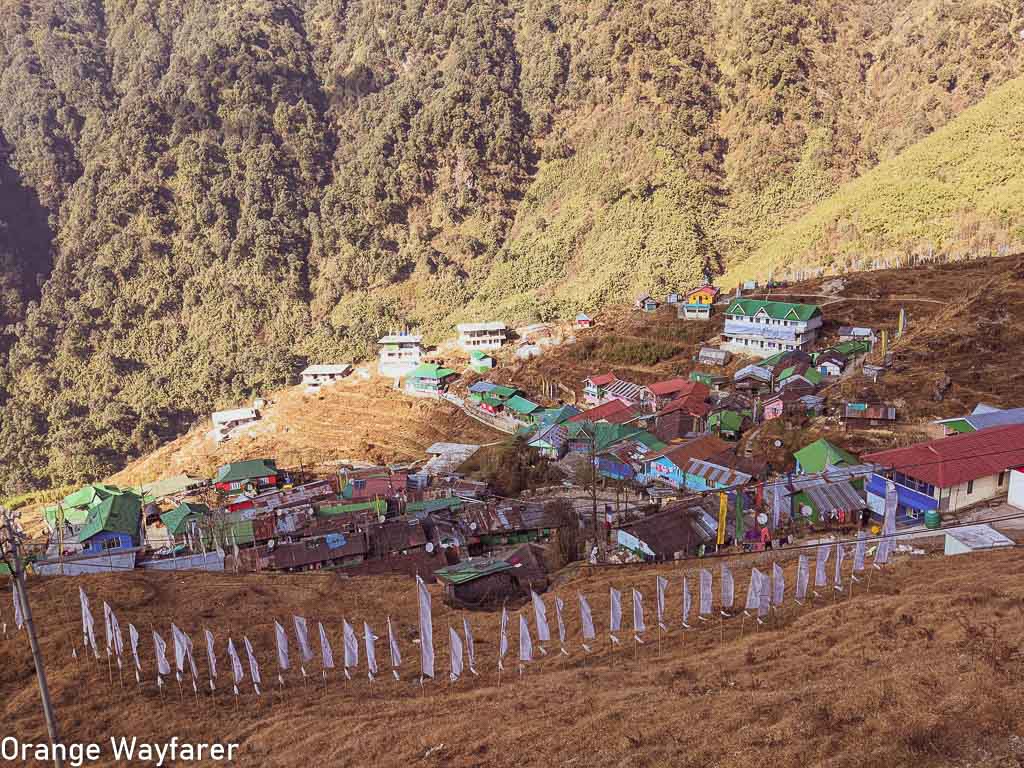
Also read : Complete guide to Bhaktapur, Nepal, an ancient city from the Silk Road!
Food and lodging at the Old Silk Route, Sikkim
Please do not expect café and fancy dining places on the old Silk Route. It remains an offbeat destination frequented by mostly tourists from West Bengal.
Food is served by the homestays. they serve three meals and you may include that in your package. If you are planning to get ready to eat stuff, it might be a challenge to find warm water at Zuluk and areas further to that due to insufficient fuel.
Food is basic and suitable for vegetarians as well. For non vegetarians meals include chicken (for dinner) and egg curry (for lunch). The curries are fiery hot and can be had with roti or rice. You may choose to order simple Daal Chawal with bhajis. Save your appetite for the night you reach in Gangtok and head straight to the taste of Tibet for a gala dinner!
Meal prices range from INR 80 to INR 200 per person. There are pit stops at places where you may get some Maggi or hot tea, especially near the military camps. Due to Covid, these places were all closed.
The homestays usually serve this in set meals: Maggi or bread toast for breakfast. Anda curry with rice and dal and a sabji (local vegetables) for lunch. Dinner is similar with chicken replacing anda.
We stayed at the following places on our trip to the Old Silk Route Sikkim.
- Aritar: Orange Court Resort
- Zuluk: Snow Lion
- Gangtok: Fern Dzong
- After Zuluk, you may stay at Lungthung homestay (optional) however amenities are really limited.
- If you have to stay in Nathang, try to book Dafter Bungalow.
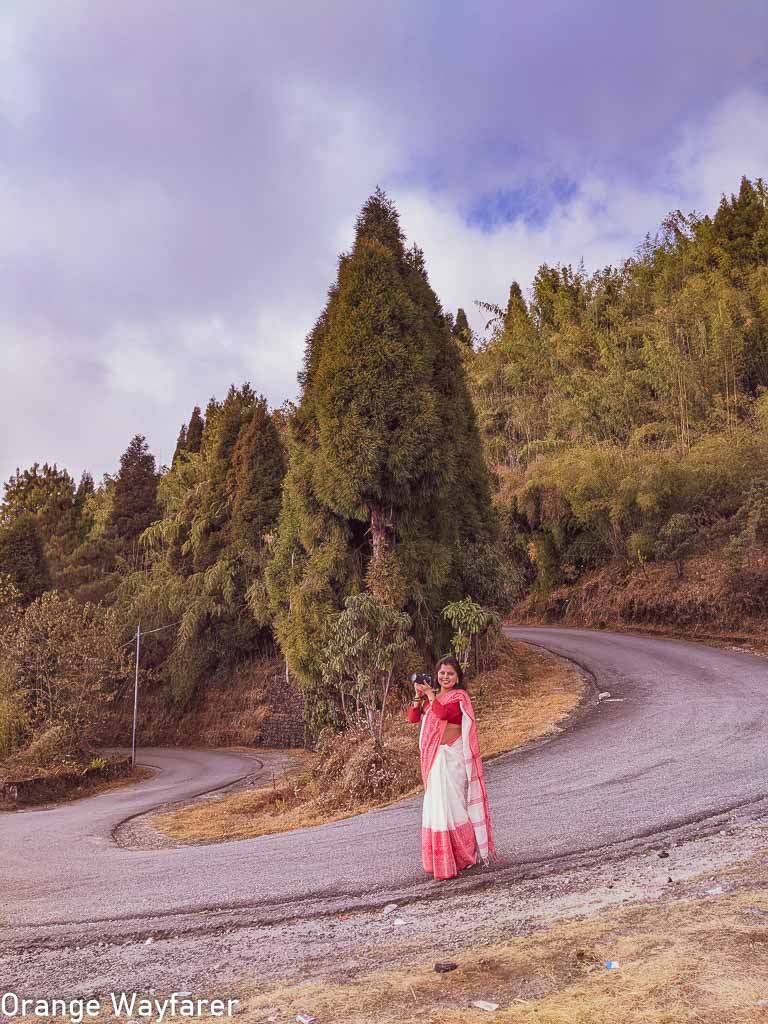
Also read : Best places to shop sarees in Kolkata
Trip to Zuluk: How We Completed the Old Silk Road Loop from New Jalpaiguri to Gangtok
To visit the Old Silk Route in Zuluk, I started from Kolkata and S decided to join me from Bangalore. I took the night train to NJP station (New Jalpaiguri Station). The journey to Old Silk Road would span for next 4 days at least. It would take us to some of the most astounding heights of the Himalayan range in the lesser explored North eastern parts of India! Old Silk Route is a part of East Sikkim and straddles the border between India and China!

The night train to New Jalpaiguri Station
In old times, the train, also known as Darjeeling mail, would witness a flurry of over enthusiastic tourists. We were traveling by the end of December. The wind had a hint of ice cold notes. Thanks to the present scare of pandemic looming large, tourist rush was considerably low. Even the ones who were traveling were actually heading towards Darjeeling , the tried and tested hill town of West Bengal which never fails to amaze even when pressed with the charge of over tourism.
I started from Sealdah. Darjeeling mail was renamed as a special train as the Indian Railway was testing with limited locomotive engines in a post lock down world. We were not given any blankets. Food vendors were not to be seen anywhere close by. I bought a bed sheet for INR 80 from Behala hawker’s corner and decided to use it for the train journey. I was empowered with liters of hand sanitizers and packed food. I try to minimize water intake on the train just so that I do not have to frequent the washroom. However, the night train to Darjeeling had a surprisingly clean wash room. It was a new train, a new world!
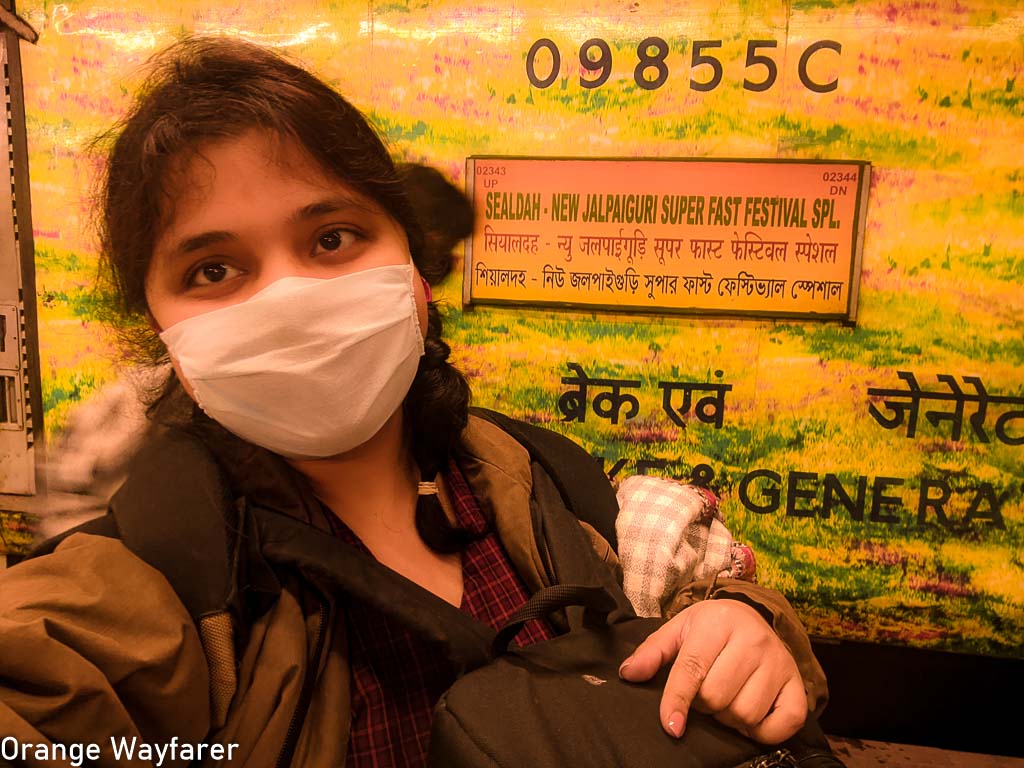
Also read : Complete Guide to Explore Shillong for a week !
Sleeping in a locomotive comes easy to me. I wish I could measure the deep sleep time in all my train journeys.
I woke up to find myself racing amid a scenic stretch of green valley. Paddy fields gently nodding. Silhouettes of towering mountains adorned the sky at a distance! Sunrays awashed the valley in golden hues. I looked out from the window and a cold breeze numbed my ear lobes. Promptly I put my head back and wrapped it with woollens. This is winter in the North. This is going to be an adventure!
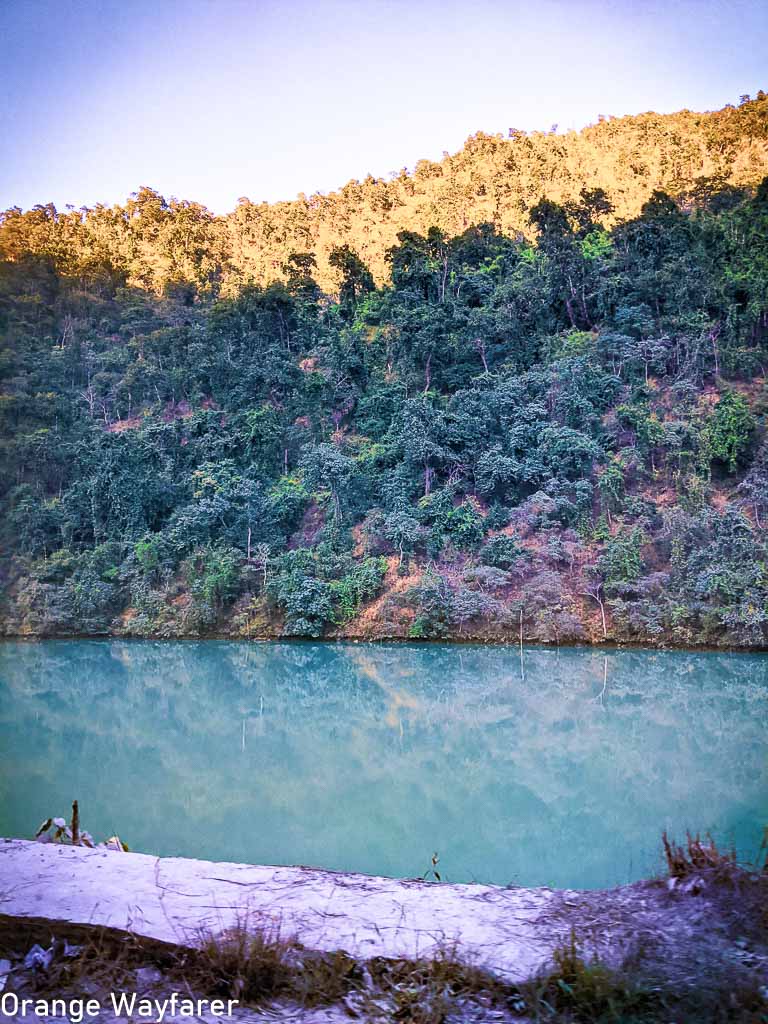
All I could hope for was for the roads on silk route to remain bereft of snow to ensure a smooth journey. I was eagerly waiting to experience all the thrills, the hair pin bends, the Jjilipi viewpoints, the entire range of magnificent Sleeping Buddha, the glacial lakes, the road to Nathula where Indo-Sino war ensued in 60s.
At New Jalpaiguri Station, jam-packed crowd welcomed us. The night train from Kolkata to Alipurduar had just left the junction. The station was overwhelmed with wander-lusters and locals alike! I managed to carry my luggage and camera bags to the overhead footbridge and leave the station premises. An old school steam engine is installed outside the station, greeting people with a reminder of the past.
In olden days, New Jalpaiguri was one of the first junctions to be connected to the mainland India. This is where wagons filled with freshly plucked tea leaves passed through. The British further experimented with tea wherever they went, including Mauritius however seldom found a worthy contender to the mountain slopes of Darjeeling!
We had rented a cab from a local Sikkim Taxi rental company. They suggested a pick up from the NJP station itself. I waited for S at the Bagdogra airport for an hour and finished a quick lunch with Fish curry and rice. The curry was fiery hot. I think an ample amount of Dalley chilly (now GI tagged) had been used in the make of that curry! We started for Sikkim by 2 pm.
Also read : Practical tips you need to plan a trip to Egypt!

About Silk Route: The 6400 km Silk Route extended from Xi’an (Sian), followed the Great Wall of China to the northwest, bypassed the Takla Makan Desert, climbed the Pamirs (mountains), crossed Afghanistan, and went on to the Levant. Goods were shipped through the Mediterranean sea. Middlemen of each region helped progressing the caravans. From Europe, the Black Death pandemic moved to Asia through Silk Route! In this blog, we are talking about the Old Silk Route, a part of the ancient Silk Route.
The Ascend to Aritar and an unprecedented delay
NJP to Aritar: 110 km (time took 7 hours)
We were heading to Aritar for the night. I have already told you the routes you can take as you ascend to the Old Silk Route of Zuluk. If I could start at dawn, I would have gone to Reshikhola village and lived by the beautiful mountain stream of Reshikhola. The pictures reminded me of Jia Bharali river of Bhalukpong as we were visiting Tawang in Arunachal Pradesh .
Reshikhola is famous for Birding opportunities, especially in the winters. All the Terai forestlands are spectacular in this aspect. For example, Kaziranga or Manas National Park in Assam or Chitwan National Park in Nepal . All of them are National Parks. To visit Reshikhola, you need to walk for a few hundred meters amidst a jungle.
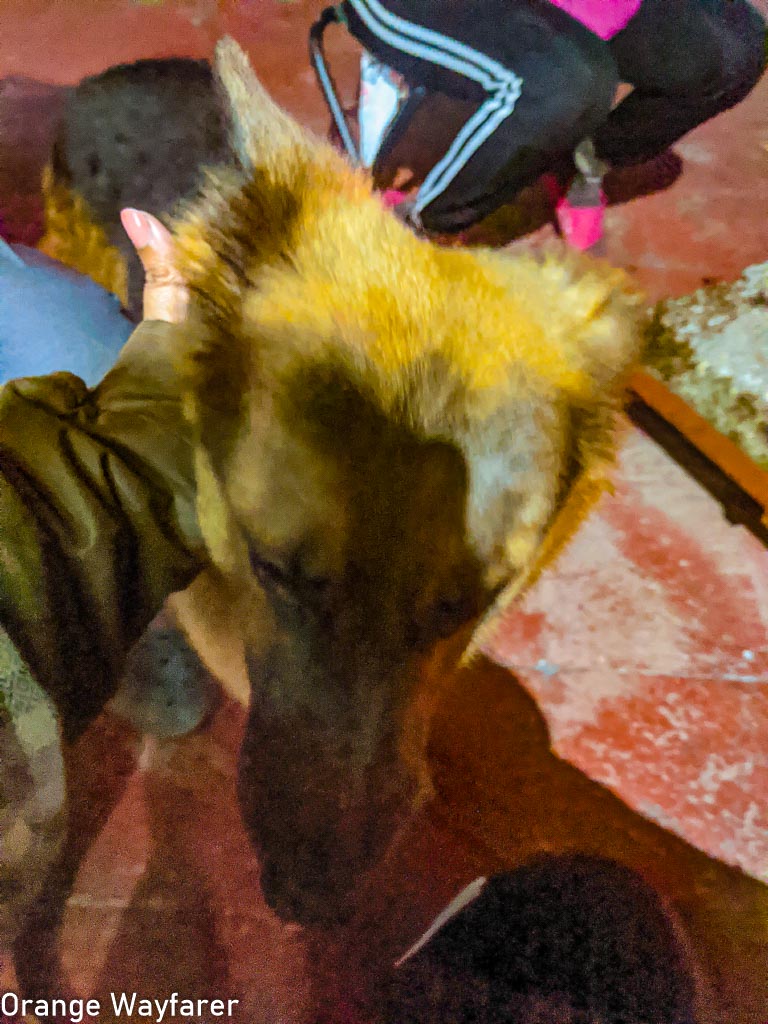
The lake in Aritar is also known as Lampokhari (Pokhri meaning a waterbody in Nepali language) which reflects the lush green surrounding area in its colour! Spend the day visiting Mankhim, the hill top of Aritar for a clear view of Kanchenjunga. We saw it from the road itself, the entire sleeping Buddha range and rushed towards Zuluk with glee.
If you have time, spend a day at Reshikhola
If you stay at Reshikhola , which happens to be a part of West Bengal, or to be more specific, straddles the border between West Bengal and Sikkim, count a day extra to visit Pedong, a small town in Kalimpong. Famous for the old Sangchen Dorjee monastery, Pedong came to be during the reign of British India as their tea factories were buzzing with tonnes of produce. In February, Pedong hosts a fair named Pedong mela where Bhutia and Lepcha tribes from distant villages come with their annual produce. Do not miss that for the world if you love cultural nuances!
In Reshikhola, you can stay at Prakriti Eco Resort. To reach these homestays which use the word resort in the name you have to cross the Reshi river through a wobbly wooden bridge. It may be a bit dicey for the elderly people in the travel group. You may reach Reshikhola from the West Bengal side by crossing a dried up stream during summer months. But monsoon makes the river turn voluminous in the Bengal side.

Also read : Complete Guide to the Best beaches in Goa
Things to do in Aritar: First stop on the way to Old Silk Route
However, we rushed to see Zuluk and decided to spend the first night at Aritar . Besides, our two weeks long Sikkim itinerary had many quaint village stays in Pelling and Temi Tea Garden. We drove past Teesta and Rangeet river confluence, where many people stops for a night to camp. We stopped briefly on the road for momo and tea. By the time we reached Rongpo , the sun had set. It was the proverbial pitch dark night, one in which you can not see your hand in front. Rangpo is a town between Sikkim and West Bengal where the authorities would check for Sikkim Travel Card and other necessary details including permits etc.
Rangpo is an industrial town in Sikkim with many manufacturing units and pharma companies. There was a huge traffic jam in front of the Rangpo check point, the first of many checkpoints where you have to produce your Sikkim travel card. The nightmarish traffic lasted for a couple of hours.
While crossing Rangpo checkpoint, you can pick up alcohol from Lohapool. Alcohol is cheap in Sikkim. I had no clue why until I faced the biting cold of Zuluk!
Aritar is famous for a man-made lake (Aritar lake) . Boating facilities are available here. You may rent a mountain bike and drive past the lake and the small tracts as well. The lake reflected the greens of the surrounding area! Aritar is situated at a height of 4000 feet.
At Aritar, we stayed at the Orange Court Resort . It is a family run homestay. Do not be fooled by the resort tag. Almost all the homestays in this route carry the word resort in their names, whereas in reality they are far from what a real resort looks or feels like. I do not complain. A homestay is the best way to run tourism in the fragile ecology in Sikkim.
The Owner of the Orange County resort sat with us in the evening, treated us to Chicken Pakora as her son and a beautiful German Shepherd Lucy kept us company. I am usually shit scared of dogs but Lucy took my heart away! A German shepherd dog could be so kind, so loving! I would have never believed it unless I would have met Lucy!

Also read : A Photoblog on Zanzibar, the paradise island !
Geeting a permit for Old Silk Route
At Rongli, we stopped the car for about 40 minutes, produced travel card, route plan, government ID and passport sized photographs and procured our permit to visit Silk Route. Weather was permissible and we were told we could take the entire loop from Zuluk to Gangtok with a stop at Nathang Valley. If weather shows alert, the authority would not allow you a permit to visit Nathang valley.
From Aritar we started early in the morning. We finished a hearty breakfast with puri and bhaji and some piping hot tea! The road paved the way to the heights of Himalaya. Myriad shades of greens greeted us on the way. Some of the plants had turned their leaves in blood red hue. A few blood pheasants, state birds of Sikkim stood in alert. We crossed small streams, fountains, villages shaking off from slumber, young kids heading towards school.
The mountain streams in the region are known as Khola in Nepali language. One of the important points is Que Khola Falls before you enter Lintham village. In winter sunshine, plenty of colorful blossoms bloomed by the makeshift tea joints. Wooden bridges covered in Buddhist flags bring down elusive peace of Earth.
We drove past Padamchen , one of the larger habitats of the Old Silk Route at 8000ft. After Aritar, once you have procured your permit, you can only stop at places for which your permit has clear written mentions. For us, Padamchen was not mentioned in the permit and we could not stop even when we wanted to. This is a beautiful destination though, with pleasurable weather all through the year. Padamchen is also a sought after destination among the birders.
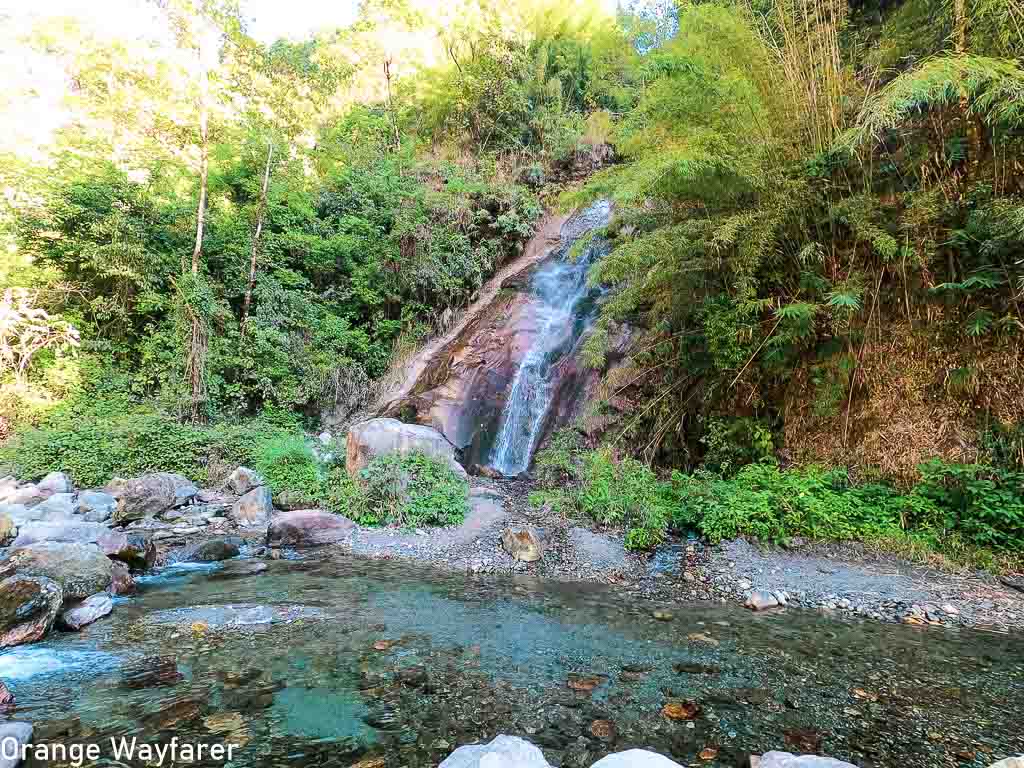
The last marketplace with enough stock is located at Padamchen. At Rangli you may find many shops, serving almost everything from trekking gears to Rosogolla, that too freshly prepared! Stock up with enough snacks. Carry some Korpur and medicines as prescribed by doctors.Please do not carry maggi and stuff that needs to be cooked in boiling water because you may not get the option to boil water in this rough mountain terrain at all! For a geyser to work, you need to switch on power right at 3 am.
Zuluk travel is tough love but it is very very much worth it if you plan it correctly is all I can say!
Also read : Complete travel guide to Hampi, a UNESCO world Heritage Site!
Zuluk, the Star Stuck Mountain Township!
Aritar to Zuluk: 41 km (time took: 3 hours with permit)
In olden times, Zuluk happened to be a small village inhabited by the shepherds and nomads who resided at this high altitude zone in the harsh winter months. Situated at 9000 feet high, Zuluk claims the fold of the mountain, where ice cold northern winds do not find a passage.
A little ahead of Zuluk, serpentine roads take you to Nathang valley that straddles the Indo-Sino border at the Tibetan plateau. The proverbial silk route existing for thousands of years takes one to the forbidden Kingdom of Lhasa, Tibet.
With the presence of the Indian army, Zuluk town developed to be what it is today. The army has established a permanent transit camp at Zuluk. If you drive for 20 minutes uphill from Zuluk, you can see China on the right side. The road takes further turns and reaches Doklam, infamous for the stand off between India and China from 2017. It connects Nathula if you drive straight, another sensitive international border point between the South Asian powerhouses.
Trucks of army personnel are transported to the army camps. They gradually scale a high of 14000 feet and higher. Zuluk town was planned to act as a transit camp to help the men acclimatize at this astounding heights.
The army arranged for a permanent water tank, a luxury in an area where inhabitants are dependent on sunrays to melt the tap water that turns into ice in the dark of the night. The water tank stands atop the mountain, like an alert eye assuring and safeguarding the valley and its inhabitants with an assurance of sustenance.

Also read : 10 Things to know before planning a trip to Darjeeling!
Army now but History came earlier!
The old silk route traversed a large distance of 900 km from Lhasa to Tamralipta. It mapped through Chumbi valley (now the conflict zone, Doklam) between India and Bhutan. Through the ancient trade routes, the Chinese and Tibetans traded silk, textile, livestock, chinaware, tea (read Jormer Chokh by Tillottama Majumdar) and ideas (Sri Atish Dipankara). Geopolitics of the twenty-first century may have stripped away importance from the old silk route but who can predict the course of history?
Thanks to the water supply, Zuluk developed two distinct places of stay. The Upper Zuluk Basti area , with a couple of hotels and a village that grows its own vegetables and manages its own waste with periodic visits to the nearby towns. Upper Zuluk has a military settlement just by the side, hence access to medical assistance (read need based oxygen supply) is a cakewalk here. Network was not available though, unless you are willing to wait by the main road for a while till a Jio signal picks up faint connectivity.
Lower Zuluk Basti is a more crowded area, located a few km ahead of Upper Zuluk and a lower altitude zone. Lower Zuluk has a number of makeshift stay options, cheap homestays and a few grocery stores where local women with babies tied to their back sell toothpaste, maggi and cigarettes.
Lower Zuluk resembled a haphazardly created locality to accommodate tourists. Most of the houses are in shambles. Bright blooms of myriad mountain flowers hanging from earthen hots at the entry of each house comes to rescue, to add hue to a foggy day.
If I were to choose a place to stay in Zuluk, I would opt for upper Zuluk. The homestays range between 2500 to 5000 depending on demand. Food cost is extra. The homestays in lower Zuluk are cheaper alternative stays. However, do not expect luxuries like warm running water or room heater and stuff.
It is imperative to choose a comfortable homestay in Zuluk. Zuluk is going to be one of the highlights of your trip. A few things you need to consider before booking a stay in Zuluk.
- The Homestay in Zuluk should have access to running water.
- The homestay in Zuluk should give you a room heater.
- The homestay in Zuluk should have local networks to provide you medical assistance in case of emergency, think low oxygen level or breathing troubles.
- Please ask your homestay provider if they have power back up. Usually power back ups provide for a faint light after sunset. Nights are long and dark in Zuluk and onwards.

Also read : Complete guide to Chitwan National Park for a first time visitor!
Things to know about traveling to Zuluk
- Many people visit Zuluk, make it a base for the next two days, explore Nathang Valley and then head back to Padamchen and descend to West Bengal. I have already elaborated on this route plan.
- You may stay at Padamchen, if Zuluk seems tough. It may seem a bit tough if you are traveling with a baby or elderly people. The mornings are mellow. The valley is sun washed. However, sunset brings a different world to Zuluk. With cold gutsy winds and pin drop silence, it can be nightmarish.
- I can not emphasize enough on this, but please make sure you start early and reach Zuluk before sundown.
- In case you want to stay at Padamchen, which is located at a lower altitude than Zuluk, please mention that at the time of procuring your permit.

The quirky symmetry of 32 loops of Zuluk, which are part of the ancient 93 hairpin bends through which priceless silk used to be traded from Lhasa to modern day Tamralipto (Tomluk of West Bengal).
In Zuluk, you do not have much to see but a few chortens, a Shiva temple, army barracks.
Also read : Guide to all the Bonedi Barir Durgapuja of Kolkata
Is Zuluk worth Visiting?
Zuluk as a stand alone destination does not have much to offer however you need to visit Zuluk to experience the sheer beauty of high Himalayas that lies ahead at Lungthung and Nathang valley. Also, at 9000 ft height, Zuluk is the safest place to tuck in for the night if you can not stand the severe cold that Nathang Valley will unleash on you!
Zuluk is located at the fold of the mountain. You can not see the Sleeping Buddha range from here. However, you can visit Thambi view point, a 15 minute drive from Zuluk and voila! It is a different world out there!
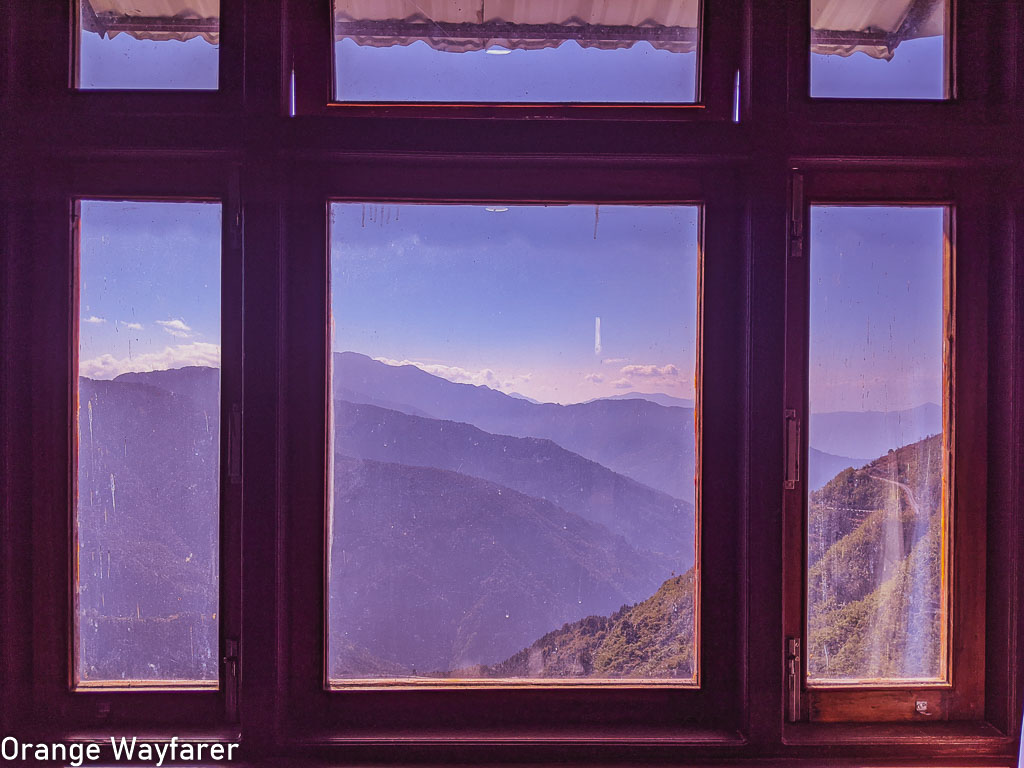
Things to do in Zuluk
- Visit Thambi view point and spend the evening there. It is at the Thambi view point, I had experienced the most ethereal sunset of my entire life. Many people spend the night at Zuluk and start at the crack of dawn to visit Thambi. The first sunrays kiss the peak of the Sleeping Buddha range. Pregnant clouds crowd at the bottom of the mountains. Standing at Thambi, you get to witness a sunrise show of a lifetime! I had seen similar views of sunrise from Switzerland on Instagram!
- From Thambi view point, you will also see the three level zigzag bends of the Old Silk Route. At the start of the day when the clouds are far up on the sky, you will be able to spot Zuluk town from a distance.
- It is only fair to assume you will fall in love with Thambi as you witness the first sunset! You would ideally want to spend the night there to wake up to a magnificent sunrise. For that choose a homestay at Lungthung, a few km ahead of Thambi view point. For a thousand and a few hundred bucks, you may get a room at one of the local run homestays at Lungthung. The homestays have huge glass window pens through which you may get a stunning glimpse of the world outside! In hindsight, Lunthung can be lethally cold at night. Check the window pens and take a call accordingly. Running water is unavailable here. They give you a bucket of water which might get frozen at night. Staying at Lungthung may not be the most cherished memory but waking up to witness that sunrise is going to be a prized experience indeed!
- From Zuluk, you may visit Jelepla Pass, Kupup & Memencho Lake which are on the way to Nathang valley. Many people plan to stay in the Nathang valley. Some choose to stay back at Zuluk and visit Nathang as a day trip. Nathang Valley is situated at an even higher altitude. A handful of homestays are there. You may choose to spend one night at the Nathang valley before heading back to the plains.
Please note, be it sunrise or be it sunset, the look and feel are going to be the same from Thambi view point. thus, if you visit Zuluk on day one and witness sunset, schedule an early sunrise visit and to Thambi again and proceed to Nathang valley. Many people start the descend on day 2 itself however in my honest opinion that is a bit rushed affair. After Zuluk, allow some time to Nathang valley and plan for at least a couple of days at Zuluk if you want to complete the old Silk Route loop and end it at Gangtok. Alternately, you may choose to descend down and spend a night at Sillery gaon or Icche Gaon, quaint little hamlets in the West Bengal Himalayas.

Also read : Guide to Luang Prabang, the UNESCO heritage Temple Town of Laos!
Nathang Valley: A forgotten no-man’s land!
Zuluk to Nathang valley: 23 km (3 hours)
I was spellbound at the Thambi View point and thought this is the high point of the entire Old Silk Route tour until we reached natahng. By the end of December, Fresh snow kissed the pathway as we approached the arid mountain top. A few bends upwards Zuluk, the mighty Sleeping Buddha range presides over the sky!
Nathang is an even more remote spot compared to Zuluk. Once a few yak herders roamed this land. Now the over enthusiastic tourists have started to come and live here, hence few homestays sprung up. Spending a night at Nathang can be roughly compared to that of living under the starry night on a mountain top, while even craggier peaks stand at adistance. Nathang is a valley bordered with towering hills but the real deal is Mt Kanchanjengha!
You may spend a day at natahng and make day trips to the glacial lakes. I suggest visit till the elephant lake, also known as Kupup and return back if you are to descend down. I must mention, you can only visit these routes if you receive permit from the check points. The official order is to issue permits only if the sky is clear for coming days. Otherwise, you might be turned back from Zuluk itself. Fear not since Thambi View Point is a treasure of this part of the Himalaya.
While many chooses to descend down from Nathang valley through Padamchen, and rest a few days at Icchegaon and Sillery Gaon, small quiant village stays in West Bengal, we chose to complete the loop and head for Gangtok.

Also read : Most beautiful sunsets of Masaimara, Kenya!
Baba Mandir is standing in memory of Baba Harbhajan Singh where visitors irrespective of religious identity may visit and experience the magic! We are transient passengers in this mystic and harsh land. We must learn to shut up and listen to stories of motivation and faith prevalent among the locals, that includes inhabitants as well as army professionals. Loics fail when they state with confidence it is due to Baba’s blessing that nathang valley remains safe against intruders. I also try to gather the mellow tune that emerges from losing Tibet to the Chinese PLA.
People of Nathang valley are originally descendants of the Tibetan tribesmen. Once upon a time a school was operational. But teachers referred to teaching in such extreme weather conditions. You can not really judge. On days one can wake up and see the entire valley is covered under the thick blanket of snow. Another day, merciless rain brings in thick fog. Cars get frosted. Batteries get damaged. Running water is a luxury.
When it rains in Nathang valley, Oxygen level also drops in the air, causing trouble for tourists. The locals are made of iron lungs!
I wonder what makes the old people of Nathang valley endure such extreme hardship. “This is my home!” An old lady grinned. Her toothless face lits up as she points out her son has gone to Gangtok, to study and work.
Nathang valley to Gangtok
On our last day at Zuluk, we started at 11 from Zuluk and reached Gangtok by 5 pm. On the way, we stopped at Nathang valley and Changu (Tsomgo Lake) and saw Nathula as well. We did not venture to Nathula as we did not have permit and border was closed due to the ongoing lockdown issue. Recently, road to Nathula has been open and permits are given at check points. If you want to visit Nathula, mention the same at Rangli check point where your permit will be prepared.
Start early for the day and proceed to Gangtok. This way, you will have ample time to make multiple stops on the way. It is going to be one of the most beautiful road-trips in the Himalayas. I often compare this to the day trip to Bum La Pass from Tawang.
The road from Nathang is maintained by army and created by BRO. It is designed in a way that heavy duty army vehicles can easily operate on the high altitude terrain. Heavy snow and stuff do not usually perturb its make. I have heard many people complain that Sikkim has terrible road condition. I agree if you are talking about west Sikkim and the districts bordering with Indian states. But the international border is extremely well laid!
You can choose to stop at Baba Mandir. There are two, one is old baba Mandir and the other one is new baba mandir. The entire stretch is arid, with sparse vegetation. Wooly yaks roam with élan. A few shepherds appear out of nowhere. On the right hand, we had an entire valley covered with clouds. This happens in high altitude areas. We were told, that is China, once the stronghold of Tibet, the forbidden kingdom.
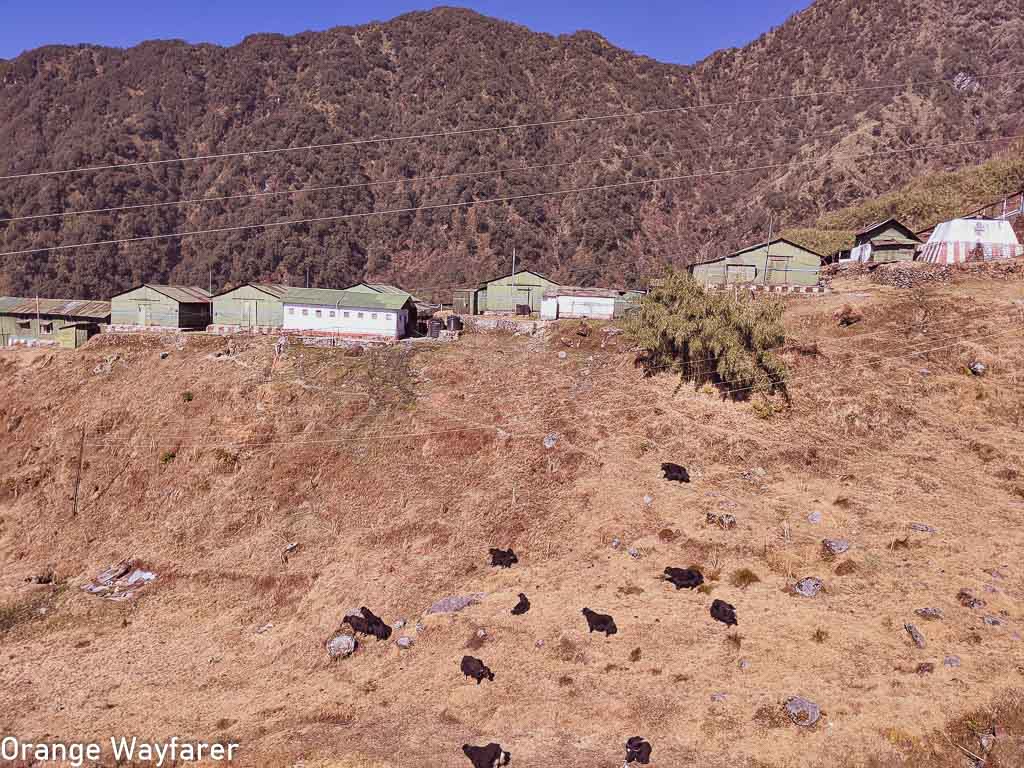
Also read : Phang Nga Bay, the other ace of Phuket that is hardly seen!
Should one plan a night at the Nathang valley?
At a height of 14,000 feet, Nathang Valley stands as an ode to the poem, Life Finds a Way! Once only inhabited by the yak herders of Tibet, Nathang valley had makeshift night arrangements for the caravans of silk route. Now, a few homestays have taken over with meagre arrangements to sustain life for a limited time. Nathang is accessible by tourists only for a handful months of dry summer and early autumn. During winter, gutsy wind blows in to the valley from every corner of the world, making life, forget holidaying, an adventure! Our guide mentioned the time he was stuck here with his vehicle under 5 feet deep snow!
Staying at Nathang valley is a daring adventure, is what I hear from my friends who spend a night at one of the many homestays at Nathang Valley. It is a task to take out your feet of the blanket and feet the toes after sundown. During sunrise, you see Kanchenjunga and the entire sleeping Buddha range standing in alert at a distance. From Nathang valley, the Sleeping Buddha range feels closer and more magnificent than ever. May be Pelling comes to a close comparison, however Pelling is a touristy town.
From Nathang valley, driving down to Gangtok brings you closer to the Hati Lake (elephant lake), Memencho lake and a few more high passes. It was biting cold and I barely could put my nose out of the car!
If weather condition shows a bit of red alert, authorities would not issue permits to visit Nathang valley. You have to take your car back from Zuluk itself. Zuluk usually does not receive heavy snow. Thambi view point, on the other hand, may be covered with snow, making the ride to Thambi quite an exciting one!
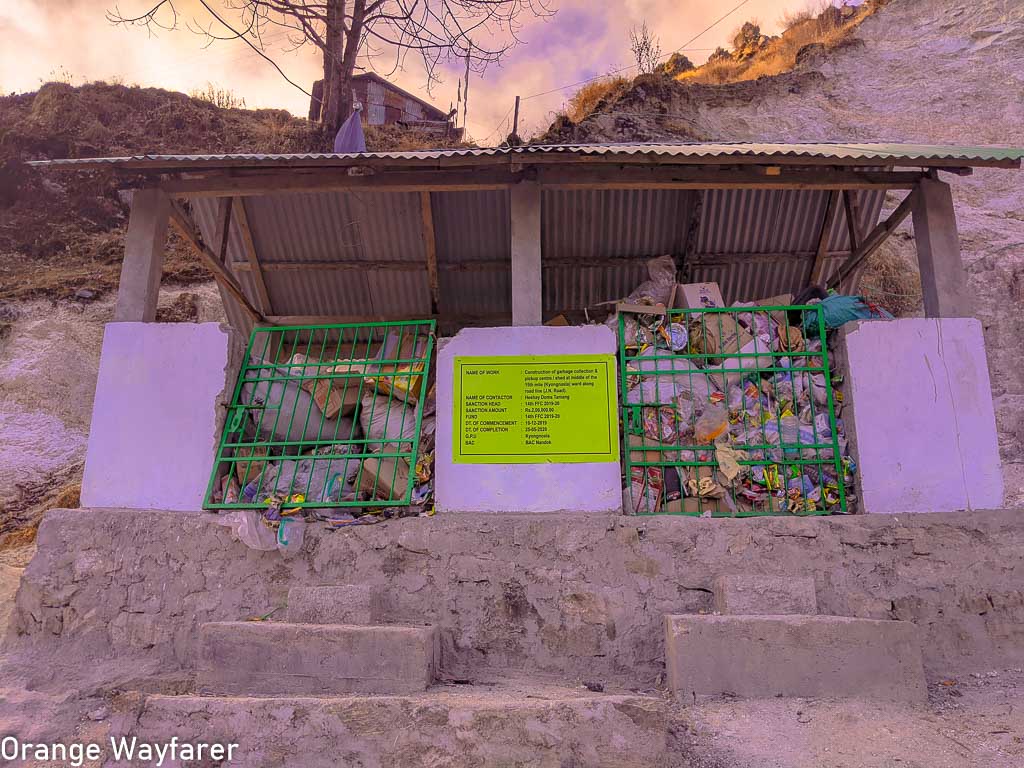
Places to visit near Nathang Valley
I laugh as I write this but Nathang Valley has the most of “Things to do” in the entire area. This is like nature being playful and throws a challenge. “Can you do this?” If you can not stand the cold, stay back in Zuluk, visit nathang valley as a day trip and see the following points.
- Baba Mandir
- Trek down from Baba Mandir and visit Memencho Lake (4 km trek downhill)
- A little monastery where a handful of local Buddhist monks live in Nathang Valley
- The Eagle Nest Bunker (13,700 feet & a hard find). However, visit this place for an early morning sunrise view when you can have a 360 degree view of the entire valley, with kanchanjengha at one side and Tibet at another. I hear people say, you can even spot the mighty Bramhaputra river (Tsongpo River, his origin which is now in occupied Tibet). For astrophotography, eagle’s nest Bunker is a golden hunt!
- Tukla valley: 15 km from Kupup, Tukla straddles shoulder with Chinese border and remains partly accessible by the tourists. An eighteen-hole golf course called Yak Course (13025 feet) makes Tukla the highest golf course in the world. The Yak Golf Course has found a place in the Guinness book of world records for being the highest in the world. Golfers do not use a car here, instead they ride a yak! Many compare Tukla to be similar to Yumthang of North Sikkim.
- On a clear sky day, you may see Jelep la from Tuk La valley. Through Jelep La, one could travel all the way to Lhasa. Now the road is closed (under PLA). Old Trades have eventually paved way for short lived tourism.
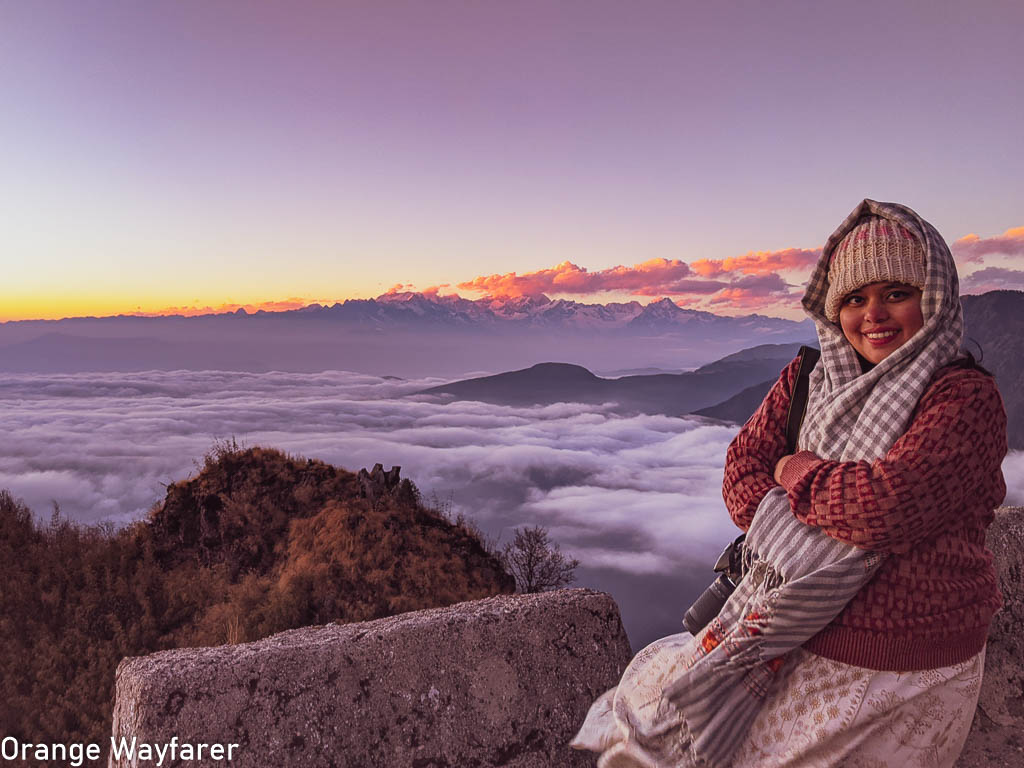
Nathang valley is incredible! They say the mountains are different with the onset of a new season. I do not think you can witness the change any better anywhere else but nathang valley. A few mountain streams mark a boundary for this little village. Once a halt for the caravans coming from Lhasa, Nathang is now a brave halt for adventure seekers of plainlanders.
The battle of Natahng was fought here in 1888, between the Tibetan & British forces. Legends of the fallen soldiers resonate in the air.
In Nathang, please stay at the Daftar Bungalow! Once used by the British to collect custom duty (ugh the colonists) Daftar Bungalow is the only stone construction in the village where gutsy wind does not find a way in! It has been renovated by the department of tourism Sikkim Govt. In the peak of winter, winter skiing takes place in the valley.
I recommend you visit Nathang on a clear sky day to truly experience the beauty of this vast land! But then mountains and her moods, we have no control over! If Nathang remains under thickets of fog, you will not be able to see many prime attractions on the road, including the Zuluk zigzag roads.
Stop at the Changu lake (Tsomgo Lake) on the way back to Gangtok
Nathang valley to Gangtok: 5 hours ( with stop at Changu lake for an hour)
The highlight of returning to Gangtok from Zuluk was albeit a stop at Changu Lake. The glacial lake, a sacred waterbody to the locals, is a touristy spot. Much like the Pangong Tso, Tsomgo lake too changes its colour with the movement of Sun. Order piping hot Maggi, ride the largest cable car, get a picture with the decked up yaks or just walk close to the bank of the lake. Plan for a couple of hours to spend by the beautiful Changu lake!
Due to its close vicinity to Gangtok, Tsomgo Lake is frequently visited by a number of tourists, making is a bit underwhelming with the crowd and the usual touristy things. Despite being located at 12,300+ feet height, Tsomgo lake lacked the celestial vibe all thanks to the crowd.
Steal a few lone moment as you ride the highest cable car of Asia over Tsomgo Lake and reach for the table top plateau that lets you take a bird’s eye view of the high passes you have covered to make this journey a worthwhile!
make sure you reach back to Gangtok before sunset. Black ice starts to set in at the end of the day when sunlight do not abound the valley, making the ride a challenging one.
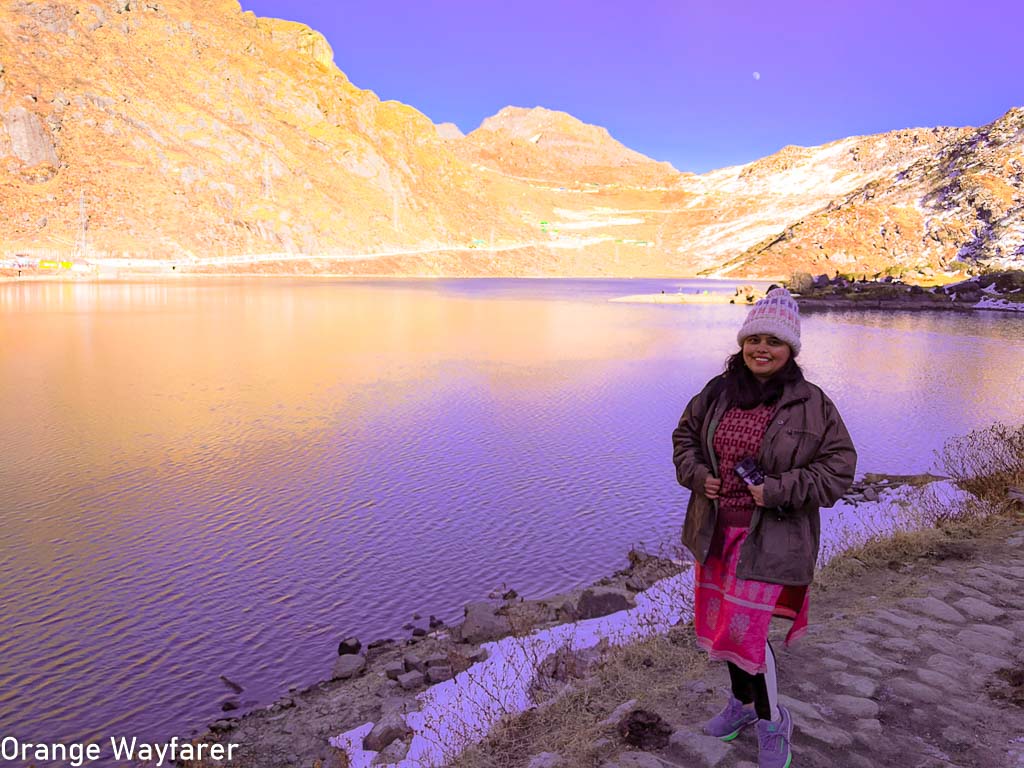
Also read : 2 weeks itinerary for planning a trip to Myanmar !
A Responsible Traveler’s Guide to Old Silk Route, Sikkim
Needless to point it out but old silk Route happens to be one of the most fragile ecological zone in the entire world. To top on it, it is a dangerously protected zone, reminding you a sleeping demon may wake up at any moment, disbalancing the peace that prevails in the valley! The trade caravans have retreated their old tracts paving way for amphibious war vehicles reigning the distant emptiness.
Thankfully, the major crowd puller in Sikkim remains the road to North Sikkim that empties vehicles by the banks of Gurudongmar lake or the beautiful Tsomgo Lake. The later has been taking it one for the team for ages now!
Sikkim is famous as one of the cleanest states of the country. Inhabitants of Sikkim state are well disciplined and follow the decorum. However it will take a while to grow that civic sense among the tour parties who frolic around with empty plastic packets of chips and glass bottles of beers. Be it the scenic Thambi view point or the banks of Tsomgo, no place finds a respite from this unrelenting litter.
people in the mountain usually wake up early, say 5 am. Nights are long and dark with power supply being erratic. dinner would be served by 7 or at best 8 pm since the homestay owners have to finish kitchen work by 10. Please co operate with them.
One way to help save the chastity of the region is by not playing Hindi music in loudspeaker. Please?
Please do not click pictures of Military installments. It is written on boards too.
Refrain from night drives because the road is lonely and black ice is lethal.
There is no hospital in close vicinity. In case of medical emergency, locals and tourists usually rush to army camp.
Avoid staying at Nathang valley if you are traveling with a small kid. That thing air may not be suitable for young lungs.
PLEASE DO NOT LITTER. I am sure if you had been my reader for a while, you know this. But this is for the newer ones, plastic waste by one tour party seems to be an innocent mistake but in reality that litter goes on to live for thousands of years and eventually becomes a part of the ecology in broken down form, increasing the power to pollute to infinity.
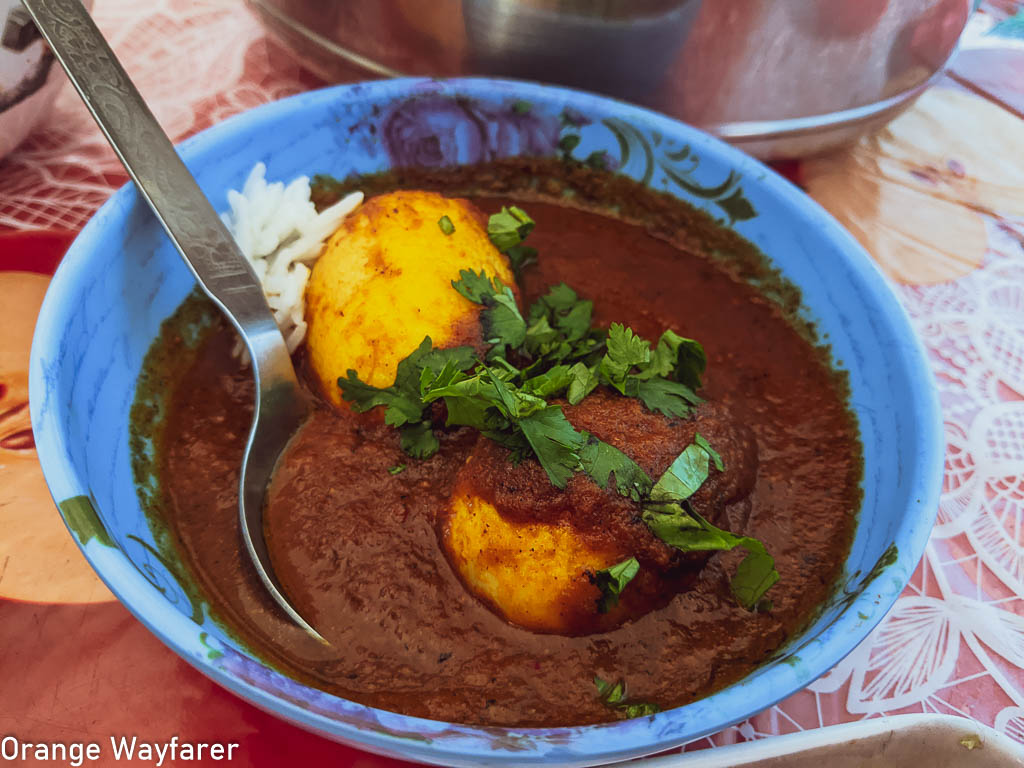
Also read : How to plan a trip to Varanasi as a solo woman traveler?
Medical facilities in the area is extremely limited with communication limited to faint network by the main road on certain network ones only. Please get your basic medication handy. Do not rush. DONT RUSH. Allow your body to acclimatize to the astounding heights of Old Silk Route and climb slow but steady. Not everyday you come so close to nature. It is absolutely okay to stay back and soak in the atmosphere!
Please get your Covid tests done, along with latest RTPCR report. Always keep the mask on when you are dealing with the locals. You have means to travel back to the city, quarantine, access to information and latest medical treatments. Locals in Zuluk do not have these privileges. Please get the test done. Do not be a rule flouter by any means.
The flags on the mountains are hoisted to bring peace to the valley. respect them, especially if they seem to be fallen off grid. If you have not received the permit to access a particular zone, do not try to play around. It is IAF we are talking about. Rules are meant to be adhered at old Silk Route.
If you are visiting the ancient monasteries, please respect the monks and the hand painted artefacts and thangkas. They are priceless to the locals and these antiquities date back to thousands of years!
Resources are scarce at the old Silk Route. Be mindful of what you can consume and take only that much on your plate. Homestay owners grow a little bit of vegetables including potatoes and cabbages which will be stored for the long bitter cold winter too. They will share a bit with your for a price.
Respect for locals and rule of the land comes imperative while you traveling to a remote land such as Old Silk Route. this not only sustains the tourism infrastructure of Zuluk but also ensures you have a safe ride back home!
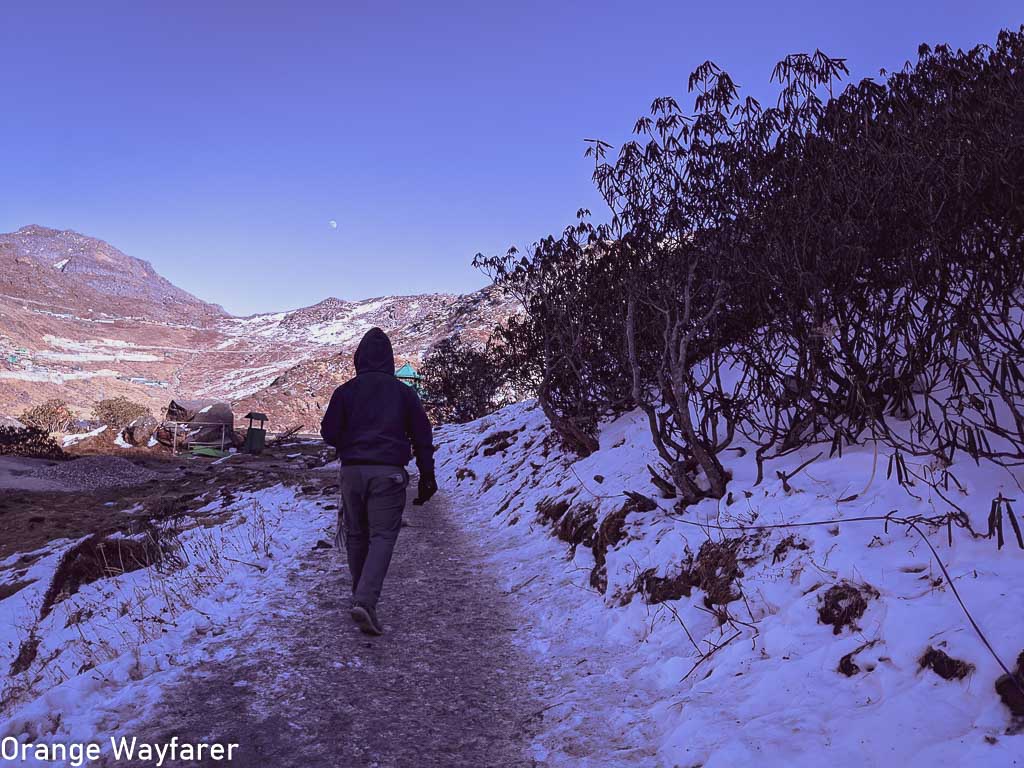
Also read : Offbeat destinations in Greece for the first time visitor!
FAQs on Planning a trip to Old Silk Route
Q: Best Time to Visit Old Silk Route?
-Plan your trip to the Old Silk Route during Dry months, from Mid Oct to Mid Jan and Mid April to Mid July
Q: Can I visit Old Silk Route During Mid December?
-I visited Old Silk Route during Mid December and the trip was worth it! The weather was clear. We did the entire loop from Aritar to Gangtok with Zuluk and Nathang valley in between.
Q: Should you stay at Nathang Valley?
-If you can withstand biting cold and gutsy winds, please choose to stay at Nathang Valley for a night. It is going to be an experience of a lifetime! Of course it depends if you can procure a permit to visit Nathang valley at Rongli check point.
Q: If Zuluk Safe for solo women travelers?
-Zuluk is sparsely populated. there is no hostel. Overall it is a safe place with hospitable and kind locals. Weather could be a challenge though. getting medical help is a challenge too at Zuluk.
Q:Is it safe to visit Old Silk Route?
-Old Silk Route is an ancient trade route that connected India and China through Tibet. It is famous for the hair pin bends known as Zuluk loop. Zuluk is a safe and offbeat destination in east Sikkim however due to increased altitude, there might be breathing troubles. Please acclimatize well as you ascend to Zuluk, Lungthung and Nathang valley.
Q: Is it expensive to travel to old Silk Route in Sikkim?
-You have to arrange for a car for the entire road-trip. Ideally you should get an Innova or a similar car and prices start from 30 thousand INR onwards. Homestays cost INR 2000 onwards. For meals, prices go up a bit higher. Everything is chargeable, starting from hot running water to room heater. Overall, traveling to to Old Silk Route is by no means a cheap travel however it is worth every penny you spend due to the beautiful scenic beauty the road entails!
Q: Is Silk Route Tour in Zuluk open in December?
-Usually Old Silk Route remains open in December however North Sikkim gets closed by the mid of December.
Q: Old Silk Route in Sikkim height?
-Zuluk stands at 9400 feet. Nathang valley is at 13,400 feet. Tsomgo Lake sits at 12,700 feet.
Q: Is Silk Route Worth Visiting?
-The Old Silk Route in Sikkim is one of the best offbeat destination in India. It is one of the stunning road-trips across Himalayas that lets you take a beautiful view of the entire Sleeping Buddha range throughout he journey!
Q: The Best places to visit on the old Silk Route?
-On the Old Silk Route, my favourite destinations are: Zuluk, Lungthung, Nathula and Tsomgo Lake.
Q: Can I travel from Zuluk to NJP in a day?
-Technically, you can however it is a long road with many possible road blocks and the journey would be too tiring. Instead, stop at Aritar for a day and break the journey in two parts. Safe journey and happy journey!
Q: Can I visit Silk route tour if it snows?
-If it snows lightly, you may be provided with a permit to complete the entire loop of Old Silk Route from Aritar to Gangtok. However, in case of heavy snow storm, you will only be able to ascend till the Thambi View point. Sometimes, permits are issued for Nathang valley as well. But the road onwards is heavily militized for proximity to international border and often limited for commoners due to increased safety risk.
Q: Should I stay at Zuluk or Nathang valley?
-Make your base at Zuluk and see if you can endure the extreme cold. If the answer is yes, head towards Nathang valley for a night stay or you can visit Nathang as a day trip destination too. It is only a 30 minutes drive from Zuluk.

This post may contain affiliate links. Please read the disclosure post. If you have liked the article, you may support it by buying using these links without any extra cost to you.
Let’s stay connected on Facebook , Instagram , Twitter ! You may also consider joining my mailing list. I send travel and photography related emails only once a month!
Leave a Reply Cancel reply
Your email address will not be published. Required fields are marked *

SIKKIM SILK ROUTE Tour in East Sikkim – A Complete Travel Guide
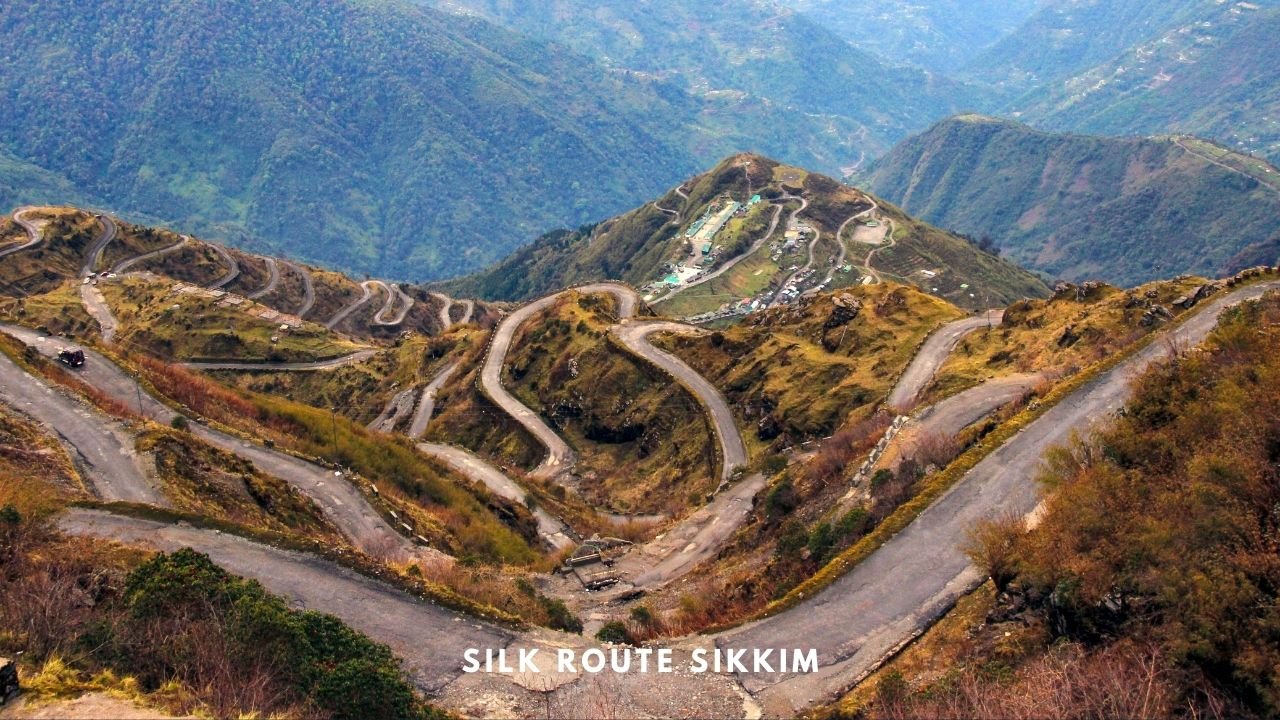
Last Updated on: Aug 8, 2021
About this blog: Sikkim Silk Route tour is one of the most famous attractions in East Sikkim. Zuluk (also spelled as Dzuluk) was once an important stop on the Ancient Silk Road. Today Sikkim Silk Route is known for its clear and gorgeous views of the mountains, the dizzying zig-zag roads and hairpin bends and quaint villages on the route. Read this blog about Sikkim Silk Route Guide and get information on how to reach, where to stay, attractions and the tentative cost of Silk Route Tour.
We had explored Sikkim to a great extent. However, the Silk Route in East Sikkim seemed to elude us for a long time. While we explored the high altitude lakes, offbeat hamlets and the monasteries of Sikkim, we were yet to experience the famed hairpin bends of Zuluk. Finally, it was an impromptu decision that had us boarding the Darjeeling Mail to reach New Jalpaiguri and finally go for the Sikkim Silk Route trip.

The Sikkim Silk Route tour can be started from either New Jalpaiguri (NJP) in West Bengal or Gangtok in Sikkim. We had decided to start our journey from NJP and end it in Gangtok and stop at Aritar, Zuluk and Nathang Valley for the night. Read on to know more.
Sikkim Silk Route in Visuals
History of Sikkim Silk Route
The Silk Route in East Sikkim that is open for the tourists to explore is actually a part of the ancient Silk Road. The Ancient Silk Road was actually a huge network of ancient trade routes that stretched from Asia to the Mediterranean traversing China, India, Persia, Arabia, Egypt, Greece and Italy. This route was formally established during the Han Dynasty of China in 130 BC. It linked regions of the ancient world in commerce between the periods of 130 BCE-1453 CE.
The Sikkim Silk Route as we see today was only an offshoot of the Ancient Silk Road. Infact, it is only a small part of the ancient silk route that connected Lhasa in Tibet to Tamralipta in West Bengal. Yes, Lhasa was once the hotspot of ancient trade and commerce. The nearest sea port to Lhasa was at Tamralipta, or present day Tamluk in West Bengal.
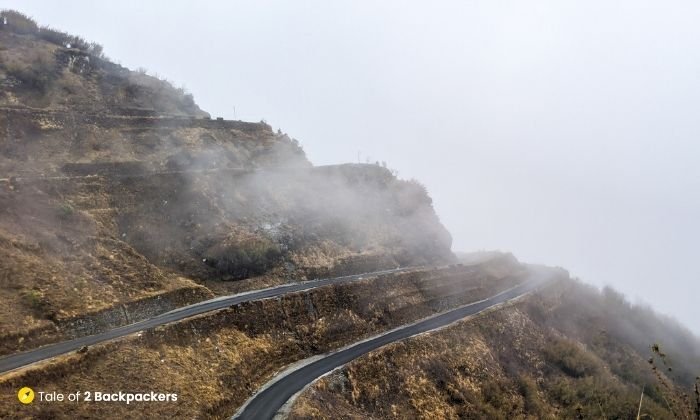
This entire Silk Route covered a distance of 900 km from Lhasa to Tamralipta starting from Chumbi Valley in Tibet, going across Nathu La and then through the hills of East Sikkim before finally entering into the plains of Bengal. The Chumbi Valley is connected to Sikkim to the southwest via the mountain passes of Nathu La and Jelep La. It is the thin slice of land between India and Bhutan that is known more for the Doklam issue between India and China.
A lot of commodities were traded along the Silk Road. The Chinese Silk was considered one of the luxury items and was traded from the east to the European countries. Other items included textiles, tea, spices, dyes, medicines, glassware, fruits and even camels. Apart from commodities knowledge, ideas and culture were also exchanged along these old routes. Well, the Silk Route is not of much significance today because of the geo-political boundaries.
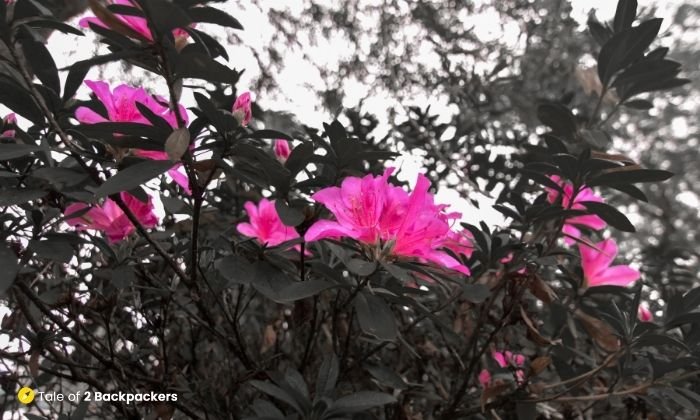
Silk Route Sikkim Travel Guide
The Indian part of the Silk Route is open for tourists from Rongli to the Nathula Pass. The region is no doubt historically interesting, but it is the stunning vistas of the route that attracts tourists to this part of East Sikkim.
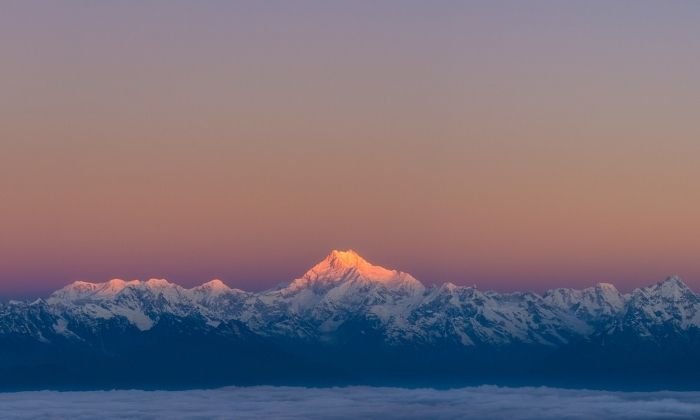
Although the Silk Route gets a lot of tourists from Bengal during the months of October (mainly due to the Durga Puja holidays), this part of Sikkim is relatively offbeat to tourists from other parts of India. There are actually no major towns enroute the Silk route circuit. Homestays are available all throughout the Silk Route in Sikkim that provides basic amenities to the tourists.
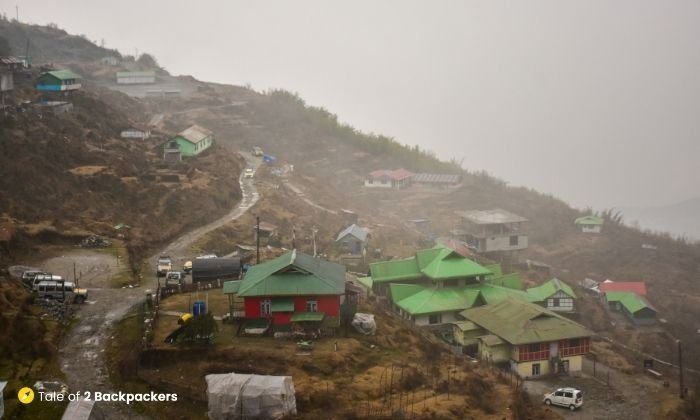
The Sikkim Silk Route circuit basically starts from Rongli, located at an altitude of 5000 feet near Bengal-Sikkim border. You might have seen Sikkim Silk Route packages mentioning stays at Rishikhola, Icchey Gaon or Sillery Gaon. Well, these places are located in West Bengal and are technically not part of the Silk route. These beautiful villages are located at the foothills of the route and you can stop at any of the villages to break your journey.
Our Itinerary
As I mentioned above, we started from NJP for our Silk Route tour. Here is a detailed itinerary of our Sikkim Silk Route Tour.
Day 1: NJP – Aritar (110 km)
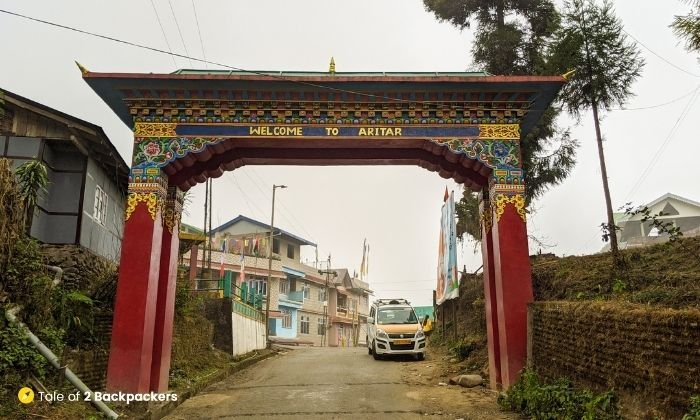
We spent our first night at Aritar, a beautiful hamlet of Sikkim. Aritar is also a slight detour from the actual ancient Silk Route, located at an altitude of 4000 feet.
Our train to NJP was a bit late and we reached at around 10 AM. We had already booked a car for the entire Silk Route trip. The car was waiting for us at NJP and we started as soon as we reached there. It took about 4.5 hours to reach Aritar after crossing the Rangpo Checkpost at Sikkim border. By the time we reached Aritar, it was drizzling.
We checked into our homestay, had our lunch and then went to explore the village on foot. As it was already late afternoon, we decided to rest for the day. We decided to explore Aritar the next day.
Alternative Stop: Mankhim
Day 2: Aritar – Zuluk (42 km)
Exploring aritar.

We started early from Aritar. The weather was a bit dampener with dark clouds hanging over us. Aritar is known for Lampokhri Lake, an artificial lake surrounded by hills covered with pine trees. There is also a small monastery near the lake. You can also go boating at Aritar Lake.
There is another monastery on the hilltop by the Aritar Lake. There is a trekking trail from the side of the lake leading to the Mankhim Top viewpoint and the local monastery. You can also reach the monastery by car. There is also an old British dak bungalow at Aritar.
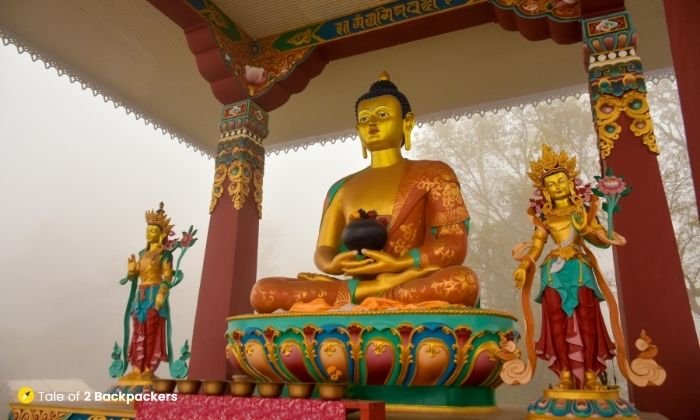
Mankhim is located about 3 km from Aritar and is famous for the Mankim Top viewpoint. A forested trail through a rough and muddy road actually leads to the Mankhim Top. Aritar Lake is located just at the foothills of the Mankhim top.
Mankhim is a small village located at the top of the hill inhabited by the Rai Community. There is a temple and a monastery at Mankhim. From the Mankhim Top, you will get a panoramic view of the Kanchenjunga ranges at the horizon. This is, perhaps, the best thing about the Sikkim Silk Route. Through the entire route, you will get viewpoints from where you can get unobstructed views of the snow-capped mountains.
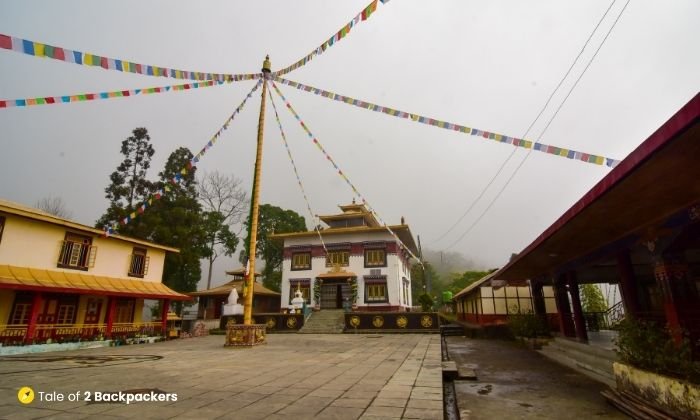
You will also get a view of the Lampokhari Lake from the viewpoint. There are several places on the trekking trail from where you will get great views of the lake.
There is a homestay just located a few metres from the Mankhim Top. It is a great place to stay, mainly for the views and the hospitality.
Note: Both Aritar and Mankhim are located before Rongli. So you do not need a permit to visit and stay at these places.
The Que Khola Falls is located just 2 km from Mankhim. It falls on the way towards Rongli. Que Khola is a small waterfall on the road side having a few tea stalls. You will get tea, coffee, momo and snacks at these stalls.
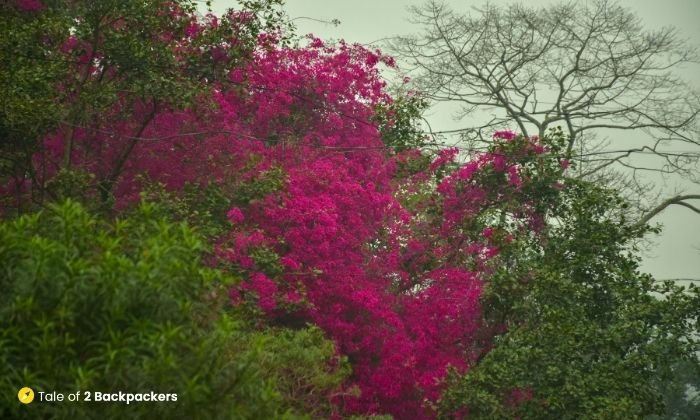
Rongli was the next stop. This is an important town in East Sikkim. This small town is surrounded by greenery and the Rangpo River flows by the town.
Rongli is an important stop in the Silk Route because you have to get your mandatory permit from here. You can get your ILP (Inner Line Permit) from the SDPO Office for travelling beyond this point to Zuluk and Nathang Valley. We too stopped at Rongli to get our passes.
You can also stay at Rongli for the night. The town is quite peaceful and there are a number of forest trails from here.
After we got our permits from Rongli, the actual journey through the Silk Route started. The roads were smooth and we quite enjoyed our drive amidst the beautiful scenery of Sikkim. Just imagine, centuries ago, caravans laden with expensive goods would commute along these roads! That is definitely a goosebump inducing feeling! After Rongli, the increase in altitude starts.
The next village on this route is Lingtam. The permits are checked at the Lingtam Checkpost. This is a small village and a few homestays are found here. You can stop here for some time, take a few photographs before travelling further.
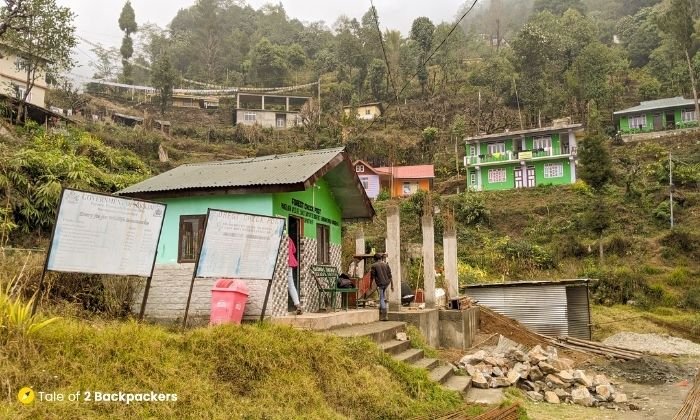
Padamchen, located at 8000 ft is one of the most beautiful villages in Sikkim Silk Route. It is only 15 km from Rongli and is surrounded by greenery all around. Padamchen has pleasant weather all throughout the year and the village offers a sweeping view of the surrounding valleys.
Padamchen is a good place to stay for the night at Sikkim Silk Route. There are a number of homestays in Padamchen that offer all the basic amenities for tourists.
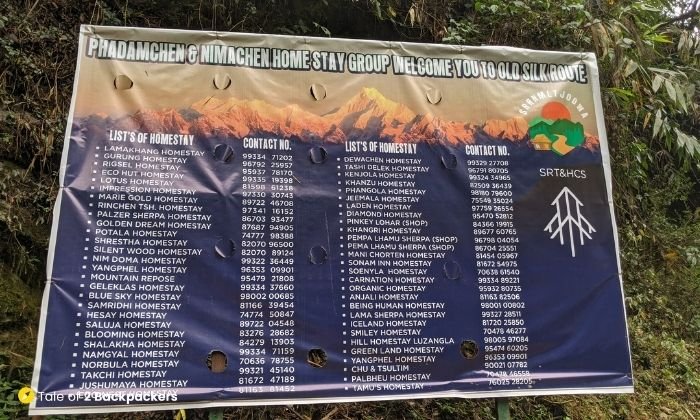
Padamchen has a few walking trails in the adjoining forests. If you are lucky enough, you might see a few Himalayan birds or even the elusive red panda.
We stopped at Padamchen for some time and then proceeded towards Zuluk, our final destination for the day.

The actual fun started after we crossed Padamchen and headed near Zuluk. The hairpin bends, that the Silk Route in Sikkim is so famous for, starts before Zuluk. After crossing a few bends, we finally arrived at Zuluk.
Zuluk is probably the most famous stop on the Sikkim Silk Route. And Zuluk also happened to be one of the major transit points in the past as well.
Located at 10000 feet, Zuluk is a small settlement on the Himalayan hillside. The place also has a huge army camp on the hill top.
Zuluk is known for its picturesque mountain views. The view of the sunrise from Zuluk is also quite breathtaking. During the spring, rhododendrons bloom in the region making the place a riot of colours. Being at a high elevation, Zuluk is often covered by mist and clouds. This was what we experienced mostly at Zuluk. In our entire Sikkim Silk Route tour, the weather was a bit gloomy with no sunshine. However, mist and clouds also have their own charm!

During the winter months, Zuluk experiences heavy snowfall and the entire region is covered in a blanket of snow.
There is a Shiva Temple at Zuluk that you can visit. Otherwise, it is quite pleasant to walk around the small village.
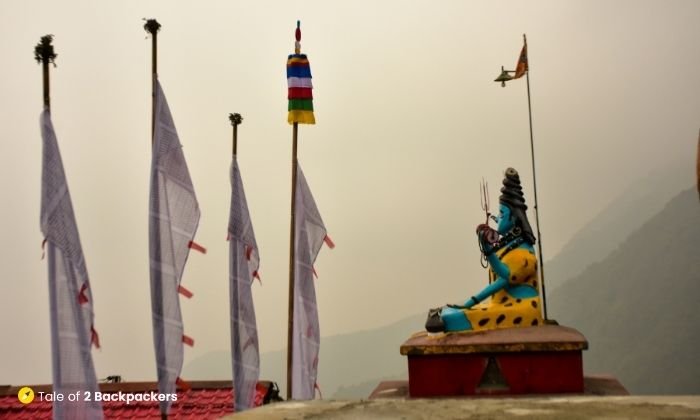
It was late afternoon when we reached Zuluk. After checking into our homestay, we went out to explore the temple and the area. We walked aimlessly along Zuluk while enjoying the cool mountain air.
Day 3: Zuluk to Nathang Valley (24 km)
This was the curtain raiser day, when we would drive through the famous zig-zag roads of Sikkim Silk Route and view them as well from the Thambi Viewpoint . The viewpoint is also known for its spectacular view of sunrise. However, the weather did not improve and there was no chance of viewing a proper sunrise. So we did not bother to wake up early in the morning to view the sunrise.
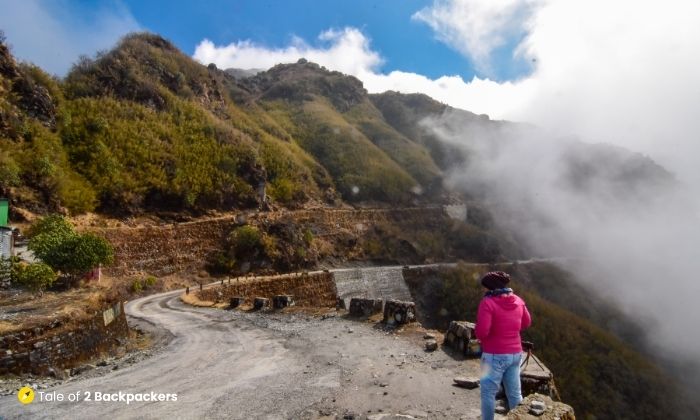
If the weather is good and you want to view the sunrise from Thambi View Point, then you have to start quite early in the morning and reach Thambi by 6 AM.
Thambi View Point

Thambi Viewpoint is located about 14 km from Zuluk and it will take about 40 minutes to reach there. At 11600 feet, Thambi viewpoint naturally offers a breathtaking view of sunrise, as well as a majestic view of the loops. See the picture below!
Did you know, there are 32 hairpin bends on the way from Zuluk to Thambi Viewpoint?
About 2 km from Thambi is another viewpoint – Lungthung Viewpoint, located at 12000 feet. This is perhaps the best place from where you can get an all-encompassing view of the Kanchenjunga ranges.
Nathang Valley
Located at an altitude of 13500 feet, Nathang Valley will simply take your breath away. This beautiful hamlet was originally inhabited by Tibetan yak herders. Nathang Valley is known as the “Ladakh of the East” because of its similarities in landscape with Ladakh.
Mountain streams criss-cross the barren landscape of the valley. The valley changes colour according to season. During the spring, rhododendron blooms paint the landscape in a riot of red, pink and yellow hues. Autumn sees the valley in a golden-yellow hue. Winters are totally blanketed by white snow.
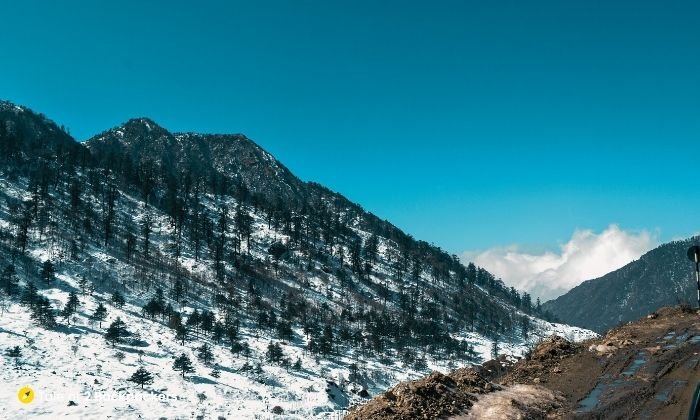
Nathang Valley has only about 50 houses inhabited by people of Tibetan origin. There are a few homestays in Nathang Valley. If you are staying at Nathang Valley for the night, carry woolen clothes. The altitude makes the climate quite chilly and the winds are strong as well.
There is a Buddhist Monastery and Krishna Temple that you can visit at Nathang Valley.
Day 4: Nathang Valley – Kupup Lake – Baba Mandir – Gangtok (74 km)
This was our final day. We wanted to travel a bit slow, so we stayed at Nathang Valley at night. You can also opt to carry forward from Nathang Valley towards Gangtok on the same day. There are a few attractions near Nathang Valley that you should not miss:
Eagle Nest Bunker
Eagle Nest Bunker is located a few kilometres from Nathang Valley at an altitude of 13700 feet. This abandoned bunker is perched on a strategic location and gives a panoramic view of the Eastern Himalayas. You get a beautiful view of the Kanchenjunga ranges and other peaks of TIbetan plateau.
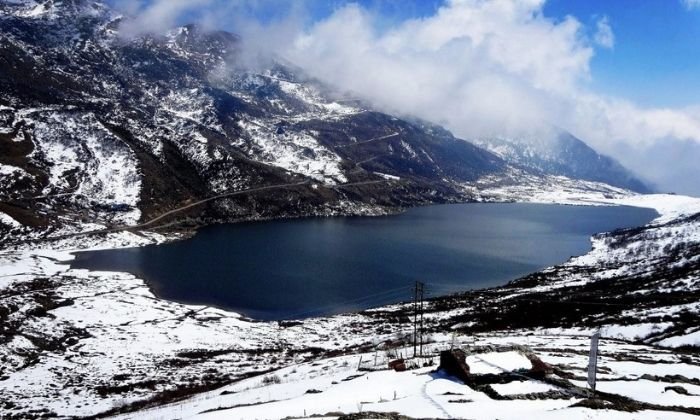
Kupup Lake is quite beautiful and on a clear day, the lake looks clear blue. The lake is also known as Elephant lake, because of its shape.
Memencho Lake
Memencho Lake cannot be reached directly by car. You have to trek downhill about 4 km to reach the lake. Menmecho Lake is a beautiful Lake located amidst conifers on all sides.
Tukla Valley

Tukla Valley is located about 15 km from Kupup. This is a relatively unexplored valley located quite close to international borders. Only a part of the Tukla Valley is accessible to civilians. The place is as charming as Yumthang valley in North Sikkim, if not more.
There is another interesting attraction at Tukla Valley. There is an eighteen-hole golf course called Yak Course located at an altitude of 13025 feet making it the highest golf course in the world.
Old Baba Mandir
This is the actual bunker where Baba Harbhajan Singh resided. You can go inside the bunker and see Baba’s personal effects.
The New Baba Mandir is located about 10 km from the Old one and the Silk route merges with the conventional road towards Nathula and then towards Gangtok.
Tsomgo Lake or Changu Lake
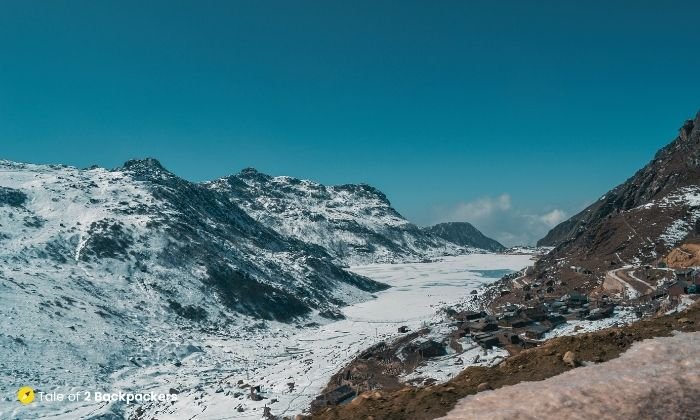
You can stop at Changu Lake or Tsomgo Lake on your way towards Gangtok. Tsomgo Lake is a beautiful lake considered sacred by the locals. The lake is a famous attraction of Sikkim and is visited by a lot of tourists.
Tentative Sikkim Silk Route Itinerary
The minimum days required for the Sikkim Silk Route is 2N/3D. You can extend your trip if you have more days in hand. We will share a few itineraries according to the number of days you have in hand.
Sikkim Silk Route Itinerary for 2N/3D *
- Day 1: NJP – Aritar/ Mankhim
- Day 2: Aritar/Mankhim – Zuluk
- Day 3: Zuluk – Nathang Valley – Gangtok
*You can do this the opposite way as well
Sikkim Silk Route Itinerary for 3N/4D *
- Day 1: Gangtok – Nathu La – Nathang Valley
- Day 2: Nathang valley _ Zuluk – Padamchen
- Day 3: Padamchen – Mankhim
- Day 4: Mankhim – NJP
Sikkim Silk Route Itinerary for 4N/5D *
- Day 1: NJP – Icchey Gaon/ Reshikhola
- Day 2: Icchey Gaon/ Reshikhola – Mankhim
- Day 3: Mankhim – Zuluk
- Day 3: Zuluk – Nathnag Valley
- Day 4: Nathang Valley – Gangtok
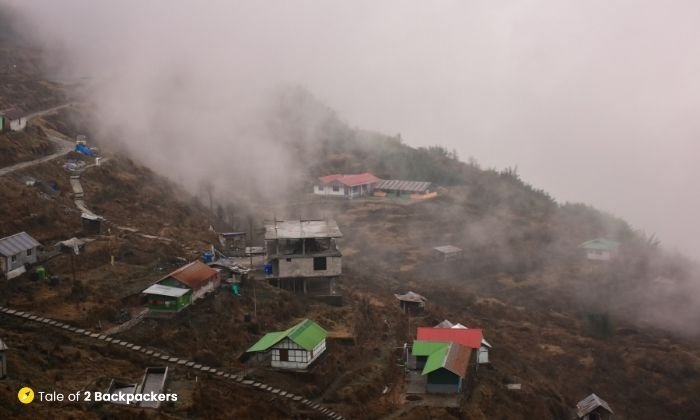
What is the Best time for the Sikkim Silk Route Tour?
March to May (Spring and Summer)
The best time to visit East Sikkim or Sikkim Silk Route is the spring time between March and May. During this time, the weather remains pleasant. Rhododendrons bloom during the spring.
June – September (Monsoon)
This season is best avoided. Sikkim witnesses heavy rainfall as well as landslides during the monsoon. Roads are treacherous and often get blocked due to landslides. You will also not get good views of the mountains during monsoon.
October – November (Autumn)
Autumn is one of the best times to visit the Sikkim Silk Route. The weather remains pleasant and clear and is good for viewing the mountain ranges.
December – February (Winter)
Winters are usually harsh in the higher altitudes. Snowfall is experienced at Zuluk and Nathang Valley. Views are quite clear during December and January. However, during February, the weather remains foggy and you might not get good views. Also during the winter season, often roads are blocked due to excessive snowfall and you might not be able to complete your trip.
Where to Stay on the Sikkim Silk Route?
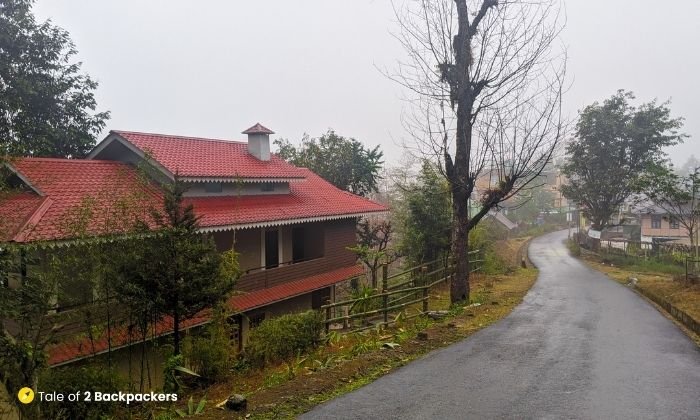
The only option to stay at Sikkim Silk Route circuit is the homestays. The homestays are basic in nature having all the basic amenities like comfortable beds, quilts and hot water facilities. Some of the homestays might also have televisions and geysers.
There are hardly any restaurants or eateries at any of the villages apart from Rongli. So the homestays are the best bet to have your meals. The homestays provide tasty and homemade food. Both vegetarian and non-vegetarian food is available. The homestays will provide breakfast, lunch, evening tea and dinner.
Usually, the homestays in the Silk Route circuit usually cost INR 800 – 1200 per head per day including food.
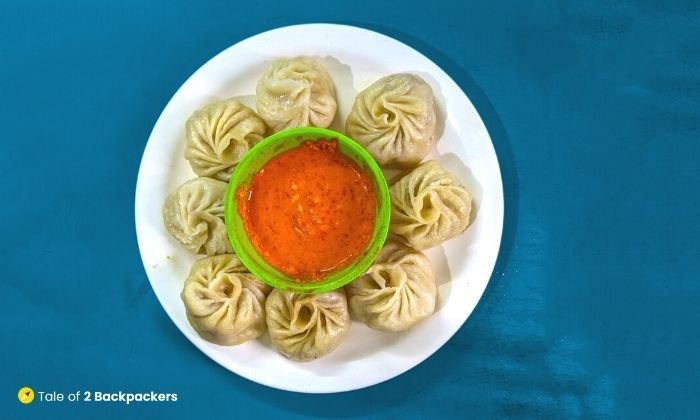
How to obtain permits for Sikkim Silk Route?
You will need Protected Area Permits to travel to Sikkim Silk Route. Permits can be obtained by going to the tourist Centre at Gangtok or contacting a travel agent. You will need an identity proof and passport size photographs to obtain the permit. You also need to keep the original ID proofs handy as it might be asked at the check posts.
Remember, that Adhar Card is not a valid ID proof for obtaining a permit. You can use Voter ID Card, Passport or Driving License to obtain a permit.
The Permits for the Old Silk Route are given out of both Gangtok and Rongli. However, the p[ermits for NathuLa are only given from Gangtok. So if you are entering from Rongli and exiting from Gangtok, then you cannot perhaps visit NathuLa. You can talk to your homestay owner or Driver to know more about the passes to Nathu La.
Currently, you also have to apply for a Travel Card for entering any area of Sikkim. This is an easy process and can be applied online . You have to carry a print out of the filled form with you while travelling to Sikkim.
Permit for Foreigners
While foreigners are allowed to travel in parts of Sikkim, they are not allowed in the Old Silk Route. Foreigners need an Inner Line Permit (ILP) to visit Sikkim. The ILP can be obtained from all Indian Missions, Sikkim Tourism Offices at New Delhi, Kolkata, District Magistrate’s Office of Darjeeling, Siliguri, and Rangpo on the strength of an Indian Visa.
How to reach?
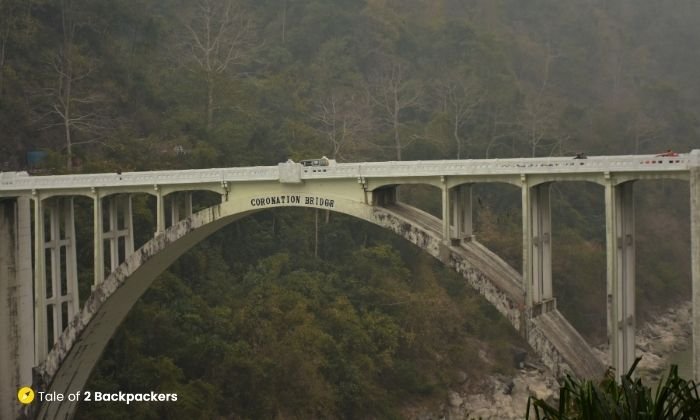
New Jalpaiguri (NJP) is the nearest railway head. NJP is well connected by trains from all the major Indian stations. You can also fly into Bagdogra. You can start your journey from either NJP or Gangtok.
If you want to start from Gangtok, you can reach Gangtok from NJP/Siliguri or Bagdogra. You will get shared sumos from NJP Station and Siliguri SNT Stand to Gangtok. You can also book a car to Gangtok from Siliguri or Bagdogra or NJP.
Sikkim Silk Route Travel Guide (FAQs Answered)
The best time for the Sikkim Silk Route tour is the months of April and May as well as October and November. During this time the climate is perfect for road trip without the wrath of rains and snow. The months of April, May and October are the peak seasons for Silk Route Tour.
You can start your Silk Route tour in Sikkim either from NJP or Gangtok. Starting from NJP, you can stop at Aritar for the first night. On the second day, get your permits for Silk Route from Rongli and then carry on towards Zuluk and Nathang Valley and finally to Gangtok. You can also start from Gangtok and return to Siliguri or NJP.
The height of Zuluk is 2865 m
Zuluk is a small village in East Sikkim and is an important stop in Sikkim Silk Route. Zuluk is beautiful with a handful of settlements, surrounded by moutains and gorgeous views. Zuluk is also famous for the famous hairpin loops of Silk Route. Zuluk has emerged as quite a famous hill station in East Sikkim and is definitely worth your time.
Yes, homestays are available along the entire Silk Route. Most of the villages have homestays these days offering basic and comfortable stays, hot water and good food. The most famous points of stay in Silk Route are Aritar, Mankhim, Rongli, Padamchen, Zuluk and Nathang Valley. You can stay at any of these places as per your plan.
Mobile network works satisfactorily on almost the entire Silk Route, except near Nathang Valley. Vodafone, Airtel, BSNL & Jio network works pretty well. However, internet speed is not that good.
You will find a number of ATMs between Siliguri and Rongli, as well as in Gangtok. Beyond Rongli, there are no ATMs

I hope this blog on Silk Route will help you plan your Sikkim Silk Route Tour. If you have any queries, drop us a comment below or send us an email. If you liked this post and found it useful, please share it with your family friends and neighbours.
Pin it for a later read!
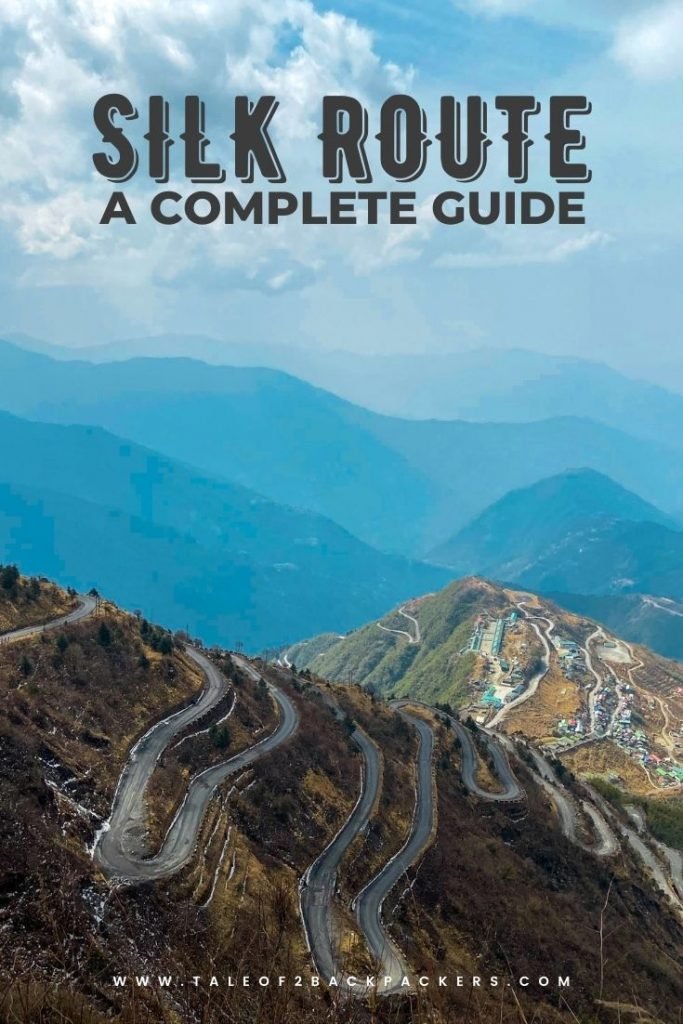
Agni Amrita
Related posts.

Darjeeling to Gangtok – How to Reach & A Kickass Itinerary
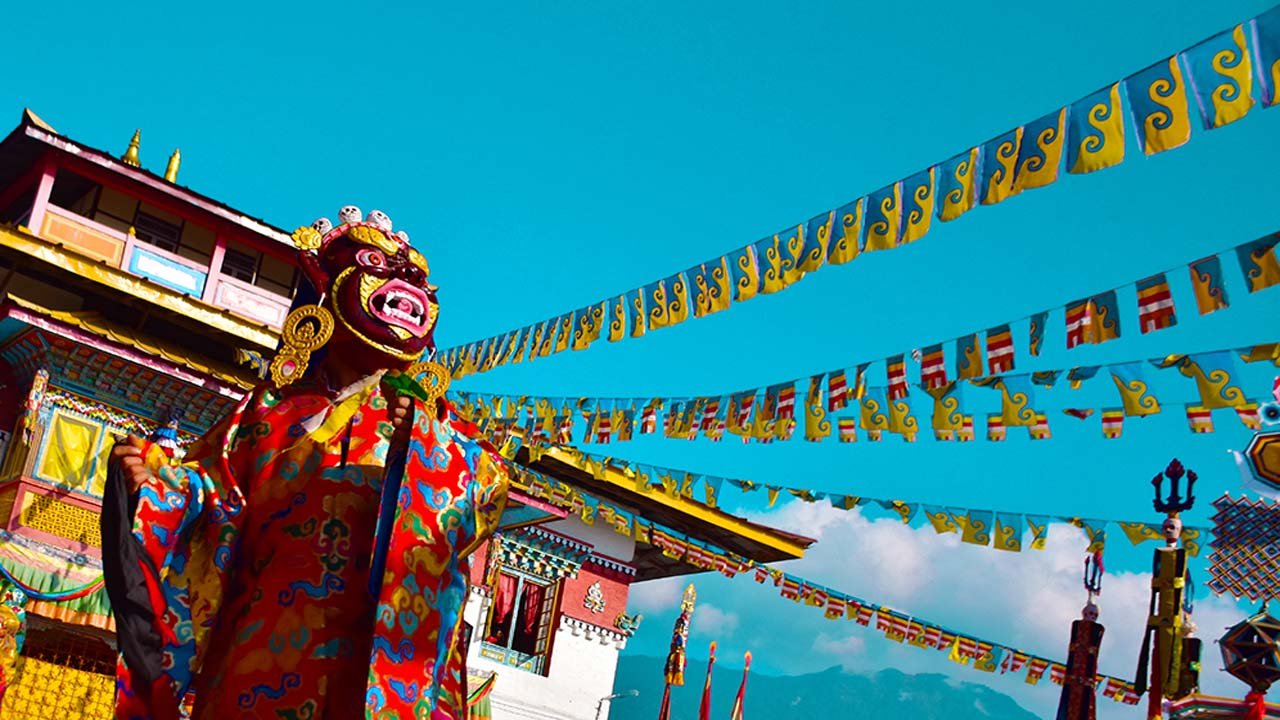
Kagyed Dance (Chham) – Masked Dance of Sikkim
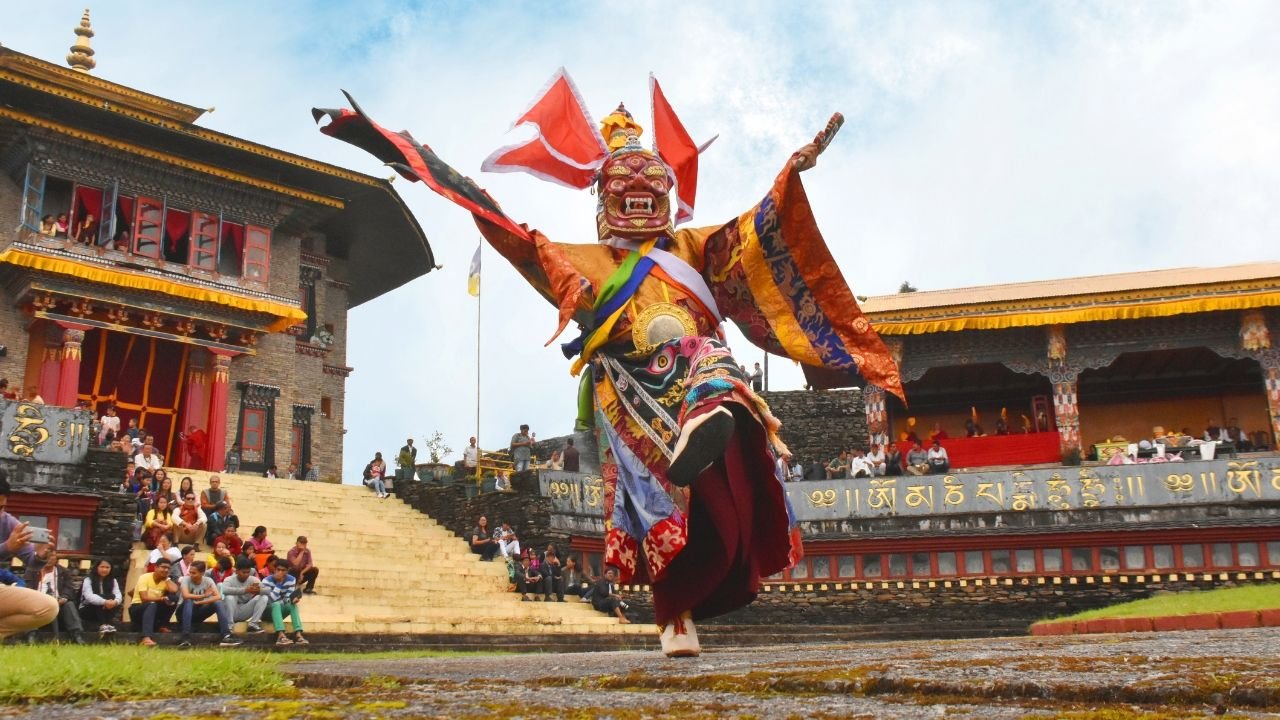
Pang Lhabsol and Chaam Masked Dance – Festival of Sikkim
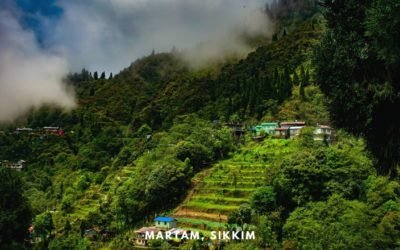
Bermiok Martam – A Quaint Weekend Getaway in West Sikkim
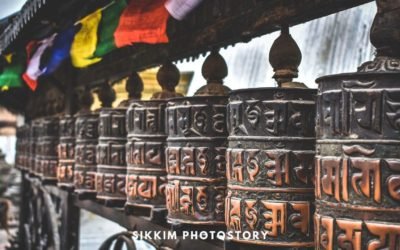
20 Photographs that will make you want to visit Sikkim
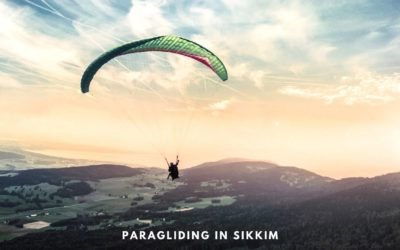
Seeking the thrill of Paragliding in Gangtok, Sikkim
I loved reading your blog post on the Sikkim Silk Route Tour. It was so informative and I learned a lot! I’m definitely going to book my tickets and go on this amazing tour!
Thank you so much!
Submit a Comment Cancel reply
Your email address will not be published. Required fields are marked *
Submit Comment
This site uses Akismet to reduce spam. Learn how your comment data is processed .
Pin It on Pinterest
Change location
- UK / International
- Call toll-free until 8pm EDT 617-223-4521 617-223-4700 or
- REQUEST A QUOTE
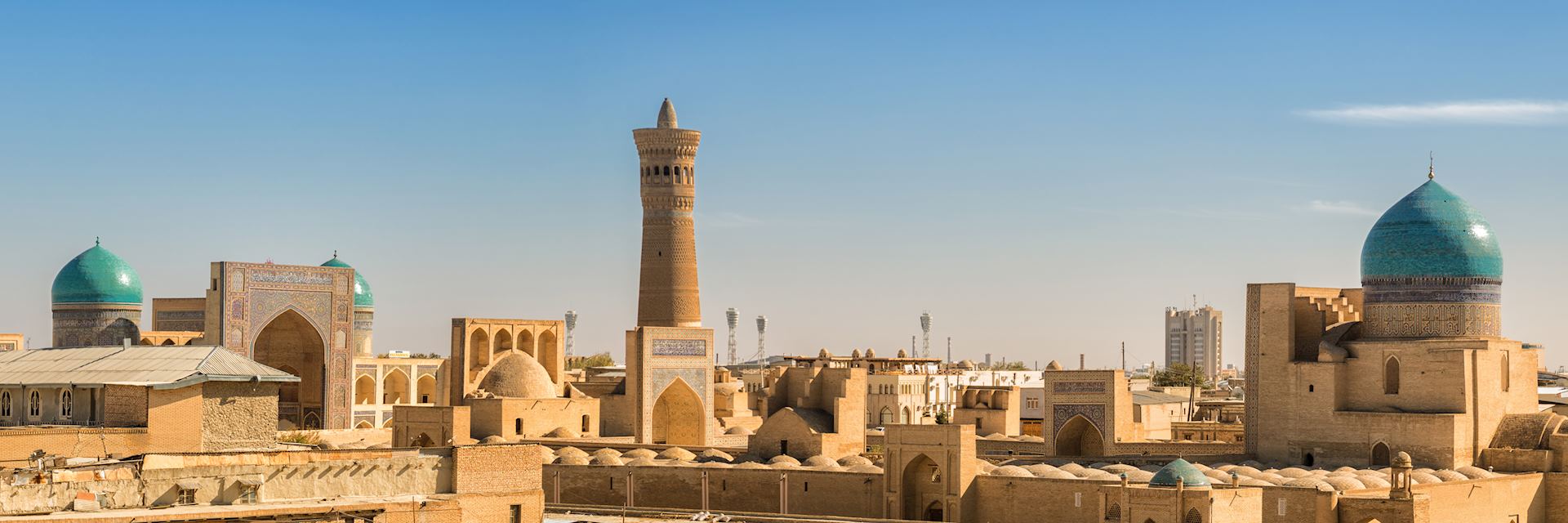
The Silk Route, unpacked: highlights of Central Asia
By Central Asia specialists John
In the space of just a few days, you can travel from green mountain pastures to a land of desert, punctured by some of the most arrestingly designed Islamic architecture you might ever set eyes on.
Your journey along the Silk Route will be by no means luxurious ― but with sacrifices come immense gains. The hotels will be far from the best you’ve ever stayed in, and the food can be underwhelming. But, I think the scenic and architectural riches you’ll be exposed to more than make up for this.
You can travel the route in full, starting in China, or cherry-pick the parts you’d like: I suggest zooming in on Central Asia, taking in primarily Kyrgyzstan and Uzbekistan . It’s even possible to see the best of Uzbekistan in 11 days .
What was the Silk Route?
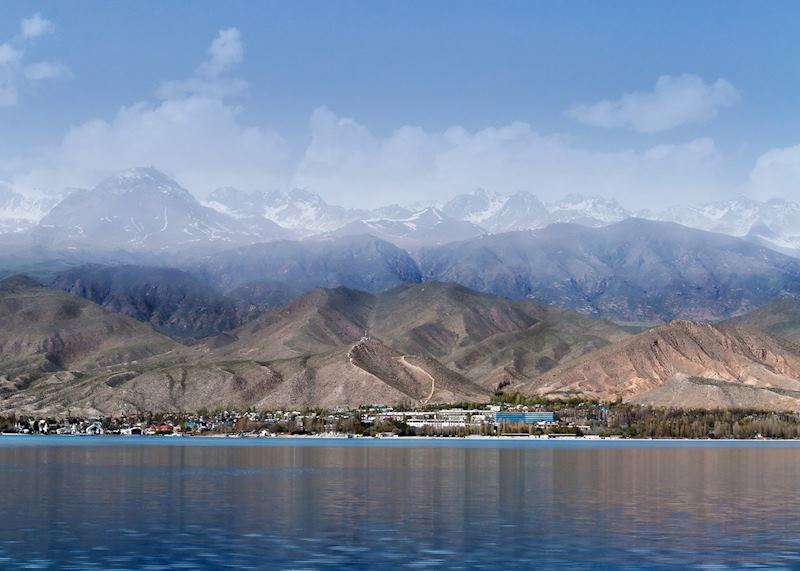
The Silk Route was actually a network of trading routes rather than one long road. Its roots stretch as far back as 207 BC, when silk was first produced in China and transported for trade. It eventually grew to link Asia , the Middle East and Europe , branching off into the Indian Subcontinent and Russia.
Silk Route trade didn’t stop at silk. Goods, from spices, teas, salt and sugar, to ceramics, ivory, jewels and furs, were shuttled back and forth as countries discovered new items produced in far-away lands. Less tangible exchanges also took place: ideas, languages, cultural practices, religions and even diseases were passed on between traders.
How to tackle the Silk Route
Some Silk Route itineraries will have you begin in Beijing and end in Tashkent , Uzbekistan, voyaging the width of China and Kyrgyzstan en route. But, I'm going to rip up the rule book and suggest that you focus your efforts on Central Asia.
For us, it’s the most intriguing section, full of juxtapositions. You’ll go from Kyrgyzstan’s mountains, lakes and plains to wide-open desert. From lakeside yurt camps to spindly minarets, and from relatively relaxed Kyrgyzstan to religiously conservative Uzbekistan and to the highly regulated bubble of Turkmenistan’s dictatorship.
The route I suggest starts off with a flight into Almaty, capital of Kazakhstan. You then cross overland into Kyrgyzstan, one of the most scenic drives of the trip (more on that shortly). From Kyrgyzstan you journey through Uzbekistan, hopping briefly into Turkmenistan before heading back over the border and beginning your homeward journey from the Uzbek city of Khiva .
Silk Route need-to-knows
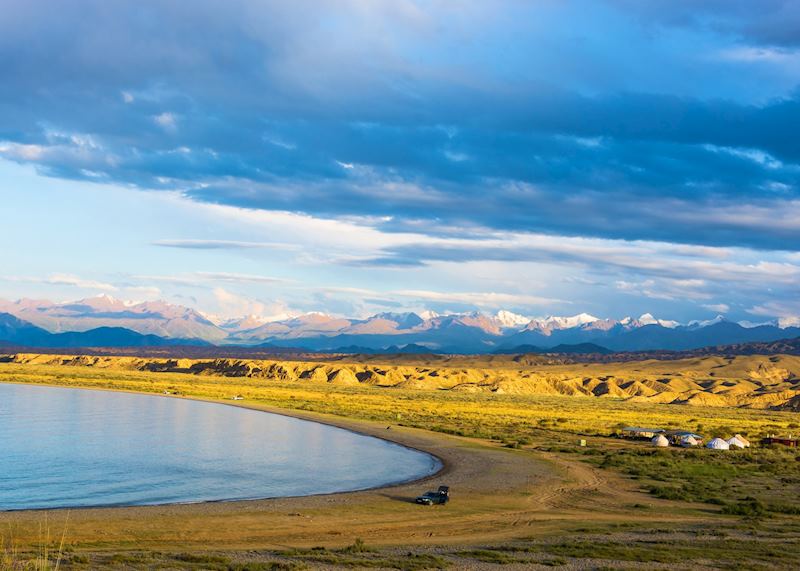
The Silk Route throws up particular challenges. We’ll always try to make it as manageable as possible for you, though, and I think the rewards of experiencing this region more than make up for the snags you might encounter while visiting it.
Here are some quirks to be aware of:
- As you’re covering such a vast distance, long journeys are part and parcel of a Silk Route tour. Some days you’ll spend seven or eight hours in a car. On the plus side, you’ll have private drivers, so you can spend your time gazing out of the window.
- As well as lengthy car journeys, the trip also involves several domestic flights and some journeys aboard Uzbekistan’s efficient rail network.
- Border crossings are memorable ― not always for the right reasons. You’ll have to contend with sometimes confusing paperwork and arcane bureaucratic formalities. Border guards can be stern, but if you’ve visited the USA before, it feels similar to passing through US customs.
- Guides are not usually permitted to accompany you, and you might also have to walk up to 2 km (1.2 miles) with your luggage through no-man’s land when officially crossing a border. This is one trip where you should bring a rucksack, rather than a suitcase on wheels.
- Despite the headaches of border crossings, Kazakhstan, Kyrgyzstan and Uzbekistan are visa-free for UK residents. That said, you will need a big, officious-looking visa, arranged in advance and embossed with a huge Sovietesque stamp, in order to enter Turkmenistan. But even this is very easy to arrange, and you don’t need to go to the Turkmen embassy in person.
- Places to stay en route are usually no-frills: don’t expect swimming pools or luxe touches.
- Food can also be uninspiring. It can be a little trickier if you’re vegetarian, though you can definitely get by. Tasty dishes to look out for include ashlan fu, a spicy Kyrgyz soup served with giant potato fritters; plov, a rice and meat dish; fresh kebabs; and Uzbekistan’s ice-cream. The bread is also a delight: often round, flat and coated in sesame or poppy seeds, it’s sometimes served warm straight from the oven.
- You’ll have a different guide for each country, and they’ll accompany you throughout your time in that country. Sometimes quite young, these guides can be a bit happy-go-lucky, but they’re often good company and know their stuff.
Our recommended Silk Route trip: an overview
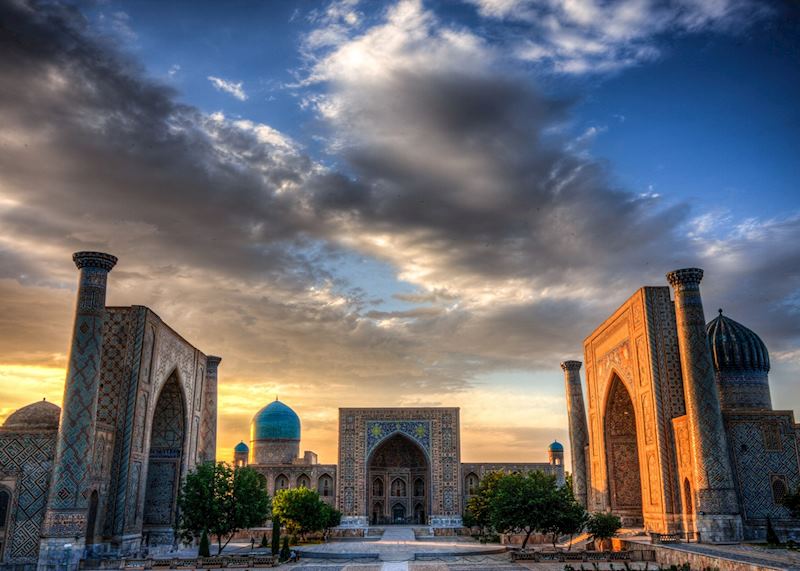
Crossing overland from Kazakhstan to Kyrgyzstan
Almaty, Kazakhstan is your starting point. Not because it has any intrinsic interest (in fact, it’s all a bit gauche: even the mountains overlapping the city are ablaze with branding and billboards) but because from here you can easily access the best bits of Kyrgyzstan.
It’s a full-day drive that takes you through both bucolic hills and the snaking red-rock corridor of the Charyn Canyon, which looks in places like a copycat version of the Grand Canyon.
The border crossing over into Kyrgyzstan is unusually straightforward ― just a chain-link fence and a couple of young officials sporting the biggest hats you’ve ever seen.
Kyrgyzstan: hiking, eagles, yurts and horses
Vivid-green steppe grasslands, lake-filled alpine valleys and sky-punching mountains… Kyrgyzstan has an untamed beauty. There’s something rather Wild West about it all.
Horses are a big part of life here, and you’ll see everyone astride them ― even toddlers. Hunting with eagles is equally a local discipline, and we can arrange for you to watch a demonstration. You can also stay in a yurt camp, waking to a view over lakes and mountainsides.
Kyrgyzstan’s other calling card is its hiking . You can walk among wildflower meadows, snowy mountainsides, and glacially carved valleys ― and there’ll hardly be another soul in sight. Choose from eight-hour-round hikes or gentler half-day options, skipping some of the ascents by jumping in a 4x4. Guides accompany you every step of the way.
What to see in Uzbekistan: mosques, minarets and madrasas

Fly from Kyrgyzstan’s capital, Bishkek, to Tashkent , a city where Islamic religiosity rubs alongside Soviet tower blocks. As soon as you step off the plane, the topographical contrast with Kyrgyzstan is startling: you’re now among flat desert.
As you explore, you’ll see how Uzbekistan feels more developed as a country and better set up for overseas visitors than Kyrgyzstan. There are more pedestrian-only areas, major sites are lit up come evening and restaurants occupy every street corner.
Search for Uzbekistan online, and you’ll find images showcasing the country’s intricately decorated mosques, madrasas and public squares. In places like Khiva , Bukhara and Samarkand , their blue domes and patterned mosaics stand out against the surrounding sand-toned structures.
Some of the finest examples can be seen at Samarkand’s Registan , which you can visit by train from Tashkent. This centuries-old public square sits at the heart of the city and has played host to royal announcements, public executions and important ceremonies over the years. It’s framed by three large madrasas: Tilya-Kori, Sher-Dor and Ulugh Beg.
Built between the 15th and 17th centuries, the madrasas have towering minarets rising on both sides, huge domes, and archways that are symmetrically decorated with bright tiles. Guides point out the significance of the Sher-Dor’s decoration: it uses images of tigers, despite the general rule in Islam that living beings shouldn’t be depicted on religious buildings.
Make sure to return to the square at night, when local families come to mill about, and the madrasas are subtly illuminated against the night sky.
From here, you travel on to Bukhara. You can climb the gigantic, still-intact portion of The Ark , a fortified citadel where British emissaries Stoddart and Conolly were executed during the years of the ‘Great Game’. Then, nose your way through souq-like markets and ascend the Kalon Minaret for panoramas over the city.
The whole city has a more languid feel than Samarkand, and you don’t have to wander far on foot to see unpaved gravel backstreets that look much like they did during the Great Game years.
What to see in Turkmenistan: ghost cities, gas spectacles and a glimpse at life in a dictatorship
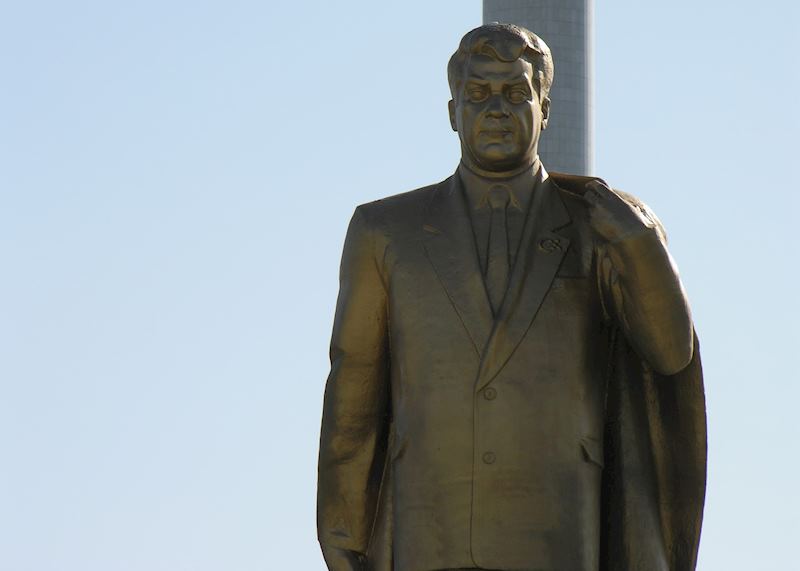
From Bukhara, it’s an hour’s drive to the Turkmen border, a two-hour border crossing, and then a four-hour drive to Merv. A long day, but you can wake up the next morning to explore these completely unrestored, ghostly and weather-beaten ruins in the middle of the desert.
A once thriving Silk Route town before Genghis Khan set his sights on it, it’s a place of untouched citadels and adobe mounds. It’s how parts of Uzbekistan would look had they not received a facelift, nor witnessed any Soviet influence.
What I like about Merv is that there’ll only be about ten other visitors there, if that ― it redefines the meaning of off-the-beaten-track.
From here, it’s a four-hour drive to the capital, Ashgabat. A city of white marble buildings, it hosts a cult of personality dedicated to the president: a gold statue of him once rotated to face the sun. Foreign internet and mobile sites, as well as non-state TV channels, are banned.
You can explore, with your guide, the city’s prized carpet shops and its old Russian quarter. I also recommend enjoying the comforts of your hotel: it’s one of the few plush ones en route, with a swimming pool and bar.
Our advice is to revel in this luxury while you can: for the next day, you’ll be taking a long overland drive through the desert to the Darvaza Gas Craters (purposely lit in the 1970s, and still burning bright).
It’s a real adventure ― just you, your guide, your desert campsite, the stars, and the fiery mouths of the craters. There’s no commerce around the site, for the moment. Your driver will cook a decent barbecue, and there may well be vodka passed around.
From Darvaza, you drive to the Uzbekistan border, where you’re treated to more ruins, Kunya-Urgench ― a decaying cluster of mosques, fortresses, minarets, mausoleums and a caravanserai, some dating from as early as the 11th century. If you’ve already been to India and you think these structures look familiar architecturally, you’d be right ― they went on to inspire Mogul Empire creations.
Uzbekistan: there and back again

After crossing the border, it’s a half-hour drive to Nukus, where you can visit the Savitsky Collection, one of the world’s best (yet least-known) avant-garde art museums. It includes once-banned pieces smuggled out of Stalinist Russia. On a less lofty note, the café opposite the museum does very good coffee and cake.
From here, you drive on to Elliq-Qalas, great sandstone fortresses soaring up from the sand out of nowhere. They’re part of Alexander the Great’s legacy ― a fittingly mighty finale to your trip.
Then it’s onto to Khiva, a city of (you guessed it) more madrasas and mosques. They’re covered in elaborate majolica and azure patterns. From Khiva you fly back to Tashkent to begin your homeward or onward journey.
Best time to follow the Silk Route
As you’re covering a vast area, it’s hard to travel at a time when everywhere is at its best. I recommend taking a trip along the Silk Route between April and early June or September and October, when it’s warm but not uncomfortably hot like it is between late June and August. That said, cars (especially in Turkmenistan) are of decent quality and have air conditioning.
If you’re particularly interested in driving over the high-altitude passes in Kyrgyzstan, postpone your trip until June to avoid the spring snows.
Read more about trips to Central Asia

Uzbekistan discovered
10 days from $4,195pp

Highlights of central Asia: Kyrgyzstan's mountains & Uzbekistan's architecture
15 days from $5,420pp
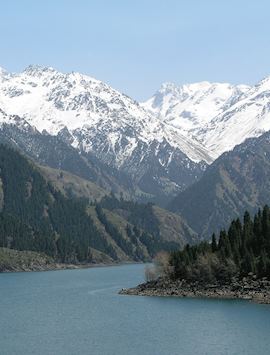
Silk Route journey: western China, Kyrgyzstan & Uzbekistan
21 days from $10,970pp
Start thinking about your experience. These itineraries are simply suggestions for how you could enjoy some of the same experiences as our specialists. They’re just for inspiration, because your trip will be created around your particular tastes.
Further reading
- Adventure vacations
- Off-the-beaten-track vacations
- Cultural vacations
- Rail vacations
Plan your trip
Tell us about your plans and one of our specialists will plan a unique trip for you...
Request our brochure, The World Your Way

Order your digital copy via email.
Sikkim Silk Route

- 1.1 History
- 1.2 When to go
- 2.1 Fees and permits
- 5.1 One-day tour
- 5.2 Two day Tour
- 5.3 Two-day round tour
- 5.4 Two-day round tour from Gangtok
- 6 Stay safe
The Old Silk Route or simply the Silk Route is a high-altitude road trip in the East Sikkim district of Sikkim . The 2-day- and 1-night-long road trip follows the ancient trade routes and offers spectacular views of the snow-covered Kanchenjunga, the third-highest peak in the world. The route passes several beautiful high-altitude glacial lakes, high passes opening into Tibet , China and a couple of temples dedicated to a fallen Indian soldier.
Understand [ edit ]

History [ edit ]
The tour covers part of an ancient trade route passing through the high passes of Nathula and Jelep La on the India Tibet ( China ) border. The route connected Eastern India with the famous Silk Route of Central Asia . The route also had strategic importance. In 1888 the rugged mountain served as a battleground between the Tibetans and the British. A small graveyard with a war memorial stands in the village of Gnathang (Nathanag) in memory of the fallen British soldiers. In 1903–04, this route was used by Francis Younghusband to invade Tibet and move onwards to Lhasa.
This was the route that George Mallory and his fellow mountaineers took during the Mount Everest expeditions of 1921, 1922 and 1924. Sir Francis Younghusband writes, in his book The Epic of Mount Everest , "But from Rongli they climbed steeply out of the tropical forest into the zone of flowering rhododendrons.... To flower lovers, like Howard Bury, Mallory and Wollaston, these were perpetual delight. They were all the more appreciated because they would be almost the last sign of luxuriance and grace they would behold before they to face the austerities and stern realities of rock and ice and snow, and the frosts of Mount Everest." The Silk Route also has stories from the recent past. The route has two temples dedicated to an Indian soldier who died from drowning in one of the fast-flowing streams of the region.
When to go [ edit ]
- Mid-September to mid-December: Is the best time with clear skies and great mountain views. Lush green meadows covered with colourful flowers.
- Mid-December to April: It is a fairly good time with heavy snowfall. Upper portions of the route can become inaccessible. Vehicles can get stuck.
- May to mid-June: This is better than mid December - April with occasional snowfall or rains. Partially clouded sky with occasional views of snow-capped mountains.
- Mid-June to mid-September: Not a good time. Heavy rainfall. No views, frequent landslides.
Prepare [ edit ]
Fees and permits [ edit ].
Indians need a Protected Area Permit to travel in the Silk Route. The permits can be arranged by the travel agents and hotels. The permits are issued from the Sikkim Tourism Office at Gangtok or from the SDPO Office in Rongli. The office remains open till 14:00 on weekdays, 11:00 on Saturdays, and closed on Sunday). The permit issued from Rongli doesn't cover Nathula while the one issued from Gangtok permits visits to Nathula. The tourist need to carry the following documents. 4 passport size photographs, photo ID card (passport, adhar card, voter card, driving licence), both original and photocopies. The permit takes less than half an hour but in tourist season there can be long quques. Foreigners are not allowed in this route .
Get in [ edit ]
Since 27.203572 88.701854 1 Rongli is the place where the permits are issued for the Silk Route tour, it saves a lot of time. But since Rongli is not very scenic the tour can also be started from 27.188 88.674 2 Aritar 27.133626 88.575554 3 Icche Gaon and 27.139555 88.580387 4 Sillery Gaon and a few other destinations in Sikkim or North Bengal . For tourist starting the tour from other destination needs to travel to Rongli for the permit and proceed along the Silk Route. The route can also be done in the reverse direction starting from Gangtok . however it is not a preferred choice. The road trip involves high altitude so necessary precaution for Altitude sickness needs to be taken.
Route [ edit ]

- 27.233597 88.761704 5 Lingtam (9 km from Rongli) — a small village with a couple of hotels and a monastery. It has a check post where permits of Silk Route are checked.
- 27.236295 88.757413 6 Que khola falls —A small waterfall between Lingtam and Padamchen
- 27.237384 88.767643 7 Phadamchen (12 km from Lingtam) — Scenic Himalayan village with a small monastery and a handful of hotels and homestays. Permits of the Silk Route are checked here for the second time.
- 27.251848 88.777502 8 Zuluk (2865 m) (9 km from Padamchen) — Zaluk (or Dzuluk) marks the beginning of the high altitude. It is a fairly large village with many hotels and homestays. A good night's destination.
- 27.26142 88.786448 9 Zigzag Road — From Zuluk to Thambi View Point the road gains an altitude of 600+m in just 13 km. The road is an engineering marvel consisting of a series of numerous hairpin bends. The combination of the hairpin bends creates an amazing geometry of zig zag patterns best viewed from the Thambi View Point.
- 27.265924 88.785258 10 Thambi View Point (3415 mt) (13 km from Zuluk) — According to local sources, Thambi View Point is named after the civil engineer, who constructed the road, offers an extraordinary view of the Kanchenjunga and its sister peaks. But the view of Zuluk along with the meandering zig - zag road is definitely no less an attraction.
- 27.267087 88.798171 11 Lungthung View Point (3963 m) 4 km from Thambi View Point — The zig - zag road continues a little beyond the Thambi View point and after which it head almost straight to Lungthung View Point Lungthung View Point. This view point located closer and higher than the Thambi View Point offers a better and closer view of the Kanchenjunga and its adjoining peaks. A huge army barrack is located next to the view point. Being a border area the entire route has a heavy military presence.
- 27.288708 88.813014 12 Laxman Chowk — Just before the Gnathang valley the road bifurcates into two parts. The place is known as Laxman Chowk, and a memorial stands in memory of Lt. Col. Laxman Singh (Commanding Officer, 5 Mahar Borders) under whose command the unit pre-emptively secured the water shed opposite Chinese in General Area Dokala in 1965. The left road is the lower road and leads to the Gnathang valley and village. The upper road is on the right and leads to the Old Baba Mandir. Both the roads rejoin again just before the Kupup Lake.
- 27.29864 88.817296 13 Gnathang (4116 m) (6 km from Lungthung View Point) — Gnathang (also called Nathang) Valley consists of the Gnathang (Nathang) village. The village houses several basic hotel and homestays. Both sides of the road are lined up with small eateries selling hot soups, momos and thupkas. The village has a heavy military presence.
- 27.297945 88.815833 14 British War Memorial, Gnathang — According to historical records the Nathang area was captured by the Tibetans in 1886 and it was recaptured back by the British in 1888 and a memorial, along with a few graves, stands in the memory of the soldiers killed during the recapture. The memorial lies on the left hand side of the road for travellers travelling from the south. The complex consists of two memorials with shinning new granite plaques and fifteen graves. The epitaphs of the graves have long vanished. Sadly the original marble plaques have been replaced by granite plaques. An original marble plaque from one of the memorials can still be seen.
- 27.314734 88.838428 15 Old Baba Mandir — Being a border area, the entire Silk Route has a heavy army presence. Working in these harsh conditions is never easy and no wonder they have their share of legends. Harbhajan Sing is the legend of the Silk Route with two temples dedicated to his name. According to army records On Oct 4, 1968, Harbhajan Sing, while escorting a mule caravan in the silk route region, fell into a stream and was swept away. On the fifth day one of his fellow soldier had a dream, where Harbhajan Singh informed him about his tragic death and also about the location of his body. Incidentally a rescue operation recovered his body from the very position that was mentioned in the dream. Later a samadhi was built, in his honor, at the bunker, where Harbhajan Singh had his last posting. Today the samadhi is reached by a flight of stairs and small shrine (old Baba Mandir) with the photo of Hrbhajan Singh stands at its base. Even today the legend of Harbhajan Singh lives on, there are stories of soldiers being slapped when they fall asleep during his duties. Harbhajan Singh is also said to inform his colleagues of bad weather and other calamities. Even his Chinese counterpart is aware and afraid of his presence. The Old Baba Temple lies on the high (right) road from Laxman Chowk just before meeting point of the high and low road.
- 27.330534 88.846203 16 Kupup Lake (Elephant Lake) (4000 m) (6.4 km from Nathang) —The lake is located near the Kupup village and is locally known as Bitan Cho. It is shaped like an elephant, complete with a tail and trunk. Hence it is also popularly known as the Elephant Lake. It is one of the most sacred lakes of Sikkim and stunningly beautiful. The nearby Kupup village contains a golf course, which is said to be the highest in the world.
- 27.365857 88.837919 17 New Baba Temple (5.6 km from Kupup Lake)—This temple is also dedicated to Baba Harbhajan Singh and came up in 1982 and is popularly known a New Baba Temple. The central room of the three-room shrine contains a large portrait of Harbhajan Singh along with photos of Sikh Gurus and Hindu Gods and Goddesses.
- 27.346168 88.818616 18 Menmecho Lake —This lake is not on the main road and one has to trek for 4 km to reach it. The trail starts just beyond the New Baba Mandir and is on the left hand side of the road. The beautiful lake is surrounded by pine forest and the water changes colour several times a day. The lake is used by the Sikkim Fisheries Department for trout cultivation.
- 27.368062 88.826464 19 Hangu Lake (not to be confused with Changu Lake) (3938 m) (2 km from New Baba Temple) — This glacial lake lies on the left hand side of the road. It has paddle boating facilities. There is an Indian Army memorial for forgotten soldiers atop a hill next to the lake.
- 27.377981 88.819698 20 Ganju Lama War Museum (2 km from Hangu Lake) — Ganju Lama was a soldier from Sikkim who fought for the British Indian army during the Second World War. He was a recipient of Victoria Cross. The museum stands at the junction where the road to Nathula bifurcates from the Gangtok - Nathang road. At the entrance is marked with a statue of Ganju Lama. The museum runs a documentary throughout the day. There are other photos on display.
- 27.386553 88.830857 21 Nathula (4310 m) (4.4 km from Ganju Lama War Museum) —Tourists coming from Zuluk side are not permitted to visit Nathula but those coming from Gangtok can visit Nathula. It is a pass on the India China ( Tibet ) border. The pass is part of an ancient trade route. The pass is marked by entrance gates of both countries and military bunkers on both sides of the gates. This is the only open border crossing between China and India, though it is only open for cross-border trade, and tourists may not cross the border here.
- 27.375322 88.762955 22 Tsongmo (Changu Lake) (3753 m) (12.5 km from Ganju Lama War Museum) — One of the most spectacular lakes of Sikkim. The glacial lake changes colour with passing of the day. There are several eateries on the lakeside selling hot momos, thupkas and noodles. Snow boots can be hired and tourists can take a walk along the snowy ridge next to the lake. Yak rides are also available.
- 27.331351 88.613811 23 Gangtok (1650 m) (36 km from Tsongmo) —The round Silk Route ends at Gangtok, the capital of Sikkim
Itineraries [ edit ]
There are several itineraries for the Silk Route:
One-day tour [ edit ]
A very hectic tour. Permits need to be arranged the previous day. Day 1: Start from Lingtem, Rongli, Aritar, etc. Closer the place better it is. Breakfast at the hotel and start early. Drive past Zuluk and zig-zag road halt at Thambi and Lungthung viewpoint. Take right road from Laxman Chowk, Visit Old Baba Mandir, tea break. Visit Kupup Lake. Turn back and head to Nathang, lunch break. Back to the hotel by late afternoon.
Two day Tour [ edit ]
A good option with lot of free time. Day 1: Start from Lingtem, Rongli, Aritar, etc. Breakfast at hotel, collect permit and reach Zuluk. Lunch, dinner and night stay at Zuluk. Day 2: Start very early. Reach Thambi view point before sunrise. Sunrise from Thambi view point. Great view of Kanchenjunga and zig-zag route. Move to Lungthung View Point and then on to Laxman Chowk. Take the high road on right and head to Old Baba Temple. Breakfast at Old Baba Temple. Continue to Kupup Lake. Turn around and take the lower road for the return journey. Visit Nathang on the return journey and follow the route back to Zuluk for lunch. After lunch continue to your hotel in Lingtem, Rongli, Aritar, etc., and reach by late afternoon.
Two-day round tour [ edit ]
This route has no backtracking. The second day is hectic. Day 1: Same as two day tour. Day 2: Same till Lakshman Chowk, after Lakshman Chowk take the lower route on the left. Breakfast at Nathang. Make a detour to Old Baba Mandir and get back to the road and head for Kupup Lake. The road continues to New Baba Mandir, Hangu Lake, Gunja Lama War Museum (visit to Nathula is not permitted), Tsongmo (Changu Lake) and finally to Gangtok.
Two-day round tour from Gangtok [ edit ]
Same as the two day round tour, but in the opposite direction. Nathula can be visited as the permit is obtained from Gangtok. Nightstay at Nathang, with sunrise views from Lungthung View Point.
Stay safe [ edit ]
- The route involves high altitude of above (4000+ m) and there are chances of Altitude sickness , so proper acclimatization is required. Moving slow and drinking plenty of fluids helps. Avoid spending a night at Gnathang, unless you are well acclimatized.
- The route is subject to regular landslides, especially during the monsoon months (June - August) In winter (December - April) the area receives heavy snowfall. Both landslides and snowfall can cut short the journey. The condition of the road is bad and the journey time can overshoot the scheduled time.
Go next [ edit ]
- Articles without Wikipedia links (via Wikidata)
- Has custom banner
- Banner missing from Wikidata
- Has caution box
- Has caution box with out of date warning
- Has map markers
- Has mapframe
- South Asia itineraries
- Itineraries
- Usable itineraries
- Usable articles
- Pages with maps
Navigation menu

IMAGES
VIDEO
COMMENTS
Travelling along the Chinese Silk Road is an incredible experience. You'll get to visit the Terracotta Warriors in Xi'an, taste some delicious noodles in Lanzhou, visit the famous Mogao Caves in Dunhuang, and check out the famous flaming cliffs of Turpan. 6 - Kashgar, China's westernmost city: Closer to Baghdad than Beijing, Kashgar is ...
Days 12-14. Continue to Song-Kol lake at a breathtaking 3,015 metres. Drive up in around four hours from Kochkor on Issyk Kol's western side, or take one to two days hiking and horse-trekking ...
The Silk Road is a historically important international trade route between China and the Mediterranean. Because China silk comprised a large proportion of the trade along this ancient road, in 1877, it was named the 'Silk Road' by Ferdinand von Richthofen, an eminent German geographer. It is now included in the World Heritage List of UNESCO. 33 historical sites are along the road in total and ...
Winter is long and bleak. The best time to travel the Silk Road is from May to October. Weather conditions are pleasant from late spring to early autumn, with an average temperature of 15°C (59°F). Although summer weather can be scorching, the heat is dry and more comfortable than in the humid tropics.
The Silk Road is a name for an ancient network of trade routes connecting the Eurasian continent. We can name plenty of reasons why it is not an accurate name, but the fact of the matter is, the Silk Road is a powerful brand. It immediately conjures up images of romance, exploration and exoticism. So we decided to keep that name as the tagline ...
Caravanistan helps you get the most out of your Silk Road trip. Both for independent travelers and guided trips. Hi there! We're Caravanistan and we help you make the most of your Silk Road trip in 4 ways: Leading travel guide for Central Asia. Silk Road Visa shop. Custom tours for unique adventures. Car and motorbike rental.
The length of a Silk Road tour depends on how many cities you visit. We recommend planning at least 6 days (for two or three destinations) to 3 weeks for a more immersive and enriching Silk Road experience.. A recommended itinerary for exploring the Silk Road inside China typically lasts about two weeks. If you want to cover the entire Silk Road and extend your trip to Central Asia, you would ...
Silk Road travel guide. The Silk Road is best described as a collection of intricate paths that form a network (so intricate that a travel guide is definitely required reading). Beginning in the former capital of China, Xī'ān, the route crosses mountain-tops and desert plains into Central Asia. The Silk Road played a considerable role in ...
Historically, the Silk Road was not one but many routes that connected east and south Asia to Mediterranean Europe, so named because the largest commodity traded down the route was sought-after Chinese silk. The route traditionally started in Xi'an (then known as Chang'an), China and continued northwest through modern-day Gansu and Xinjiang ...
The Silk Road travel route stretches across a very large area in China, so the best time for making a Silk Road trip varies by destinations. Historic and cultural sites are suitable to visit all year round but natural spots are affected by seasonal temperature and weather. Generally, April to October is the best time to travel to China Silk Road cities, because all destinations along the route ...
Here's a comprehensive, detailed Silk Road Travel Guide I wrote, based on my overland journey through Central Asia. The Silk Road is the greatest travel route of all time, spanning 8,000km across continents, weaving through deserts, mountains and grasslands and bringing traders from East to West and vice versa.
Cholpon Ata, Kyrgyzstan. The Silk Route was actually a network of trading routes rather than one long road. Its roots stretch as far back as 207 BC, when silk was first produced in China and transported for trade. It eventually grew to link Asia, the Middle East and Europe, branching off into the Indian Subcontinent and Russia.
The Best Times to Visit the Silk Road for Good Weather. The best times to visit the Silk Road for good weather generally fall in the spring and autumn months when the weather is more temperate and pleasant. Below, we've provided a breakdown of the best times to visit different sections of the Silk Road for favorable weather conditions. 1.
The Silk Road (丝绸之路 sī chóu zhī lù ), also known as the Silk Route, is not a single road, but a network of historical trade routes across Asia from China to Europe. One poem calls it "The Golden Road to Samarkand" . In 2014, UNESCO added "Silk Roads: the Routes Network of Chang'an-Tianshan Corridor" to their World Heritage List.
Silk Road travel guide. Honest & easy to read Silk Road travel guide all you need to know including history, travel advice, things to do, best and worst of the Silk Road, photos & responsible tourism tips. Travel like a local with our Silk Road travel guide. Toggle navigation. menu. 1-866-821-6866 .
Price from $946. 11 Days In-depth Wild Silk Road Adventure Tour. An in-depth Silk Road adventure takes you to explore the most outstanding destinations in northwest China's Gansu and Xinjiang and encounter both historic heritages and amazing natural landscapes. Price from Request.
The Silk Road China travel guide to tours, tourist attractions & sites, transportation, climate, hotels, food, fun, nightlife, ethnice groups, travel pictures & tips information in China and Central Asia. 86-773-3821157 Join-in Group Silk Road China Tours
Silk Road, known as the "Friendship Canal", based upon the silk trade between the West and the East, is still prosperous now, ever extended for thousands of miles and passed 2000-odd years.. In September 2013, Chinese President Xi Jinping proposed the strategic concept to promote building the 21st Century Maritime Silk Road and advance opening up and development under the Belt and Road Initiative.
The Silk Road is a legendary but very real 4,000-mile-plus-long trade route that connected Europe with China in a quest to not only buy silk but also shift plenty of other merchandise, such as ...
To complete the entire Old Silk Route, Zuluk you should get a permit to visit Tsomgo Lake from Rangli view point! Also read: 2 weeks itinerary for planning a trip to Myanmar! A Responsible Traveler's Guide to Old Silk Route, Sikkim. Needless to point it out but old silk Route happens to be one of the most fragile ecological zone in the entire ...
Discover the riches and wealth of history along the various ancient Silk Road trading routes from the Chinese city of Xi'an in the east to IstanbulFor over t...
Sikkim Silk Route Travel Guide (FAQs Answered) What is the best time to visit Silk Route Sikkim? The best time for the Sikkim Silk Route tour is the months of April and May as well as October and November. During this time the climate is perfect for road trip without the wrath of rains and snow. The months of April, May and October are the peak ...
Cholpon Ata, Kyrgyzstan. The Silk Route was actually a network of trading routes rather than one long road. Its roots stretch as far back as 207 BC, when silk was first produced in China and transported for trade. It eventually grew to link Asia, the Middle East and Europe, branching off into the Indian Subcontinent and Russia.
Sikkim Silk Route. The Old Silk Route or simply the Silk Route is a high-altitude road trip in the East Sikkim district of Sikkim. The 2-day- and 1-night-long road trip follows the ancient trade routes and offers spectacular views of the snow-covered Kanchenjunga, the third-highest peak in the world.